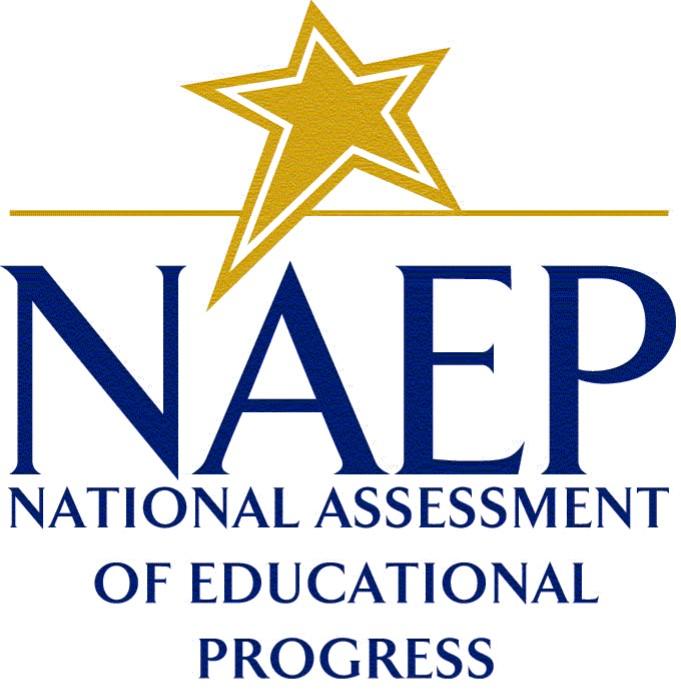NAEP Appendix D
NAEP 2024 Appendix D v33.docx
National Assessment of Educational Progress (NAEP) 2024 Amendment #3
NAEP Appendix D
OMB: 1850-0928
NATIONAL CENTER FOR EDUCATION STATISTICS
NATIONAL ASSESSMENT OF EDUCATIONAL PROGRESS
National Assessment of Education Progress (NAEP) 2024
Appendix D
NAEP 2024 Communications and Recruitment Materials
OMB# 1850-0928 v.33
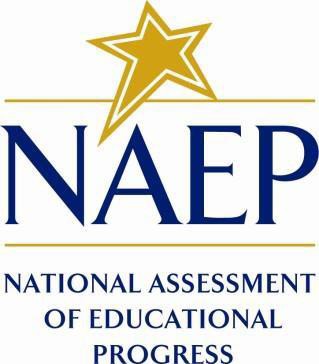
August 2023
revised November 2023
This Appendix provides all final communication and recruitment materials for the 2024 Operational and Pilot administrations. Documents that have been added or revised are noted as “New” in the Table of Contents. Some of the previously approved appendices have been moved, replaced, or deleted.
All communication and recruitment materials included in this Appendix will be used in both the Field Trial and Main NAEP Operational and Pilot Administration. Although the Field Trial and NAEP Administration differ in the size of the sample, dates of administration, and subjects, the content of the letters included in this document will not change among activities aside from the noted distinctions. Therefore, these recruitment materials will only be changed to account for these specific differences; to avoid duplication of documents, the materials included below refer to the “NAEP Administration” rather than also including the Field Trial. The table below shows differences in the admin windows and subjects between these activities.
-
Activity
Window
Grade
Subjects
Field Trial
November 6-November 17, 2023
4, 8, 12
Math reading
Main NAEP and Pilot Administration
January 29-March 8, 2024
4, 8, 12
Math, reading, science
Appendix D-1: NAEP 2024 Facts for Districts (Approved v.29) 6
Appendix D-2: NAEP 2024 Facts for Principals (Approved v.29) 9
Appendix D-5: NAEP 2024 Save-the-Date (Approved v.29) 31
Appendix D-6: NAEP 2024 Assessment Details Letters (Approved v.30) 33
Appendix D-7: NAEP in Your Private School 2024 (Approved v.30) 43
Appendix D-8: NAEP in Your School 2024 (Approved v.29) 53
Appendix D-9: NAEP 2024 Endorsement Letters to Private School Administrator (Approved v.29) 66
Appendix D-12: 2024 State Guide to NAEP Participation (Approved v.29) 88
Appendix D-13: TUDA Guide to NAEP Participation 2024 (Approved v.29) 93
Appendix D-14: Preassessment Materials (New) 99
Appendix D-14a: Preassessment Email (New) 100
Appendix D-14b: Preassessment Responsibilities Guide (New) 102
Appendix D-14c: Before Assessment Day Checklist Email to Technical Coordinators (New) 106
Appendix D-14d: Internet Connectivity Survey Video Script English and Spanish (New) 108
Appendix D-15: Assessment Day Feedback Email Template (Approved v.28, Appendix D2-11) 114
Appendix D-17: 2024 NIES Sample Parent Letter (Approved v.29) 121
Appendix D-19: NIES 2024 Flyer (Approved v.29) 127
Appendix D-20: NIES Endorsement Letters (Approved v.29) 130
Appendix D-23: 2024 NAEP In Your School, High School Transcript Study (HSTS) (Approved v.30) 142
Appendix D-32: 2024 NAEP High School Transcript Study (HSTS) HSTS FERPA Notice (Approved v.30) 200
Appendix D-35: 2024 NAEP Facts for Teachers, Public and Private Schools (Approved v.30) 210
Appendix D-36: 2024 NAEP Overview Brochure (Approved v.30) 223
Appendix D-37: 2024 NAEP Overview Brochure for Private Schools (Approved v.20) 229
Appendix D-38: 2024 NAEP Private School Factsheet (Approved v.30) 232
Appendix D-42: 2024 NAEP Technology Notification Letters (New) 243
Appendix D-43: 2024 NAEP Technology Team Responsibilities Guide (New) 253
Appendix D-44: 2024 NAEP Translation Notice (Approved v.21) 257
Appendix D-46: Assessment Details Notification Principal to School Coordinator Letter 264
Appendix D-47: Public School Coordinator responsibilities 265
Appendix D-48: Private School Coordinator Responsibilities 266
Appendix D-49: 2024 Private School Video Script (Approved v.30) 267
Appendix D-50: NAEP 2024 Operational and Pilot Technical Fact Sheets (New) 273
Appendix D-51: NAEP 2024 Best Practices Materials (New) 286
Appendix D-51a: Best Practices Initial Mailing (New) 287
Appendix D-51b: Best Practices Emails (New) 291
Appendix D-51c:est Practices Notification Letter for Students (New) 295
Appendix D-51d: Best Practices Social Media and Online Communications (New) 297
Appendix D-51e: Storyboard for Introduction to Best Practices Video Script (New) 301
Appendix D-51f: Introducing NAEP to Students (New) 303
Appendix D-51g: Introducing NAEP to Teachers (New) 317
Appendix D-51h: Introducing NAEP to Parents (New) 333
Appendix D-51i: NAEP High School Transcript Study (New) 350
Appendix D-51j: NAEP Introducing NAEP to Students Slides (New) 354
Appendix D-51k: NAEP Introducing NAEP to Parents Slides (New) 369
Appendix D-51l: NAEP Introducing NAEP to Teachers Slides (New) 386
Appendix D-1-S-PR (Spanish version): NAEP 2024 Facts for Districts, Puerto Rico (Approved v.29) 402
Appendix D-2-S-PR (Spanish version): NAEP 2024 Facts for Principals, Puerto Rico (Approved v.30) 407
Appendix D-6-S-PR (Spanish version): NAEP 2024 and Pilot 2024 in Your School (Approved v.30) 428
Appendix D-8-S-PR (Spanish version): NAEP 2024 Save the Date Letter (Approved v.30) 441
Appendix D-11-S-PR (Spanish version): NAEP 2024 Facts for Teachers–Puerto Rico (Approved v.30) 451
Appendix D-1: NAEP 2024 Facts for Districts (Approved v.29)
2024 Facts for Districts
“NAEP is the only assessment providing half a century of performance data to measure what students know and can do. The state and national trends inform local, state, and national program and policy discussions that improve teaching and learning.”
– David Atherton, EdD, Principal, Clear Creek Middle School, Gresham, OR
What is NAEP?
The National Assessment of Educational Progress (NAEP) is an integral measure of academic progress across the nation and over time. It is the largest nationally representative and continuing assessment of what our nation’s students know and can do in various subjects such as civics, science, mathematics, reading, and U.S. history. The program also provides valuable insights into students’ educational experiences and opportunities to learn in and outside of the classroom.
NAEP is a congressionally mandated program administered by the National Center for Education Statistics (NCES), within the U.S. Department of Education and the Institute of Education Sciences.
How are NAEP results reported?
The results of NAEP are released as The Nation’s Report Card. NAEP results are available for the nation; results for states and select urban districts that participate in the Trial Urban District Assessment (TUDA) may also be available, depending on the assessment. Additionally, results are available for different student groups, based on factors such as race/ethnicity, gender, school location, and more. NAEP is not designed to report results for individual students, classrooms, or schools.
Why should my district participate in NAEP?
Your district’s participation is vitally important for several reasons.
Results from the 2024 assessments will provide much-needed information about the academic achievement and continued recovery of students whose elementary or secondary school experiences have been shaped by the COVID-19 pandemic.
Schools and students selected to participate in NAEP represent schools and students across the country. When students participate and give their best effort, NAEP results provide the most accurate and representative measure possible of student achievement and experiences.
The 2024 assessments will help NAEP continue to examine transitions to online assessments and using devices that students are most familiar with. Such shifts will help to ensure the program can flexibly, meaningfully, and reliably measure trends in student achievement and experiences over time.
What NAEP assessments will be administered in 2024?
The 2024 program will include:
Assessments in mathematics and reading at grades 4, 8, and 12 and science at grade 8
Pilot testing in mathematics and reading at grades 4 and 8, to help improve future NAEP assessments and ensure that they continue to be a reliable measure of student achievement
Survey questionnaires for participating students, teachers, and principals, to provide a better understanding of factors that may be related to students’ learning*
The assessments will be administered between January 29 and March 8, 2024.
Results will be released at the national, state, and select urban district levels for the mathematics and reading assessments at grades 4 and 8. National results will be released for the science assessment at grade 8 and mathematics and reading assessments at grade 12.
Additionally, some schools and students may be selected to participate in special studies.
American Indian and Alaska Native students participating in the NAEP mathematics and reading assessments at grades 4 and 8 will also be included in the National Indian Education Study (NIES). NIES describes the condition of education for American Indian and Alaska Native (AI/AN) students in the United States.
High schools selected for grade 12 assessments will also participate in the High School Transcript Study, which involves the collection of student transcripts and course catalogs in order to examine coursetaking patterns of students and relate those patterns to educational achievement and NAEP assessment data.
Footnote text:
* There will be no teacher questionnaires at grade 12.
What will students in my district do?
Participating students will complete:
Subject-area questions in mathematics, reading, or science.
Survey questionnaires that provide valuable information about their educational experiences and opportunities to learn both in and outside of the classroom.
It takes participating students approximately 2 hours to complete the assessments. This includes transition time, directions, and completion of survey questionnaires. A broad range of accommodations are provided for students with disabilities and English learners.
Some students will be assessed on NAEP-provided Surface Pros and some students will be assessed on NAEP-provided Chromebooks, in order to inform the program’s transition to using devices that are most familiar to students.
Do teachers need to prepare students for the assessment?
Teachers do not need to prepare their students to take the assessment but should encourage them to do their best.
Who will administer NAEP? What do schools need to provide on the day of the assessment?
NAEP representatives will administer the NAEP assessment and provide significant support to schools on assessment day. They will bring all necessary materials and equipment, including the Surface Pros and Chromebooks to assess the students.
Schools will only need to provide space for students to take the assessment, desks or tables, and an adequate number of electrical outlets in the assessment location.
NAEP will also ask to utilize school-based Internet—when possible—as the program continues to examine a shift toward online assessments. NAEP representatives will contact your district in the coming months to learn more about your schools’ Internet capabilities.
How were schools in my district selected for NAEP?
Schools were selected as part of a carefully designed sampling process that ensures NAEP-selected schools and students are representative of your district, state, and the nation.
Under the Elementary and Secondary Education Act, districts and states that receive Title I funds are required to participate in the biennial assessments.
How can school administrators and teachers use NAEP data to help our students?
The NAEP Data Explorer (https://www.nationsreportcard.gov/ndecore) is a powerful tool that allows you to examine the relationships between student performance and factors such as instructional practices, school resources, and more.
Questions from previous NAEP assessments can also be used as a helpful educational resource in the classroom. Teachers can use the NAEP Questions Tool (http://nces.ed.gov/nationsreportcard/nqt) to see how their students’ performance compares to peers in your state and across the nation. Released NAEP questions come with a scoring guide, sample student responses, and performance data.
How long has NAEP been around?
NAEP was first administered in 1969 to measure student achievement nationally. In 1990, NAEP was administered at the state level for the first time. The NAEP TUDA program, which measures student achievement in some of the nation’s large urban districts, began in 2002.
Where can I find more information?
Learn more about the NAEP program at nces.ed.gov/nationsreportcard, and explore the latest NAEP results at nationsreportcard.gov.
Visit https://nces.ed.gov/nationsreportcard/about/covid19.aspx for more information about NAEP health and safety protocols.
You can also find NAEP on: <Facebook logo> <Twitter logo> <YouTube logo>
National Center for Education Statistics (NCES) conducts the National Assessment of Educational Progress to evaluate federally supported education programs. All of the information you provide may be used only for statistical purposes and may not be disclosed, or used, in identifiable form for any other purpose except as required by law (20 U.S.C. §9573 and 6 U.S.C. §151). By law, every NCES employee as well as every NCES agent, such as contractors and NAEP coordinators, has taken an oath and is subject to a jail term of up to 5 years, a fine of $250,000, or both if he or she willfully discloses ANY identifiable information about you. Electronic submission of your information will be monitored for viruses, malware, and other threats by Federal employees and contractors in accordance with the Cybersecurity Enhancement Act of 2015.
This publication was prepared for the National Assessment of Educational Progress by Hager Sharp under contract GS-23F-0024M to the National Center for Education Statistics, U.S. Department of Education.
Appendix D-2: NAEP 2024 Facts for Principals (Approved v.29)
NAEP 2024
Facts for Principals
Grades 4 and 8 Mathematics and Reading
Page One Sidebar
NAEP is an integral part of education in the United States.
Elected officials, policymakers, and educators all use NAEP results to develop ways to improve education.
NAEP is a congressionally mandated program administered by the National Center for Education Statistics (NCES), within the U.S. Department of Education and the Institute of Education Sciences.
NAEP serves a different role than state assessments. While states have their own unique assessments with different content standards, the same NAEP assessment is administered in every state, providing a common measure of student achievement.
Depending on the type of NAEP assessment that is administered, the data can be used to compare and understand the performance of demographic groups within your state, the nation, other states, and districts that participate in the Trial Urban District Assessment (TUDA). NAEP is not designed to report results for individual students, classrooms, or schools.
To provide a better understanding of educational experiences and factors that may be related to students’ learning, students, teachers, and principals who participate in NAEP are asked to complete survey questionnaires.
Page One Body
“NAEP is the only assessment providing half-a-century of performance data to measure what students know and can do. The state and national trends inform local, state, and national program and policy discussions that improve teaching and learning.”
David Atherton, EdD, Principal, Clear Creek Middle School, Gresham, OR
Visit https://www.nationsreportcard.gov/media.aspx for more information about NAEP health and safety protocols.
What is NAEP?
The National Assessment of Educational Progress (NAEP) is the largest nationally representative and continuing assessment of what our nation’s students know and can do in various subjects such as civics, mathematics, reading, science, and U.S. history. The results of NAEP are released as The Nation’s Report Card.
What can principals and schools expect?
NAEP representatives will provide significant support to your school on assessment day. As principals, you make an important contribution to the program by selecting and empowering a NAEP school coordinator, meeting with teachers and participating students, and encouraging your students to participate and do their best. You are essential partners in NAEP. When students participate and give their best effort, NAEP results provide the most accurate measure possible of student achievement across the country.
In 2024, the NAEP mathematics and reading assessments will be administered on devices to students at grades 4 and 8. Results will be released at the national, state, and district levels. Each student will be assessed in only one subject.
In addition to subject-area questions, students will complete NAEP survey questionnaires that provide valuable information about participating students’ educational experiences and opportunities to learn both in and outside of the classroom.
Additionally, American Indian and Alaska Native (AI/AN) students participating in the NAEP mathematics and reading assessments at grades 4 and 8 will be included in the National Indian Education Study (NIES). NIES describes the condition of education for AI/AN students in the United States.
NAEP representatives will bring all necessary materials and equipment, including sanitized, NAEP-provided Surface Pros and Chromebooks, to schools on assessment day. Schools will only need to provide space for students to take the assessment, desks or tables, and an adequate number of electrical outlets in the assessment location.
In 2024, NAEP will continue to examine transitions to online assessments and using devices that students are most familiar with. Such shifts will help to ensure the program can flexibly, meaningfully, and reliably measure trends in student achievement and experiences over time.
As part of these shifts, NAEP representatives will use school-based Internet—when possible—to conduct the assessment. The program will work with you or your district to determine if this is feasible for your school.
For more information about NAEP, visit www.nces.ed.gov/nationsreportcard.
Page Two Body
NAEP was first administered in 1969 to measure student achievement nationally. In 1990, NAEP was administered at the state level for the first time. Students in grades 4 and 8 are currently assessed at the national and state level in mathematics and reading every 2 years and in other subjects periodically. The NAEP TUDA program, which measures student achievement in some of the nation’s large urban districts, began in 2002.
Why is NAEP considered the gold standard? From the development of assessment frameworks and questions to the reporting of results, NAEP delivers high technical quality and represents the best thinking of assessment and content specialists, state education staff, and teachers from around the nation. NAEP is a trusted resource that measures student progress and helps inform policy decisions that improve education in the United States.
How are NAEP results reported? NAEP results are reported for different demographic groups rather than for individual students or schools. Within a school, just some of the student population participates, and student responses are combined with those from other participating students to produce the results.
How are schools and students selected for NAEP? A carefully designed sampling process ensures that NAEP-selected schools and students are representative of all schools and students in their district, state, and across the United States. To ensure that the sample represents all students in the nation’s schools, a broad range of accommodations are allowed for students with disabilities and English learners.
What can teachers and students expect? Including transition time, directions and tutorials, and completion of survey questions, it takes approximately 2 hours for students to complete the assessment. Teachers do not need to prepare their students to take the assessment but should encourage them to do their best. NAEP representatives provide significant support to your school by working with the designated coordinator in your school to organize assessment activities.
How can educators use NAEP data to help students? NAEP items can be used as a helpful educational resource in the classroom. Teachers and district staff can use the NAEP Questions Tool (http://nces.ed.gov/nationsreportcard/nqt) to see how students’ performance compares nationally on specific items. Released NAEP items come with a scoring guide, sample student responses, and performance data.
Visit the NAEP website at http://nces.ed.gov/nationsreportcard to access this information and more.
National Center for Education Statistics (NCES) is authorized to conduct NAEP by the National Assessment of Educational Progress Authorization Act (20 U.S.C. §9622) and to collect students’ education records from education agencies or institutions for the purposes of evaluating federally supported education programs under the Family Educational Rights and Privacy Act (FERPA, 34 CFR §§ 99.31(a)(3)(iii) and 99.35). All of the information provided by participants may be used only for statistical purposes and may not be disclosed, or used, in identifiable form for any other purpose except as required by law (20 U.S.C. §9573 and 6 U.S.C. §151). By law, every NCES employee as well as every NCES agent, such as contractors and NAEP coordinators, has taken an oath and is subject to a jail term of up to 5 years, a fine of $250,000, or both if he or she willfully discloses ANY identifiable information about participants. Electronic submission of participant’s information will be monitored for viruses, malware, and other threats by Federal employees and contractors in accordance with the Cybersecurity Enhancement Act of 2015. The collected information will be combined across respondents to produce statistical reports.
Page Two Footer
Find us on: [insert social media icons]
This publication was prepared for the National Assessment of Educational Progress by Hager Sharp under contract GS-23F-0024M to the National Center for Education Statistics, U.S. Department of Education.
NAEP 2024
Facts for Principals
Grade 8 Science
Page One Sidebar
NAEP is an integral part of education in the United States.
Elected officials, policymakers, and educators all use NAEP results to develop ways to improve education.
NAEP is a congressionally mandated program administered by the National Center for Education Statistics (NCES), within the U.S. Department of Education and the Institute of Education Sciences.
NAEP serves a different role than state assessments. While states have their own unique assessments with different content standards, the same NAEP assessment is administered in every state, providing a common measure of student achievement.
Depending on the type of NAEP assessment that is administered, the data can be used to compare and understand the performance of demographic groups within your state, the nation, other states, and districts that participate in the Trial Urban District Assessment (TUDA). NAEP is not designed to report results for individual students, classrooms, or schools.
To provide a better understanding of educational experiences and factors that may be related to students’ learning, students, teachers, and principals who participate in NAEP are asked to complete survey questionnaires.
Page One Body
“NAEP is the only assessment providing half-a-century of performance data to measure what students know and can do. The state and national trends inform local, state, and national program and policy discussions that improve teaching and learning.”
David Atherton, EdD, Principal, Clear Creek Middle School, Gresham, OR
Visit https://nces.ed.gov/nationsreportcard/about/covid19.aspx for more information about NAEP health and safety protocols.
What is NAEP?
The National Assessment of Educational Progress (NAEP) is the largest nationally representative and continuing assessment of what our nation’s students know and can do in various subjects such as civics, mathematics, reading, science, and U.S. history. The results of NAEP are released as The Nation’s Report Card.
What can principals and schools expect?
NAEP representatives will provide significant support to your school on assessment day. As principals, you make an important contribution to the program by selecting and empowering a NAEP school coordinator, meeting with teachers and participating students, and encouraging your students to participate and do their best. You are essential partners in NAEP. When students participate and give their best effort, NAEP results provide the most accurate measure possible of student achievement across the country.
In 2024, the NAEP science assessment will be administered on devices to students at grade 8. Results will be released for the nation.
In addition to subject-area questions, students will complete NAEP survey questionnaires that provide valuable information about participating students’ educational experiences and opportunities to learn both in and outside of the classroom.
NAEP representatives will bring all necessary materials and equipment, including sanitized, NAEP-provided Surface Pros and Chromebooks, to schools on assessment day. Schools will only need to provide space for students to take the assessment, desks or tables, and an adequate number of electrical outlets in the assessment location.
In 2024, NAEP will continue to examine transitions to online assessments and using devices that students are most familiar with. Such shifts will help to ensure the program can flexibly, meaningfully, and reliably measure trends in student achievement and experiences over time.
As part of these shifts, NAEP representatives will use school-based Internet—when possible—to conduct the assessment. The program will work with you or your district to determine if this is feasible for your school.
For more information about NAEP, visit www.nces.ed.gov/nationsreportcard.
Page Two Body
NAEP was first administered in 1969 to measure student achievement nationally. In 1990, NAEP was administered at the state level for the first time. Students in grades 4 and 8 are currently assessed at the national and state level in mathematics and reading every 2 years and in other subjects periodically. The NAEP TUDA program, which measures student achievement in some of the nation’s large urban districts, began in 2002.
Why is NAEP considered the gold standard? From the development of assessment frameworks and questions to the reporting of results, NAEP delivers high technical quality and represents the best thinking of assessment and content specialists, state education staff, and teachers from around the nation. NAEP is a trusted resource that measures student progress and helps inform policy decisions that improve education in the United States.
How are NAEP results reported? NAEP results are reported for different demographic groups rather than for individual students or schools. Within a school, just some of the student population participates, and student responses are combined with those from other participating students to produce the results.
How are schools and students selected for NAEP? A carefully designed sampling process ensures that NAEP-selected schools and students are representative of all schools and students in their district, state, and across the United States. To ensure that the sample represents all students in the nation’s schools, a broad range of accommodations are allowed for students with disabilities and English learners.
What can teachers and students expect? Including transition time, directions and tutorials, and completion of survey questions, it takes approximately 2 hours for students to complete the assessment. Teachers do not need to prepare their students to take the assessment but should encourage them to do their best. NAEP representatives provide significant support to your school by working with the designated coordinator in your school to organize assessment activities.
How can educators use NAEP data to help students? NAEP items can be used as a helpful educational resource in the classroom. Teachers and district staff can use the NAEP Questions Tool (http://nces.ed.gov/nationsreportcard/nqt) to see how students’ performance compares nationally on specific items. Released NAEP items come with a scoring guide, sample student responses, and performance data.
Visit the NAEP website at http://nces.ed.gov/nationsreportcard to access this information and more.
National Center for Education Statistics (NCES) is authorized to conduct NAEP by the National Assessment of Educational Progress Authorization Act (20 U.S.C. §9622) and to collect students’ education records from education agencies or institutions for the purposes of evaluating federally supported education programs under the Family Educational Rights and Privacy Act (FERPA, 34 CFR §§ 99.31(a)(3)(iii) and 99.35). All of the information provided by participants may be used only for statistical purposes and may not be disclosed, or used, in identifiable form for any other purpose except as required by law (20 U.S.C. §9573 and 6 U.S.C. §151). By law, every NCES employee as well as every NCES agent, such as contractors and NAEP coordinators, has taken an oath and is subject to a jail term of up to 5 years, a fine of $250,000, or both if he or she willfully discloses ANY identifiable information about participants. Electronic submission of participant’s information will be monitored for viruses, malware, and other threats by Federal employees and contractors in accordance with the Cybersecurity Enhancement Act of 2015. The collected information will be combined across respondents to produce statistical reports.
Page Two Footer
Find us on: [insert social media icons]
This publication was prepared for the National Assessment of Educational Progress by Hager Sharp under contract GS-23F-0024M to the National Center for Education Statistics, U.S. Department of Education.
NAEP 2024
Facts for Principals
Grade 12 Mathematics and Reading
Page One Sidebar
NAEP is an integral part of education in the United States.
Elected officials, policymakers, and educators all use NAEP results to develop ways to improve education.
NAEP is a congressionally mandated program administered by the National Center for Education Statistics (NCES), within the U.S. Department of Education and the Institute of Education Sciences.
NAEP serves a different role than state assessments. While states have their own unique assessments with different content standards, the same NAEP assessment is administered in every state, providing a common measure of student achievement.
Depending on the type of NAEP assessment that is administered, the data can be used to compare and understand the performance of demographic groups within your state, the nation, other states, and districts that participate in the Trial Urban District Assessment (TUDA). NAEP is not designed to report results for individual students, classrooms, or schools.
To provide a better understanding of educational experiences and factors that may be related to students’ learning, students, teachers, and principals who participate in NAEP are asked to complete survey questionnaires.*
Page One Body
“NAEP is the only assessment providing half-a-century of performance data to measure what students know and can do. The state and national trends inform local, state, and national program and policy discussions that improve teaching and learning.”
David Atherton, EdD, Principal, Clear Creek Middle School, Gresham, OR
Visit https://nces.ed.gov/nationsreportcard/about/covid19.aspx for more information about NAEP health and safety protocols.
What is NAEP?
The National Assessment of Educational Progress (NAEP) is the largest nationally representative and continuing assessment of what our nation’s students know and can do in various subjects such as civics, mathematics, reading, science, and U.S. history. The results of NAEP are released as The Nation’s Report Card.
What can principals and schools expect?
NAEP representatives will provide significant support to your school on assessment day. As principals, you make an important contribution to the program by selecting and empowering a NAEP school coordinator, meeting with teachers and participating students, and encouraging your students to participate and do their best. You are essential partners in NAEP. When students participate and give their best effort, NAEP results provide the most accurate measure possible of student achievement across the country.
In 2024, the NAEP mathematics and reading assessments will be administered on devices to students at grade 12. Results will be released for the nation. Each student will be assessed in only one subject.
In addition to subject-area questions, students will complete NAEP survey questionnaires that provide valuable information about participating students’ educational experiences and opportunities to learn both in and outside of the classroom.
Additionally, high schools selected for grade 12 assessments will participate in the High School Transcript Study, which involves the collection of student transcripts and course catalogs in order to examine coursetaking patterns of students and relate those patterns to educational achievement and NAEP assessment data.
NAEP representatives will bring all necessary materials and equipment, including sanitized, NAEP-provided Surface Pros and Chromebooks, to schools on assessment day. Schools will only need to provide space for students to take the assessment, desks or tables, and an adequate number of electrical outlets in the assessment location.
In 2024, NAEP will continue to examine transitions to online assessments and using devices that students are most familiar with. Such shifts will help to ensure the program can flexibly, meaningfully, and reliably measure trends in student achievement and experiences over time.
As part of these shifts, NAEP representatives will use school-based Internet—when possible—to conduct the assessment. The program will work with you or your district to determine if this is feasible for your school.
For more information about NAEP, visit www.nces.ed.gov/nationsreportcard.
Footnote text:
* There will be no teacher questionnaires at grade 12.
Page Two Body
NAEP was first administered in 1969 to measure student achievement nationally. In 1990, NAEP was administered at the state level for the first time. Students in grades 4 and 8 are currently assessed at the national and state level in mathematics and reading every 2 years and in other subjects periodically. Students in grade 12 are also assessed periodically. The NAEP TUDA program, which measures student achievement in some of the nation’s large urban districts, began in 2002.
Why is NAEP considered the gold standard? From the development of assessment frameworks and questions to the reporting of results, NAEP delivers high technical quality and represents the best thinking of assessment and content specialists, state education staff, and teachers from around the nation. NAEP is a trusted resource that measures student progress and helps inform policy decisions that improve education in the United States.
How are NAEP results reported? NAEP results are reported for different demographic groups rather than for individual students or schools. Within a school, just some of the student population participates, and student responses are combined with those from other participating students to produce the results.
How are schools and students selected for NAEP? A carefully designed sampling process ensures that NAEP-selected schools and students are representative of all schools and students in their district, state, and across the United States. To ensure that the sample represents all students in the nation’s schools, a broad range of accommodations are allowed for students with disabilities and English learners.
What can teachers and students expect? Including transition time, directions and tutorials, and completion of survey questions, it takes approximately 2 hours for students to complete the assessment. Teachers do not need to prepare their students to take the assessment but should encourage them to do their best. NAEP representatives provide significant support to your school by working with the designated coordinator in your school to organize assessment activities.
How can educators use NAEP data to help students? NAEP items can be used as a helpful educational resource in the classroom. Teachers and district staff can use the NAEP Questions Tool (http://nces.ed.gov/nationsreportcard/nqt) to see how students’ performance compares nationally on specific items. Released NAEP items come with a scoring guide, sample student responses, and performance data.
Visit the NAEP website at http://nces.ed.gov/nationsreportcard to access this information and more.
National Center for Education Statistics (NCES) is authorized to conduct NAEP by the National Assessment of Educational Progress Authorization Act (20 U.S.C. §9622) and to collect students’ education records from education agencies or institutions for the purposes of evaluating federally supported education programs under the Family Educational Rights and Privacy Act (FERPA, 34 CFR §§ 99.31(a)(3)(iii) and 99.35). All of the information provided by participants may be used only for statistical purposes and may not be disclosed, or used, in identifiable form for any other purpose except as required by law (20 U.S.C. §9573 and 6 U.S.C. §151). By law, every NCES employee as well as every NCES agent, such as contractors and NAEP coordinators, has taken an oath and is subject to a jail term of up to 5 years, a fine of $250,000, or both if he or she willfully discloses ANY identifiable information about participants. Electronic submission of participant’s information will be monitored for viruses, malware, and other threats by Federal employees and contractors in accordance with the Cybersecurity Enhancement Act of 2015. The collected information will be combined across respondents to produce statistical reports.
Page Two Footer
Find us on: [insert social media icons]
This publication was prepared for the National Assessment of Educational Progress by Hager Sharp under contract GS-23F-0024M to the National Center for Education Statistics, U.S. Department of Education.
NAEP 2024
Facts for Principals
Pilot: Grades 4 and 8 Mathematics and Reading
Page One Sidebar
NAEP is an integral part of education in the United States.
Elected officials, policymakers, and educators all use NAEP results to develop ways to improve education.
NAEP is a congressionally mandated program administered by the National Center for Education Statistics (NCES), within the U.S. Department of Education and the Institute of Education Sciences.
NAEP serves a different role than state assessments. While states have their own unique assessments with different content standards, the same NAEP assessment is administered in every state, providing a common measure of student achievement.
Depending on the type of NAEP assessment that is administered, the data can be used to compare and understand the performance of demographic groups within your state, the nation, other states, and districts that participate in the Trial Urban District Assessment (TUDA). NAEP is not designed to report results for individual students, classrooms, or schools.
To provide a better understanding of educational experiences and factors that may be related to students’ learning, students, teachers, and principals who participate in NAEP are asked to complete survey questionnaires.
Page One Body
“NAEP is the only assessment providing half-a-century of performance data to measure what students know and can do. The state and national trends inform local, state, and national program and policy discussions that improve teaching and learning.”
David Atherton, EdD, Principal, Clear Creek Middle School, Gresham, OR
Visit https://nces.ed.gov/nationsreportcard/about/covid19.aspx for more information about NAEP health and safety protocols.
What is NAEP?
The National Assessment of Educational Progress (NAEP) is the largest nationally representative and continuing assessment of what our nation’s students know and can do in various subjects such as civics, mathematics, reading, science, and U.S. history. The results of NAEP are released as The Nation’s Report Card.
What can principals and schools expect?
NAEP representatives will provide significant support to your school on assessment day. As principals, you make an important contribution to the program by selecting and empowering a NAEP school coordinator, meeting with teachers and participating students, and encouraging your students to participate and do their best. You are essential partners in NAEP. When students participate and give their best effort, NAEP results provide the most accurate measure possible of student achievement across the country.
In 2024, the NAEP mathematics and reading pilot assessments will be administered on devices to students at grades 4 and 8. Results from the pilot test will not be publicly released but will be used to inform future NAEP assessments. Each student will be assessed in only one subject.
In addition to subject-area questions, students will complete NAEP survey questionnaires that provide valuable information about participating students’ educational experiences and opportunities to learn both in and outside of the classroom.
NAEP representatives will bring all necessary materials and equipment, including sanitized, NAEP-provided Surface Pros and Chromebooks, to schools on assessment day. Schools will only need to provide space for students to take the assessment, desks or tables, and an adequate number of electrical outlets in the assessment location.
In 2024, NAEP will continue to examine transitions to online assessments and using devices that students are most familiar with. Such shifts will help to ensure the program can flexibly, meaningfully, and reliably measure trends in student achievement and experiences over time.
As part of these shifts, NAEP representatives will use school-based Internet—when possible—to conduct the assessment. The program will work with you or your district to determine if this is feasible for your school.
For more information about NAEP, visit www.nces.ed.gov/nationsreportcard.
Page Two Body
NAEP was first administered in 1969 to measure student achievement nationally. In 1990, NAEP was administered at the state level for the first time. Students in grades 4 and 8 are currently assessed at the national and state level in mathematics and reading every 2 years and in other subjects periodically. The NAEP TUDA program, which measures student achievement in some of the nation’s large urban districts, began in 2002.
Why is NAEP considered the gold standard? From the development of assessment frameworks and questions to the reporting of results, NAEP delivers high technical quality and represents the best thinking of assessment and content specialists, state education staff, and teachers from around the nation. NAEP is a trusted resource that measures student progress and helps inform policy decisions that improve education in the United States.
How are NAEP results reported? NAEP results are reported for different demographic groups rather than for individual students or schools. Within a school, just some of the student population participates, and student responses are combined with those from other participating students to produce the results.
How are schools and students selected for NAEP? A carefully designed sampling process ensures that NAEP-selected schools and students are representative of all schools and students in their district, state, and across the United States. To ensure that the sample represents all students in the nation’s schools, a broad range of accommodations are allowed for students with disabilities and English learners.
What can teachers and students expect? Including transition time, directions and tutorials, and completion of survey questions, it takes approximately 2 hours for students to complete the assessment. Teachers do not need to prepare their students to take the assessment but should encourage them to do their best. NAEP representatives provide significant support to your school by working with the designated coordinator in your school to organize assessment activities.
How can educators use NAEP data to help students? NAEP items can be used as a helpful educational resource in the classroom. Teachers and district staff can use the NAEP Questions Tool (http://nces.ed.gov/nationsreportcard/nqt) to see how students’ performance compares nationally on specific items. Released NAEP items come with a scoring guide, sample student responses, and performance data.
Visit the NAEP website at http://nces.ed.gov/nationsreportcard to access this information and more.
National Center for Education Statistics (NCES) is authorized to conduct NAEP by the National Assessment of Educational Progress Authorization Act (20 U.S.C. §9622) and to collect students’ education records from education agencies or institutions for the purposes of evaluating federally supported education programs under the Family Educational Rights and Privacy Act (FERPA, 34 CFR §§ 99.31(a)(3)(iii) and 99.35). All of the information provided by participants may be used only for statistical purposes and may not be disclosed, or used, in identifiable form for any other purpose except as required by law (20 U.S.C. §9573 and 6 U.S.C. §151). By law, every NCES employee as well as every NCES agent, such as contractors and NAEP coordinators, has taken an oath and is subject to a jail term of up to 5 years, a fine of $250,000, or both if he or she willfully discloses ANY identifiable information about participants. Electronic submission of participant’s information will be monitored for viruses, malware, and other threats by Federal employees and contractors in accordance with the Cybersecurity Enhancement Act of 2015. The collected information will be combined across respondents to produce statistical reports.
Page Two Footer
Find us on: [insert social media icons]
This publication was prepared for the National Assessment of Educational Progress by Hager Sharp under contract GS-23F-0024M to the National Center for Education Statistics, U.S. Department of Education.
Appendix D-3: NAEP 2024 and Pilot 2024 Notification Letter from Chief State School Officer to District Superintendent (Approved v.29)
NAEP 2024 Early-May Notification Letter From
CHIEF STATE SCHOOL OFFICER TO DISTRICT SUPERINTENDENT
Red text should be customized before mail merge: highlighted text represents mail merge fields
Dear District Superintendent name,
Thank you for all that you do to support education in state name. I am writing to notify you that number schools in your district have been selected to participate in the 2024 administration of the National Assessment of Educational Progress (NAEP). NAEP is the largest nationally representative and continuing assessment of what students in the United States know and can do in various subjects. It is administered by the National Center for Education Statistics (NCES), within the U.S. Department of Education. Selected schools represent schools across the nation, and their participation provides an accurate picture of student performance. School District will play an important role by participating, and I hope that we can count on your full support to make this a positive experience for your schools and students.
NAEP 2024 Program Overview
The NAEP 2024 administration will assess students between January 29 and March 8, 2024 and will include two main assessment programs. The attached list of district schools selected for NAEP shows the assessment program for each school. Students will respond to questions in mathematics, reading, or science, and each student will answer questions in only one subject.
State-level assessments
Grades 4 and 8: Mathematics and reading
National assessments and pilots
Grade 8: Science assessments
Grade 12: Mathematics and reading assessments with High School Transcript Study
Grades 4 and 8: Mathematics and reading pilots
State-Level Assessments and National Indian Education Study
For the state-level assessments, NAEP will administer mathematics and reading assessments to students in grades 4 and 8. American Indian and Alaska Native students participating in the NAEP mathematics and reading assessments at grades 4 and 8 will also be included in the National Indian Education Study (NIES). NIES describes the condition of education for American Indian and Alaska Native students in the United States. To learn more about the NIES, please visit https://nces.ed.gov/nationsreportcard/nies. Results from the state-level assessments will be released as The Nation’s Report Card.
National-Level Assessments and High School Transcript Study
For the national-level assessments, NAEP will administer science assessments to students in grade 8. In addition, grade 12 students will take mathematics and reading assessments. High schools selected for grade 12 assessments will also participate in the High School Transcript Study (HSTS), which involves the collection of student transcripts and course catalogs. This information will be used to examine coursetaking patterns of students and relate those patterns to educational achievement and NAEP assessment data. To learn more about the HSTS, please visit https://nces.ed.gov/nationsreportcard/hsts. Results from the national-level assessments will be released as The Nation’s Report Card.
Pilot Assessments
NAEP will also administer pilot assessments for mathematics and reading at grades 4 and 8. Results from pilots will not be released but will inform NAEP assessments.
NAEP 2024 Program Transitions
The 2024 assessments will help NAEP continue to examine transitions to online assessments and using devices that students are most familiar with. Such shifts will help to ensure the program can flexibly, meaningfully, and reliably measure trends in student achievement and experiences over time.
NAEP representatives will provide significant support to participating schools. They will administer the assessment and bring all necessary materials and equipment, including the devices to assess the students. NAEP will ask to use school-based Internet—when possible—to conduct the assessment. The program will work with districts and schools to determine if this is feasible for each school.
What Comes Next?
Your NAEP State Coordinator will contact your district assessment coordinator and principals to provide additional details about the assessments. The district assessment coordinator will be asked to choose a technology coordinator to identify each school’s Internet capabilities.
Please include the NAEP assessment window (January 29 to March 8, 2024) on your district test calendar. Starting in June, each school will receive its assessment date. Schools may work with your NAEP State Coordinator if there is a conflict with the scheduled assessment date. A few additional schools within School District may also be selected at a later date; your NAEP State Coordinator will contact you if this happens.
Information about NAEP can be found at http://nces.ed.gov/nationsreportcard and in the enclosures listed below. Name, your NAEP State Coordinator, will contact your staff with additional information.
Thank you for supporting this important assessment and for helping accomplish our goal of 100 percent participation.
Sincerely,
Name of Chief State School Officer
Enclosures: District List of Schools Selected for NAEP
Facts for Districts
CC: State Testing Director
District Testing Director
NAEP State Coordinator
National Center for Education Statistics (NCES) conducts the National Assessment of Educational Progress to evaluate federally supported education programs. All of the information you provide may be used only for statistical purposes and may not be disclosed, or used, in identifiable form for any other purpose except as required by law (20 U.S.C. §9573 and 6 U.S.C. §151). By law, every NCES employee as well as every NCES agent, such as contractors and NAEP coordinators, has taken an oath and is subject to a jail term of up to 5 years, a fine of $250,000, or both if he or she willfully discloses ANY identifiable information about you. Electronic submission of your information will be monitored for viruses, malware, and other threats by Federal employees and contractors in accordance with the Cybersecurity Enhancement Act of 2015.
Appendix D-4: NAEP 2024 and Pilot 2024 Initial Notification Letters from NAEP State Coordinator to School Principal (Approved v.29)
NAEP 2024 May Notification Letter From
NAEP STATE COORDINATOR TO SCHOOL PRINCIPAL: For Grades 4 and 8 Mathematics and Reading
State and TUDA Sample
Red text should be customized before mail merge; highlighted text represents mail merge fields
Dear Principal,
Thank
you for all that you do to support education in state
name.
I am writing to inform you that school
name
has been selected to represent schools across the nation by
participating in the 2024 administration of the National Assessment
of Educational Progress (NAEP). NAEP is the largest nationally
representative and continuing assessment of what students in the
United States know and can do in various subjects and is
administered by the National Center for Education Statistics (NCES),
within the U.S. Department of Education.
Assessment Overview for Your School
Subjects: Mathematics and reading
Grade: 4 or 8
Assessment window: January 29–March 8, 2024
Assessment sessions: Up to two sequential sessions of about 25 students each. Each session
will last approximately 120 minutes (including transition time,
instructions, and completion of survey questions)
Assessment administrators: NAEP representatives
What do I need to know?
Students will complete the assessment on NAEP-provided devices.
Students will respond to questions in mathematics or reading and each student will answer questions in only one subject. In addition to answering subject-area questions, students will complete NAEP survey questions that provide valuable information about students’ educational experiences and opportunities to learn in and outside the classroom.
NAEP representatives will provide significant support to your school. They will administer the assessment and bring all necessary materials and equipment.
NAEP will ask to use school-based Internet—when possible—to conduct the assessment. The program will work with you or your district to determine if this is feasible for your school.
National-, state-, and some district-level results will be released as The Nation’s Report Card.
What are the next steps?
For now, I am writing only to notify you of the assessment. In June, I will send you an assessment date. If the date presents a conflict for your school, we will work together to identify an alternate date. Our goal is to finalize the assessment date early so that you may include the assessment date on your 2023–2024 school calendar. At the beginning of the school year, I will send you more detailed information and will ask you to identify a school coordinator to serve as the main point of contact, provide a student list, and submit additional information.
Additional information about NAEP can be found in the enclosed/attached Facts for Principals and at http://nces.ed.gov/nationsreportcard. If you have questions, please contact me at telephone number or via email at email address.
Our chief state school officer, name, and your district superintendent, name, support NAEP and look forward to your school’s participation. We know that we can count on you to help reach our goal of 100 percent participation.
Sincerely,
NAEP State Coordinator
Enclosure/Attachment (or link for electronic mailing): Facts for Principals
CC: District Test Director
National Center for Education Statistics (NCES) conducts the National Assessment of Educational Progress to evaluate federally supported education programs. All of the information you provide may be used only for statistical purposes and may not be disclosed, or used, in identifiable form for any other purpose except as required by law (20 U.S.C. §9573 and 6 U.S.C. §151). By law, every NCES employee as well as every NCES agent, such as contractors and NAEP coordinators, has taken an oath and is subject to a jail term of up to 5 years, a fine of $250,000, or both if he or she willfully discloses ANY identifiable information about you. Electronic submission of your information will be monitored for viruses, malware, and other threats by Federal employees and contractors in accordance with the Cybersecurity Enhancement Act of 2015.
NAEP 2024 May Notification Letter From
NAEP STATE COORDINATOR TO SCHOOL PRINCIPAL: For Grade 8 Science
National Sample
Red text should be customized before mail merge; highlighted text represents mail merge fields
Dear Principal,
Thank
you for all that you do to support education in state
name.
I am writing to inform you that school
name
has been selected to represent schools across the nation by
participating in the 2024 administration of the National Assessment
of Educational Progress (NAEP). NAEP is the largest nationally
representative and continuing assessment of what students in the
United States know and can do in various subjects and is
administered by
the National Center for Education Statistics
(NCES), within the U.S. Department of Education.
Assessment Overview for Your School
Subject: Science
Grade: 8
Assessment window: January 29–March 8, 2024
Assessment sessions: Up to two sequential sessions of about 25 students each. Each session
will last approximately 120 minutes (including transition time,
instructions, and completion of survey questions)
Assessment administrators: NAEP representatives
What do I need to know?
Students will complete the assessment on NAEP-provided devices.
In addition to answering subject-area questions, students will complete NAEP survey questions that provide valuable information about students’ educational experiences and opportunities to learn in and outside the classroom.
NAEP representatives will provide significant support to your school. They will administer the assessment and bring all necessary materials and equipment.
NAEP will ask to use school-based Internet—when possible—to conduct the assessment. The program will work with you or your district to determine if this is feasible for your school.
National-level results will be released as The Nation’s Report Card.
What are the next steps?
For now, I am writing only to notify you of the assessment. In June, I will send you an assessment date. If the date presents a conflict for your school, we will work together to identify an alternate date. Our goal is to finalize the assessment date early so that you may include the assessment date on your 2023–2024 school calendar. At the beginning of the school year, I will send you more detailed information and will ask you to identify a school coordinator to serve as the main point of contact, provide a student list, and submit additional information.
Additional information about NAEP can be found in the enclosed/attached Facts for Principals and at http://nces.ed.gov/nationsreportcard. If you have questions, please contact me at telephone number or via email at email address.
Our chief state school officer, name, and your district superintendent, name, support NAEP and look forward to your school’s participation. We know that we can count on you to help reach our goal of 100 percent participation.
Sincerely,
NAEP State Coordinator
Enclosure/Attachment (or link for electronic mailing): Facts for Principals
CC: District Test Director
National Center for Education Statistics (NCES) conducts the National Assessment of Educational Progress to evaluate federally supported education programs. All of the information you provide may be used only for statistical purposes and may not be disclosed, or used, in identifiable form for any other purpose except as required by law (20 U.S.C. §9573 and 6 U.S.C. §151). By law, every NCES employee as well as every NCES agent, such as contractors and NAEP coordinators, has taken an oath and is subject to a jail term of up to 5 years, a fine of $250,000, or both if he or she willfully discloses ANY identifiable information about you. Electronic submission of your information will be monitored for viruses, malware, and other threats by Federal employees and contractors in accordance with the Cybersecurity Enhancement Act of 2015.
.
NAEP 2024 May Notification Letter From
NAEP STATE COORDINATOR TO SCHOOL PRINCIPAL: For Grade 12 Mathematics and Reading
National Sample
Red text should be customized before mail merge; highlighted text represents mail merge fields
Dear Principal,
Thank
you for all that you do to support education in state
name.
I am writing to inform you that school
name
has been selected to represent schools across the nation by
participating in the 2024 administration of the National Assessment
of Educational Progress (NAEP). NAEP is the largest nationally
representative and continuing assessment of what students in the
United States know and can do in various subjects and is
administered by
the National Center for Education Statistics
(NCES), within the U.S. Department of Education.
Assessment Overview for Your School
Subject: Mathematics and reading
Grade: 12
Assessment window: January 29–March 8, 2024
Assessment sessions: Up to two sequential sessions of about 25 students each. Each session
will last approximately 120 minutes (including transition time,
instructions, and completion of survey questions)
Assessment administrators: NAEP representatives
What do I need to know?
Students will complete the assessment on NAEP-provided devices.
Students will respond to questions in mathematics or reading and each student will answer questions in only one subject. In addition to answering subject-area questions, students will complete NAEP survey questions that provide valuable information about students’ educational experiences and opportunities to learn in and outside the classroom.
NAEP representatives will provide significant support to your school. They will administer the assessment and bring all necessary materials and equipment.
NAEP will ask to use school-based Internet—when possible—to conduct the assessment. The program will work with you or your district to determine if this is feasible for your school.
National-level results will be released as The Nation’s Report Card.
What are the next steps?
For now, I am writing only to notify you of the assessment. In June, I will send you an assessment date. If the date presents a conflict for your school, we will work together to identify an alternate date. Our goal is to finalize the assessment date early so that you may include the assessment date on your 2023–2024 school calendar. At the beginning of the school year, I will send you more detailed information and will ask you to identify a school coordinator to serve as the main point of contact, provide a student list, and submit additional information.
Additional information about NAEP can be found in the enclosed/attached Facts for Principals and at http://nces.ed.gov/nationsreportcard. If you have questions, please contact me at telephone number or via email at email address.
Our chief state school officer, name, and your district superintendent, name, support NAEP and look forward to your school’s participation. We know that we can count on you to help reach our goal of 100 percent participation.
Sincerely,
NAEP State Coordinator
Enclosure/Attachment (or link for electronic mailing): Facts for Principals
CC: District Test Director
National Center for Education Statistics (NCES) conducts the National Assessment of Educational Progress to evaluate federally supported education programs. All of the information you provide may be used only for statistical purposes and may not be disclosed, or used, in identifiable form for any other purpose except as required by law (20 U.S.C. §9573 and 6 U.S.C. §151). By law, every NCES employee as well as every NCES agent, such as contractors and NAEP coordinators, has taken an oath and is subject to a jail term of up to 5 years, a fine of $250,000, or both if he or she willfully discloses ANY identifiable information about you. Electronic submission of your information will be monitored for viruses, malware, and other threats by Federal employees and contractors in accordance with the Cybersecurity Enhancement Act of 2015.
NAEP 2024 Pilot Test Initial Notification Letter From
NAEP STATE COORDINATOR TO SCHOOL PRINCIPAL: For Grades 4 and 8 Mathematics and Reading Pilot Test Sample
Red text should be customized before mail merge; highlighted text represents mail merge fields
Dear Principal,
Thank
you for all that you do to support education in state
name.
I am writing to inform you that school
name
has been selected to represent schools across the nation by
participating in the 2024 administration of the National Assessment
of Educational Progress (NAEP). NAEP is the largest nationally
representative and continuing assessment of what students in the
United States know and can do in various subjects and is
administered by
the National Center for Education Statistics
(NCES), within the U.S. Department of Education.
The NAEP 2024 program will include a pilot test to evaluate new items, continue to explore an online assessment platform, and further study the transition to different devices that students are most familiar with. By participating, your school will help ensure that NAEP assessments continue to be a reliable, valid, and efficient measure of student achievement and educational experiences over time.
Assessment Overview for Your School
Subjects: Mathematics and reading
Grade: 4 or 8
Assessment window: January 29–March 8, 2024
Assessment sessions: Up to two sequential sessions of about 25 students each. Each session
will last approximately 120 minutes (including transition time,
instructions, and completion of survey questions)
Assessment administrators: NAEP representatives
What do I need to know?
Students will complete the assessment on NAEP-provided devices.
Students will respond to questions in mathematics or reading and each student will answer questions in only one subject. In addition to answering subject-area questions, students will complete NAEP survey questions that provide valuable information about students’ educational experiences and opportunities to learn in and outside the classroom.
NAEP representatives will provide significant support to your school. They will administer the assessment and bring all necessary materials and equipment.
NAEP will ask to use school-based Internet—when possible—to conduct the assessment. The program will work with you or your district to determine if this is feasible for your school.
Results from the pilot test will not be publicly released, but will be used to inform future NAEP assessments.
What are the next steps?
For now, I am writing only to notify you of the assessment. In June, I will send you an assessment date. If the date presents a conflict for your school, we will work together to identify an alternate date. Our goal is to finalize the assessment date early so that you may include the assessment date on your 2023–2024 school calendar. At the beginning of the school year, I will send you more detailed information and will ask you to identify a school coordinator to serve as the main point of contact, provide a student list, and submit additional information.
Additional information about NAEP can be found in the enclosed/attached Facts for Principals and at http://nces.ed.gov/nationsreportcard. If you have questions, please contact me at telephone number or via email at email address.
Our chief state school officer, name, and your district superintendent, name, support NAEP and look forward to your school’s participation. We know that we can count on you to help reach our goal of 100 percent participation.
Sincerely,
NAEP State Coordinator
Enclosure/Attachment (or link for electronic mailing): Facts for Principals
CC: District Test Coordinator
National Center for Education Statistics (NCES) conducts the National Assessment of Educational Progress to evaluate federally supported education programs. All of the information you provide may be used only for statistical purposes and may not be disclosed, or used, in identifiable form for any other purpose except as required by law (20 U.S.C. §9573 and 6 U.S.C. §151). By law, every NCES employee as well as every NCES agent, such as contractors and NAEP coordinators, has taken an oath and is subject to a jail term of up to 5 years, a fine of $250,000, or both if he or she willfully discloses ANY identifiable information about you. Electronic submission of your information will be monitored for viruses, malware, and other threats by Federal employees and contractors in accordance with the Cybersecurity Enhancement Act of 2015.
Appendix D-5: NAEP 2024 Save-the-Date (Approved v.29)
NAEP 2024 Save-the-Date Letter From
NAEP STATE COORDINATOR TO SCHOOL PRINCIPAL – For All Sampled Schools
Red text should be customized before mail merge; highlighted text represents mail merge fields
Save the date! NAEP is coming on assessment date.
Dear Principal:
In May, I notified you that school name was selected to participate in the 2024 administration of the National Assessment of Educational Progress (NAEP). This letter includes the scheduled assessment date for your school.
Your school’s grade (4 or 8 or 12) students will take the assessment on (assessment date). Please place the NAEP assessment date on your 2023–2024 school calendar. Approximately (estimated student sample) students from your school will be selected to participate, but that number will vary depending on actual fall 2023 student enrollment numbers. The assessment will take about 120 minutes for most students, including transition time, directions, and completion of a survey questionnaire. NAEP representatives will provide significant support to your school. They will administer the assessment and bring all necessary materials and equipment.
If you have questions or a conflict with the scheduled assessment date, please contact me at telephone number or email address by date. I will send you more information about preparing for the assessment at the beginning of the school year.
NAEP is a common measure of student achievement across the country and is used to inform education policies and practices. Schools and students have an important role in ensuring that NAEP results are accurate. Our goal is 100 percent participation in this important assessment, and we know that we can count on you to help us reach it.
Sincerely,
NAEP State Coordinator
CC: District Test Coordinator
National Center for Education Statistics (NCES) conducts the National Assessment of Educational Progress to evaluate federally supported education programs. All of the information you provide may be used only for statistical purposes and may not be disclosed, or used, in identifiable form for any other purpose except as required by law (20 U.S.C. §9573 and 6 U.S.C. §151). By law, every NCES employee as well as every NCES agent, such as contractors and NAEP coordinators, has taken an oath and is subject to a jail term of up to 5 years, a fine of $250,000, or both if he or she willfully discloses ANY identifiable information about you. Electronic submission of your information will be monitored for viruses, malware, and other threats by Federal employees and contractors in accordance with the Cybersecurity Enhancement Act of 2015.
Appendix D-6: NAEP 2024 Assessment Details Letters (Approved v.30)
NAEP 2024 Assessment Details Notification
NAEP STATE COORDINATOR TO SCHOOL COORDINATOR: For Grades 4, 8, and 12 Mathematics and Reading
National, State and TUDA: Operational and Pilot Samples
Red text should be customized before mail merge; highlighted text represents mail merge fields.
Dear [school coordinator name]:
Welcome to the 2024 National Assessment of Educational Progress (NAEP). I look forward to working with you to coordinate NAEP in your school. A sample of your grade [4, 8, or 12] students will take mathematics and reading assessments on [assessment date]. Each student will answer questions in only one subject.
As the school coordinator, you will have a number of responsibilities critical to making NAEP a success. The NAEP Assessment Management System (AMS) website is designed to assist you with these responsibilities. The timeline below indicates when you will need to complete specific assessment planning tasks in the NAEP AMS.
August–September: Work with school or district technology staff as necessary to add the domain westatstudies.com to the safe senders list to help ensure receipt of important email messages. Log in and set up your NAEP AMS account using the link provided in the registration email from [email protected]. Answer the questions in the School Information section by [date].
October–November: Prepare and submit a list of all grade [4, 8, or 12] students electronically by [date]. Please see the enclosed instructions.
December–January: An assigned NAEP representative, who is responsible for administering the assessment, will contact you in December to introduce themselves and monitor the scheduling of an Assessment Planning Meeting. The NAEP representative can review how to complete the NAEP planning tasks outlined below upon request. Be sure to complete all assessment preparation activities before the scheduled Assessment Planning Meeting.
Review the student sample and identify any students who cannot take the assessment. Also, review demographic information and update any information that is missing or inaccurate.
Provide information about students with disabilities (SD) and English learners (EL) so that assessment administrators can plan appropriate testing accommodations. You can request access for your school’s SD and EL specialists so that they can assist with this task. Please note that school staff may need to assist with certain accommodations (e.g., cueing to stay on task, scribing).
Notify parents/guardians that their children were selected for the assessment. A sample parent/guardian notification letter is enclosed and will be available on the NAEP AMS website for you to print on your school letterhead.
Update the student list by adding any new students who have enrolled since the fall. NAEP will draw a random sample from this group to ensure that all students have an opportunity to be selected for NAEP.
{Do not include the first sentence of this bullet for grade 12 schools} Identify and provide email addresses for the mathematics and reading teachers of sampled students so they can access and complete the teacher questionnaire. Manage the completion of questionnaires by school staff.
Schedule the assessment sessions and reserve space at your school. Because the NAEP team needs to transport heavy cases of devices and other materials into the school, please select a location on the first floor, or one that is accessible by elevator.
Work with the onsite technology coordinator to complete technical logistics in the AMS. This includes confirming network credentials are provided and available on test day; confirming responses entered in the Internet Connectivity Survey; and running the safelist check and Internet speed test in the designated testing location, while connected to the Wi-Fi network to be used for the NAEP administration. The safelist check and Internet speed test can be run at any time.
Participate in the Assessment Planning Meeting with your assigned NAEP representative.
During this virtual meeting, school coordinators will be asked to review and confirm assessment details and information entered into the NAEP AMS. The NAEP representative will also plan a virtual meeting with the onsite technology coordinator.
One week before the assessment: Print student appointment cards and notify teachers in advance so they will know when to release students.
After the assessment: Destroy any hardcopy documents containing student names according to school protocol. Complete a short email survey on your experience with NAEP.
The presence of a school staff person as
an observer during each assessment session is appreciated.
A
staff member’s presence can have a positive impact on
students’ motivation and performance.
More details about each of the school coordinator responsibilities outlined above are provided in the NAEP AMS. Additional information about NAEP can be found at http://nces.ed.gov/nationsreportcard.
Thank you in advance for your cooperation and effort in helping to coordinate this important assessment. If you have any questions, please contact me at telephone number or email address.
Sincerely,
NAEP State Coordinator
Enclosures/Attachments: NAEP
folder, including the following:
Student List Submission Instructions
Parent/Guardian Notification Letter
National Center for Education Statistics (NCES) conducts the National Assessment of Educational Progress to evaluate federally supported education programs. All of the information you provide may be used only for statistical purposes and may not be disclosed, or used, in identifiable form for any other purpose except as required by law (20 U.S.C. §9573 and 6 U.S.C. §151). By law, every NCES employee as well as every NCES agent, such as contractors and NAEP coordinators, has taken an oath and is subject to a jail term of up to 5 years, a fine of $250,000, or both if he or she willfully discloses ANY identifiable information about you. Electronic submission of your information will be monitored for viruses, malware, and other threats by Federal employees and contractors in accordance with the Cybersecurity Enhancement Act of 2015.
NAEP 2024 Assessment Details Notification
NAEP STATE COORDINATOR TO SCHOOL
COORDINATOR: for Grade 8 Science
National Sample
Red text should be customized before mail merge; highlighted text represents mail merge fields.
Dear [school coordinator name]:
Welcome to the 2024 National Assessment of Educational Progress (NAEP). I look forward to working with you to coordinate NAEP in your school. A sample of your grade 8 students will take the science assessment on [assessment date].
As the school coordinator, you will have a number of responsibilities critical to making NAEP a success. The NAEP Assessment Management System (AMS) website is designed to assist you with these responsibilities. The timeline below indicates when you will need to complete specific assessment planning tasks in the NAEP AMS.
August–September: Work with school or district technology staff as necessary to add the domain westatstudies.com to the safe senders list to help ensure receipt of important email messages. Log in and set up your NAEP AMS account using the link provided in the registration email from [email protected]. Answer the questions in the School Information section by [date].
October–November: Prepare and submit a list of all grade 8 students electronically by [date]. Please see the enclosed instructions.
December–January: An assigned NAEP representative, who is responsible for administering the assessment, will contact you in December to introduce themselves and monitor the scheduling of an Assessment Planning Meeting. The NAEP representative can review how to complete the NAEP planning tasks outlined below upon request. Be sure to complete all assessment preparation activities before the scheduled Assessment Planning Meeting.
Review the student sample and identify any students who cannot take the assessment. Also, review demographic information and update any information that is missing or inaccurate.
Provide information about students with disabilities (SD) and English learners (EL) so that assessment administrators can plan appropriate testing accommodations. You can request access for your school’s SD and EL specialists so they can assist with this task. Please note that school staff may need to assist with certain accommodations (e.g., cueing to stay on task, scribing).
Notify parents/guardians that their children were selected for the assessment. A sample parent/guardian notification letter is enclosed and will be available on the NAEP AMS website for you to print on your school letterhead.
Update the student list by adding any new students who have enrolled since the fall. NAEP will draw a random sample from this group to ensure that all students have an opportunity
to be selected for NAEP.Identify and provide email addresses for the science teachers of sampled students so they can access and complete the teacher questionnaire. Manage the completion of questionnaires by school staff.
Schedule the assessment sessions and reserve space at your school. Because the NAEP team needs to transport heavy cases of devices and other materials into the school, please select
a location on the first floor, or one that is accessible by elevator.Work with the onsite technology coordinator to complete technical logistics in the AMS. This includes confirming network credentials are provided and available on test day; confirming responses entered in Internet Connectivity Survey responses; and running the URL safelist and Internet speed test in the designated testing location, while connected to the Wi-Fi network to be used for the NAEP administration. The safelist check and Internet speed test can be run at any time.
Participate in the Assessment Planning Meeting with your assigned NAEP representative.
During this virtual meeting, school coordinators will be asked to review and confirm assessment details and information entered into the NAEP AMS. The NAEP representative will also plan a virtual meeting with the onsite technology coordinator.
One week before the assessment: Print student appointment cards and notify teachers in advance so they will know when to release students.
After the assessment: Destroy any hardcopy documents containing student names according to school protocol. Complete a short email survey on your experience with NAEP.
The presence of a school staff person as
an observer during each assessment session is appreciated.
A
staff member’s presence can have a positive impact on
students’ motivation and performance.
More details about each of the school coordinator responsibilities outlined above are provided in the NAEP AMS. Additional information about NAEP can be found at http://nces.ed.gov/nationsreportcard.
Thank you in advance for your cooperation and effort in helping to coordinate this important assessment. If you have any questions, please contact me at telephone number or email address.
Sincerely,
NAEP State Coordinator
Enclosures/Attachments: NAEP
folder, including the following:
Student List Submission Instructions
Parent/Guardian Notification Letter
National Center for Education Statistics (NCES) conducts the National Assessment of Educational Progress to evaluate federally supported education programs. All of the information you provide may be used only for statistical purposes and may not be disclosed, or used, in identifiable form for any other purpose except as required by law (20 U.S.C. §9573 and 6 U.S.C. §151). By law, every NCES employee as well as every NCES agent, such as contractors and NAEP coordinators, has taken an oath and is subject to a jail term of up to 5 years, a fine of $250,000, or both if he or she willfully discloses ANY identifiable information about you. Electronic submission of your information will be monitored for viruses, malware, and other threats by Federal employees and contractors in accordance with the Cybersecurity Enhancement Act of 2015.
NAEP 2024 Assessment Details Notification
NAEP STATE COORDINATOR TO PRINCIPAL
Grade 12 Mathematics and Reading
Red text should be customized before mail merge, highlighted text represents mail merge fields.
Dear [principal name]:
At the end of the school year, I notified [school name] of its selection to participate in the National Assessment of Educational Progress (NAEP). I am following up to provide additional information about preparing for the upcoming assessment, which begins with designating a school coordinator. I will also ask your district assessment coordinator to assign an onsite technology coordinator. While each coordinator role has different responsibilities, both roles may be filled by the same person. Assigning one person to both roles would require some collaboration with your district assessment coordinator. The responsibilities for the school coordinator and onsite technology coordinator are listed below.
To prepare for the assessment, please do the following:
Place the NAEP assessment date, [assessment date], on your school calendar.
Designate a NAEP school coordinator to serve as the liaison for all NAEP activities in your school.
Review the preassessment responsibilities in the enclosed school coordinator letter, and give the enclosed folder/attached documents to your designated NAEP school coordinator.
To help ensure receipt of important email messages, work with school or district technology staff as necessary to add the domain westatstudies.com to the safe senders list.
{Use this bullet if following Option 1: principal registers and invites school coordinator} Log in and set up your NAEP AMS account using the link provided in the registration email from [email protected].
{Use this bullet if following Option 1: principal registers and invites school coordinator} Enter the school coordinator’s name and contact information in the AMS, select their role as School Coordinator, and select Send Invite.
{Use this bullet if following Option 2: NSC invites the school coordinator, principal not expected to register} Send the designated school coordinator’s name and email address to me using the email address provided below.
The school coordinator should
know how to access student information, such as birth date, demographic information, and enrollment status;
be comfortable using a computer, because all assessment preparation activities will be completed online;
work with the designated onsite technology coordinator to complete technical logistics for assessment day; and
be familiar with how students participate in statewide assessments.
The onsite technology coordinator should
register for the NAEP Assessment Management System;
schedule and participate in a 30-minute virtual meeting with the NAEP representative in January;
verify that the safelist check has passed;
run the Internet speed test in the assessment location;
communicate with the NAEP representative any network security policies and credentials for accessing the assigned Wi-Fi network; and
meet NAEP staff when they arrive on assessment day to provide credentials and help with accessing the Wi-Fi.
A NAEP representative responsible for administering the assessment will contact your NAEP school coordinator in December to begin collaboration on assessment planning.
The
following two paragraphs should only be included for HSTS schools
that require an HSTS coordinator (If any designations were set to
the school level).
Your school has also been selected for the 2024 High School
Transcript Study (HSTS) which is conducted in conjunction with NAEP.
The HSTS provides information about the courses high school
graduates took during their high school years, how many credits they
earned and the grades they received, and examines the relationship
between these coursetaking patterns and
the
achievement of those eventual graduates participating in the
twelfth-grade NAEP 2024 assessment. HSTS involves no
student or teacher time. However, you
will need to designate a HSTS coordinator
(usually the school registrar) to serve as the main point of
contact. The HSTS coordinator should know
how to access course catalogs and student transcripts, and be
comfortable using a computer to upload documents and process student
information. Review the responsibilities in the enclosed HSTS
coordinator letter, designate a HSTS coordinator to serve as the
liaison for the study, and give the enclosed folder/attached
documents to your designated HSTS coordinator.
To
designate a HSTS coordinator:
{Use this bullet if following Option 1, principal registers and invites the HSTS coordinator} Enter the HSTS coordinator’s name and contact information in AMS, select their role as HSTS Coordinator, and select Send Invite.
{Use this bullet if following Option 2, NSC invites the HSTS coordinator} Send the designated HSTS coordinator’s name and email address to me using the email address provided below.
Again,
I would like to express my appreciation for your assistance with
this very important assessment
of our nation’s students.
Our chief state school officer, name,
supports NAEP and encourages your students’ participation. The
presence of a school staff member as an observer during each
assessment session is appreciated. A staff member’s presence
can have a positive impact on students’ motivation and
performance.
I look forward to working with you and your school coordinator to ensure a successful NAEP administration. {Keep the following sentence if using Option 2 and inviting principals to register on an optional basis, otherwise delete} If you would like to access the NAEP Assessment Management System (AMS), please log in and set up your NAEP AMS account using the link provided in the registration email from [email protected]. If you have questions, please contact me at telephone number or email address.
Sincerely,
NAEP State Coordinator
Enclosures/Atachments: NAEP folder for your NAEP school coordinator, including the following:
Letter to your school coordinator
Student List Submission Instructions
Parent/Guardian Notification Letter
HSTS folder for your HSTS coordinator, including the following:
Letter to your HSTS coordinator
NAEP in Your School—High School Transcript Study
HSTS Coordinator Registration Instructions
CC: District Assessment Coordinator
National Center for Education Statistics (NCES) conducts the National Assessment of Educational Progress to evaluate federally supported education programs. All of the information you provide may be used only for statistical purposes and may not be disclosed, or used, in identifiable form for any other purpose except as required by law (20 U.S.C. §9573 and 6 U.S.C. §151). By law, every NCES employee as well as every NCES agent, such as contractors and NAEP coordinators, has taken an oath and is subject to a jail term of up to 5 years, a fine of $250,000, or both if he or she willfully discloses ANY identifiable information about you. Electronic submission of your information will be monitored for viruses, malware, and other threats by Federal employees and contractors in accordance with the Cybersecurity Enhancement Act of 2015.
NAEP 2024 Assessment Details Notification
NAEP
STATE COORDINATOR TO PRINCIPAL
Grades 4 and 8, Mathematics and
Reading; and Grade 8 Science
Red text should be customized before mail merge, highlighted text represents mail merge fields.
Dear [principal name]:
At the end of the school year, I notified [school name] of its selection to participate in the National Assessment of Educational Progress (NAEP). I am following up to provide additional information about preparing for the upcoming assessment, which begins with designating a school coordinator. I will also ask your district assessment coordinator to assign an onsite technology coordinator. While each coordinator role has different responsibilities, both roles may be filled by the same person. Assigning one person to both roles would require some collaboration with your district assessment coordinator. The responsibilities for the school coordinator and onsite technology coordinator are listed below.
To prepare for the assessment, please do the following:
Place the NAEP assessment date, [assessment date], on your school calendar.
Designate a NAEP school coordinator to serve as the liaison for all NAEP activities in your school.
Review the preassessment responsibilities in the enclosed school coordinator letter and give the enclosed folder/attached documents to your designated NAEP school coordinator.
To help ensure receipt of important email messages, work with school or district technology staff as necessary to add the domain westatstudies.com to the safe senders list.
{Use this bullet if following Option 1: principal registers and invites school coordinator} Log in and set up your NAEP AMS account using the link provided in the registration email from [email protected].
{Use this bullet if following Option 1: principal registers and invites school coordinator} Enter the school coordinator’s name and contact information in the AMS, select their role as School Coordinator, and select Send Invite.
{Use this bullet if following Option 2: NSC invites the school coordinator, principal not expected to register} Send the designated school coordinator’s name and email address to me using the email address provided below.
The school coordinator should
know how to access student information, such as birth date, demographic information, and enrollment status;
be comfortable using a computer, because all assessment preparation activities will be completed online;
work with the designated onsite technology coordinator to complete technical logistics for assessment day; and
be familiar with how students participate in statewide assessments.
The onsite technology coordinator should
register for the NAEP Assessment Management System;
schedule and participate in a 30-minute virtual meeting with the NAEP representative in January;
verify that the safelist check has passed;
run the Internet speed test in the assessment location;
inform the NAEP representative of any network security policies and credentials for accessing the assigned Wi-Fi network; and
meet NAEP staff when they arrive on assessment day to provide credentials and help with accessing the Wi-Fi.
A NAEP representative responsible for administering the assessment will contact your NAEP school coordinator and the onsite technology coordinator in December to begin collaboration on assessment planning.
Again,
I would like to express my appreciation for your assistance with
this very important assessment
of our nation’s students.
Our chief state school officer, name,
supports NAEP and encourages your students’ participation. The
presence of a school staff member as an observer during each
assessment session is appreciated. A staff member’s presence
can have a positive impact on students’ motivation and
performance.
I look forward to working with you and your school coordinator to ensure a successful NAEP administration. {Keep the following sentence if using Option 2 and inviting principals to register on an optional basis, otherwise delete} If you would like to access the NAEP Assessment Management System (AMS), please log in and set up your NAEP AMS account using the link provided in the registration email from [email protected]. If you have questions, please contact me at telephone number or email address.
Sincerely,
NAEP State Coordinator
Enclosures/Attachments: NAEP folder for your NAEP school coordinator, including the following:
Letter to your school coordinator
Student
List Submission Instructions
Parent/Guardian Notification Letter
CC: District Assessment Coordinator
National Center for Education Statistics (NCES) conducts the National Assessment of Educational Progress to evaluate federally supported education programs. All of the information you provide may be used only for statistical purposes and may not be disclosed, or used, in identifiable form for any other purpose except as required by law (20 U.S.C. §9573 and 6 U.S.C. §151). By law, every NCES employee as well as every NCES agent, such as contractors and NAEP coordinators, has taken an oath and is subject to a jail term of up to 5 years, a fine of $250,000, or both if he or she willfully discloses ANY identifiable information about you. Electronic submission of your information will be monitored for viruses, malware, and other threats by Federal employees and contractors in accordance with the Cybersecurity Enhancement Act of 2015.
Appendix D-7: NAEP in Your Private School 2024 (Approved v.30)
NAEP in Your Private School 2024
Grades 4 and 8 Mathematics and Reading
Page 1 Sidebar:
What is NAEP?
The National Assessment of Educational Progress (NAEP) is an essential measurement of student achievement in the United States.
First administered in 1969, NAEP is the largest continuing and nationally representative assessment of what our nation’s public and private school students know and can do in various subjects.
The schools and students participating in NAEP make an important contribution by representing other schools and students across the country.
NAEP is a common measure of academic progress across the nation and over time. The results are released as The Nation’s Report Card.
Page 1 Text:
Why participate in NAEP?
Participation in NAEP gives private schools a voice in the national conversation about education. Your school has been selected to represent other private schools across the nation.
Schools, students, and teachers who participate in NAEP enable The Nation’s Report Card to provide more inclusive representation of what our nation’s students know and can do in key subject areas. NAEP has historically demonstrated over time and across subjects that students in private schools on average outperform students in public schools. It is vital that all selected students participate to accurately capture private school student progress.
For more information, watch The Importance of Private School Participation in NAEP at https://www.youtube.com/watch?v=cQib9AjV9EI.
How will NAEP 2024 be administered in your school?
From January 29 to March 8, 2024, NAEP will be administered in public and private schools across the country. Selected students in grades 4 and 8 will participate, and NAEP representatives will bring all necessary materials, including the devices on which the students take the assessment.
[The following three questions and answers each appear inside their own word-bubble graphic]
What subjects will students be assessed in?
One subject per student
Mathematics or reading
How will the assessment be conducted?
On Chromebooks or Surface Pros
Provided by NAEP
How long will the assessment take?
About 2 hours including
Transition, directions, and questionnaires
Students will also complete survey questionnaires that provide valuable information about their educational experiences and opportunities to learn both in and outside the classroom.
In addition to the student questionnaire, the school administrator and mathematics and reading teachers for grades 4 and 8 will also be asked to complete a questionnaire. These questionnaires cover topics such as classroom experience, teacher training, and school policies and provide valuable information for education stakeholders who need to gain a better perspective of student performance.
[Large quote at top of page 2]
“The Council for American Private Education (CAPE) strongly encourages private schools to participate in NAEP, an essential measure of student achievement in the United States.”
Michael Schuttloffel
Executive Director, CAPE
Page 2 Text:
What are the responsibilities of the principal and school coordinator?
The principal is responsible for
Including the NAEP assessment date on the school calendar;
Designating a school coordinator to work with NAEP representatives and prepare for the assessment;
Informing school staff about NAEP and why participation is critically important; and
Completing the school questionnaire.
The school coordinator is responsible for
Confirming that the suggested assessment date works with the school calendar;
Securing space for the assessment to take place;
Providing a list of eligible students from which a random sample will be selected for participation in the assessment (student and school names will not be included in any reports)*;
Informing parents/guardians about the assessment;
Establishing an internet connectivity procedure for NAEP devices with guidance and support from NAEP representatives;
Completing preassessment activities with guidance and support from NAEP representatives; and
Ensuring that students attend the session on the assessment date.
NAEP representatives will take care of everything else related to preparing for and conducting the assessment.
For more information about NAEP visit
Program overview http://nces.ed.gov/nationsreportcard
Private school participation https://nces.ed.gov/nationsreportcard/participating/private_nonpublic.aspx
NAEP – Giving Private Schools a Voice in the National Conversation
Find us on
[Facebook, Twitter, and YouTube logos]
(Located across from “Find us on” section or as footer on Page 1)
* National Center for Education Statistics (NCES) is authorized to conduct NAEP by the National Assessment of Educational Progress Authorization Act (20 U.S.C. §9622) and to collect students’ education records from education agencies or institutions for the purposes of evaluating federally supported education programs under the Family Educational Rights and Privacy Act (FERPA, 34 CFR §§ 99.31(a)(3)(iii) and 99.35). All of the information provided by participants may be used only for statistical purposes and may not be disclosed, or used, in identifiable form for any other purpose except as required by law (20 U.S.C. §9573 and 6 U.S.C. §151). By law, every NCES employee as well as every NCES agent, such as contractors and NAEP coordinators, has taken an oath and is subject to a jail term of up to 5 years, a fine of $250,000, or both if he or she willfully discloses ANY identifiable information about participants. Electronic submission of participant’s information will be monitored for viruses, malware, and other threats by Federal employees and contractors in accordance with the Cybersecurity Enhancement Act of 2015. The collected information will be combined across respondents to produce statistical reports.
NAEP in Your Private School 2024
Grade 8 Science
Page 1 Sidebar:
What is NAEP?
The National Assessment of Educational Progress (NAEP) is an essential measurement of student achievement in the United States.
First administered in 1969, NAEP is the largest continuing and nationally representative assessment of what our nation’s public and private school students know and can do in various subjects.
The schools and students participating in NAEP make an important contribution by representing other schools and students across the country.
NAEP is a common measure of academic progress across the nation and over time. The results are released as The Nation’s Report Card.
Page 1 Text:
Why participate in NAEP?
Participation in NAEP gives private schools a voice in the national conversation about education. Your school has been selected to represent other private schools across the nation.
Schools, students, and teachers who participate in NAEP enable The Nation’s Report Card to provide more inclusive representation of what our nation’s students know and can do in key subject areas. NAEP has historically demonstrated over time and across subjects that students in private schools on average outperform students in public schools. It is vital that all selected students participate to accurately capture private school student progress.
For more information, watch The Importance of Private School Participation in NAEP at https://www.youtube.com/watch?v=cQib9AjV9EI.
How will NAEP 2024 be administered in your school?
From January 29 to March 8, 2024, NAEP will be administered in public and private schools across the country. Selected students in grade 8 will participate, and NAEP representatives will bring all necessary materials, including the devices on which the students take the assessment.
[The following three questions and answers each appear inside their own word-bubble graphic]
What subject will students be assessed in?
Science
How will the assessment be conducted?
On Chromebooks or Surface Pros
Provided by NAEP
How long will the assessment take?
About 2 hours including
Transition, directions, and questionnaires
Students will also complete survey questionnaires that provide valuable information about their educational experiences and opportunities to learn both in and outside the classroom.
In addition to the student questionnaire, the school administrator and science teachers for grade 8 will also be asked to complete a questionnaire. These questionnaires cover topics such as classroom experience, teacher training, and school policies and provide valuable information for education stakeholders who need to gain a better perspective of student performance.
[Large quote at top of page 2]
“The Council for American Private Education (CAPE) strongly encourages private schools to participate in NAEP, an essential measure of student achievement in the United States.”
Michael Schuttloffel
Executive Director, CAPE
Page 2 Text:
What are the responsibilities of the principal and school coordinator?
The principal is responsible for
Including the NAEP assessment date on the school calendar;
Designating a school coordinator to work with NAEP representatives and prepare for the assessment;
Informing school staff about NAEP and why participation is critically important; and
Completing the school questionnaire.
The school coordinator is responsible for
Confirming that the suggested assessment date works with the school calendar;
Securing space for the assessment to take place;
Providing a list of eligible students from which a random sample will be selected for participation in the assessment (student and school names will not be included in any reports)*;
Informing parents/guardians about the assessment;
Establishing an internet connectivity procedure for NAEP devices with guidance and support from NAEP representatives;
Completing preassessment activities with guidance and support from NAEP representatives; and
Ensuring that students attend the session on the assessment date.
NAEP representatives will take care of everything else related to preparing for and conducting the assessment.
For more information about NAEP visit
Program overview http://nces.ed.gov/nationsreportcard
Private school participation https://nces.ed.gov/nationsreportcard/participating/private_nonpublic.aspx
NAEP – Giving Private Schools a Voice in the National Conversation
Find us on
[Facebook, Twitter, and YouTube logos]
(Located across from “Find us on” section or as footer on Page 1)
* National Center for Education Statistics (NCES) is authorized to conduct NAEP by the National Assessment of Educational Progress Authorization Act (20 U.S.C. §9622) and to collect students’ education records from education agencies or institutions for the purposes of evaluating federally supported education programs under the Family Educational Rights and Privacy Act (FERPA, 34 CFR §§ 99.31(a)(3)(iii) and 99.35). All of the information provided by participants may be used only for statistical purposes and may not be disclosed, or used, in identifiable form for any other purpose except as required by law (20 U.S.C. §9573 and 6 U.S.C. §151). By law, every NCES employee as well as every NCES agent, such as contractors and NAEP coordinators, has taken an oath and is subject to a jail term of up to 5 years, a fine of $250,000, or both if he or she willfully discloses ANY identifiable information about participants. Electronic submission of participant’s information will be monitored for viruses, malware, and other threats by Federal employees and contractors in accordance with the Cybersecurity Enhancement Act of 2015. The collected information will be combined across respondents to produce statistical reports.
NAEP in Your Private School 2024
Grade 12 Mathematics and Reading
Page 1 Sidebar:
What is NAEP?
The National Assessment of Educational Progress (NAEP) is an essential measurement of student achievement in the United States.
First administered in 1969, NAEP is the largest continuing and nationally representative assessment of what our nation’s public and private school students know and can do in various subjects.
The schools and students participating in NAEP make an important contribution by representing other schools and students across the country.
NAEP is a common measure of academic progress across the nation and over time. The results are released as The Nation’s Report Card.
Page 1 Text:
Why participate in NAEP?
Participation in NAEP gives private schools a voice in the national conversation about education. Your school has been selected to represent other private schools across the nation.
Schools, students, and teachers who participate in NAEP enable The Nation’s Report Card to provide more inclusive representation of what our nation’s students know and can do in key subject areas. NAEP has historically demonstrated over time and across subjects that students in private schools on average outperform students in public schools. It is vital that all selected students participate to accurately capture private school student progress.
For more information, watch The Importance of Private School Participation in NAEP at https://www.youtube.com/watch?v=cQib9AjV9EI.
How will NAEP 2024 be administered in your school?
From January 29 to March 8, 2024, NAEP will be administered in public and private schools across the country. Selected students in grade 12 will participate, and NAEP representatives will bring all necessary materials, including the devices on which the students take the assessment.
[The following three questions and answers each appear inside their own word-bubble graphic]
What subjects will students be assessed in?
One subject per student
Mathematics or reading
How will the assessment be conducted?
On Chromebooks or Surface Pros
Provided by NAEP
How long will the assessment take?
About 2 hours including
Transition, directions, and questionnaires
Students will also complete survey questionnaires that provide valuable information about their educational experiences and opportunities to learn both in and outside the classroom.
The principal will also be asked to complete a questionnaire. NAEP collects information from schools to provide a more complete understanding of assessment results. Topics such as classroom experience, staff development, and school policies can be valuable information for education stakeholders who need to gain a better picture of student performance.
High schools selected for grade 12 assessments will also participate in the High School Transcript Study (HSTS), which involves the collection of student transcripts and course catalogs to examine course taking patterns of students and relate those patterns to educational achievement and NAEP assessment data. To learn more about the HSTS, please visit https://nces.ed.gov/nationsreportcard/hsts.
[Large quote at top of page 2]
“The Council for American Private Education (CAPE) strongly encourages private schools to participate in NAEP, an essential measure of student achievement in the United States.”
Michael Schuttloffel
Executive Director, CAPE
Page 2 Text:
What are the responsibilities of the principal and school coordinator?
The principal is responsible for
Including the NAEP assessment date on the school calendar;
Designating a school coordinator to work with NAEP representatives and prepare for the assessment;
Informing school staff about NAEP and why participation is critically important; and
Completing the school questionnaire.
The school coordinator is responsible for
Confirming that the suggested assessment date works with the school calendar;
Securing space for the assessment to take place;
Providing a list of eligible students from which a random sample will be selected for participation in the assessment (student and school names will not be included in any reports)*;
Informing parents/guardians about the assessment;
Establishing an internet connectivity procedure for NAEP devices with guidance and support from NAEP representatives;
Completing preassessment activities with guidance and support from NAEP representatives; and
Ensuring that students attend the session on the assessment date.
NAEP representatives will take care of everything else related to preparing for and conducting the assessment.
For more information about NAEP visit
Program overview http://nces.ed.gov/nationsreportcard
Private school participation https://nces.ed.gov/nationsreportcard/participating/private_nonpublic.aspx
NAEP – Giving Private Schools a Voice in the National Conversation
Find us on
[Facebook, Twitter, and YouTube logos]
(Located across from “Find us on” section or as footer on Page 1)
* National Center for Education Statistics (NCES) is authorized to conduct NAEP by the National Assessment of Educational Progress Authorization Act (20 U.S.C. §9622) and to collect students’ education records from education agencies or institutions for the purposes of evaluating federally supported education programs under the Family Educational Rights and Privacy Act (FERPA, 34 CFR §§ 99.31(a)(3)(iii) and 99.35). All of the information provided by participants may be used only for statistical purposes and may not be disclosed, or used, in identifiable form for any other purpose except as required by law (20 U.S.C. §9573 and 6 U.S.C. §151). By law, every NCES employee as well as every NCES agent, such as contractors and NAEP coordinators, has taken an oath and is subject to a jail term of up to 5 years, a fine of $250,000, or both if he or she willfully discloses ANY identifiable information about participants. Electronic submission of participant’s information will be monitored for viruses, malware, and other threats by Federal employees and contractors in accordance with the Cybersecurity Enhancement Act of 2015. The collected information will be combined across respondents to produce statistical reports.
Appendix D-8: NAEP in Your School 2024 (Approved v.29)
NAEP 2024 in Your School
Grades 4 and 8 Mathematics and Reading
Sidebar Page One
What is NAEP?
The National Assessment of Educational Progress (NAEP) is an essential measurement of student achievement in the United States.
First administered in 1969, NAEP is the largest continuing and nationally representative assessment of what our nation’s students know and can do in various subjects such as civics, mathematics, reading, science, and U.S. history.
The schools and students participating in NAEP represent schools and students across the country.
NAEP is considered the gold standard of assessments because of its high technical quality. From developing frameworks and questions to the reporting of results, NAEP represents the best thinking of assessment and content specialists, state education staff, and teachers from around the nation.
NAEP is a common measure of academic progress across the nation and over time. The results are released as The Nation's Report Card.
Body Page One
Visit https://nces.ed.gov/nationsreportcard/about/covid19.aspx for more information about NAEP health and safety protocols.
NAEP will be administered on Surface Pros and Chromebooks to a sample of fourth- and eighth-grade students in mathematics and reading between January 29 and March 8, 2024. In 2024, NAEP will continue to examine transitions to online assessments and using devices that students are most familiar with. Such shifts will help to ensure the program can flexibly, meaningfully, and reliably measure trends in student achievement and experiences over time.
Under the Elementary and Secondary Education Act, districts and states receiving Title I funding are required to participate in the biennial NAEP mathematics and reading assessments in grades 4 and 8.
Results for the 2024 mathematics and reading assessments will be reported for the nation, states, and select urban districts. NAEP results are used by teachers, principals, parents, policymakers, and researchers to assess students’ progress in various subject areas and develop ways to improve education in the United States.
What is involved?
Each student will be assessed in one subject only. It takes approximately 2 hours for students to complete the assessment, including transition time, directions, and completion of survey questions. NAEP survey questionnaires aim to get a better understanding of students’ educational experiences and opportunities to learn both inside and outside of the classroom.
The school principal and grade 4 and 8 teachers of the subjects being assessed will also complete a questionnaire. These questionnaires are designed to provide contextual information for the assessment results, as well as information about factors that may be related to students’ learning.
Additional information will be collected about how students with disabilities and English learners will participate in the assessment and the accommodations they will receive.
For more information about NAEP, visit www.nces.ed.gov/nationsreportcard.
Body Page Two
It’s important to know...
Who will be responsible for coordinating and administering NAEP?
Your NAEP State Coordinator, NAEP representatives, and school staff will work together to coordinate and administer the assessment. You will need to assign a member of your school’s staff to serve as the school coordinator and be the primary contact for the assessment. This person should be
familiar with how students participate in statewide assessments; and
comfortable using a computer to collect and enter student information online.
The NAEP State Coordinator works at your state department of education and will be responsible for
working with schools to confirm the assessment date;
communicating with principals about the importance of NAEP and student participation;
providing schools with instructions for preparing a list of fourth- and eighth-grade students and information about notifying parents of participating students;
providing guidance for including students with disabilities and English learners; and
responding to questions from the school community throughout the assessment period.
NAEP representatives employed by a U.S. Department of Education contractor to work directly with schools will be responsible for
selecting a random sample of students from the school list of fourth- and eighth-graders;
verifying information that the school coordinator has provided via the Assessment Management System (AMS) website, which will serve as the primary resource and action center throughout the NAEP assessment process;
working with the school coordinator to finalize assessment logistics;
bringing all assessment materials to the school on the scheduled day; and
administering the assessment.
Each principal will be responsible for
assigning a school staff member to serve as school coordinator;
including the NAEP assessment date on the school calendar;
empowering the designated school coordinator to work with the NAEP representative and NAEP State Coordinator to prepare for the assessment; and
informing school staff and students about NAEP and why student participation is critically important.
The school coordinator will be responsible for
confirming the scheduled assessment date with the NAEP State Coordinator;
registering for the AMS website and providing information about the school;
if requested, overseeing the submission of an electronic list of fourth- and/or eighth-grade students;
using the AMS website to prepare for the assessment;
notifying parents of the assessment (more information will be provided on how to complete this task);
communicating with the NAEP representative and participating in an Assessment Planning Meeting via Zoom to finalize assessment preparations;
reserving space for the assessment, including room(s), desks or tables, and an adequate number of electrical outlets in the assessment location; and
collaborating with school staff to ensure a high rate of student participation.
Detailed information about the school coordinator’s responsibilities will be sent at the beginning of the school year.
National Center for Education Statistics (NCES) is authorized to conduct NAEP by the National Assessment of Educational Progress Authorization Act (20 U.S.C. §9622) and to collect students’ education records from education agencies or institutions for the purposes of evaluating federally supported education programs under the Family Educational Rights and Privacy Act (FERPA, 34 CFR §§ 99.31(a)(3)(iii) and 99.35). All of the information provided by participants may be used only for statistical purposes and may not be disclosed, or used, in identifiable form for any other purpose except as required by law (20 U.S.C. §9573 and 6 U.S.C. §151). By law, every NCES employee as well as every NCES agent, such as contractors and NAEP coordinators, has taken an oath and is subject to a jail term of up to 5 years, a fine of $250,000, or both if he or she willfully discloses ANY identifiable information about participants. Electronic submission of participant’s information will be monitored for viruses, malware, and other threats by Federal employees and contractors in accordance with the Cybersecurity Enhancement Act of 2015. The collected information will be combined across respondents to produce statistical reports.
Page Two Footer
Find us on: [insert social media icons]
This publication was prepared for the National Assessment of Educational Progress by Hager Sharp under contract GS-23F-0024M to the National Center for Education Statistics, U.S. Department of Education.
NAEP 2024 in Your School
Grade 8 Science
Sidebar Page One
What is NAEP?
The National Assessment of Educational Progress (NAEP) is an essential measurement of student achievement in the United States.
First administered in 1969, NAEP is the largest continuing and nationally representative assessment of what our nation’s students know and can do in various subjects such as civics, mathematics, reading, science, and U.S. history.
The schools and students participating in NAEP represent schools and students across the country.
NAEP is considered the gold standard of assessments because of its high technical quality. From developing frameworks and questions to the reporting of results, NAEP represents the best thinking of assessment and content specialists, state education staff, and teachers from around the nation.
NAEP is a common measure of academic progress across the nation and over time. The results are released as The Nation's Report Card.
Body Page One
Visit https://nces.ed.gov/nationsreportcard/about/covid19.aspx for more information about NAEP health and safety protocols.
NAEP will be administered on Surface Pros and Chromebooks to a sample of eighth-grade students in science between January 29 and March 8, 2024. In 2024, NAEP will continue to examine transitions to online assessments and using devices that students are most familiar with. Such shifts will help to ensure the program can flexibly, meaningfully, and reliably measure trends in student achievement and experiences over time.
Results for the 2024 science assessments will be reported for the nation. NAEP results are used by teachers, principals, parents, policymakers, and researchers to assess students’ progress in various subject areas and develop ways to improve education in the United States.
What is involved?
Each student will be assessed in one subject only. It takes approximately 2 hours for students to complete the assessment, including transition time, directions, and completion of survey questions. NAEP survey questionnaires aim to get a better understanding of students’ educational experiences and opportunities to learn both inside and outside of the classroom.
The school principal and grade 8 teachers of the subjects being assessed will also complete a questionnaire. These questionnaires are designed to provide contextual information for the assessment results, as well as information about factors that may be related to students’ learning.
Additional information will be collected about how students with disabilities and English learners will participate in the assessment and the accommodations they will receive.
For more information about NAEP, visit www.nces.ed.gov/nationsreportcard.
Body Page Two
It’s important to know...
Who will be responsible for coordinating and administering NAEP?
Your NAEP State Coordinator, NAEP representatives, and school staff will work together to coordinate and administer the assessment. You will need to assign a member of your school’s staff to serve as the school coordinator and be the primary contact for the assessment. This person should be
familiar with how students participate in statewide assessments; and
comfortable using a computer to collect and enter student information online.
The NAEP State Coordinator works at your state department of education and will be responsible for
working with schools to confirm the assessment date;
communicating with principals about the importance of NAEP and student participation;
providing schools with instructions for preparing a list of eighth-grade students and information about notifying parents of participating students;
providing guidance for including students with disabilities and English learners; and
responding to questions from the school community throughout the assessment period.
NAEP representatives employed by a U.S. Department of Education contractor to work directly with schools will be responsible for
selecting a random sample of students from the school list of eighth-graders;
verifying information that the school coordinator has provided via the Assessment Management System (AMS) website, which will serve as the primary resource and action center throughout the NAEP assessment process;
working with the school coordinator to finalize assessment logistics;
bringing all assessment materials to the school on the scheduled day; and
administering the assessment.
Each principal will be responsible for
assigning a school staff member to serve as school coordinator;
including the NAEP assessment date on the school calendar;
empowering the designated school coordinator to work with the NAEP representative and NAEP State Coordinator to prepare for the assessment; and
informing school staff and students about NAEP and why student participation is critically important.
The school coordinator will be responsible for
confirming the scheduled assessment date with the NAEP State Coordinator;
registering for the AMS website and providing information about the school;
if requested, overseeing the submission of an electronic list of eighth-grade students;
using the AMS website to prepare for the assessment;
notifying parents of the assessment (more information will be provided on how to complete this task);
communicating with the NAEP representative and participating in an Assessment Planning Meeting via Zoom to finalize assessment preparations;
reserving space for the assessment, including room(s), desks or tables, and an adequate number of electrical outlets in the assessment location; and
collaborating with school staff to ensure a high rate of student participation.
Detailed information about the school coordinator’s responsibilities will be sent at the beginning of the school year.
National Center for Education Statistics (NCES) is authorized to conduct NAEP by the National Assessment of Educational Progress Authorization Act (20 U.S.C. §9622) and to collect students’ education records from education agencies or institutions for the purposes of evaluating federally supported education programs under the Family Educational Rights and Privacy Act (FERPA, 34 CFR §§ 99.31(a)(3)(iii) and 99.35). All of the information provided by participants may be used only for statistical purposes and may not be disclosed, or used, in identifiable form for any other purpose except as required by law (20 U.S.C. §9573 and 6 U.S.C. §151). By law, every NCES employee as well as every NCES agent, such as contractors and NAEP coordinators, has taken an oath and is subject to a jail term of up to 5 years, a fine of $250,000, or both if he or she willfully discloses ANY identifiable information about participants. Electronic submission of participant’s information will be monitored for viruses, malware, and other threats by Federal employees and contractors in accordance with the Cybersecurity Enhancement Act of 2015. The collected information will be combined across respondents to produce statistical reports.
Page Two Footer
Find us on: [insert social media icons]
This publication was prepared for the National Assessment of Educational Progress by Hager Sharp under contract GS-23F-0024M to the National Center for Education Statistics, U.S. Department of Education.
NAEP 2024 in Your School
Grade 12 Mathematics and Reading
Sidebar Page One
What is NAEP?
The National Assessment of Educational Progress (NAEP) is an essential measurement of student achievement in the United States.
First administered in 1969, NAEP is the largest continuing and nationally representative assessment of what our nation’s students know and can do in various subjects such as civics, mathematics, reading, science, and U.S. history.
The schools and students participating in NAEP represent schools and students across the country.
NAEP is considered the gold standard of assessments because of its high technical quality. From developing frameworks and questions to the reporting of results, NAEP represents the best thinking of assessment and content specialists, state education staff, and teachers from around the nation.
NAEP is a common measure of academic progress across the nation and over time. The results are released as The Nation's Report Card.
Body Page One
Visit https://nces.ed.gov/nationsreportcard/about/covid19.aspx for more information about NAEP health and safety protocols.
NAEP will be administered on Surface Pros and Chromebooks to a sample of twelfth-grade students in mathematics and reading between January 29 and March 8, 2024. In 2024, NAEP will continue to examine transitions to online assessments and using devices that students are most familiar with. Such shifts will help to ensure the program can flexibly, meaningfully, and reliably measure trends in student achievement and experiences over time.
Results for the 2024 mathematics and reading assessments will be reported for the nation. NAEP results are used by teachers, principals, parents, policymakers, and researchers to assess students’ progress in various subject areas and develop ways to improve education in the United States.
What is involved?
Each student will be assessed in one subject only. It takes approximately 2 hours for students to complete the assessment, including transition time, directions, and completion of survey questions. NAEP survey questionnaires aim to get a better understanding of students’ educational experiences and opportunities to learn both inside and outside of the classroom.
The school principal will also complete a questionnaire. These questionnaires are designed to provide contextual information for the assessment results, as well as information about factors that may be related to students’ learning.
Additional information will be collected about how students with disabilities and English learners will participate in the assessment and the accommodations they will receive.
For more information about NAEP, visit www.nces.ed.gov/nationsreportcard.
Body Page Two
It’s important to know...
Who will be responsible for coordinating and administering NAEP?
Your NAEP State Coordinator, NAEP representatives, and school staff will work together to coordinate and administer the assessment. You will need to assign a member of your school’s staff to serve as the school coordinator and be the primary contact for the assessment. This person should be
familiar with how students participate in statewide assessments; and
comfortable using a computer to collect and enter student information online.
The NAEP State Coordinator works at your state department of education and will be responsible for
working with schools to confirm the assessment date;
communicating with principals about the importance of NAEP and student participation;
providing schools with instructions for preparing a list of twelfth-grade students and information about notifying parents of participating students;
providing guidance for including students with disabilities and English learners; and
responding to questions from the school community throughout the assessment period.
NAEP representatives employed by a U.S. Department of Education contractor to work directly with schools will be responsible for
selecting a random sample of students from the school list of twelfth-graders;
verifying information that the school coordinator has provided via the Assessment Management System (AMS), which will serve as the primary resource and action center throughout the NAEP assessment process;
working with the school coordinator to finalize assessment logistics;
bringing all assessment materials to the school on the scheduled day; and
administering the assessment.
Each principal will be responsible for
assigning a school staff member to serve as school coordinator;
including the NAEP assessment date on the school calendar;
empowering the designated school coordinator to work with the NAEP representative and NAEP State Coordinator to prepare for the assessment; and
informing school staff and students about NAEP and why student participation is critically important.
The school coordinator will be responsible for
confirming the scheduled assessment date with the NAEP State Coordinator;
registering for the AMS website and providing information about the school;
if requested, overseeing the submission of an electronic list of twelfth-grade students;
using the AMS website to prepare for the assessment;
notifying parents of the assessment (more information will be provided on how to complete this task);
communicating with the NAEP representative and participating in an Assessment Planning Meeting via Zoom to finalize assessment preparations;
reserving space for the assessment, including room(s), desks or tables, and an adequate number of electrical outlets in the assessment location; and
collaborating with school staff to ensure a high rate of student participation.
Detailed information about the school coordinator’s responsibilities will be sent at the beginning of the school year.
National Center for Education Statistics (NCES) is authorized to conduct NAEP by the National Assessment of Educational Progress Authorization Act (20 U.S.C. §9622) and to collect students’ education records from education agencies or institutions for the purposes of evaluating federally supported education programs under the Family Educational Rights and Privacy Act (FERPA, 34 CFR §§ 99.31(a)(3)(iii) and 99.35). All of the information provided by participants may be used only for statistical purposes and may not be disclosed, or used, in identifiable form for any other purpose except as required by law (20 U.S.C. §9573 and 6 U.S.C. §151). By law, every NCES employee as well as every NCES agent, such as contractors and NAEP coordinators, has taken an oath and is subject to a jail term of up to 5 years, a fine of $250,000, or both if he or she willfully discloses ANY identifiable information about participants. Electronic submission of participant’s information will be monitored for viruses, malware, and other threats by Federal employees and contractors in accordance with the Cybersecurity Enhancement Act of 2015. The collected information will be combined across respondents to produce statistical reports.
Page Two Footer
Find us on: [insert social media icons]
This publication was prepared for the National Assessment of Educational Progress by Hager Sharp under contract GS-23F-0024M to the National Center for Education Statistics, U.S. Department of Education.
NAEP 2024 in Your School
Grades 4 and 8 Mathematics and Reading Pilot
Sidebar Page One
What is NAEP?
The National Assessment of Educational Progress (NAEP) is an essential measurement of student achievement in the United States.
First administered in 1969, NAEP is the largest continuing and nationally representative assessment of what our nation’s students know and can do in various subjects such as civics, mathematics, reading, science, and U.S. history.
The schools and students participating in NAEP represent schools and students across the country.
NAEP is considered the gold standard of assessments because of its high technical quality. From developing frameworks and questions to the reporting of results, NAEP represents the best thinking of assessment and content specialists, state education staff, and teachers from around the nation.
NAEP is a common measure of academic progress across the nation and over time. The results are released as The Nation's Report Card.
Body Page One
Visit https://nces.ed.gov/nationsreportcard/about/covid19.aspx for more information about NAEP health and safety protocols.
The NAEP pilot assessments will be administered on Surface Pros and Chromebooks to a sample of fourth- and eighth-grade students in mathematics and reading between January 29 and March 8, 2024. In 2024, NAEP will continue to examine transitions to online assessments and using devices that students are most familiar with. Such shifts will help to ensure the program can flexibly, meaningfully, and reliably measure trends in student achievement and experiences over time.
Results from the pilot test will not be publicly released but will be used to inform future NAEP assessments.
What is involved?
Each student will be assessed in one subject only. It takes approximately 2 hours for students to complete the assessment, including transition time, directions, and completion of survey questions. NAEP survey questionnaires aim to get a better understanding of students’ educational experiences and opportunities to learn both inside and outside of the classroom.
The school principal and grade 4 and 8 teachers of the subjects being assessed will also complete a questionnaire. These questionnaires are designed to provide contextual information for the assessment results, as well as information about factors that may be related to students’ learning.
Additional information will be collected about how students with disabilities and English learners will participate in the assessment and the accommodations they will receive.
For more information about NAEP, visit www.nces.ed.gov/nationsreportcard.
Body Page Two
It’s important to know...
Who will be responsible for coordinating and administering NAEP?
Your NAEP State Coordinator, NAEP representatives, and school staff will work together to coordinate and administer the assessment. You will need to assign a member of your school’s staff to serve as the school coordinator and be the primary contact for the assessment. This person should be
familiar with how students participate in statewide assessments; and
comfortable using a computer to collect and enter student information online.
The NAEP State Coordinator works at your state department of education and will be responsible for
working with schools to confirm the assessment date;
communicating with principals about the importance of NAEP and student participation;
providing schools with instructions for preparing a list of fourth- and eighth-grade students and information about notifying parents of participating students;
providing guidance for including students with disabilities and English learners; and
responding to questions from the school community throughout the assessment period.
NAEP representatives employed by a U.S. Department of Education contractor to work directly with schools will be responsible for
selecting a random sample of students from the school list of fourth- and eighth-graders;
verifying information that the school coordinator has provided via the Assessment Management System (AMS) website, which will serve as the primary resource and action center throughout the NAEP assessment process;
working with the school coordinator to finalize assessment logistics;
bringing all assessment materials to the school on the scheduled day; and
administering the assessment.
Each principal will be responsible for
assigning a school staff member to serve as school coordinator;
including the NAEP assessment date on the school calendar;
empowering the designated school coordinator to work with the NAEP representative and NAEP State Coordinator to prepare for the assessment; and
informing school staff and students about NAEP and why student participation is critically important.
The school coordinator will be responsible for
confirming the scheduled assessment date with the NAEP State Coordinator;
registering for the AMS website and providing information about the school;
if requested, overseeing the submission of an electronic list of fourth- and/or eighth-grade students;
using the AMS website to prepare for the assessment;
notifying parents of the assessment (more information will be provided on how to complete this task);
communicating with the NAEP representative and participating in an Assessment Planning Meeting via Zoom to finalize assessment preparations;
reserving space for the assessment, including room(s), desks or tables, and an adequate number of electrical outlets in the assessment location; and
collaborating with school staff to ensure a high rate of student participation.
Detailed information about the school coordinator’s responsibilities will be sent at the beginning of the school year.
National Center for Education Statistics (NCES) is authorized to conduct NAEP by the National Assessment of Educational Progress Authorization Act (20 U.S.C. §9622) and to collect students’ education records from education agencies or institutions for the purposes of evaluating federally supported education programs under the Family Educational Rights and Privacy Act (FERPA, 34 CFR §§ 99.31(a)(3)(iii) and 99.35). All of the information provided by participants may be used only for statistical purposes and may not be disclosed, or used, in identifiable form for any other purpose except as required by law (20 U.S.C. §9573 and 6 U.S.C. §151). By law, every NCES employee as well as every NCES agent, such as contractors and NAEP coordinators, has taken an oath and is subject to a jail term of up to 5 years, a fine of $250,000, or both if he or she willfully discloses ANY identifiable information about participants. Electronic submission of participant’s information will be monitored for viruses, malware, and other threats by Federal employees and contractors in accordance with the Cybersecurity Enhancement Act of 2015. The collected information will be combined across respondents to produce statistical reports.
Page Two Footer
Find us on: [insert social media icons]
This publication was prepared for the National Assessment of Educational Progress by Hager Sharp under contract GS-23F-0024M to the National Center for Education Statistics, U.S. Department of Education.
Appendix D-9: NAEP 2024 Endorsement Letters to Private School Administrator (Approved v.29)
NAEP 2024 Sample Endorsement Letter
From Council for American Private Education (CAPE) to Private School Administrator
Red text should be customized and letter should be finalized on CAPE letterhead
Fall 2023
Dear Administrator:
I am writing to encourage you to participate in the 2024 National Assessment of Educational Progress (NAEP). CAPE considers NAEP an essential measure of student achievement in the United States.
Private schools represent about 24 percent of schools in the nation and educate about 9 percent of the students. Your school’s participation will help make it possible for private school data to be reported and contributes to the picture of education across the nation and to future policy decisions.
NAEP data have historically shown, across subjects and over time, that students in private schools on average score higher than students in public schools. With your support, private schools can achieve excellent participation, and private school results can be reported.
Recent NAEP data examined how student achievement has been impacted by the pandemic, comparing student performance in reading and mathematics from 2019 to 2022. These results have garnered national media attention, elevating learning recovery as a top priority for parents, educators, and policymakers nationwide.
NAEP is different from other assessments.
NAEP is administered at no cost to schools.
NAEP representatives provide significant support to schools and will bring in all necessary materials and equipment to administer the assessment.
Data collected from participating schools and students are combined for reporting. NAEP is not designed to report results at the school or student level.
For the benefit of the private school community and to provide the most accurate information about student achievement in the United States, I strongly urge you to participate.
More information about private school participation in NAEP can be found at https://nces.ed.gov/nationsreportcard/participating/private_nonpublic.aspx.
If you have questions about NAEP, please contact [private school organization contact person and contact information] OR Mary Erbe at 502-459-0478 or [email protected].
Sincerely,
[Name]
Council for American Private Education
Title
NAEP 2024 Sample Endorsement Letter
From Private School Organization to Non-Religious Private School Administrator
Red text should be customized and letter should be finalized on organization letterhead
Fall 2023
Dear Administrator:
I am writing to encourage you to participate in the 2024 National Assessment of Educational Progress (NAEP). Your school’s participation in NAEP 2024 is an opportunity to help make it possible for private school data to be reported and compared with public school data.
First administered in 1969, NAEP is the largest continuing and nationally representative measure of private and public school student achievement across the country. NAEP is different from other assessments.
NAEP is administered at no cost to schools.
NAEP representatives provide significant support to schools and will bring in all necessary materials and equipment to administer the assessment.
Data collected from participating schools and students are combined for reporting. NAEP is not designed to report results at the school or student level.
Recent NAEP data examined how student achievement has been impacted by the pandemic, comparing student performance in reading and mathematics from 2019 to 2022. These results have garnered national media attention, elevating learning recovery as a top priority for parents, educators, and policymakers nationwide. By participating in NAEP 2024, your school will contribute to the picture of education across the nation and to future policy decisions.
For the benefit of the private school community and to provide the most accurate information about student achievement in the United States, I strongly urge you to participate.
More information about private school participation in NAEP can be found at https://nces.ed.gov/nationsreportcard/participating/private_nonpublic.aspx.
If you have questions about NAEP, please contact [private school organization contact person and contact information] OR Mary Erbe at 502-459-0478 or [email protected].
Sincerely,
[Name]
Private School Organization
Title
NAEP 2024 Sample Endorsement Letter
From Private School Organization to Religious Private School Administrator
Red text should be customized and letter should be finalized on organization letterhead
Fall 2023
Dear Administrator:
I am writing to encourage you to participate in the 2024 National Assessment of Educational Progress (NAEP). Your school’s participation in NAEP 2024 is an opportunity to help make it possible for private school data to be reported and compared with public school data.
First administered in 1969, NAEP is the largest continuing and nationally representative measure of private and public school student achievement across the country. NAEP is different from other assessments.
NAEP is administered at no cost to schools.
NAEP representatives provide significant support to schools and will bring in all necessary materials and equipment to administer the assessment.
Data collected from participating schools and students are combined for reporting. NAEP is not designed to report results at the school or student level.
Recent NAEP data examined how student achievement has been impacted by the pandemic, comparing student performance in reading and mathematics from 2019 to 2022. These results have garnered national media attention, elevating learning recovery as a top priority for parents, educators, and policymakers nationwide. By participating in NAEP 2024, your school will contribute to the picture of education across the nation and to future policy decisions.
For the benefit of the private school community and to provide the most accurate information about student achievement in the United States, I strongly urge you to participate. Participation in NAEP can become one of your building blocks for motivating students to contribute to the greater good as they model productive and faith-based lives.
More information about private school participation in NAEP can be found at https://nces.ed.gov/nationsreportcard/participating/private_nonpublic.aspx.
If you have questions about NAEP, please contact [private school organization contact person and contact information] OR Mary Erbe at 502-459-0478 or [email protected].
Sincerely,
[Name]
Private School Organization
Title
Appendix D-10: NAEP 2024 Parent/ Guardian English and Spanish Notification Letters, Private School (Approved v.30)
NAEP 2024 PARENT/GUARDIAN NOTIFICATION LETTER PRIVATE SCHOOL
Grades 4 and 8 – Mathematics and Reading
(School Letterhead)
(Insert Date Here)
Dear Parent or Guardian:
We are pleased to notify you that (school name) has been selected to represent private schools across the nation by participating in the National Assessment of Educational Progress (NAEP) on (date). NAEP is the largest nationally representative and continuing assessment of what students in public and private schools know and can do in various subjects. NAEP is different from state and school assessments because it provides a common measure of student achievement across the country. It is administered by the National Center for Education Statistics, within the U.S. Department of Education. The results are released as The Nation’s Report Card, which provides information about student achievement to educators, parents/guardians, policymakers, and the public.
Your child (will/may) take a mathematics or reading assessment. In addition to subject-area questions, students voluntarily complete a NAEP survey questionnaire. The questionnaire provides valuable information about participating students’ educational experiences and opportunities to learn both in and outside of the classroom. Additionally, American Indian and Alaska Native (AI/AN) students will be included in the National Indian Education Study (NIES). NIES describes the condition of education for AI/AN students in the United States. More information is available at https://nces.ed.gov/nationsreportcard/parents and more information on NIES is available at https://nces.ed.gov/nationsreportcard/nies.
The assessment takes about 120 minutes for most students, which includes transition time, directions, and completion of survey questions.
The information collected is used for statistical purposes only.
Your child’s grades will not be affected.
Students may be excused for any reason, are not required to complete the assessment, and may skip any question.
While the assessment is voluntary, NAEP depends on student participation to help policymakers improve education. However, if you do not want your child to participate, please notify me in writing by (date).
There is no need to study in preparation for NAEP, but please encourage your child to do their best. Contact (name) at (telephone number) or at (email address) if you have any questions. To learn more about private school participation in NAEP, visit https://nces.ed.gov/nationsreportcard/participating/private_nonpublic.aspx.
We are excited that our school is participating in NAEP. We know that (school name)’s students will show what our nation’s students in private schools know and can do.
Sincerely,
(School Principal’s Name)
National Center for Education Statistics (NCES) conducts the National Assessment of Educational Progress to evaluate federally supported education programs. All of the information you provide may be used only for statistical purposes and may not be disclosed, or used, in identifiable form for any other purpose except as required by law (20 U.S.C. §9573 and 6 U.S.C. §151). By law, every NCES employee as well as every NCES agent, such as contractors and NAEP coordinators, has taken an oath and is subject to a jail term of up to 5 years, a fine of $250,000, or both if he or she willfully discloses ANY identifiable information about you. Electronic submission of your information will be monitored for viruses, malware, and other threats by Federal employees and contractors in accordance with the Cybersecurity Enhancement Act of 2015.
NAEP 2024 PARENT/GUARDIAN NOTIFICATION LETTER PRIVATE SCHOOL
National: Grades 8 and 12 mathematics, reading, and science
(School Letterhead)
(Insert Date Here)
Dear Parent or Guardian:
We are pleased to notify you that (school name) has been selected to represent private schools across the nation by participating in the National Assessment of Educational Progress (NAEP) on (date). NAEP is the largest nationally representative and continuing assessment of what students in public and private schools know and can do in various subjects. NAEP is different from state and school assessments because it provides a common measure of student achievement across the country. It is administered by the National Center for Education Statistics, within the U.S. Department of Education. The results are released as The Nation’s Report Card, which provides information about student achievement to educators, parents/guardians, policymakers, and the public.
Your child (will/may) take a mathematics, reading, or science assessment. In addition to subject-area questions, students voluntarily complete a NAEP survey questionnaire. The questionnaire provides valuable information about participating students’ educational experiences and opportunities to learn both in and outside of the classroom. More information is available at https://nces.ed.gov/nationsreportcard/parents.
The assessment takes about 120 minutes for most students, which includes transition time, directions, and completion of survey questions.
The information collected is used for statistical purposes only.
Your child’s grades will not be affected.
Students may be excused for any reason, are not required to complete the assessment, and may skip any question.
While the assessment is voluntary, NAEP depends on student participation to help policymakers improve education. However, if you do not want your child to participate, please notify me in writing by (date).
There is no need to study in preparation for NAEP, but please encourage your child to do their best. Contact (name) at (telephone number) or at (email address) if you have any questions. To learn more about private school participation in NAEP, visit https://nces.ed.gov/nationsreportcard/participating/private_nonpublic.aspx.
We are excited that our school is participating in NAEP. We know that (school name)’s students will show what our nation’s students in private schools know and can do.
Sincerely,
(School Principal’s Name)
National Center for Education Statistics (NCES) conducts the National Assessment of Educational Progress to evaluate federally supported education programs. All of the information you provide may be used only for statistical purposes and may not be disclosed, or used, in identifiable form for any other purpose except as required by law (20 U.S.C. §9573 and 6 U.S.C. §151). By law, every NCES employee as well as every NCES agent, such as contractors and NAEP coordinators, has taken an oath and is subject to a jail term of up to 5 years, a fine of $250,000, or both if he or she willfully discloses ANY identifiable information about you. Electronic submission of your information will be monitored for viruses, malware, and other threats by Federal employees and contractors in accordance with the Cybersecurity Enhancement Act of 2015.
CARTA DE NOTIFICACIÓN A LOS PADRES O TUTORES SOBRE NAEP DE 2024
ESCUELAS PRIVADAS
Evaluaciones de Matemáticas y Lectura para 4.º y 8.º grado
(Membrete de la escuela)
(Coloque la fecha aquí)
Estimado(a) padre, madre o tutor:
Nos complace notificarle que (nombre de la escuela) ha sido seleccionada para representar a las escuelas privadas de todo el país al participar en la Evaluación Nacional del Progreso Educativo (NAEP, por sus siglas en inglés) el (fecha). NAEP es la evaluación continua y nacionalmente representativa más grande acerca de lo que los estudiantes en las escuelas públicas y privadas saben y pueden hacer en diferentes materias. NAEP es diferente de nuestras evaluaciones estatales y escolares ya que ofrece una medida común de los logros en todo el país. NAEP es administrada por el Centro Nacional de Estadísticas de la Educación (NCES, por sus siglas en inglés), parte del Departamento de Educación de Estados Unidos. Los resultados se publican en un informe llamado La Libreta de Calificaciones de la Nación, el cual les proporciona información a los educadores, padres o tutores, legisladores y al público acerca de los logros de los estudiantes.
Su hijo(a) (tomará/posiblemente tome) una evaluación de matemáticas o lectura. Además de las preguntas sobre la materia, los estudiantes contestan cuestionarios de contexto de NAEP de manera voluntaria. Los cuestionarios proporcionan información valiosa acerca de las experiencias y oportunidades de aprendizaje dentro y fuera del salón de clases de los estudiantes participantes. Además, los estudiantes indígenas americanos y nativos de Alaska (AI/AN) se incluirán en el Estudio Nacional de Educación Indígena (NIES, por sus siglas en inglés). NIES describe el estado de la educación de los estudiantes AI/AN en los Estados Unidos. Puede encontrar más información en https://nces.ed.gov/nationsreportcard/parents/spanish.aspx.
La evaluación toma unos 120 minutos para la mayoría de los estudiantes, incluyendo el tiempo de transición, instrucciones y el contestar las preguntas de contexto.
La información recolectada se utiliza únicamente con fines estadísticos.
Las calificaciones de su hijo(a) no se verán afectadas.
Los estudiantes pueden ser excusados por cualquier motivo, no están obligados a completar la evaluación y pueden dejar de responder cualquier pregunta.
Aunque la evaluación es voluntaria, NAEP depende de la participación de los estudiantes para ayudarles a los legisladores a mejorar la educación. No obstante, si no desea que su hijo(a) participe, por favor, notifíqueme por escrito antes de (fecha).
No es necesario estudiar en preparación para NAEP, pero anime a su hijo(a) a que haga su mejor esfuerzo. Si tiene alguna pregunta, comuníquese con (nombre) llamando al (número de teléfono) o por correo electrónico escribiendo a (correo electrónico). Para saber más sobre la participación de las escuelas privadas en la NAEP, visite https://nces.ed.gov/nationsreportcard/participating/private_nonpublic.aspx (en inglés).
Nos entusiasma que nuestra escuela participe en NAEP. Sabemos que los estudiantes de (nombre de la escuela) mostrarán lo que los estudiantes en las escuelas privadas saben y pueden hacer.
Atentamente,
(Nombre del director(a) de la escuela)
El Centro Nacional para Estadísticas de la Educación (NCES, por sus siglas en inglés) administra la Evaluación Nacional del Progreso Educativo para evaluar programas de educación apoyados por el Gobierno federal. Toda la información que proporcione podrá usarse únicamente con fines estadísticos y no podrá darse a conocer o usarse ni para identificarlo ni para cualquier otro propósito salvo aquel requerido legalmente (20 U.S.C. §9573 y 6 U.S.C. §151). Por ley, todos los empleados de NCES al igual que todos los representantes del mismo, como contratistas y coordinadores de NAEP, han hecho un juramento y están sujetos a una pena de prisión de hasta 5 años, una multa de hasta $250,000 o ambas cosas, si dan a conocer intencionalmente CUALQUIER información que lo identifique. El envío de su información por vía electrónica será monitoreado por empleados y contratistas federales para detectar virus, programas maliciosos (malware) y otras amenazas conforme a la Ley de Mejoramiento de la Seguridad Cibernética de 2015.
CARTA DE NOTIFICACIÓN A LOS PADRES O TUTORES SOBRE NAEP DE 2024
ESCUELAS PRIVADAS
Nacional: Evaluaciones de Matemáticas, Lectura y Ciencias para 8.º y 12.º grado
(Membrete de la escuela)
(Coloque la fecha aquí)
Estimado(a) padre, madre o tutor:
Nos complace notificarle que (nombre de la escuela) ha sido seleccionada para representar a las escuelas privadas de todo el país al participar en la Evaluación Nacional del Progreso Educativo (NAEP, por sus siglas en inglés) el (fecha). NAEP es la evaluación continua y nacionalmente representativa más grande acerca de lo que los estudiantes en las escuelas públicas y privadas saben y pueden hacer en diferentes materias. NAEP es diferente de nuestras evaluaciones estatales y escolares ya que ofrece una medida común de los logros de los estudiantes en todo el país. NAEP es administrada por el Centro Nacional de Estadísticas de la Educación (NCES, por sus siglas en inglés), parte del Departamento de Educación de Estados Unidos. Los resultados se publican en un informe llamado La Libreta de Calificaciones de la Nación, el cual les proporciona información a los educadores, padres o tutores, legisladores y al público acerca de los logros de los estudiantes.
Su hijo(a) (tomará/posiblemente tome) una evaluación de matemáticas, lectura o ciencias. Además de las preguntas sobre la materia, los estudiantes contestan cuestionarios de contexto de NAEP de manera voluntaria. Los cuestionarios proporcionan información valiosa acerca de las experiencias y oportunidades de aprendizaje dentro y fuera del salón de clases de los estudiantes participantes. Puede encontrar más información en https://nces.ed.gov/nationsreportcard/parents/spanish.aspx.
La evaluación toma unos 120 minutos para la mayoría de los estudiantes, incluyendo el tiempo de transición, instrucciones y el contestar las preguntas de contexto.
La información recolectada se utiliza únicamente con fines estadísticos.
Las calificaciones de su hijo(a) no se verán afectadas.
Los estudiantes pueden ser excusados por cualquier motivo, no están obligados a completar la evaluación y pueden dejar de responder cualquier pregunta.
Aunque la evaluación es voluntaria, NAEP depende de la participación de los estudiantes para ayudarles a los legisladores a mejorar la educación. No obstante, si no desea que su hijo(a) participe, por favor, notifíqueme por escrito antes de (fecha).
No es necesario estudiar en preparación para NAEP, pero anime a su hijo(a) a que haga su mejor esfuerzo. Si tiene alguna pregunta, comuníquese con (nombre) llamando al (número de teléfono) o por correo electrónico escribiendo a (correo electrónico). Para saber más sobre la participación de las escuelas privadas en la NAEP, visite https://nces.ed.gov/nationsreportcard/participating/private_nonpublic.aspx (en inglés).
Nos entusiasma que nuestra escuela participe en NAEP. Sabemos que los estudiantes de (nombre de la escuela) mostrarán lo que los estudiantes en las escuelas privadas saben y pueden hacer.
Atentamente,
(Nombre del director(a) de la escuela)
El Centro Nacional para Estadísticas de la Educación (NCES, por sus siglas en inglés) administra la Evaluación Nacional del Progreso Educativo para evaluar programas de educación apoyados por el Gobierno federal. Toda la información que proporcione podrá usarse únicamente con fines estadísticos y no podrá darse a conocer o usarse ni para identificarlo ni para cualquier otro propósito salvo aquel requerido legalmente (20 U.S.C. §9573 y 6 U.S.C. §151). Por ley, todos los empleados de NCES al igual que todos los representantes del mismo, como contratistas y coordinadores de NAEP, han hecho un juramento y están sujetos a una pena de prisión de hasta 5 años, una multa de hasta $250,000 o ambas cosas, si dan a conocer intencionalmente CUALQUIER información que lo identifique. El envío de su información por vía electrónica será monitoreado por empleados y contratistas federales para detectar virus, programas maliciosos (malware) y otras amenazas conforme a la Ley de Mejoramiento de la Seguridad Cibernética de 2015.
Appendix D-11: NAEP 2024 Parent/ Guardian English and Spanish Notification Letters, Public Schools (Approved v.30)
NAEP 2024 PARENT/GUARDIAN NOTIFICATION LETTER
Grades 4 and 8 Mathematics and Reading
(School Letterhead)
(Insert Date Here)
Dear Parent or Guardian:
(School name) will participate in the National Assessment of Educational Progress (NAEP) on (date). NAEP is the largest nationally representative and continuing assessment of what students know and can do in various subjects. NAEP is administered by the National Center for Education Statistics, within the U.S. Department of Education. NAEP is different from our state assessments because it is a common measure of achievement across the country. The results are released as The Nation’s Report Card, which provides information about student achievement to educators, parents/guardians, policymakers, and the public.
Your child (will/may) take a mathematics or reading assessment. In addition to subject-area questions, students voluntarily complete NAEP survey questions. These questions provide valuable information about participating students’ educational experiences and opportunities to learn both in and outside of the classroom. Additionally, American Indian and Alaska Native (AI/AN) students will be included in the National Indian Education Study (NIES). NIES describes the condition of education for AI/AN students in the United States. More information about NAEP survey questions is available at https://nces.ed.gov/nationsreportcard/parents under the section “What Questions Are on the Test?”
The assessment takes about 120 minutes for most students, which includes transition time, directions, and completion of survey questions.
The information collected is used for statistical purposes only.
Your child’s grades will not be affected.
Students may be excused for any reason, are not required to complete the assessment, and may skip any question.
While the assessment is voluntary, NAEP depends on student participation to help policymakers improve education. However, if you do not want your child to participate, please notify me in writing by (date).
There is no need to study in preparation for NAEP, but please encourage your child to do their best. Contact (name) at (telephone number) or at (email address) if you have any questions.
We are excited that our school is participating in NAEP. We know that (school name)’s students will show what our nation’s students know and can do.
Sincerely,
(School Principal’s Name)
National Center for Education Statistics (NCES) conducts the National Assessment of Educational Progress to evaluate federally supported education programs. All of the information you provide may be used only for statistical purposes and may not be disclosed, or used, in identifiable form for any other purpose except as required by law (20 U.S.C. §9573 and 6 U.S.C. §151). By law, every NCES employee as well as every NCES agent, such as contractors and NAEP coordinators, has taken an oath and is subject to a jail term of up to 5 years, a fine of $250,000, or both if he or she willfully discloses ANY identifiable information about you. Electronic submission of your information will be monitored for viruses, malware, and other threats by Federal employees and contractors in accordance with the Cybersecurity Enhancement Act of 2015.
NAEP 2024 PARENT/GUARDIAN NOTIFICATION LETTER
National: Grades 8 and 12 Mathematics, Reading, or Science
(School Letterhead)
(Insert Date Here)
Dear Parent or Guardian:
(School name) will participate in the National Assessment of Educational Progress (NAEP) on (date). NAEP is the largest nationally representative and continuing assessment of what students know and can do in various subjects. NAEP is administered by the National Center for Education Statistics, within the U.S. Department of Education. NAEP is different from our state assessments because it is a common measure of achievement across the country. The results are released as The Nation’s Report Card, which provides information about student achievement to educators, parents/guardians, policymakers, and the public.
Your child (will/may) take a mathematics, reading, or science assessment. In addition to subject-area questions, students voluntarily complete NAEP survey questions. These questions provide valuable information about participating students’ educational experiences and opportunities to learn both in and outside of the classroom. More information about NAEP survey questions is available at https://nces.ed.gov/nationsreportcard/parents under the section “What Questions Are on the Test?”
The assessment takes about 120 minutes for most students, which includes transition time, directions, and completion of survey questions.
The information collected is used for statistical purposes only.
Your child’s grades will not be affected.
Students may be excused for any reason, are not required to complete the assessment, and may skip any question.
While the assessment is voluntary, NAEP depends on student participation to help policymakers improve education. However, if you do not want your child to participate, please notify me in writing by (date).
There is no need to study in preparation for NAEP, but please encourage your child to do their best. Contact (name) at (telephone number) or at (email address) if you have any questions.
We are excited that our school is participating in NAEP. We know that (school name)’s students will show what our nation’s students know and can do.
Sincerely,
(School Principal’s Name)
National Center for Education Statistics (NCES) conducts the National Assessment of Educational Progress to evaluate federally supported education programs. All of the information you provide may be used only for statistical purposes and may not be disclosed, or used, in identifiable form for any other purpose except as required by law (20 U.S.C. §9573 and 6 U.S.C. §151). By law, every NCES employee as well as every NCES agent, such as contractors and NAEP coordinators, has taken an oath and is subject to a jail term of up to 5 years, a fine of $250,000, or both if he or she willfully discloses ANY identifiable information about you. Electronic submission of your information will be monitored for viruses, malware, and other threats by Federal employees and contractors in accordance with the Cybersecurity Enhancement Act of 2015.
NAEP 2024 PARENT/GUARDIAN NOTIFICATION LETTER
Pilot: Grades 4 and 8 Mathematics and Reading
(School Letterhead)
(Insert Date Here)
Dear Parent or Guardian:
(School name) will participate in the National Assessment of Educational Progress (NAEP) on (date). NAEP is the largest nationally representative and continuing assessment of what students know and can do in various subjects. NAEP is administered by the National Center for Education Statistics, within the U.S. Department of Education. NAEP is different from our state assessments because it is a common measure of achievement across the country. In 2024, our school will take part in the NAEP pilot test. Results from the pilot test will not be publicly released but will be used to inform future NAEP assessments.
Your child (will/may) take a mathematics or reading assessment. In addition to subject-area questions, students voluntarily complete NAEP survey questions. These questions provide valuable information about participating students’ educational experiences and opportunities to learn both in and outside of the classroom. More information about NAEP survey questions is available at https://nces.ed.gov/nationsreportcard/parents under the section “What Questions Are on the Test?”
The assessment takes about 120 minutes for most students, which includes transition time, directions, and completion of survey questions.
The information collected is used for statistical purposes only.
Your child’s grades will not be affected.
Students may be excused for any reason, are not required to complete the assessment, and may skip any question.
While the assessment is voluntary, NAEP depends on student participation to help policymakers improve education. However, if you do not want your child to participate, please notify me in writing by (date).
There is no need to study in preparation for NAEP, but please encourage your child to do their best. Contact (name) at (telephone number) or at (email address) if you have any questions.
We are excited that our school is participating in NAEP. We know that (school name)’s students will show what our nation’s students know and can do.
Sincerely,
(School Principal’s Name)
National Center for Education Statistics (NCES) conducts the National Assessment of Educational Progress to evaluate federally supported education programs. All of the information you provide may be used only for statistical purposes and may not be disclosed, or used, in identifiable form for any other purpose except as required by law (20 U.S.C. §9573 and 6 U.S.C. §151). By law, every NCES employee as well as every NCES agent, such as contractors and NAEP coordinators, has taken an oath and is subject to a jail term of up to 5 years, a fine of $250,000, or both if he or she willfully discloses ANY identifiable information about you. Electronic submission of your information will be monitored for viruses, malware, and other threats by Federal employees and contractors in accordance with the Cybersecurity Enhancement Act of 2015.
CARTA DE NOTIFICACIÓN A LOS PADRES O TUTORES SOBRE NAEP DE 2024
Evaluaciones de Matemáticas y Lectura para 4.º y 8.º grado
(Membrete de la escuela)
(Coloque la fecha aquí)
Estimado(a) padre, madre o tutor:
(Nombre de la escuela) participará en la Evaluación Nacional del Progreso Educativo (NAEP, por sus siglas en inglés) el (fecha). NAEP es la evaluación continua y nacionalmente representativa más grande acerca de lo que los estudiantes saben y pueden hacer en diferentes materias. NAEP es administrada por el Centro Nacional de Estadísticas de la Educación (NCES, por sus siglas en inglés), parte del Departamento de Educación de Estados Unidos. NAEP es diferente de nuestras evaluaciones estatales ya que ofrece una medida común de los logros en todo el país. Los resultados se publican en un informe llamado La Libreta de Calificaciones de la Nación, el cual les proporciona información a los educadores, padres o tutores, legisladores y al público acerca de los logros de los estudiantes.
Su hijo(a) (tomará/posiblemente tome) una evaluación de matemáticas o lectura. Además de las preguntas sobre la materia, los estudiantes contestan preguntas de contexto de NAEP de manera voluntaria. Las preguntas proporcionan información valiosa acerca de las experiencias y oportunidades de aprendizaje dentro y fuera del salón de clases de los estudiantes participantes. Además, los estudiantes indígenas americanos y nativos de Alaska (AI/AN) se incluirán en el Estudio Nacional de Educación Indígena (NIES, por sus siglas en inglés). NIES describe el estado de la educación de los estudiantes AI/AN en los Estados Unidos. Puede encontrar más información acerca de las preguntas de NAEP en https://nces.ed.gov/nationsreportcard/parents/spanish.aspx en la sección “¿Qué se le preguntará a su hijo(a)?”
La evaluación toma unos 120 minutos para la mayoría de los estudiantes, incluyendo el tiempo de transición, instrucciones y el contestar las preguntas de contexto.
La información recolectada se utiliza únicamente con fines estadísticos.
Las calificaciones de su hijo(a) no se verán afectadas.
Los estudiantes pueden ser excusados por cualquier motivo, no están obligados a completar la evaluación y pueden dejar de responder cualquier pregunta.
Aunque la evaluación es voluntaria, NAEP depende de la participación de los estudiantes para ayudarles a los legisladores a mejorar la educación. No obstante, si no desea que su hijo(a) participe, por favor, notifíqueme por escrito antes de (fecha).
No es necesario estudiar en preparación para NAEP, pero anime a su hijo(a) a que haga su mejor esfuerzo. Si tiene alguna pregunta, comuníquese con (nombre) llamando al (número de teléfono) o por correo electrónico escribiendo a (correo electrónico).
Nos entusiasma que nuestra escuela participe en NAEP. Sabemos que los estudiantes de (nombre de la escuela) mostrarán lo que los estudiantes de nuestro país saben y pueden hacer.
Atentamente,
(Nombre del director(a) de la escuela)
El Centro Nacional para Estadísticas de la Educación (NCES, por sus siglas en inglés) administra la Evaluación Nacional del Progreso Educativo para evaluar programas de educación apoyados por el Gobierno federal. Toda la información que proporcione podrá usarse únicamente con fines estadísticos y no podrá darse a conocer o usarse ni para identificarlo ni para cualquier otro propósito salvo aquel requerido legalmente (20 U.S.C. §9573 y 6 U.S.C. §151). Por ley, todos los empleados de NCES al igual que todos los representantes del mismo, como contratistas y coordinadores de NAEP, han hecho un juramento y están sujetos a una pena de prisión de hasta 5 años, una multa de hasta $250,000 o ambas cosas, si dan a conocer intencionalmente CUALQUIER información que lo identifique. El envío de su información por vía electrónica será monitoreado por empleados y contratistas federales para detectar virus, programas maliciosos (malware) y otras amenazas conforme a la Ley de Mejoramiento de la Seguridad Cibernética de 2015.
CARTA DE NOTIFICACIÓN A LOS PADRES O TUTORES SOBRE NAEP DE 2024
Nacional: Evaluaciones de Matemáticas, Lectura o Ciencias para 8.º y 12.º grado
(Membrete de la escuela)
(Coloque la fecha aquí)
Estimado(a) padre, madre o tutor:
(Nombre de la escuela) participará en la Evaluación Nacional del Progreso Educativo (NAEP, por sus siglas en inglés) el (fecha). NAEP es la evaluación continua y nacionalmente representativa más grande acerca de lo que los estudiantes saben y pueden hacer en diferentes materias. NAEP es administrada por el Centro Nacional de Estadísticas de la Educación (NCES, por sus siglas en inglés), parte del Departamento de Educación de Estados Unidos. NAEP es diferente de nuestras evaluaciones estatales ya que ofrece una medida común de los logros en todo el país. Los resultados se publican en un informe llamado La Libreta de Calificaciones de la Nación, el cual les proporciona información a los educadores, padres o tutores, legisladores y al público acerca de los logros de los estudiantes.
Su hijo(a) (tomará/posiblemente tome) una evaluación de matemáticas, lectura o ciencias. Además de las preguntas sobre la materia, los estudiantes contestan preguntas de contexto de NAEP de manera voluntaria. Las preguntas proporcionan información valiosa acerca de las experiencias y oportunidades de aprendizaje dentro y fuera del salón de clases de los estudiantes participantes. Puede encontrar más información acerca de las preguntas de NAEP en https://nces.ed.gov/nationsreportcard/parents/spanish.aspx en la sección “¿Qué se le preguntará a su hijo(a)?”
La evaluación toma unos 120 minutos para la mayoría de los estudiantes, incluyendo el tiempo de transición, instrucciones y el contestar las preguntas de contexto.
La información recolectada se utiliza únicamente con fines estadísticos.
Las calificaciones de su hijo(a) no se verán afectadas.
Los estudiantes pueden ser excusados por cualquier motivo, no están obligados a completar la evaluación y pueden dejar de responder cualquier pregunta.
Aunque la evaluación es voluntaria, NAEP depende de la participación de los estudiantes para ayudarles a los legisladores a mejorar la educación. No obstante, si no desea que su hijo(a) participe, por favor, notifíqueme por escrito antes de (fecha).
No es necesario estudiar en preparación para NAEP, pero anime a su hijo(a) a que haga su mejor esfuerzo. Si tiene alguna pregunta, comuníquese con (nombre) llamando al (número de teléfono) o por correo electrónico escribiendo a (correo electrónico).
Nos entusiasma que nuestra escuela participe en NAEP. Sabemos que los estudiantes de (nombre de la escuela) mostrarán lo que los estudiantes de nuestro país saben y pueden hacer.
Atentamente,
(Nombre del director(a) de la escuela)
El Centro Nacional para Estadísticas de la Educación (NCES, por sus siglas en inglés) administra la Evaluación Nacional del Progreso Educativo para evaluar programas de educación apoyados por el Gobierno federal. Toda la información que proporcione podrá usarse únicamente con fines estadísticos y no podrá darse a conocer o usarse ni para identificarlo ni para cualquier otro propósito salvo aquel requerido legalmente (20 U.S.C. §9573 y 6 U.S.C. §151). Por ley, todos los empleados de NCES al igual que todos los representantes del mismo, como contratistas y coordinadores de NAEP, han hecho un juramento y están sujetos a una pena de prisión de hasta 5 años, una multa de hasta $250,000 o ambas cosas, si dan a conocer intencionalmente CUALQUIER información que lo identifique. El envío de su información por vía electrónica será monitoreado por empleados y contratistas federales para detectar virus, programas maliciosos (malware) y otras amenazas conforme a la Ley de Mejoramiento de la Seguridad Cibernética de 2015.
CARTA DE NOTIFICACIÓN A LOS PADRES O TUTORES SOBRE NAEP DE 2024
Prueba Piloto: Matemáticas y Lectura para 4.º y 8.º grado
(Membrete de la escuela)
(Coloque la fecha aquí)
Estimado(a) padre, madre o tutor:
(Nombre de la escuela) participará en la Evaluación Nacional del Progreso Educativo (NAEP, por sus siglas en inglés) el (fecha). NAEP es la evaluación continua y nacionalmente representativa más grande acerca de lo que los estudiantes saben y pueden hacer en diferentes materias. NAEP es administrada por el Centro Nacional de Estadísticas de la Educación (NCES, por sus siglas en inglés), parte del Departamento de Educación de Estados Unidos. NAEP es diferente de nuestras evaluaciones estatales ya que ofrece una medida común de los logros en todo el país. En el 2024, nuestra escuela participará en la prueba piloto de NAEP. Los resultados de la prueba piloto no se darán a conocer públicamente, pero se utilizarán para orientar las futuras evaluaciones de NAEP.
Su hijo(a) (tomará/posiblemente tome) una evaluación de matemáticas o lectura. Además de las preguntas sobre la materia, los estudiantes contestan preguntas de contexto de NAEP de manera voluntaria. Las preguntas proporcionan información valiosa acerca de las experiencias y oportunidades de aprendizaje dentro y fuera del salón de clases de los estudiantes participantes. Puede encontrar más información acerca de las preguntas de NAEP en https://nces.ed.gov/nationsreportcard/parents/spanish.aspx en la sección “¿Qué se le preguntará a su hijo(a)?”
La evaluación toma unos 120 minutos para la mayoría de los estudiantes, incluyendo el tiempo de transición, instrucciones y el contestar las preguntas de contexto.
La información recolectada se utiliza únicamente con fines estadísticos.
Las calificaciones de su hijo(a) no se verán afectadas.
Los estudiantes pueden ser excusados por cualquier motivo, no están obligados a completar la evaluación y pueden dejar de responder cualquier pregunta.
Aunque la evaluación es voluntaria, NAEP depende de la participación de los estudiantes para ayudarles a los legisladores a mejorar la educación. No obstante, si no desea que su hijo(a) participe, por favor, notifíqueme por escrito antes de (fecha).
No es necesario estudiar en preparación para NAEP, pero anime a su hijo(a) a que haga su mejor esfuerzo. Si tiene alguna pregunta, comuníquese con (nombre) llamando al (número de teléfono) o por correo electrónico escribiendo a (correo electrónico).
Nos entusiasma que nuestra escuela participe en NAEP. Sabemos que los estudiantes de (nombre de la escuela) mostrarán lo que los estudiantes de nuestro país saben y pueden hacer.
Atentamente,
(Nombre del director(a) de la escuela)
El Centro Nacional para Estadísticas de la Educación (NCES, por sus siglas en inglés) administra la Evaluación Nacional del Progreso Educativo para evaluar programas de educación apoyados por el Gobierno federal. Toda la información que proporcione podrá usarse únicamente con fines estadísticos y no podrá darse a conocer o usarse ni para identificarlo ni para cualquier otro propósito salvo aquel requerido legalmente (20 U.S.C. §9573 y 6 U.S.C. §151). Por ley, todos los empleados de NCES al igual que todos los representantes del mismo, como contratistas y coordinadores de NAEP, han hecho un juramento y están sujetos a una pena de prisión de hasta 5 años, una multa de hasta $250,000 o ambas cosas, si dan a conocer intencionalmente CUALQUIER información que lo identifique. El envío de su información por vía electrónica será monitoreado por empleados y contratistas federales para detectar virus, programas maliciosos (malware) y otras amenazas conforme a la Ley de Mejoramiento de la Seguridad Cibernética de 2015.
Appendix D-12: 2024 State Guide to NAEP Participation (Approved v.29)
State Guide to NAEP Participation 2024
The National Assessment of Educational Progress (NAEP), often called The Nation’s Report Card, is the largest nationally representative and continuing assessment of what students in the United States know and can do in various subjects. Since 1969, NAEP has been a common measure of student achievement across the country in mathematics, reading, science, writing, and many other subjects. NAEP report cards provide national results, as well as results for states, some districts, and various demographic groups, depending on the assessment. Federal and state policymakers, educators, and researchers use NAEP results to assess student progress and develop ways to improve education across the country and ensure that all students have the opportunity to succeed.
NAEP is a congressionally mandated project administered by the National Center for Education Statistics (NCES), located within the U.S. Department of Education’s Institute of Education Sciences.
NAEP State Participation
Since its inception, NAEP has been a partnership between the federal government and the states, and states have continued to support NAEP national assessments through their schools’ participation. In 1990, NAEP was administered at the state level for the first time. Since then, states have had the opportunity to receive results in mathematics, reading, science, and writing at grades 4 and 8, allowing for comparisons over time to the nation and other states. Beginning in 2003, all states have participated in the state NAEP mathematics and reading assessments at grades 4 and 8.
The NAEP 2024 Assessment Program
The 2024 NAEP program will include digitally based assessments, administered on NAEP devices, in mathematics and reading at grades 4, 8, and 12, and science at grade 8. Schools and students may also be selected to participate in NAEP pilot testing in mathematics and reading to help improve future NAEP assessments and ensure that they continue to be a reliable measure of student achievement. Participating students, teachers, and principals will also be asked to complete survey questionnaires to provide a better understanding of factors that may be related to students’ learning.*
The assessments will be administered between January 29 and March 8, 2024.
In 2024, state-level data will be collected in mathematics and reading assessments at grades 4 and 8. Under the Elementary and Secondary Education Act Reauthorization of 2001 and continuing with the Every Student Succeeds Act (ESSA), which was signed into law in December 2015, state applications for Title I funds must include an assurance that states will participate in the biennial NAEP mathematics and reading assessments at grades 4 and 8 and that state results will be reported.
Twenty-seven districts will participate in the NAEP Trial Urban District Assessment (TUDA) in mathematics and reading in grades 4 and 8. A primary goal of NAEP TUDA is to focus attention on urban education by measuring what students in the nation’s large urban districts know and can do in mathematics and reading.
Additionally, some schools and students may be selected to participate in special studies, including the National Indian Education Study (NIES) and the High School Transcript Study (HSTS). The NIES describes the condition of education for American Indian and Alaska Native students in the United States in grades 4 and 8. The HSTS analyzes transcripts from a sample of high school graduates to provide information about coursetaking patterns and examines relationships with educational achievements through the link to NAEP data.
NAEP representatives will bring all necessary materials and equipment to schools. Students will be assessed using a combination of NAEP-provided Surface Pros and Chromebooks. NAEP will use school-based Internet—when possible—to conduct the assessment. The program will work with districts and schools to determine if this is feasible for each school.
The 2024 assessments will help NAEP continue to examine transitions to online assessments and using devices that students are most familiar with. Such shifts will help to ensure the program can flexibly, meaningfully, and reliably measure trends in student achievement and experiences over time.
Additional information about the NAEP program and the data collection process is available from your state’s NAEP State Coordinator and through the NAEP website at http://nces.ed.gov/nationsreportcard.
Footnote text:
* There will be no teacher questionnaires at grade 12.
Sidebar text:
This publication provides an overview of the NAEP 2024 assessments for state officials to promote understanding of the activities that will take place during the assessment cycle.
Additional information on the NAEP program and its data collection process, including health and safety protocols, is available from NAEP State Coordinators and through the NAEP website at http://nces.ed.gov/nationsreportcard.
School and Student Participation
The NAEP 2024 state assessments will be administered to representative state samples of public school students in grades 4 and 8. States that have districts participating in NAEP TUDA will have more schools and students added to their samples in order to ensure a representative TUDA sample.
The NAEP contractor responsible for sampling and data collection will draw the sample for each state from the Common Core of Data (CCD), an NCES program that annually collects fiscal and other data about all public schools, public school districts, and state education agencies in the United States. The NAEP State Coordinator ensures the list of schools is current. As appropriate, demographic variables of racial and ethnic composition, type of school location, and school achievement on state assessments are used to help define which schools are selected within each state.
Within selected schools, students are randomly selected from a list of all students enrolled in the grade(s) to be assessed. The NAEP contractor works directly with the NAEP state and district coordinators on the submission of the student lists.
Parent Notification
Federal law requires that parents or legal guardians of students selected for the NAEP sample be notified about the assessment and informed that they may choose not to allow their children to participate. NAEP State Coordinators are responsible for ensuring that districts or schools provide this information to all parents of students selected to participate in NAEP. Sample letters will be provided to NAEP State Coordinators for tailoring to state needs.
NAEP 2024 Mathematics and Reading Assessment Content
Each NAEP assessment is based on a framework that describes the specific knowledge and skills that should be assessed. The National Assessment Governing Board oversees the creation of NAEP frameworks, with input from subject matter experts, practitioners, and members of the general public—including researchers, educators, business leaders, and policymakers. NAEP frameworks also describe the types of questions that should be included and how they should be designed and scored. NAEP frameworks are available at the National Assessment Governing Board website at https://www.nagb.gov.
The mathematics framework for NAEP 2024 is the same framework that has been used since 2005 for mathematics assessments at grades 4 and 8. This framework, approved by the National Assessment Governing Board, replaces the framework first used for the 1990 mathematics assessment and subsequent mathematics assessments through 2005. Trends in student performance for participating states can be measured since 1992 for grade 4 and 1990 for grade 8.
The mathematics framework calls for questions based on five content areas: 1) number properties and operations; 2) measurement; 3) geometry; 4) data analysis, statistics, and probability; and 5) algebra. Questions are also categorized according to mathematical complexity, which describes what level of cognitive demand (low, moderate, or high) is required for students to answer each question correctly.
Students respond to both multiple-choice and constructed-response questions designed to assess the framework objectives.
The reading framework for NAEP 2024 is the same framework that has been used since the 2009 reading assessments at grades 4 and 8. This is the second reading framework approved by the National Assessment Governing Board and replaces the framework first used for the 1992 reading assessment and subsequent reading assessments through 2007. Trends in state achievement for participating states can be measured since 1992 for grades 4 and 8.
The reading framework specifies two types of texts be included on the assessment: literary texts and informational texts. The framework also specifies that vocabulary knowledge will be assessed. Vocabulary items function both as a measure of passage comprehension and as a test of readers’ understanding of how the text influences the meaning of the word. The framework also specifies three cognitive targets, or behaviors and skills, for items from both literary and informational texts: locate/recall, integrate/interpret, and critique/evaluate. To measure these cognitive skills, students respond to both multiple-choice and constructed-response items.
NAEP Reports and the Release of the Results
Prior to the NCES release of the NAEP 2024 national and state results, NAEP State Coordinators will receive selected data for review, which will include inclusion rates and demographic data. Because state participation is mandatory for the mathematics and reading assessments at grades 4 and 8, no formal approval process is required for results to be published; that is, a state is deemed to have given its permission to release its results if the state has submitted an application for Title I funds.
Results for each participating state will be analyzed and reported in a manner that permits comparisons both over time and to other participating states and the nation. To prepare for the release, NCES works with NAEP State Coordinators to analyze the data and assist in understanding the results.
The National Assessment Governing Board facilitates the initial public release of NAEP reports and determines the date and time for the release. To assist state participation in the release of the results, each state will be given the date and time of the national release so that state releases can be coordinated with the release of national and state NAEP results. States may prepare and release reports of their state NAEP results either concurrently with or subsequent to the official public release.
All assessment results are embargoed until the time of the national release of the NAEP data by the NCES commissioner. This means that no individual or party may share or disclose NAEP results prior to the initial public release of NAEP reports by NCES.
For More Information
For more information about participating in the 2024 state assessment program, contact your NAEP State Coordinator and/or Gina Broxterman ([email protected]), Assessment Division, NCES (202-245-7791). Further information about NAEP is available at http://nces.ed.gov/nationsreportcard and http://www.nationsreportcard.gov. Information about the National Assessment Governing Board is available at http://www.nagb.org.
Sidebar text:
Find us on: [include updated social media icons]
Released questions from previous assessments are available online by using the NAEP Questions Tool at https://nces.ed.gov/nationsreportcard/nqt/. NAEP Item Maps can also be examined at the NAEP website at https://www.nationsreportcard.gov/itemmaps.
Back cover:
National Center for Education Statistics (NCES) conducts the National Assessment of Educational Progress to evaluate federally supported education programs. All of the information you provide may be used only for statistical purposes and may not be disclosed, or used, in identifiable form for any other purpose except as required by law (20 U.S.C. §9573 and 6 U.S.C. §151). By law, every NCES employee as well as every NCES agent, such as contractors and NAEP coordinators, has taken an oath and is subject to a jail term of up to 5 years, a fine of $250,000, or both if he or she willfully discloses ANY identifiable information about you. Electronic submission of your information will be monitored for viruses, malware, and other threats by Federal employees and contractors in accordance with the Cybersecurity Enhancement Act of 2015.
This publication was prepared for the National Assessment of Educational Progress by Hager Sharp under contract GS-23F-0024M to the National Center for Education Statistics, U.S. Department of Education.
Appendix D-13: TUDA Guide to NAEP Participation 2024 (Approved v.29)
Front Cover
2024 Trial Urban District Assessment (TUDA) Guide to NAEP Participation
Page Two Body
The National Assessment of Educational Progress (NAEP), often called The Nation’s Report Card, is the largest nationally representative and continuing assessment of what students in the United States know and can do in various subjects. Since 1969, NAEP has been a common measure of student achievement across the country in mathematics, reading, science, writing, and many other subjects. Depending on the assessment, NAEP results are reported at the national, state, and some at the district level, as well as for different demographic groups. Federal and state policymakers, educators, and researchers use NAEP results to assess student progress and develop ways to improve education across the country and ensure that all students have the opportunity to succeed.
NAEP is a congressionally mandated project administered by the National Center for Education Statistics (NCES), located within the U.S. Department of Education’s Institute of Education Sciences.
Page Three Body
NAEP TUDA Participation
The Trial Urban District Assessment (TUDA), a program within NAEP, uses the NAEP assessment to measure the performance of public school students at the district level. In 2001, after discussion with NCES, the National Assessment Governing Board, and the Council of the Great City Schools (CGCS), Congress appropriated funds for a district-level NAEP assessment on a trial basis. Data collected from the TUDA districts allow for comparisons with other participating districts, as well as with states and the nation. A primary goal of NAEP TUDA is to focus attention on urban education by measuring what students in the nation’s large urban districts know and can do in mathematics and reading.
In collaboration with NCES and CGCS, the National Assessment Governing Board invites districts that meet certain selection criteria to volunteer to participate in TUDA. Selection criteria are based on district size, percentages of Black or African American or Hispanic students, and percentages of students eligible for the free and reduced-price lunch program.
The TUDA program has grown from six urban districts participating in the 2002 assessments to 27 districts participating in the 2024 assessments.
Information about the TUDA program is available on the NAEP website at https://nces.ed.gov/nationsreportcard/tuda/.
The NAEP 2024 Assessment Program
The 2024 NAEP program will include digitally based assessments, administered on NAEP devices, in mathematics and reading at grades 4, 8, and 12, and science at grade 8. Schools and students may also be selected to participate in NAEP pilot testing in mathematics and reading to help improve future NAEP assessments and ensure that they continue to be a reliable measure of student achievement. Participating students, teachers, and principals will also be asked to complete survey questionnaires to provide a better understanding of factors that may be related to students’ learning. Participating students, teachers, and principals will also be asked to complete survey questionnaires to provide a better understanding of factors that may be related to students’ learning. *
The assessments will be administered between January 29 and March 8, 2024.
In 2024, district-level data will be collected in mathematics and reading assessments at grades 4 and 8 from the 27 TUDA districts participating in the NAEP Trial Urban District Assessment (TUDA).
Additionally, some schools and students may be selected to participate in special studies, including the National Indian Education Study (NIES) and the High School Transcript Study (HSTS). The NIES describes the condition of education for American Indian and Alaska Native students in the United States in grades 4 and 8. The HSTS analyzes transcripts from a sample of high school graduates to provide information about coursetaking patterns and examines relationships with educational achievements through the link to NAEP data.
NAEP representatives will bring all necessary materials and equipment to schools. Students will be assessed using a combination of NAEP-provided Surface Pros and Chromebooks. NAEP will ask to use school-based Internet—when possible—to conduct the assessment. The program will work with districts and schools to determine if this is feasible for each school.
The 2024 assessments will help NAEP continue to examine transitions to online assessments and using devices that students are most familiar with. Such shifts will help to ensure the program can flexibly, meaningfully, and reliably measure trends in student achievement and experiences over time.
Page Three Footer
Footnote text:
* There will be no teacher questionnaires at grade 12.
Sidebar text:
This publication provides an overview of the NAEP 2024 assessments for district officials to promote understanding of the activities that will take place during the assessment cycle.
Additional information on the NAEP program and the data collection process, including health and safety protocols, is available through your TUDA Coordinator and the NAEP website at https://nces.ed.gov/nationsreportcard.
Page Four Body
School and Student Participation
The NAEP 2024 TUDA assessments will be administered to representative district samples of public school students in grades 4 and 8.
The NAEP contractor responsible for sampling and data collection will draw the sample for each state from the Common Core of Data (CCD), an NCES program that annually collects fiscal and other data about all public schools, public school districts, and state education agencies in the United States. The NAEP TUDA Coordinator ensures the list of schools is current. As appropriate, demographic variables of racial and ethnic composition, type of school location, and school achievement on state assessments are used to help define which schools are selected within each state.
Within selected schools, students are randomly selected from a list of all students enrolled in the grade(s) to be assessed. The NAEP contractor works directly with the NAEP state and district coordinators on the submission of the student lists.
Parent Notification
Federal law requires that parents or legal guardians of students selected for the NAEP sample be notified about the assessment and informed that they may choose not to allow their children to participate. NAEP State and TUDA Coordinators are responsible for ensuring that districts or schools provide this information to all parents of students selected to participate in NAEP. Sample letters will be provided to NAEP State and TUDA Coordinators for tailoring to state and district needs.
NAEP 2024 Mathematics and Reading Assessment Content
Each NAEP assessment is based on a framework that describes the specific knowledge and skills that should be assessed. The National Assessment Governing Board oversees the creation of NAEP frameworks, with input from subject matter experts, practitioners, and members of the general public—including researchers, educators, business leaders, and policymakers. NAEP frameworks also describe the types of questions that should be included and how they should be designed and scored. NAEP frameworks are available at the National Assessment Governing Board website at https://www.nagb.gov.
The mathematics framework for NAEP 2024 is the same framework that has been used since 2005 for mathematics assessments at grades 4 and 8. This framework, approved by the National Assessment Governing Board, replaces the framework first used for the 1990 mathematics assessment and subsequent mathematics assessments through 2005. Trends in student performance for participating states can be measured since 1992 for grade 4 and 1990 for grade 8.
The mathematics framework calls for questions based on five content areas: 1) number properties and operations; 2) measurement; 3) geometry; 4) data analysis, statistics, and probability; and 5) algebra. Questions are also categorized according to mathematical complexity, which describes what level of cognitive demand (low, moderate, or high) is required for students to answer each question correctly.
Students respond to both multiple-choice and constructed-response questions designed to assess the framework objectives.
The reading framework for NAEP 2024 is the same framework that has been used since the 2009 reading assessments at grades 4 and 8. This is the second reading framework approved by the National Assessment Governing Board and replaces the framework first used for the 1992 reading assessment and subsequent reading assessments through 2007. Trends in state achievement for participating states can be measured since 1992 for grades 4 and 8.
The reading framework specifies two types of texts be included on the assessment: literary texts and informational texts. The framework also specifies that vocabulary knowledge will be assessed. Vocabulary items function both as a measure of passage comprehension and as a test of readers’ understanding of how the text influences the meaning of the word. The framework also specifies three cognitive targets, or behaviors and skills, for items from both literary and informational texts: locate/recall, integrate/interpret, and critique/evaluate. To measure these cognitive skills, students respond to both multiple-choice and constructed-response items.
Page Six Body
NAEP Reports and the Release of the Results
Prior to the NCES release of the NAEP 2024 national and state results, NAEP TUDA Coordinators will receive selected data for review, which will include inclusion rates and demographic data. Districts give permission to release their district results in mathematics and reading at grades 4 and 8 when they agree to participate as a TUDA district for 2024.
Results for each participating district will be analyzed and reported in a manner that permits comparisons both over time and to other participating districts, states, and the nation. To prepare for the release, NCES works with NAEP TUDA Coordinators to analyze the data and assist in understanding the results.
The National Assessment Governing Board facilitates the initial public release of NAEP reports and determines the date and time for the release. To assist district participation in the release of the results, each district will be given the date and time of the national release so that district releases can be coordinated with the release of TUDA results. Districts may prepare and release reports of their district NAEP results either concurrently with or subsequent to the official public release.
All assessment results are embargoed until the time of the national release of the NAEP data by the NCES commissioner. This means that no individual or party may share or disclose NAEP results prior to the initial public release of NAEP reports by NCES.
Page Six Body
For More Information
Information about NAEP is available at https://nces.ed.gov/nationsreportcard and https://www.nationsreportcard.gov.
Information about the National Assessment Governing Board is available at https://www.nagb.gov.
Contact your NAEP TUDA Coordinator and/or Gina Broxterman ([email protected]), Assessments Division, NCES (202-245-7791) for more information about participating in the 2024 TUDA program.
Page Seven Footer
Sidebar text:
Find us on: [include updated social media icons]
Released questions from previous assessments are available online via the NAEP Questions Tool at https://nces.ed.gov/nationsreportcard/nqt/. NAEP Item Maps can be examined on the NAEP website at https://www.nationsreportcard.gov/itemmaps.
Back Cover
National Center for Education Statistics (NCES) is authorized to conduct NAEP by the National Assessment of Educational Progress Authorization Act (20 U.S.C. §9622) and to collect students’ education records from education agencies or institutions for the purposes of evaluating federally supported education programs under the Family Educational Rights and Privacy Act (FERPA, 34 CFR §§ 99.31(a)(3)(iii) and 99.35). All of the information provided by participants may be used only for statistical purposes and may not be disclosed, or used, in identifiable form for any other purpose except as required by law (20 U.S.C. §9573 and 6 U.S.C. §151). By law, every NCES employee as well as every NCES agent, such as contractors and NAEP coordinators, has taken an oath and is subject to a jail term of up to 5 years, a fine of $250,000, or both if he or she willfully discloses ANY identifiable information about participants. Electronic submission of participant’s information will be monitored for viruses, malware, and other threats by Federal employees and contractors in accordance with the Cybersecurity Enhancement Act of 2015. The collected information will be combined across respondents to produce statistical reports.
This publication was prepared for the National Assessment of Educational Progress by Hager Sharp under contract GS-23F-0024M to the National Center for Education Statistics, U.S. Department of Education.
Appendix D-14: Preassessment Materials (New)
Appendix D-14a: Preassessment Email (New)
NAEP 2024 Preassessment Notification
NAEP STATE COORDINATOR TO
SCHOOL COORDINATOR AND ON-SITE TECHNOLOGY COORDINATOR
Red text should be customized before mail merge; highlighted text represents mail merge fields.
Dear [school coordinator name] and [on-site technology coordinator name]:
Thank you for your support of NAEP. I look forward to working with you to coordinate NAEP in your school. As the main points of contact at your school, you both will have responsibilities critical to making NAEP a success. The timeline below indicates when you will need to complete specific assessment planning tasks.
December – January: Complete preassessment activities in the AMS
The school coordinator will review the list of selected students and provide student information and assessment logistics. The on-site technology coordinator will answer questions necessary to plan technical logistics and run the NAEP Network Diagnostic Tool to check safelisting and internet speed in the designated testing location on the assigned Wi-Fi network.
January – February: Attend a virtual Assessment Planning Meeting with NAEP field staff
One week before the assessment: Support assessment activities
School coordinators will notify parents and guardians of selected students and support assessment activities. The on-site technology coordinator will run the NAEP Network Diagnostic Tool to confirm safelisting and internet speed in the designated testing location on the assigned Wi-Fi network.
January 29 – March 8: NAEP 2024 Assessment Window
On assessment day, the school coordinator and on-site technology coordinator will meet and help field staff with accessing school Wi-Fi on NAEP devices.
I have provided more information about your responsibilities in the enclosed Preassessment Responsibilities Guide.
Thank you in advance for your cooperation and effort in helping to coordinate this important assessment. If you have any questions, please contact me at telephone number or email address.
Sincerely,
NAEP State Coordinator
Enclosures/Attachments: Preassessment Responsibilities Guide
National Center for Education Statistics (NCES) conducts the National Assessment of Educational Progress to evaluate federally supported education programs. All of the information you provide may be used only for statistical purposes and may not be disclosed, or used, in identifiable form for any other purpose except as required by law (20 U.S.C. §9573 and 6 U.S.C. §151). By law, every NCES employee as well as every NCES agent, such as contractors and NAEP coordinators, has taken an oath and is subject to a jail term of up to 5 years, a fine of $250,000, or both if he or she willfully discloses ANY identifiable information about you. Electronic submission of your information will be monitored for viruses, malware, and other threats by Federal employees and contractors in accordance with the Cybersecurity Enhancement Act of 2015.
Appendix D-14b: Preassessment Responsibilities Guide (New)
Responsibilities will be denoted by different colors for the school coordinator (SC) and on-site technology coordinator (OTC) these abbreviations in parenthesis will not be printed in the final layout version.
2024 Preassessment Responsibilities Guide
NAEP School Coordinator and On-site Technology Coordinator
Thank you for your support of the National Assessment of Educational Progress (NAEP). We look forward to working with you to make NAEP a positive experience at your school. The Assessment Management System (AMS) will be your primary resource for completing assessment planning tasks online for the upcoming assessment.
This guide outlines tasks you will complete along with available resources to make assessment day successful.
NAEP Activity Timeline
December – January: Preassessment Activities
January – February: Assessment Planning Meeting
One week before the assessment: Notify Parents and Guardians and Support Assessment Activities
January 29 – March 8: NAEP 2024 Assessment Window
After the assessment: Wrap Up
You will need to complete the following activities:
Complete Preassessment Activities (December – January)
Now that the student sample is released, the following preassessment activities should be completed in the AMS:
(SC) Schedule Assessment Planning Meeting (APM)
An assigned NAEP field staff, who is responsible for administering the assessment, will contact you in December to introduce themselves and monitor the scheduling of an Assessment Planning Meeting. School coordinators will select a date and time (1-hour block) to schedule their APM in the AMS. The NAEP field staff can review how to complete their planning tasks outlined below upon request.
(OTC) Schedule Assessment Planning Meeting (APM)
An assigned NAEP field staff, who is responsible for administering the assessment, will contact you in December to introduce themselves and monitor the scheduling of an Assessment Planning Meeting. On-site technology coordinators will select a date and time (30-minute block) to schedule their APM in the AMS. The NAEP field staff can review how to complete their planning tasks outlined below upon request.
(SC) Provide Student Information
Review the student sample and identify any students who cannot take the assessment. Review demographic information and update any information that is missing or inaccurate.
Provide information about students with disabilities (SD) and English learners (EL) so that assessment administrators can plan appropriate testing accommodations.
You can request access for your school’s SD and EL specialists so that they can assist with this task.
Please note that school staff may need to assist with certain accommodations (e.g., cueing to stay on task, scribe). You will need to provide the contact information for the school staff that will assist with these accommodations.
(OTC) Technical Logistics
The onsite technology coordinator will confirm technical logistics to help ensure NAEP can connect to the school’s Wi-Fi on assessment day. This includes confirming network credentials are provided and available on test day; confirming responses entered in the Internet Connectivity Survey; and running the NAEP Network Diagnostic Tool to confirm safelisting and internet speed. This should be done in the designated testing location, while connected to the Wi-Fi network to be used for the NAEP administration.
(SC) Assessment Logistics
Schedule the assessment groups and reserve space at your school. (Please select a location on the first floor, or one that is accessible by elevator.)
Assessment day details, including the location(s) and start time(s) of the assessment, and how students and teachers will be notified, need to be entered via the Assessment Logistics section in the AMS.
(SC) Manage Questionnaires
Identify respondents and provide contact information for the school and teacher questionnaires.
Match students to the subject-specific teacher in the AMS.
Monitor the completion of the questionnaires by school staff.
Distribute information about NAEP to teachers.
(SC) Add Students - January
Update the student list by adding any new students who have enrolled since the fall. NAEP will draw a random sample from this group to ensure that all students have an opportunity to be selected for NAEP.
You can request access for your school’s data specialists so that they can assist with this task.
Attend Assessment Planning Meeting (APM)
(SC) The school coordinator will participate in a 1-hour virtual planning meeting with NAEP field staff to review and confirm assessment details and information entered into the AMS.
(OTC) The on-site technology coordinator will participate in a 30-minute virtual planning meeting with NAEP field staff to confirm the school’s network meets the technical requirements and plan for technical logistics on assessment day. If necessary, the District Technology Director should also attend.
Notify Parents and Guardians
(SC) By law, parents/guardians of students selected to participate in NAEP must be notified in writing of their child’s selection prior to the administration of the assessment.
In the Notify Parents/Guardians section in the AMS, an electronic copy of the Parent/Guardian Notification Letter is available to download and distribute.
Verify these notifications have been sent in the AMS.
Support Assessment Day Activities
(SC) Prior to the assessment day, the school coordinator will need to remind teachers and students about the assessment and ensure that students will attend. Share the Teacher Notification Letter and attach the List of Participating Students. Distribute the Student Appointment Cards to help assessment day run smoothly. These resources can be created and printed from the Downloads section in the AMS.
(OTC) One week prior to the assessment, run the NAEP Network Diagnostic Tool to confirm safelisting and internet speed in the designated testing location on the assigned Wi-Fi network.
Assessment Day Responsibilities
(SC) The school coordinator and the teachers of selected students are encouraged to remain in the room during the assessment. If attendance of sampled students is less than 90 percent, a makeup session will be necessary, and the NAEP representative will schedule another date to administer the assessment to the students who were absent.
(OTC) On the day of the assessment, the on-site technology coordinator will meet NAEP field staff when they arrive to make sure they have the Wi-Fi login credentials and help with accessing Wi-Fi on NAEP devices.
After the Assessment
(SC) Destroy any hardcopy documents containing student names according to school protocol. Complete a debriefing interview and short email survey on your experience with NAEP.
(OTC) Complete a short email survey on your experience with NAEP.
If your AMS password has expired, you can request to reset by clicking on “Learn more about how to log in.” If you have any questions, please contact the NAEP help desk at 1-800-283-6237 or [email protected]
Online Resources Information for selected schools
Information for selected schools |
http://nces.ed.gov/nationsreportcard/participating/schools.aspx |
Introducing NAEP to Teachers video |
|
Introducing NAEP to Students video |
|
Sample Questions booklets |
|
NAEP Questions Tool |
|
Information for parents |
|
Assessment frameworks |
https://www.nagb.gov/naep-frameworks/frameworks-overview.html |
Digitally Based Assessments |
For more information about NAEP, visit https://nces.ed.gov/nationsreportcard/.
Find us on: [Facebook, Twitter, and YouTube logos]
National Center for Education Statistics (NCES) conducts the National Assessment of Educational Progress to evaluate federally supported education programs. All of the information you provide may be used only for statistical purposes and may not be disclosed, or used, in identifiable form for any other purpose except as required by law (20 U.S.C. §9573 and 6 U.S.C. §151). By law, every NCES employee as well as every NCES agent, such as contractors and NAEP coordinators, has taken an oath and is subject to a jail term of up to 5 years, a fine of $250,000, or both if he or she willfully discloses ANY identifiable information about you. Electronic submission of your information will be monitored for viruses, malware, and other threats by Federal employees and contractors in accordance with the Cybersecurity Enhancement Act of 2015.
Appendix D-14c: Before Assessment Day Checklist Email to Technical Coordinators (New)
Subject: Before Assessment Day Checklist
Sent: AMS
TO: On-Site Technology Coordinator
CC: School Coordinator
Dear [On-Site Technology Coordinator Name],
On assessment date, we will be using ## NAEP devices for administering the NAEP assessment using the school’s WiFi connections. You need to complete one last step before you plan for the NAEP team’s arrival.
Run the Network Diagnostic Tool
Prior to the [assessment date], you will need to run the network diagnostic tool a second time in the [assessment location] on the following [Wi-Fi Network].
After you have run the network diagnostic tool, please use the checklist below to prepare for the NAEP’s team arrival on the morning of the assessment.
There is missing information in the AMS. Please login to the AMS to provide the following missing information:
[Enter missing data from the AMS]
Be prepared for the NAEP team’s arrival at [arrival time].
Have the [Wi-Fi name] network ready for their arrival.
The [Wi-Fi name] network requires login credentials that will also need to be ready.
The [Wi-Fi name] network requires additional login procedures to assist with setting up NAEP devices.
Be ready to provide a demonstration logging on to the school’s network on one NAEP device.
Please reach out to your NAEP representative with any questions so that can you can have a successful assessment day.
We look forward to administering NAEP in your school.
Appendix D-14d: Internet Connectivity Survey Video Script English and Spanish (New)
Screen # |
Screen content |
Audio script |
Media/images |
1 |
Internet Connectivity Survey |
The National Assessment of Educational Progress (NAEP) developed the Internet Connectivity Survey which is designed to gather information to help meet the goal of connecting NAEP devices to school Wi-Fi to conduct the assessments online. In 2024, NAEP will connect to the school’s Internet to administer the assessment and monitor the progress of the assessment remotely in real-time for greater quality control. Your school's responses to the survey will help determine if this is feasible.
|
Show image of ICS |
2 |
Illustration of what the NAEP assessment looks like with devices connecting to school Wi-Fi
|
NAEP will bring and set up all the necessary equipment to conduct the assessment, including the devices students will use to take the assessment. |
Show images/animation of staff bringing in pelican cases to the schools, unpacking pelicans, setting up devices, and having the students present |
3 |
We need your help! |
Help us ensure NAEP in your school is a success by completing four key steps. |
Show picture of school staff and NAEP staff interacting |
4 |
Complete the Internet Connectivity Survey |
First, complete the Internet Connectivity Survey to determine if your school’s Wi-Fi can support NAEP. We’ll also need you to safelist the NAEP URLs to ensure unrestricted access to the school’s Wi-Fi and provide some additional information about the connection NAEP will use and security policies in order to access it. |
Show ICS being completed (can use animation) |
5 |
Work with the on-site school technology coordinator |
Second, work with the on-site technology coordinator at the school.
The on-site technology coordinator will run the NAEP Diagnostic Tool in January and attend a 30-minute virtual meeting with NAEP to verify the Wireless Access Point can support the number of devices NAEP will connect, confirm there are no Wi-Fi interruptions anticipated the day of the assessment and determine how to obtain credentials.
It is encouraged that anyone involved with providing Wi-Fi work with the on-site technology coordinator attend this virtual meeting. |
Show AMS screen of button with speed test and safelist checks completed |
6 |
On-site Technology Coordinator Run NAEP Diagnostic Tool in January |
Third, 1 week before the scheduled assessment date, the on-site technology coordinator will be prompted to run the NAEP Diagnostic Tool in each testing location on the assigned Wi-Fi network to confirm the bandwidth requirements. |
Show image of the NAEP Diagnostic Tool |
7 |
On-site technology coordinator meets NAEP team at the school on assessment day |
Fourth, the on-site technology coordinator will need to meet NAEP staff when they arrive at the school on assessment day. This is typically 2 hours before the assessment is scheduled to start. This is to ensure the NAEP team has the credentials to access the network, demonstrate how to connect to the school Wi-Fi, and provide any additional support to ensure setup runs smoothly. |
Show photo of person meeting the team |
8 |
Ensure NAEP is successful in your school |
Helping us with these four key steps can ensure that assessment day activities go smoothly at your school and your students have the best testing experience on assessment day.
Thank you for your partnership in helping make NAEP a success in your school!
|
|
Screen # |
Screen content |
Audio script
|
Media/images
|
1 |
Encuesta sobre la conectividad a Internet |
La Evaluación Nacional del Progreso Educativo (NAEP, por sus siglas en inglés) desarrolló la encuesta sobre la conectividad a Internet, la cual está diseñada para recopilar información que ayude a cumplir el objetivo de conectar los dispositivos de NAEP al WiFi de la escuela para administrar las evaluaciones en línea. En el 2024, NAEP se conectará al Internet de la escuela para administrar la evaluación y supervisar el progreso de la evaluación a distancia en tiempo real para un mayor control de calidad.
Las respuestas de su escuela a la encuesta ayudarán a determinar si esto es posible. |
Show image of ICS |
2 |
Ilustración sobre cómo se visualiza la evaluación de NAEP con los dispositivos conectados al WiFi de la escuela |
NAEP llevará y configurará todo el equipo necesario para realizar la evaluación, incluidos los dispositivos que utilizarán los estudiantes para tomar la evaluación. |
Show images/animation of staff bringing in pelican cases to the schools, unpacking pelicans, setting up devices, and having the students present
|
3 |
¡Necesitamos su ayuda! |
Ayúdenos a garantizar el éxito de NAEP en su escuela completando cuatro pasos esenciales. |
Show picture of school staff and NAEP staff interacting |
4 |
Complete la encuesta sobre la conectividad a Internet |
Primero, complete la encuesta sobre la conectividad a Internet para determinar si el WiFi de su escuela es compatible con NAEP. También necesitaremos que incluya los URL de NAEP a la lista segura para garantizar el acceso sin restricciones al WiFi de la escuela y que proporcione información adicional sobre la conexión que utilizará NAEP y las políticas de seguridad para acceder a ella. |
Show ICS being completed (can use animation) |
5 |
Trabaje con el(la) coordinador(a) de tecnología interno(a) |
Segundo, trabaje con el o la coordinadora de tecnología interna de la escuela.
El o la coordinadora de tecnología interna ejecutará la Herramienta de diagnóstico de la red de NAEP en enero y asistirá a una reunión virtual de 30 minutos con NAEP para verificar que el punto de acceso inalámbrico es compatible con la cantidad de dispositivos que NAEP conectará, confirmar que no se prevén interrupciones a la red WiFi el día de la evaluación y determinar cómo se obtendrán las credenciales.
Se recomienda que cualquier persona encargada de proporcionar el WiFi trabaje con el o la coordinadora de tecnología interna para asistir a esta reunión virtual. |
Show AMS screen of button with speed test and safelist checks completed |
6 |
El(la) coordinador(a) de tecnología interno(a) ejecuta la Herramienta de diagnóstico de la red de NAEP en enero |
Tercero, 1 semana antes de la fecha programada para la evaluación, se solicitará al o a la coordinadora de tecnología interna que ejecute la Herramienta de diagnóstico de NAEP en cada lugar de la prueba, usando la red WiFi asignada, para confirmar los requisitos de ancho de banda. |
Show image of the NAEP Diagnostic Tool |
7 |
El(la) coordinador(a) de tecnología interno(a) se reúne con el equipo de NAEP en la escuela el día de la evaluación |
Cuarto, el o la coordinadora de tecnología interna deberá reunirse con el personal de NAEP cuando lleguen a su escuela el día de la evaluación. Esto suele ocurrir 2 horas antes de que comience la evaluación. Esto es para asegurar que el equipo de NAEP tiene las credenciales para acceder a la red, demostrar cómo conectarse al WiFi de la escuela, y proporcionar cualquier ayuda adicional para asegurar que la configuración se realice sin problemas. |
Show photo of person meeting the team |
8 |
Asegúrese de que NAEP sea un éxito en su escuela |
Su ayuda con estos cuatro pasos esenciales puede garantizar que las actividades el día de la evaluación se desarrollen sin inconvenientes en su escuela y que sus estudiantes tengan la mejor experiencia posible el día de la evaluación. Gracias por colaborar para que NAEP sea un éxito en su escuela. |
|
Appendix D-15: Assessment Day Feedback Email Template (Approved v.28, Appendix D2-11)
Assessment Day Feedback Email Template
Dear [SCHOOL COORDINATOR NAME}
Thank you for your participation in NAEP. Please take a few minutes to complete a short survey about your NAEP experience at [SCHOOL NAME]. This survey is in addition to the debriefing interview that the NAEP representative conducted with you at the end of the assessment sessions and will help us continue to improve our administration of NAEP.
Click the [SURVEY LINK] link to begin.
Thank you,
NAEP Operations
Appendix D-16: 2024 NCES Letter to Chief State School Officers and NCES Letter to District Superintendents (Approved v.30)
 UNITED
STATES
DEPARTMENT
OF
EDUCATION
UNITED
STATES
DEPARTMENT
OF
EDUCATION
INSTITUTE OF EDUCATION SCIENCES NATIONAL CENTER FOR EDUCATION STATISTICS
April 10, 2023
Dear Chief:
The National Center for Education Statistics (NCES) has begun preparing for the 2024 assessment cycle and I would like to inform you of upcoming activities which may involve your state. NCES will conduct the National Assessment of Educational Progress (NAEP) and various international assessments and studies.
NAEP assessments in the 2023-2024 school year include assessments in mathematics, reading and science. The 2024 mathematics and reading assessments will provide national results for grades 4, 8 and 12 and state and Trial Urban District (TUDA) level results for grades 4 and 8. The NAEP science assessment will provide national results for grade 8.
As usual, the NAEP assessments will be administered in late winter/early spring:
January 29, 2024 - March 8, 2024:
Grades 4, 8, and 12 mathematics and reading
Grade 8, science
As a reminder, under the Every Student Succeeds Act of 2015, state applications for Title I funds must include an assurance that the state will participate in the biennial NAEP mathematics and reading assessments at grades 4 and 8; participation in mathematics and reading assessments at grade 12 and in the science assessment at grade 8 is voluntary. The High School Transcript Study (HSTS) will also take place at grade 12. The HSTS analyzes transcripts from a nationally representative sample of high school graduates to provide information about course taking patterns and examines relationships with educational achievements through a link to NAEP data.
The 2024 assessments continue the program’s commitment to ensuring that NAEP digitally based assessments provide a reliable, meaningful, and efficient measure of student achievement as NAEP explores the use of an online assessment platform, a transition to the use of new assessment administration devices, and, where schools are willing and able, the use of schools’ own internet connections. As part of an effort to allow students to take NAEP on more familiar devices, NAEP is transitioning to the use of Chromebooks in the 2024 administration. In prior years, only Surface Pro tablets were used to administer NAEP. The transition to Chromebooks includes a study of the comparability of administration on the two devices; a portion of students will assess on Chromebooks and a portion will assess on Surface Pros. An additional pilot study will focus only on Chromebooks.
Please note that the mathematics and reading results for 2024 NAEP will be delayed until winter 2024 to allow for time to complete analysis of the comparability study between the Chromebooks and Surface Pros. Mathematics and reading results for the 12th grade and grade 8 science results will then be released approximately 6 months after release of the mathematics and reading results.
The following international studies will also occur in the 2023-2024 school year: the Program for International Student Assessment (PISA) and the Teaching and Learning International Survey (TALIS). PISA is an assessment of the mathematics, reading, and science literacy skills of 15-year-old students and produces important information on the skills of U.S. high school students in comparison with their peers around the world. TALIS is a survey of high school teachers and principals providing information on the jobs of teachers and principals in the United States as compared with schools around the world.
If you have any questions regarding the international assessments, please contact Mary Coleman, Branch Chief, International Activities Program, at [email protected].
We will continue to keep you informed of NCES assessments activities and notify you of any changes. If you have any questions, or if you would like additional information about the NAEP assessments, please contact Holly Spurlock, Branch Chief, Assessment Operations, at [email protected] or (202) 245- 7132, or Gina Broxterman, Director of Strategic Partnerships, at [email protected] or (202) 245- 7791. Further information is also available through the NAEP website at www.nationsreportcard.gov.
 Thank
you for your continued support of NAEP and the international
assessments.
Sincerely,
Thank
you for your continued support of NAEP and the international
assessments.
Sincerely,
Peggy Carr, Ph.D. Commissioner
National Center for Education Statistics
CC: State Assessment Director NAEP State Coordinator
 UNITED
STATES
DEPARTMENT
OF
EDUCATION
UNITED
STATES
DEPARTMENT
OF
EDUCATION
INSTITUTE OF EDUCATION SCIENCES NATIONAL CENTER FOR EDUCATION STATISTICS
April 10, 2023
Dear Superintendent:
The National Center for Education Statistics (NCES) has begun preparing for the 2024 assessment cycle and I would like to inform you of upcoming activities which may involve your district. NCES will conduct the National Assessment of Educational Progress (NAEP) and various international assessments and studies.
NAEP assessments in the 2023-2024 school year include assessments in mathematics, reading and science. The 2024 mathematics and reading assessments will provide national results for grades 4, 8 and 12 and state and Trial Urban District (TUDA) level results for grades 4 and 8. The NAEP science assessment will provide national results for grade 8.
As usual, the NAEP assessments will be administered in late winter/early spring:
January 29, 2024 - March 8, 2024:
Grades 4, 8, and 12 mathematics and reading
Grade 8, science
As a reminder, under the Every Student Succeeds Act of 2015, state and district applications for Title I funds must include an assurance that the state will participate in the biennial NAEP mathematics and reading assessments at grades 4 and 8; participation in mathematics and reading assessments at grade 12 and in the science assessment at grade 8 is voluntary. The High School Transcript Study (HSTS) will also take place at grade 12. The HSTS analyzes transcripts from a nationally representative sample of high school graduates to provide information about course taking patterns and examines relationships with educational achievements through a link to NAEP data.
The 2024 assessments continue the program’s commitment to ensuring that NAEP digitally based assessments provide a reliable, meaningful, and efficient measure of student achievement as NAEP explores the use of an online assessment platform, a transition to the use of new assessment administration devices, and, where schools are willing and able, the use of schools’ own internet connections. As part of an effort to allow students to take NAEP on more familiar devices, NAEP is transitioning to the use of Chromebooks in the 2024 administration. In prior years, only SurfacePro tablets were used to administer NAEP. The transition to Chromebooks includes a study of the comparability of administration on the two devices; a portion of students will assess on Chromebooks and a portion will assess on SurfacePros. An additional pilot study will focus only on Chromebooks.
Please note that the mathematics and reading results for 2024 NAEP will be delayed until winter 2024 to allow for time to complete analysis of the comparability study between the Chromebooks and SurfacePros. Mathematics and reading results for the 12th grade and grade 8 science results will then be released approximately 6 months after release of the mathematics and reading results.
The following international studies will also occur in the 2023-2024 school year: the Program for International Student Assessment (PISA) and the Teaching and Learning International Survey (TALIS). PISA is an assessment of the mathematics, reading, and science literacy skills of 15-year-old students and produces important information on the skills of U.S. high school students in comparison with their peers around the world. TALIS is a survey of high school teachers and principals providing information on the jobs of teachers and principals in the United States as compared with schools around the world. If you have any questions regarding the international assessments, please contact Mary Coleman, Branch Chief, International Activities Program, at [email protected].
We will continue to keep you informed of NCES assessments activities and notify you of any changes. If you have any questions, or if you would like additional information about the NAEP assessments, please contact Holly Spurlock, Branch Chief, Assessment Operations, at [email protected] or (202) 245- 7132, or Gina Broxterman, Director of Strategic Partnerships, at [email protected] or (202) 245- 7791. Further information is also available through the NAEP website at www.nationsreportcard.gov.
Thank you for your continued support of NAEP and the international assessments.
 Sincerely,
Sincerely,
Peggy Carr, Ph.D.
Commissioner
National Center for Education Statistics
CC: District Assessment Director NAEP TUDA Coordinator
Appendix D-17: 2024 NIES Sample Parent Letter (Approved v.29)
NIES SAMPLE PARENT/GUARDIAN NOTIFICATION LETTER
(Insert Date Here)
Dear Parent or Guardian:
(School name) has been selected to participate in the 2024 National Indian Education Study (NIES) on (date). The Office of Indian Education (OIE) within the U.S. Department of Education initiated NIES to provide valuable information on the educational achievement and experiences of American Indian and Alaska Native (AI/AN) students at grades 4 and 8.
The study contains two components: an assessment and a survey questionnaire. The first component of NIES is the National Assessment of Educational Progress (NAEP). NAEP is the largest nationally representative and continuing assessment of what students in public and private schools know and can do in various subjects. It is administered by the National Center for Education Statistics, within the U.S. Department of Education. NAEP is different from state and school assessments because it provides a common measure of achievement across the country. The results are released as The Nation’s Report Card, which provides information about student achievement to educators, parents, policymakers, and the public. Your child (will/may) take an assessment in mathematics or reading.
In addition to the assessment, NAEP survey questionnaires are voluntarily completed by students. The questionnaires provide valuable information about participating students’ educational experiences and opportunities to learn both in and outside of the classroom. As part of NIES, AI/AN students will receive additional questions tailored to their educational experiences and their opportunities to learn about their culture and traditions. These additional questions will take up to 20 minutes for students to complete. More information about NAEP survey questionnaires is available at https://nces.ed.gov/nationsreportcard/parents under the section “What Questions Are on the Test?”
The information collected is used for statistical purposes only.
The assessment takes about 120 minutes for most students.
Your child’s grades will not be affected.
Students may be excused for any reason, are not required to complete the assessment, and may skip any question.
While the assessment is voluntary, NAEP depends on student participation to help policymakers improve education. However, if you do not want your child to participate, please notify me in writing by (date).
There is no need to study in preparation for NAEP, but please encourage your child to do their best. A brochure that explains what participation in NAEP means for you and your child is available at http://nces.ed.gov/nationsreportcard/pdf/parents/2012469.pdf. For more information about NIES, visit https://nces.ed.gov/nationsreportcard/nies. Contact (name) at (telephone number) or at (email address) if you have any questions.
We are excited that our school is participating in NIES, and we appreciate the contribution our students will make to the education of AI/AN students across the country.
Sincerely,
Principal Name, Title
School Name
Phone Number
*National Center for Education Statistics (NCES) is authorized to conduct NAEP by the National Assessment of Educational Progress Authorization Act (20 U.S.C. §9622) and to collect students’ education records from education agencies or institutions for the purposes of evaluating federally supported education programs under the Family Educational Rights and Privacy Act (FERPA, 34 CFR §§ 99.31(a)(3)(iii) and 99.35). The information each student provides will be used for statistical purposes only. By law, every NCES employee as well as every NCES agent, such as contractors and NAEP coordinators, has taken an oath and is subject to a jail term of up to 5 years, a fine of $250,000, or both if he or she willfully discloses ANY identifiable information about students. Electronic submission of student information will be monitored for viruses, malware, and other threats by Federal employees and contractors in accordance with the Cybersecurity Enhancement Act of 2015. The collected information will be combined across respondents to produce statistical reports.
Appendix D-18: 2024 NIES Facts for Associate Deputy Directors Education Program Administrators ELOs (Approved v.29)
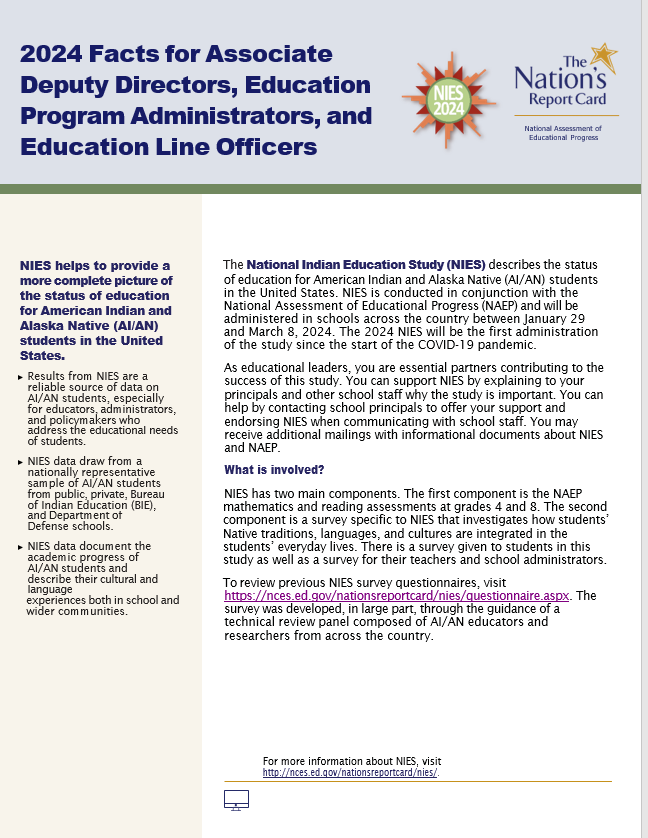
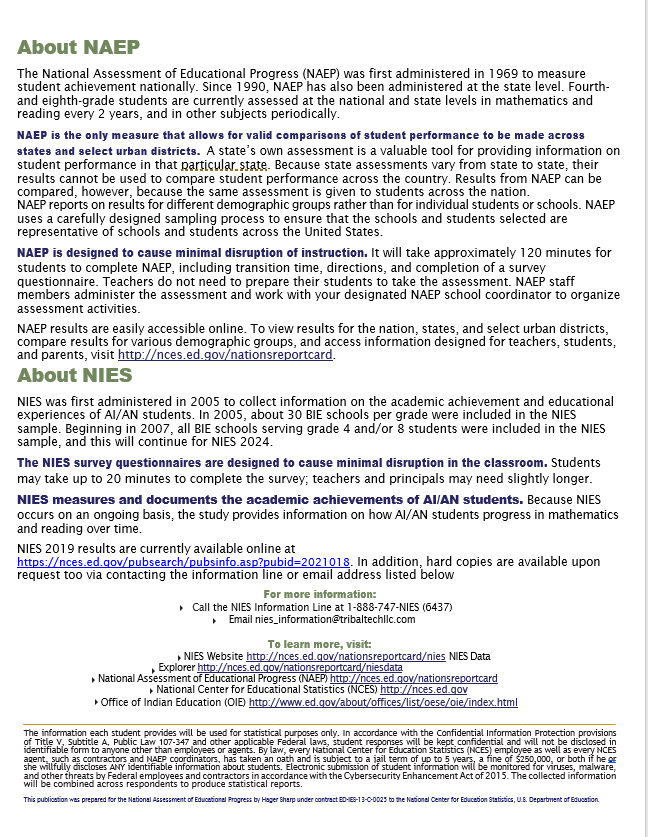
Appendix D-19: NIES 2024 Flyer (Approved v.29)
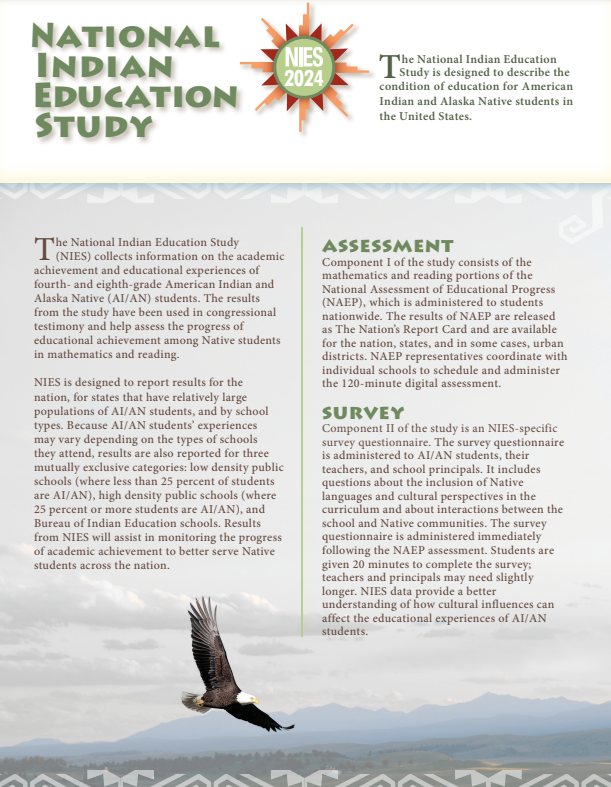

Appendix D-20: NIES Endorsement Letters (Approved v.29)



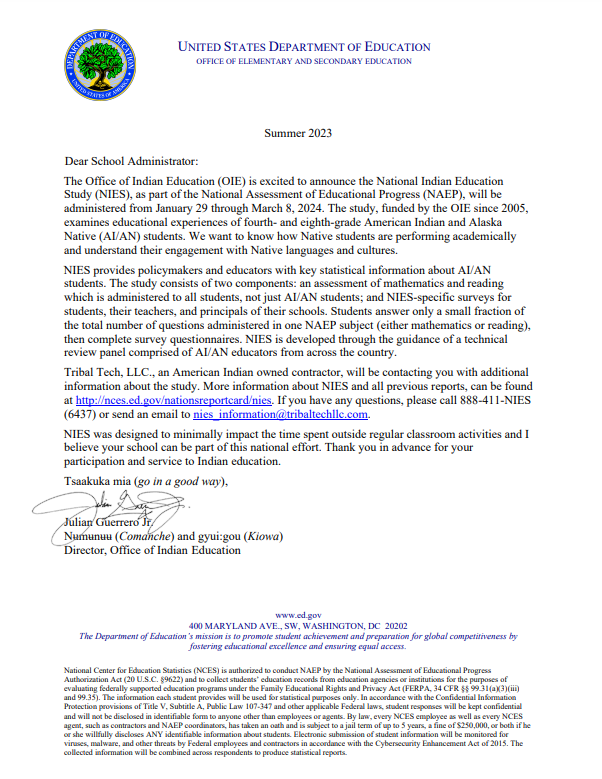
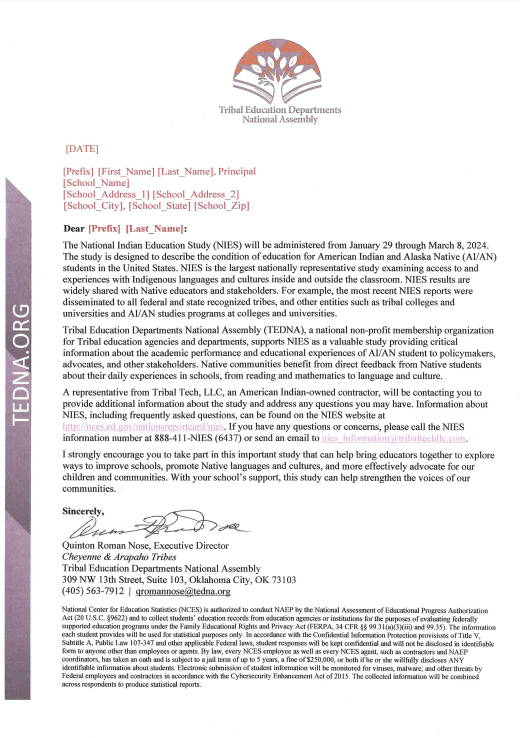
Appendix D-21: 2024 NAEP High School Transcript Study (HSTS) Parent or Guardian Information Letter (Approved v.30)
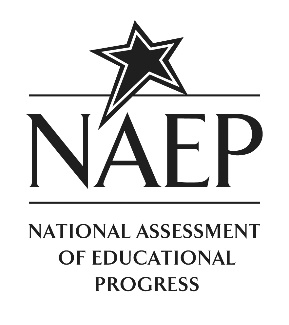
January-March 2024
Dear Parent or Guardian:
The National Center for Education Statistics of the U.S. Department of Education has authorized the National Assessment of Educational Progress (NAEP) to obtain student transcript data from schools selected to participate in the 2024 NAEP assessments. The collection of student transcripts is part of the 2024 NAEP High School Transcript Study (HSTS). This study provides information about the courses high school graduates took during their high school years, how many credits they earned, the grades they received, and the relationship of these coursetaking patterns to achievement on twelfth-grade NAEP. First conducted in 1987, HSTS has been gathering data on coursetaking for over three decades, with the most recent collection in 2019. The NAEP 2024 HSTS will be conducted during the summer after the selected students have graduated from high school.
Your child’s school has been selected for this important study. In the summer of 2024, NAEP will collect transcripts for a sample of students who were in the twelfth grade in the 2023–2024 school year. No student time is involved in the study. No student names or other identifying information will be released in any form.
The granting of authority to the Education Department for collection of the transcript data has been made pursuant to the provisions of the Family Education Rights and Privacy Act (FERPA) (20 U.S.C. 1232g), as implemented by 34 CFR 99.31 (a)(3)(ii) and 99.35. The privacy of the information will be protected as required by FERPA.
The NAEP 2024 HSTS is an important study that provides valuable information regarding the courses students take while in high school and the rigor of U.S. high schools. The participation of your child’s school is needed to make the results of this study comprehensive, accurate, and timely. More information about HSTS, including results from 2019, are available at http://nces.ed.gov/nationsreportcard/hsts.
Sincerely,
Daniel J. McGrath, Ph.D.
Acting Associate Commissioner
Assessments Division
The information each participant provides may be used only for statistical purposes and may not be disclosed, or used, in identifiable form for any other purpose except as required by law (20 U.S.C. §9573 and 6 U.S.C. §151). By law, every NCES employee as well as every NCES agent, such as contractors and NAEP coordinators, has taken an oath and is subject to a jail term of up to 5 years, a fine of $250,000, or both if he or she willfully discloses ANY identifiable information about students. Electronic submission of student information will be monitored for viruses, malware, and other threats by Federal employees and contractors in accordance with the Cybersecurity Enhancement Act of 2015. The collected information will be combined across respondents to produce statistical reports.
Appendix D-22: 2024 NAEP High School Transcript Study (HSTS) Parent or Guardian Consent Letter (Approved v.30)

January-March 2024
Dear Parent or Guardian:
The National Center for Education Statistics of the U.S. Department of Education has authorized the National Assessment of Educational Progress (NAEP) to obtain student transcript data from schools selected to participate in the 2024 NAEP assessments. The collection of student transcripts is part of the NAEP 2024 High School Transcript Study (HSTS). This study provides information about the courses high school graduates took during their high school years, how many credits they earned, the grades they received, and the relationship of these coursetaking patterns to achievement on twelfth-grade NAEP. First conducted in 1987, HSTS has been gathering data on coursetaking for over three decades, with the most recent collection in 2019. The NAEP 2024 HSTS will be conducted during the summer after the selected students have graduated from high school.
Your child’s school has been selected for this important study. In the summer of 2024, NAEP will collect transcripts for a sample of students who were in the twelfth grade in the 2023–2024 school year. Your child is one of the students for whom we may request transcript data. Please understand that no student time is involved in the study. No student names or other identifying information will be released in any form.
The granting of authority to the Education Department for collection of the transcript data has been made pursuant to the provisions of the Family Education Rights and Privacy Act (FERPA) (20 U.S.C. 1232g), as implemented by 34 CFR 99.31 (a)(3)(ii) and 99.35. The privacy of the information will be protected as required by FERPA.
Before we proceed, we want to make sure that you do not have any objections to releasing your child’s transcript information for these studies. If you object, please complete and return the attached form to the school.
The NAEP 2024 HSTS is an important study that provides valuable information regarding the courses high school students take and the rigor of U.S. high schools. I would appreciate your cooperation in this very important educational study. More information about HSTS, including results from 2019, are available at http://nces.ed.gov/nationsreportcard/hsts. Thank you for your time and consideration.
Sincerely,
Daniel J. McGrath, Ph.D.
Acting Associate
Commissioner
Assessments Division
---------------------------------------------------------------------------------------------------------------------
IF YOU DO NOT OBJECT TO THE RELEASE OF YOUR CHILD’S TRANSCRIPT, IT IS NOT NECESSARY TO RETURN THIS FORM TO THE SCHOOL.
I have been informed of the nature of the 2024 High School Transcript Study and object to the release of information from my child’s transcript.
Print Child’s Name: ______________________________________________________________
First Middle Last
______________________________________________________________________________
Parent or Guardian’s signature
The information each participant provides may be used only for statistical purposes and may not be disclosed, or used, in identifiable form for any other purpose except as required by law (20 U.S.C. §9573 and 6 U.S.C. §151). By law, every NCES employee as well as every NCES agent, such as contractors and NAEP coordinators, has taken an oath and is subject to a jail term of up to 5 years, a fine of $250,000, or both if he or she willfully discloses ANY identifiable information about students. Electronic submission of student information will be monitored for viruses, malware, and other threats by Federal employees and contractors in accordance with the Cybersecurity Enhancement Act of 2015. The collected information will be combined across respondents to produce statistical reports.
Appendix D-23: 2024 NAEP In Your School, High School Transcript Study (HSTS) (Approved v.30)
NAEP 2024 in Your School
High School Transcript Study
Page One Sidebar
NAEP is an integral part of education in the United States.
The National Assessment of Educational Progress (NAEP) is the largest continuing and nationally representative assessment of what our nation’s students know and can do in a variety of academic subjects. NAEP is a congressionally mandated project administered by the National Center for Education Statistics (NCES) within the U.S. Department of Education.
In addition to the assessments, NAEP coordinates several related special studies. Such studies often involve special data collection procedures in the field, in-depth analyses of NAEP results, and evaluations of various technical procedures.
The NAEP High School Transcript Study (HSTS), sponsored by NCES, is a periodic survey of transcripts of high school graduates to study the relationship between coursetaking patterns and student achievement.
Page One Body
The NAEP High School Transcript Study (HSTS) is designed to provide information about the types of courses that graduates take during high school, how many credits they earn, and their grade point averages. In addition, this study provides an opportunity to examine the relationship between coursetaking patterns and educational achievement by linking to NAEP proficiency data. The HSTS 2024 cohort includes public and private schools sampled for the NAEP 2024 grade 12 mathematics assessment.
What is collected for HSTS 2024?
Course catalogs or course lists for the current school year (2023–2024) and for the preceding three years (2020–2021, 2021–2022, and 2022–2023).
A survey with questions about course credits, grading policies, graduation requirements, transcript content information, and transcript submission preferences.
High school transcripts of graduates who were sampled for the NAEP mathematics assessment.
Who provides the information?
Schools will identify an HSTS coordinator to provide data for the study. The state or district may provide the data on behalf of the schools, if available.
How will student data be kept confidential?
Student names and all other identifying information will be removed or masked before transcript information is used in the analysis. No individually identifiable information will be released in any form. The privacy of the information will be protected as required by the Family Education Rights and Privacy Act (FERPA).
What else should you know?
No student or teacher time is involved. NAEP staff will work with school personnel to minimize burden as much as possible.
Privacy is a top priority. Students’ names and identifying information will be removed or masked before copies of transcripts are processed.
There is no cost to schools. NCES will pay a fee to the school for providing transcripts.
Parental notification is not required. Participating schools may choose whether or not to notify parents about this study.
Page One Footer
For more information about NAEP, visit nces.ed.gov/nationsreportcard.
Page Two
What have we learned from HSTS?
HSTS was first conducted in 1987 and has since examined several coursetaking patterns, including mathematics. The graph below highlights the highest level mathematics courses completed by graduates in 1990, 2000, 2009, and 2019. In 2019, about 41 percent of high school graduates’ highest level mathematics course completed was an advanced mathematics course, such as precalculus, statistics, or trigonometry—the highest percentage compared to previous decades.
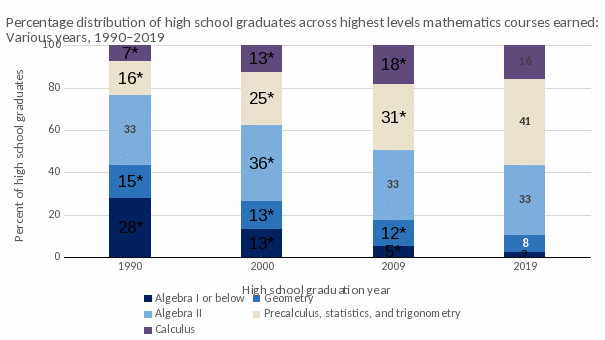
*Significantly different (p<.05) from 2019
NOTE: Details may not sum to total due to rounding. The figure shows the highest level mathematics courses in which a high school graduate earned credits. Advanced mathematics includes mathematics courses usually taken after algebra II and before calculus, such as trigonometry, precalculus, mathematical analysis, elementary functions, and probability and statistics.
SOURCE: U.S. Department of Education, Institute of Education Sciences, National Center for Education Statistics, National Assessment of Educational Progress (NAEP) High School Transcript Study, various years, 1990–2019.
Where can I find more information?
More information about the NAEP High School Transcript Study can be found on the NAEP website at http://nces.ed.gov/nationsreportcard/hsts.
The
granting of authority to the U.S. Department of Education for
collection of the transcript data has been made pursuant to the
provisions of the Family Educational Rights and Privacy Act (FERPA)
(20 U.S.C. 1232g), as implemented by 34 CFR 99.31 (a)(3)(ii) and
99.35. A copy of the relevant FERPA regulations will be provided to
you prior to the collection of any transcripts.
All of the information provided by participants may be used only for statistical purposes and may not be disclosed, or used, in identifiable form for any other purpose except as required by law (20 U.S.C. §9573 and 6 U.S.C. §151). By law, every National Center for Education Statistics (NCES) employee as well as every NCES agent, such as contractors and NAEP coordinators, has taken an oath and is subject to a jail term of up to 5 years, a fine of $250,000, or both if he or she willfully discloses ANY identifiable information about participants. Electronic submission of participant’s information will be monitored for viruses, malware, and other threats by Federal employees and contractors in accordance with the Cybersecurity Enhancement Act of 2015. The collected information will be combined across respondents to produce statistical reports.
Page Two Footer
Find us on: [insert social media icons]
This publication was prepared for the National Assessment of Educational Progress by Hager Sharp under contract ED-IES-13-C-0025 to the National Center for Education Statistics, U.S. Department of Education.
Appendix D-24: 2024 NAEP High School Transcript Study (HSTS) Decision Guide for Submitting Student Transcripts (Approved v.30)
Decision Guide for Submitting Student Transcripts
The
information in this guide will help you make the best choice
regarding whether to upload transcript files using the Assessment
Management System (AMS), or prepare paper transcripts to be
collected in person by NAEP staff.
Step 1: Consider the Transcript Format
The method that is easiest for you may depend on the format in which you maintain your transcript records.
For electronic submission, you must have transcript files in one of the following formats:
Preferred: Microsoft Excel or comma-separated-value (CSV)
Accepted: Adobe Acrobat PDF, Microsoft Word, Microsoft Access, formatted text (TXT), SPSS, or SAS
For paper submission, you must have hardcopy transcript files available for the selected students.
Step 2: Consider the Time and Work Involved
The following table compares the major tasks involved with each submission method.
Method 1: Upload Transcripts on the AMS
|
Method 2: Prepare Paper Transcripts for In-Person Collection
|
|
|
Appendix D-25: 2024 NAEP High School Transcript Study (HSTS) Guidelines for Districts Submitting Electronic Transcripts (Approved v.30)


HSTS
Guidelines for Districts Submitting Electronic Transcripts
|
|
2024
High School Transcript Study
|
Introduction
This guide outlines the steps to submit student transcripts electronically, using the provided Excel student list template or another format. Electronically submitting student transcripts involves obtaining records for the students participating in the 2024 NAEP High School Transcript Study (HSTS), ensuring all required data fields are included in the transcript records, deleting personally identifiable information from the records, and uploading your data file(s) to the Assessment Management System (AMS) website.
Contents
Step 1: Download Your Student List 3
Provide Student Exit Status 4
Step 2: Prepare Your Transcript Records 5
Use an Accepted File Format 5
Include All Required Fields 6
Create a Key 9
Provide Test Scores 10
Delete Sensitive Data 11
Step 3: Upload Transcript Records 12
Step 1: Download Your Student List
To start this activity, download the Student List template file of students selected for grade 12 NAEP mathematics from the Assessment Management System (AMS). This Excel template has six worksheets with labeled tabs (figure 1):
Instructions – a brief description of how to use the template;
Student List – the list of students sampled for HSTS;
Student Transcripts – a template with the required data fields;
Example Key – an example key that includes the preferred exit status values;
Key – a blank key to clarify any abbreviations used; and
Test Scores – a template where ACT, SAT, or PSAT scores can be provided, if available.
The
Student
List tab
will include the following information for each record: School Name,
NAEP ID, Student Name, Student ID (if it was included on the student
list provided in the fall), Month and Year of Birth, and HSTS ID.
Figure 1. Student List worksheet
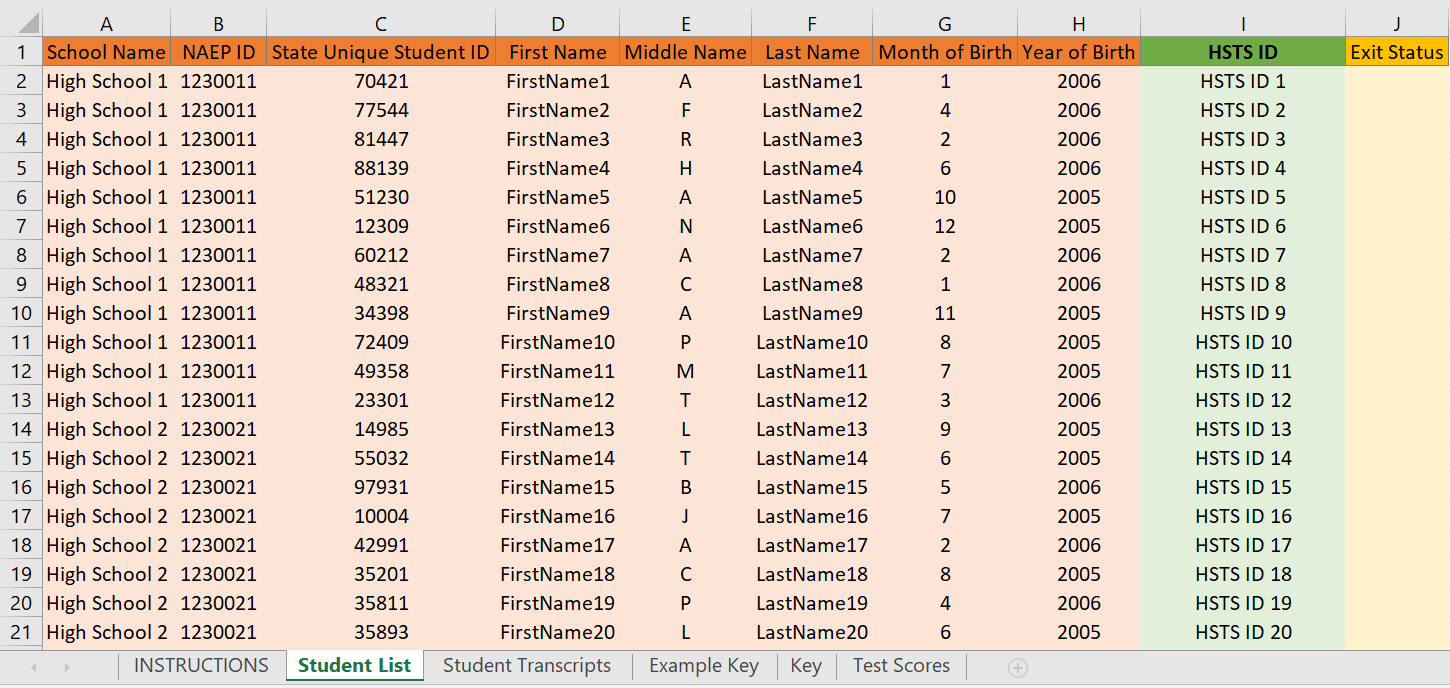
Provide Student Exit Status
The Student List tab of the Excel template contains a column for student Exit Status. Please record the Exit Status for each student on the list. The Exit Status is the type of diploma the student earned or the student’s current status after their twelfth-grade year. Diploma types include standard diploma, honors diploma, diploma with special education adjustments, certificate of attendance, and certificate of completion. Other exit statuses include still enrolled in the school, dropped out, transferred, earned a GED, or has not met graduation requirements. If possible, please use the key provided in the Example Key tab for the exit status (figure 2); otherwise, please provide a key in the Key tab if other abbreviations or statuses are used.
Figure 2. Example Key worksheet with preferred exit status values
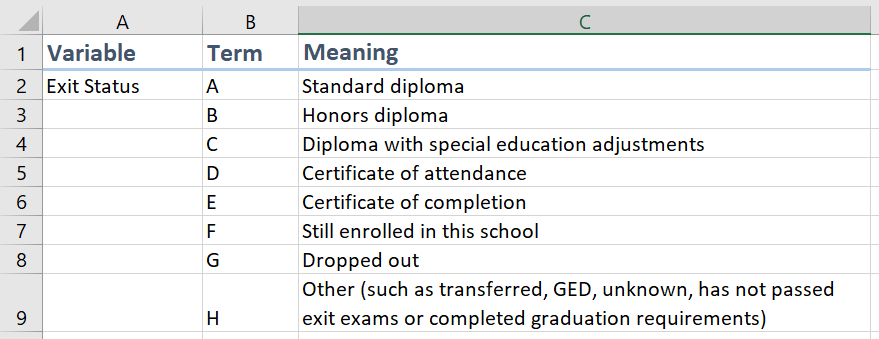
Step 2: Prepare Your Transcript Records
Use an Accepted File Format
The student transcript records can be provided in various formats. Microsoft Excel or comma separated value (CSV) files are strongly recommended because they provide a clear delineation of the transcript data.
Other acceptable transcript file
formats include
Microsoft Word;
Microsoft Access databases;
Adobe PDF;
Formatted text;
SPSS; and
SAS.
The image below shows an example of an Excel-based district transcript file (figure 3).
Figure 3. Example transcript data
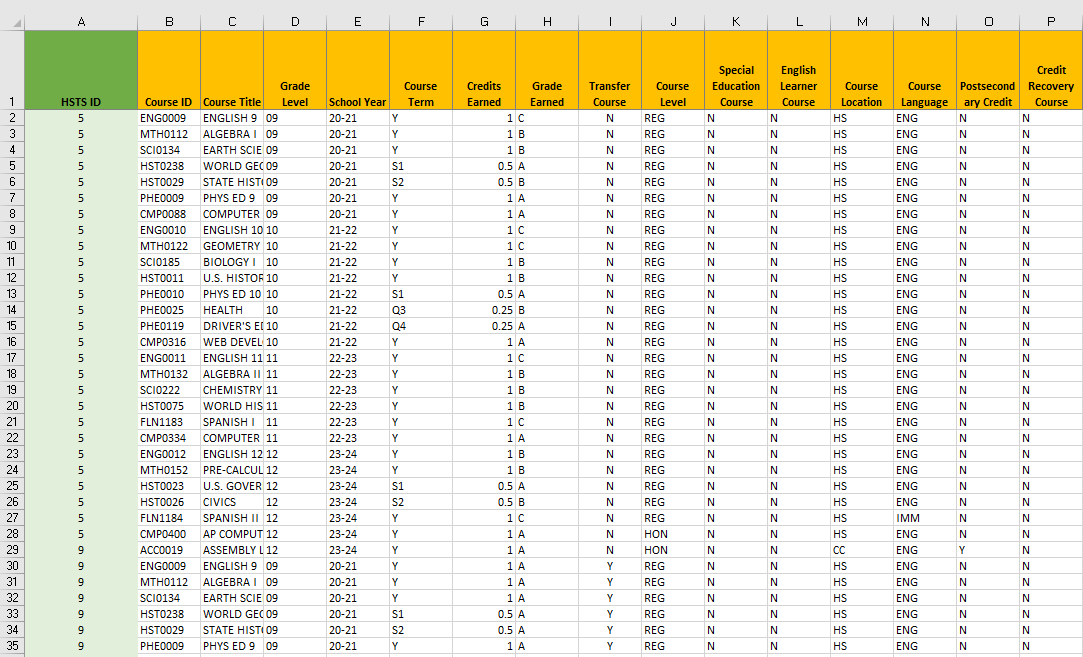
Include All Required Fields
For each course record, there are two sets of information requested: required and optional data fields. (1) Required data fields include information needed to link, process, and analyze the course records. (2) The optional data fields provide additional data that will aid in the analysis but may be found in other sources (such as the course catalogs that were provided). Both the required data fields and optional data fields are included as column headers on the Student Transcript tab of the Student List template (figure 4).
Required and
Optional Data Fields
Required
Optional
HSTS
ID
Course
Level
Course
ID
Special
Education Course
Course
Title
English
Learner Course
Grade
Level
Course
Language
School
Year
Course
Location
Course
Term
Postsecondary
Credit
Credits
Earned
Credit
Recovery
Grade
Earned
Transfer
Course

The required data fields are as follows:
HSTS ID – The HSTS ID is an identifier found on the sampled student list. It is very important that this number be on the submitted electronic student transcript file. This number allows the student’s transcript to be linked with their NAEP assessment data without the need for any additional student personal information.
Course ID – The course ID number of the course taken. It should be the same course ID number as listed in the course catalog. If the state, district, or school does not have a course ID numbering system, then the field is left blank.
Course Title – The name of the course taken.
Grade Level – The grade level in which the student was enrolled when the course was taken (e.g., ninth, tenth, eleventh, and twelfth).
School Year – The school year when the course was taken.
Course Term – The length of time the course was taken, relative to the school year. The values for this field can be either general (Year, Trimester, etc.) or specific (Semester 1, Quarter 4, Summer session, etc.). Please provide a key if abbreviations are used.
Credits Earned – The number of credits earned by the student for the course taken.
Grade Earned – The grade that was earned by the student for the course taken. It can be letter grades (A, B, C, etc.); numeric grades (53, 82, 100, etc.); proficiency levels (Exceeds expectations, Meets expectations, etc.); pass/fail (P or F); or other grading codes (incomplete, withdrawn, satisfactory/unsatisfactory, not applicable, etc.). Please provide a key if abbreviations are used for grading codes that are non-letter or non-numeric.
Transfer Course – A yes-no indicator that marks if the course was taken at a school outside of the state or school district. Use this field to indicate transfer courses of students who moved from outside the state/district into the school after the start of the 2020–2021 school year.
The optional data fields are as follows:
Course Level – An indicator of the rigor of the course taken. We recommend using the levels established by the School Courses for the Exchange of Data (SCED) coding system: basic/remedial; general/regular; enriched/advanced; and honors. Please provide a key if abbreviations are used.
Special Education Course – An indicator that notes if the course taken counts as a special education course for the student.
English Learner Course – An indicator that notes if the course taken counts as an English learner course for the student.
Course Language – The primary language in which the course was taught. This field mostly indicates if a course was taught solely in English, solely in another language (such as world language immersion courses), or in multiple languages (such as English learner courses). Please provide a key if abbreviations are used.
Course Location – An indicator of where the student took the course. While most courses are taken at the high school, other possible locations include another high school, a vocational center, community college, or taken as an online course. If the course location was affected by the COVID-19 pandemic, this field would indicate those changes, such as a temporary online course or hybrid course. Please provide a key if abbreviations are used.
Postsecondary Credit – An indicator of whether credit is earned for the course at colleges, universities, or vocational/trade schools. The credit could be earned immediately upon completion of the course, or it may be conditional upon taking other selected courses at specified institutions.
Credit Recovery – An indicator of whether the course was taken for recovering credits for courses a student did not pass or complete.
Create a Key
As noted in the field descriptions above, please consider whether any of your data are formatted as abbreviations that may require explanation. This information is best provided in the form of a key. You can use the Key tab within the Student List Template Excel file to define the abbreviations or include them in a separate text file. The Excel file also contains an Example Key tab (figure 5) that you can use.
Figure 5. Example Key
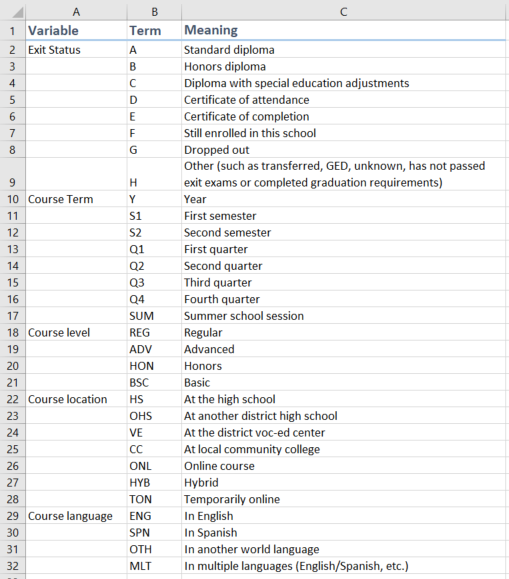
Provide Test Scores
If standardized test scores are available for the sampled students, the scores can be provided in the Test Scores tab (figure 6). Including test scores allows for linking student coursetaking patterns with postsecondary success as measured by common standardized tests. Providing information for this tab is optional.
We collect data on the following tests:
ACT
SAT
PSAT
Please include the test name, score, and date taken along with the student HSTS ID.
Figure 6. Test Scores tab
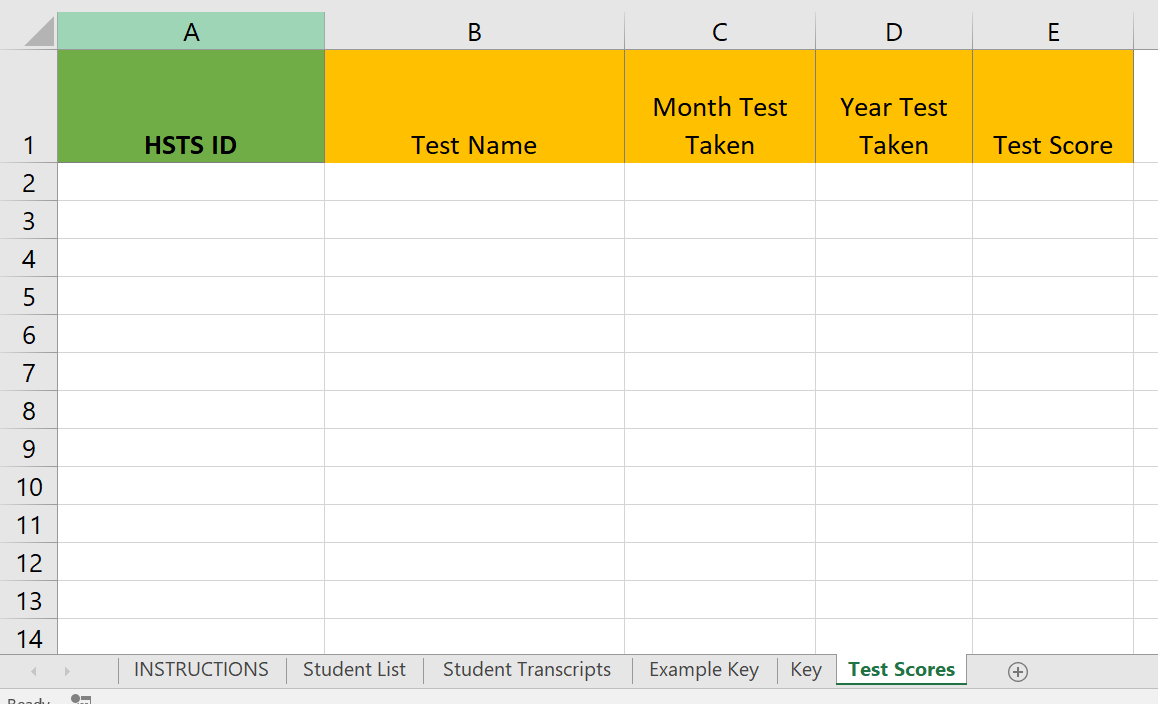
Delete Sensitive Data
No personally identifiable information, such as students’ names or student ID numbers, should be on your transcript file when you submit it. Please delete all personally identifiable information (figure 7) before uploading the student transcript file. Be sure that your file has the HSTS ID field so that we can link the student’s transcript record to their NAEP information.
Delete fields
with personally identifiable information
Figure
7. Deleting PII from the Excel template

Step 3: Upload Transcript Records
When you have finished preparing your transcript records, please upload your file(s) to the AMS website.
Before submitting the transcript files, review the following checklist:
The file contains all sampled students.
An Exit Status is provided for each sampled student.
The file contains all required variables.
An HSTS ID (provided by NAEP) is associated with each transcript record.
Personally Identifiable Information is removed.
Password protection has been removed from all files.
Thank you for submitting transcripts electronically. If you need further assistance, please contact the NAEP help desk by email ([email protected]) or by phone (1-800-283-6237).
Appendix D-26: 2024 NAEP High School Transcript Study (HSTS) Guidelines for Schools Submitting Electronic Transcripts (Approved v.30)



|
|
2024
High School Transcript Study
|
HSTS
Guidelines for Schools Submitting Electronic Transcripts:
Database
Format
Introduction
This guide outlines the steps to submit student transcripts electronically, using the provided Excel student list template or another database format. Electronically submitting student transcripts involves obtaining records for the students participating in the 2024 NAEP High School Transcript Study (HSTS), ensuring all required data fields are included in the transcript records, deleting personally identifiable information from the records, and uploading your data file(s) to the Assessment Management System (AMS) website.
Step 1: Download Your Student List 3
Provide Student Exit Status 4
Step 2: Prepare Your Transcript Records 5
Use an Accepted File Format 5
Include All Required Fields 6
Create a Key 9
Provide Test Scores 10
Delete Sensitive Data 11
Step 3: Upload Transcript Records 12
Step 1: Download Your Student List
To start this activity, download the Student List template file of students selected for grade 12 NAEP mathematics from the Assessment Management System (AMS). This Excel template has six worksheets with labeled tabs (figure 1):
Instructions – a brief description of how to use the template;
Student List – the list of students sampled for HSTS;
Student Transcripts – a template with the required data fields;
Example Key – an example key that includes the preferred exit status values;
Key – a blank key to clarify any abbreviations used; and
Test Scores – a template where ACT, SAT, or PSAT scores can be provided, if available.
The Student List tab will include the following information for each record: Student Name, Student ID (if it was included on the student list provided in the fall), Month and Year of Birth, and HSTS ID.
Figure
. Student List worksheet
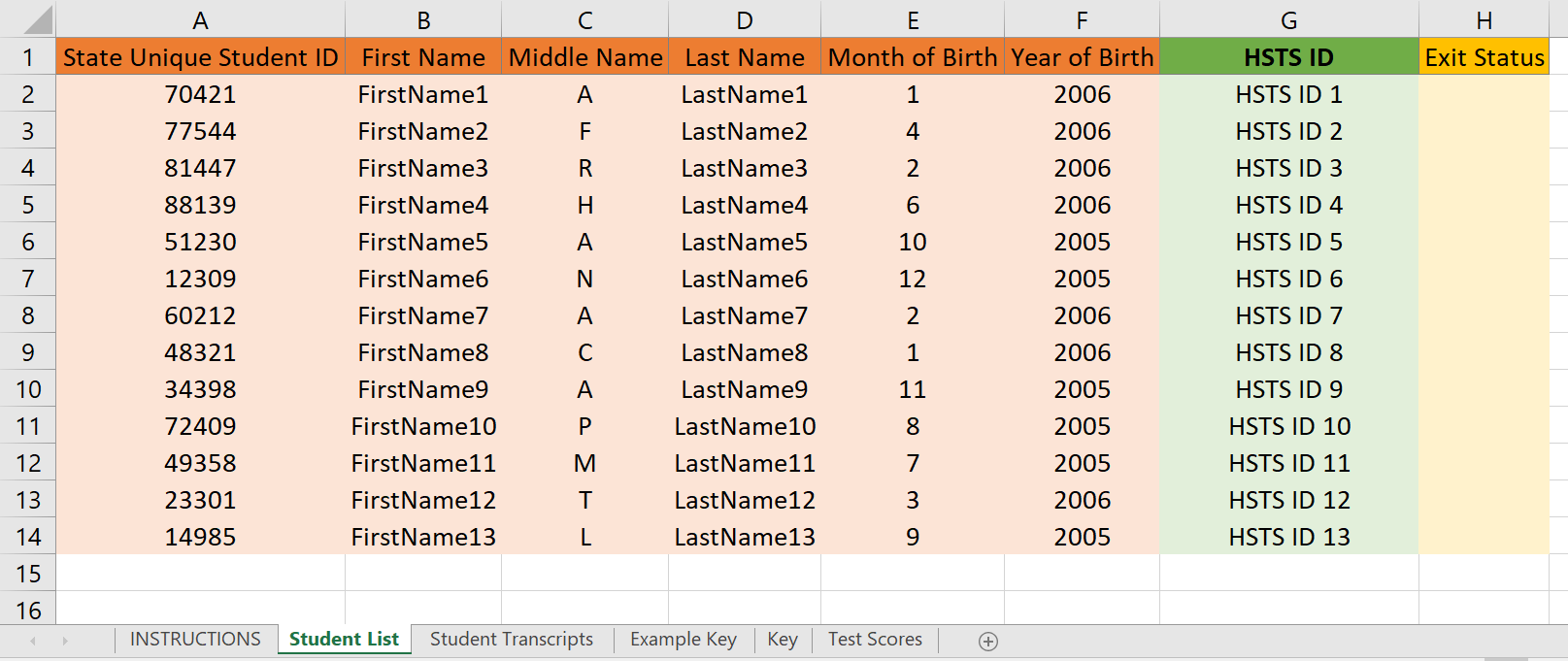
Provide Student Exit Status
The Student List tab of the Excel template contains a column for student Exit Status. Please record the Exit Status for each student on the list. The Exit Status is the type of diploma the student earned or the student’s current status after their twelfth-grade year. Diploma types include standard diploma, honors diploma, diploma with special education adjustments, certificate of attendance, and certificate of completion. Other exit statuses include still enrolled in this school, dropped out, transferred, earned a GED, or has not met graduation requirements. If possible, please use the key provided in the Example Key tab for the exit status (figure 2); otherwise, please provide a key in the Key tab if other abbreviations or statuses are used.
Figure . Example Key worksheet with preferred exit status values

Step 2: Prepare Your Transcript Records
Use an Accepted File Format
The student transcript records can be provided in various formats. Microsoft Excel or comma separated value (CSV) files are strongly recommended because they provide a clear delineation of the transcript data.
Other acceptable transcript file formats include
Microsoft Word;
Microsoft Access databases;
Adobe PDF;
Formatted text;
SPSS; and
SAS.
The image below shows an example of an Excel-based high school transcript file (figure 3).
Figure
. Example transcript data

Include All Required Fields
For each course record, there are two sets of information requested: required and optional data fields. (1) Required data fields include information needed to link, process, and analyze the course records. (2) The optional data fields provide additional data that will aid in the analysis but may be found in other sources (such as the course catalogs that were provided). Both the required data fields and optional data fields are included as column headers on the Student Transcript tab of the Student List template (figure 4).
Required and
Optional Data Fields
Required
Optional
HSTS
ID
Course
Level
Course
ID
Special
Education Course
Course
Title
English
Learner Course
Grade
Level
Course
Language
School
Year
Course
Location
Course
Term
Postsecondary
Credit
Credits
Earned
Credit
Recovery
Grade
Earned
Transfer
Course

The required data fields are as follows:
HSTS ID – The HSTS ID is an identifier found on the sampled student list. It is very important that this number be on the submitted electronic student transcript file. This number allows the student’s transcript to be linked with their NAEP assessment data without the need for any additional student personal information.
Course ID – The course ID number of the course taken. It should be the same course ID number as listed in the course catalog. If the state, district, or school does not have a course ID numbering system, then the field is left blank.
Course Title – The name of the course taken.
Grade Level – The grade level in which the student was enrolled when the course was taken (e.g., ninth, tenth, eleventh, and twelfth).
School Year – The school year when the course was taken.
Course Term – The length of time the course was taken, relative to the school year. The values for this field can be either general (Year, Trimester, etc.) or specific (Semester 1, Quarter 4, Summer session, etc.). Please provide a key if abbreviations are used.
Credits Earned – The number of credits earned by the student for the course taken.
Grade Earned – The grade that was earned by the student for the course taken. It can be letter grades (A, B, C, etc.); numeric grades (53, 82, 100, etc.); proficiency levels (Exceeds expectations, Meets expectations, etc.); pass/fail (P or F); or other grading codes (incomplete, withdrawn, satisfactory/unsatisfactory, not applicable, etc.). Please provide a key if abbreviations are used for grading codes that are non-letter or non-numeric.
Transfer Course – A yes-no indicator that marks if the course was taken at a school outside of the state or school district. Use this field to indicate transfer courses of students who moved from outside the state/district into the school after the start of the 2020–2021 school year.
The optional data fields are as follows:
Course Level – An indicator of the rigor of the course taken. We recommend using the levels established by the School Courses for the Exchange of Data (SCED) coding system: basic/remedial; general/regular; enriched/advanced; and honors. Please provide a key if abbreviations are used.
Special Education Course – An indicator that notes if the course taken counts as a special education course for the student.
English Learner Course – An indicator that notes if the course taken counts as an English learner course for the student.
Course Language – The primary language in which the course was taught. This field mostly indicates if a course was taught solely in English, solely in another language (such as world language immersion courses), or in multiple languages (such as English learner courses). Please provide a key if abbreviations are used.
Course Location – An indicator of where the student took the course. While most courses are taken at the high school, other possible locations include another high school, a vocational center, community college, or taken as an online course. If the course location was affected by the COVID-19 pandemic, this field would indicate those changes, such as a temporary online course or hybrid course. Please provide a key if abbreviations are used.
Postsecondary Credit – An indicator of whether credit is earned for the course at colleges, universities, or vocational/trade schools. The credit could be earned immediately upon completion of the course, or it may be conditional upon taking other selected courses at specified institutions.
Credit Recovery – An indicator of whether the course was taken for recovering credits for courses a student did not pass or complete.
Create a Key
As noted in the field descriptions above, please consider whether any of your data are formatted as abbreviations that may require explanation. This information is best provided in the form of a key. You can use the Key tab within the Student List Template Excel file to define the abbreviations or include them in a separate text file. The Excel file also contains an Example Key tab (figure 5) that you can use.
Figure 5. Example Key

Provide Test Scores
If standardized test scores are available for the sampled students, the scores can be provided in the Test Scores tab (figure 6). Including test scores allows for linking student coursetaking patterns with postsecondary success as measured by common standardized tests. Providing information for this tab is optional.
We collect data on the following tests:
ACT
SAT
PSAT
Please include the test name, score, and date taken along with the student HSTS ID.
Figure 6. Test Scores tab

Delete Sensitive Data
No personally identifiable information, such as students’ names or student ID numbers, should be on your transcript file when you submit it. Please delete all personally identifiable information (figure 7) before uploading the student transcript file. Be sure that your file has the HSTS ID field so that we can link the student’s transcript record to their NAEP information.
Figure 7. Deleting PII from the Excel template
Delete fields
with personally identifiable information
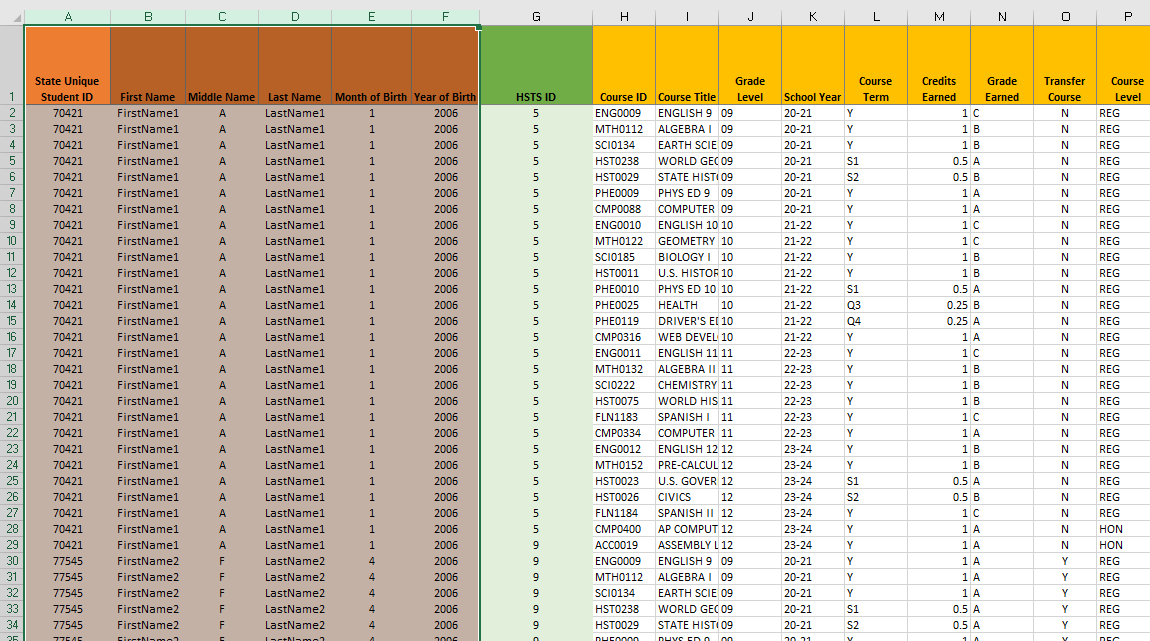
Step 3: Upload Transcript Records
When you have finished preparing your transcript records, please upload your file(s) to the AMS website.
Before submitting the transcript files, review the following checklist:
The file contains all sampled students.
An Exit Status is provided for each sampled student.
The file contains all required variables.
An HSTS ID (provided by NAEP) is associated with each transcript record.
Personally Identifiable Information is removed.
Password protection has been removed from all files.
Thank you for submitting transcripts electronically. If you need further assistance, please contact the NAEP help desk by email ([email protected]) or by phone (1-800-283-6237).
Appendix D-27: 2024 NAEP High School Transcript Study (HSTS) Guidelines for Schools Submitting PDF Transcripts (Approved v.30)



|
|
2024
High School Transcript Study
|
HSTS Guidelines for Schools Submitting PDF Transcripts
Introduction
Submitting student transcripts involves obtaining records for the students participating in the 2024 NAEP High School Transcript Study, ensuring all required data fields are included in the transcript records, deleting sensitive data from the records, and uploading your data file(s) to the HSTS website. The instructions that follow describe each of these aspects of the transcript submission process.
Step 1: Download Your Student List 1
Provide Student Exit Status 2
Step 2: Prepare Your Transcript Records 3
Include All Required Fields 3
Create a Key 6
Provide Test Scores 7
Delete Sensitive Data 8
Step 3: Upload Your Transcript Records 10
Step 1: Download Your Student List
To start this activity, download the Student List template file of students selected for grade 12 NAEP mathematics from the Assessment Management System (AMS). This Excel template has six worksheets with labeled tabs (figure 1):
Instructions – a brief description of how to use the template;
Student List – the list of students sampled for HSTS;
Student Transcripts – a template with the required data fields;
Example Key – an example key that includes the preferred exit status values;
Key – a blank key to clarify any abbreviations used; and
Test Scores – a template where ACT, SAT, or PSAT scores can be provided, if available.
The
Student
List tab
will include the following information for each record: Student
Name, Student ID (if it was included on the student list provided in
the fall), Month and Year of Birth, and HSTS ID.
Figure . Student List worksheet
Provide Student Exit Status
The Student List tab of the Excel template contains a column for student Exit Status. Please record the Exit Status for each student on the list. The Exit Status is the type of diploma the student earned or the student’s current status after their twelfth-grade year. Diploma types include standard diploma, honors diploma, diploma with special education adjustments, certificate of attendance, and certificate of completion. Other exit statuses include still enrolled in this school, dropped out, transferred, earned a GED, or has not met graduation requirements. If possible, please use the key provided in the Example Key tab for the exit status (figure 2); otherwise, please provide a key in the Key tab if other abbreviations or statuses are used.
Figure . Example Key worksheet with preferred exit status values

Step 2: Prepare Your Transcript Records
For each course record, there are two sets of information requested: required and optional data fields. (1) Required data fields include information needed to link, process, and analyze the course records. (2) The optional data fields provide additional data that will aid in the analysis but may be found in other sources (such as the course catalogs that were provided). Both the required data fields and optional data fields are included as column headers on the Student Transcript tab of the Student List template (figure 4).
Required and
Optional Data Fields
Required
Optional
HSTS
ID
Course
Level
Course
ID
Special
Education Course
Course
Title
English
Learner Course
Grade
Level
Course
Language
School
Year
Course
Location
Course
Term
Postsecondary
Credit
Credits
Earned
Credit
Recovery
Grade
Earned
Transfer
Course

The required data fields are as follows:
HSTS ID – The HSTS ID is an identifier found on the sampled student list. It is very important that this number be on the submitted electronic student transcript file. This number allows the student’s transcript to be linked with their NAEP assessment data without the need for any additional student personal information.
Course ID – The course ID number of the course taken. It should be the same course ID number as listed in the course catalog. If the state, district, or school does not have a course ID numbering system, then the field is left blank.
Course Title – The name of the course taken.
Grade Level – The grade level in which the student was enrolled when the course was taken (e.g., ninth, tenth, eleventh, and twelfth).
School Year – The school year when the course was taken.
Course Term – The length of time the course was taken, relative to the school year. The values for this field can be either general (Year, Trimester, etc.) or specific (Semester 1, Quarter 4, Summer session, etc.). Please provide a key if abbreviations are used.
Credits Earned – The number of credits earned by the student for the course taken.
Grade Earned – The grade that was earned by the student for the course taken. It can be letter grades (A, B, C, etc.); numeric grades (53, 82, 100, etc.); proficiency levels (Exceeds expectations, Meets expectations, etc.); pass/fail (P or F); or other grading codes (incomplete, withdrawn, satisfactory/unsatisfactory, not applicable, etc.). Please provide a key if abbreviations are used for grading codes that are non-letter or non-numeric.
Transfer Course – A yes-no indicator that marks if the course was taken at a school outside of the state or school district. Use this field to indicate transfer courses of students who moved from outside the state/district into the school after the start of the 2020–2021 school year.
The optional data fields are as follows:
Course Level – An indicator of the rigor of the course taken. We recommend using the levels established by the School Courses for the Exchange of Data (SCED) coding system: basic/remedial; general/regular; enriched/advanced; and honors. Please provide a key if abbreviations are used.
Special Education Course – An indicator that notes if the course taken counts as a special education course for the student.
English Learner Course – An indicator that notes if the course taken counts as an English learner course for the student.
Course Language – The primary language in which the course was taught. This field mostly indicates if a course was taught solely in English, solely in another language (such as world language immersion courses), or in multiple languages (such as English learner courses). Please provide a key if abbreviations are used.
Course Location – An indicator of where the student took the course. While most courses are taken at the high school, other possible locations include another high school, a vocational center, community college, or taken as an online course. If the course location was affected by the COVID-19 pandemic, this field would indicate those changes, such as a temporary online course or hybrid course. Please provide a key if abbreviations are used.
Postsecondary Credit – An indicator of whether credit is earned for the course at colleges, universities, or vocational/trade schools. The credit could be earned immediately upon completion of the course, or it may be conditional upon taking other selected courses at specified institutions.
Credit Recovery – An indicator of whether the course was taken for recovering credits for courses a student did not pass or complete.
Create a Key
As noted in the field descriptions above, please consider whether any of your data are formatted as abbreviations that may require explanation. This information is best provided in the form of a key. You can use the Key tab within the Student List Template Excel file to define the abbreviations or include them in a separate text file. The Excel file also contains an Example Key tab (figure 4) that you can use.
Figure 4. Example Key

Figure 3 Example Key
Provide Test Scores
If standardized test scores are available for the sampled students, but not listed on the transcripts, the scores can be provided in the Test Scores tab (figure 5). Including test scores allows for linking student coursetaking patterns with postsecondary success as measured by common standardized tests. Providing information for this tab is optional.
We collect data on the following tests:
ACT
SAT
PSAT
Please include the test name, score, and date taken along with the student HSTS ID.
Figure 5. Test Scores tab

Delete Sensitive Data
No personally identifiable information, such as students’ names or student ID numbers, should be on your transcript file when you submit it. Please delete all personally identifiable information (figure 6) before uploading the student transcript file. Be sure that your file has the HSTS ID field so that we can link the student’s transcript record to their NAEP information.
Do not include sensitive information, such as student addresses, parent/guardian information, social security numbers, student pictures, or health records on your transcript file when you submit it.
If you are working with a service provider to prepare the transcripts, it is recommended that you ask the provider to remove the sensitive data when preparing files. If you cannot remove the extra data electronically, you can print the transcripts, manually mask the sensitive data (for example, use a black marker to obscure the data or scissors to cut out the data), and then scan the masked transcripts.
Be sure that your file has the students’ HSTS ID on each page of the transcripts so that the students’ transcript records can be linked to their NAEP information. If this cannot be done electronically, manually write the HSTS ID on each page before scanning the transcripts to submit.
Make sure the scanned document is legible, and sensitive information is not still visible through the masking before submitting the transcripts.
Any personally identifiable information or sensitive information included on the transcript files will be deleted once transcripts are received.
Figure 6: Example PDF Transcript with HSTS ID and PII masked
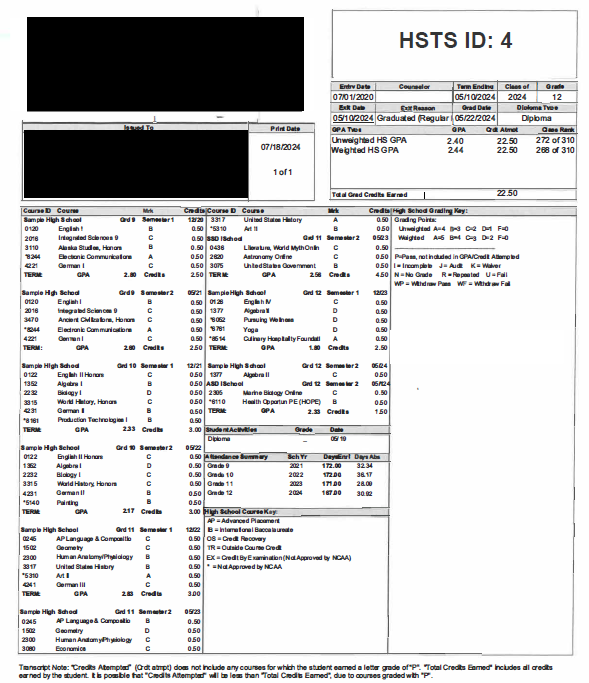
Step 3: Upload Transcript Records
When you have finished preparing your transcript records, please upload your file(s) to the AMS website. Upload the Exit Statuses along with the transcript files if you are providing the Exit Statuses in a separate file.
Before submitting the transcript files, review the following checklist:
The file contains all sampled students.
An Exit Status is provided for each sampled student.
The file contains all required variables.
An HSTS ID (provided by NAEP) is associated with each transcript record.
Personally Identifiable Information is removed.
Password protection has been removed from all files.
Thank you for submitting transcripts electronically. If you need further assistance, please contact the NAEP help desk by email ([email protected]) or by phone (1-800-283-6237).
Appendix D-28: 2024 NAEP High School Transcript Study (HSTS) District Assessment Coordinator Letter (Approved v.30)
NAEP 2024 Identify District HSTS Coordinator
NAEP STATE COORDINATOR TO DISTRICT ASSESSMENT COORDINATOR
Red text should be customized before mail merge, highlighted text represents mail merge fields.
::Do not distribute until notified that the AMS is ready for school and district user access::
Dear District Assessment Coordinator:
At the end of the school year, I notified a school/several schools in your district of their selection to participate in the National Assessment of Educational Progress (NAEP). High schools selected for grade 12 assessments will also participate in the High School Transcript Study (HSTS), which involves the collection of student transcripts and course catalogs. This information will be used to examine coursetaking patterns of students and relate those patterns to educational achievement and NAEP assessment data. First conducted in 1987, HSTS has been gathering data on coursetaking for more than 3 decades, with the most recent collection in 2019. To learn more about the HSTS, please visit https://nces.ed.gov/nationsreportcard/hsts.
The following school/schools in your district was/were selected to participate in HSTS:
[List of Selected Schools:]/[The list of selected schools is attached.]
School 1
School 2
Etc.
To make things easier for schools, districts can provide the needed information for this study on behalf of their schools.
Provide course catalogs or course lists for the current school year (2023–2024) and for the preceding 3 years (2022–2023, 2021–2022, and 2020–2021).
Complete a Transcript Information Survey with questions about credits awarded for courses, grading policies, and graduation requirements, as well as transcript information.
Submit Transcripts for students selected for HSTS. Transcripts will be collected starting in summer 2024.
To
complete these tasks for your schools, you will need to designate a
district HSTS coordinator. The district HSTS coordinator should have
access to the data listed above and be comfortable using Excel.
To designate a district HSTS coordinator, you will need to do the following:
Work with district technology staff as necessary to add the domain westatstudies.com to the safe senders list.
{Use this bullet if following Option 1, district assessment coordinator registers and invites district HSTS coordinator} Log in and set up your NAEP Assessment Management System (AMS) account using the link provided in the registration email from [email protected].
{Use this bullet if following Option 1, district assessment coordinator registers and invites district HSTS coordinator} Enter the HSTS coordinator’s name and contact information in the AMS, select their role as HSTS coordinator, and select Send Invite.
{Use this bullet if following Option 2, NSC invites the HSTS coordinator} Send the designated HSTS coordinator’s name and email address to me using the email address provided below.
Please share the District HSTS Coordinator Responsibilities Letter with your designated district HSTS coordinator. The district HSTS coordinator can then activate their AMS account and begin to submit course catalog data and complete the Transcript Information Survey.
Thank you for your assistance with this very important study of our nation’s high school graduates. If you have questions, please contact me at telephone number or email address.
Sincerely,
NAEP State Coordinator
Enclosures:
District HSTS Coordinator Responsibilities Letter
National Center for Education Statistics (NCES) conducts the National Assessment of Educational Progress to evaluate federally supported education programs. All of the information you provide may be used only for statistical purposes and may not be disclosed, or used, in identifiable form for any other purpose except as required by law (20 U.S.C. §9573 and 6 U.S.C. §151). By law, every NCES employee as well as every NCES agent, such as contractors and NAEP coordinators, has taken an oath and is subject to a jail term of up to 5 years, a fine of $250,000, or both if he or she willfully discloses ANY identifiable information about you. Electronic submission of your information will be monitored for viruses, malware, and other threats by Federal employees and contractors in accordance with the Cybersecurity Enhancement Act of 2015.
Appendix D-29: 2024 NAEP High School Transcript Study (HSTS) NAEP State Coordinator to District HSTS Coordinator Letter (Approved v.30)
Fall NAEP 2024 Assessment Details Letter
NAEP STATE COORDINATOR TO DISTRICT HSTS COORDINATOR
Red text should be customized before mail merge, highlighted text represents mail merge fields.
Dear District HSTS Coordinator:
A school/Several schools in your district has/have been selected for the 2024 High School Transcript Study (HSTS), which is conducted in conjunction with the 2024 National Assessment of Educational Progress (NAEP). HSTS provides information about the courses high school graduates took during their high school years, how many credits they earned, the grades they received, and the relationship of these coursetaking patterns to the achievement of those graduates who participated in the twelfth-grade 2024 NAEP. I look forward to working with you to help provide HSTS data on behalf of the selected school/schools in your district.
[List of Selected Schools:]/[The list of selected schools is attached.]
School 1
School 2
Etc.
This paragraph should only be included for states/TUDAs that are designated to submit transcripts on behalf of schools. I will provide the student transcripts electronically and in a secure manner to NAEP representatives during summer 2024. Students’ names and all other identifying information will be removed or masked before transcript information is used in analysis. Although your district does not have to prepare and provide the transcripts, there are important activities that require your input.
As the district HSTS coordinator, you will have a number of responsibilities critical to making this study a success. HSTS tasks will be available on the Assessment Management System (AMS). The timeline below indicates when you will need to complete specific activities.
October 2023: Log in and set up your NAEP AMS account using the link provided in the registration email from [email protected]. See the enclosed instructions.
The following red text should only be included if districts are designated to submit course catalogs. October 2023: Collect course catalogs for the current school year (2023–2024) and the three previous years (2022–2023, 2021–2022, and 2020–2021). Log in to the AMS to upload the catalogs, provide a link to an online version, or request a prepaid envelope to send hardcopies.
This bullet point should only be included if districts are designated to submit the Transcript Information Survey. October 2023: Complete the Transcript Information Survey, which asks about credits awarded for courses, grading policies, graduation requirements, transcript content information, and transcript submission.
The following red text should only be included if districts are designated to submit their own transcripts. May–October 2024: Collect transcripts of graduates who were sampled for the NAEP mathematics assessment and upload the transcript data to the AMS. A copy of the relevant FERPA regulations will be provided to you before the collection of any transcripts. You will place the Family Educational Rights and Privacy Act (FERPA) Disclosure Record Annotation with the files of students selected to take the NAEP 2024 mathematics assessment. Students’ names and all other identifying information will be removed, masked, or protected before releasing transcript copies from the school or district.
More information about the study is available in the enclosed NAEP in Your School: High School Transcript Study and at http://nces.ed.gov/nationsreportcard/hsts. Thank you in advance for your cooperation and effort in helping to coordinate this important study. If you have any questions, please feel free to contact me at telephone number or email address.
Sincerely,
NAEP State Coordinator
Enclosures: HSTS folder, including the following:
NAEP in Your School: High School Transcript Study
Registration Instructions
All of the information provided by participants may be used only for statistical purposes and may not be disclosed, or used, in identifiable form for any other purpose except as required by law (20 U.S.C. §9573 and 6 U.S.C. §151). By law, every NCES employee as well as every NCES agent, such as contractors and NAEP coordinators, has taken an oath and is subject to a jail term of up to 5 years, a fine of $250,000, or both if he or she willfully discloses ANY identifiable information about participants. Electronic submission of participant’s information will be monitored for viruses, malware, and other threats by Federal employees and contractors in accordance with the Cybersecurity Enhancement Act of 2015. The collected information will be combined across respondents to produce statistical reports.
Appendix D-30: 2024 NAEP High School Transcript Study (HSTS) Student List Template (Approved v.30)
2024 HSTS Student List Template (Excel Format)
Instructions:
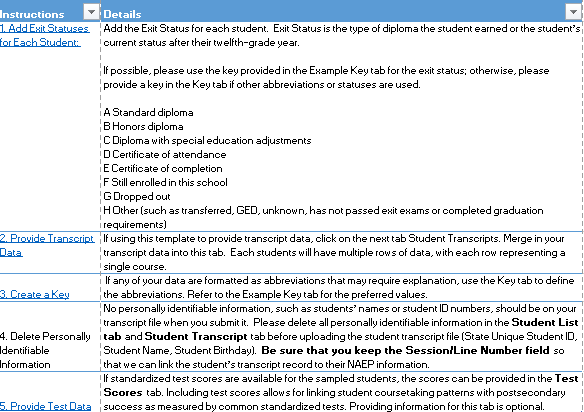
Student List:
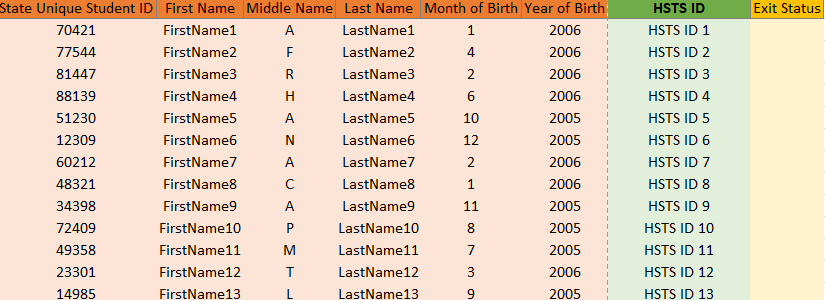
Student Transcripts:

Example Key:
Course Term |
Y |
Year |
|
S1 |
First semester |
|
S2 |
Second semester |
|
Q1 |
First quarter |
|
Q2 |
Second quarter |
|
Q3 |
Third quarter |
|
Q4 |
Fourth quarter |
|
SUM |
Summer school session |
Course level |
REG |
Regular |
|
ADV |
Advanced |
|
HON |
Honors |
|
BSC |
Basic |
Course location |
HS |
At the high school |
|
OHS |
At another district high school |
|
VE |
At the district voc-ed center |
|
CC |
At local community college |
|
ONL |
Online course |
|
HYB |
Hybrid |
|
TON |
Temporarily online |
Course language |
ENG |
In English |
|
SPN |
In Spanish |
|
OTH |
In another world language |
|
MLT |
In multiple languages (English/Spanish, etc.) |
|
|
|
Key:

Test Scores:
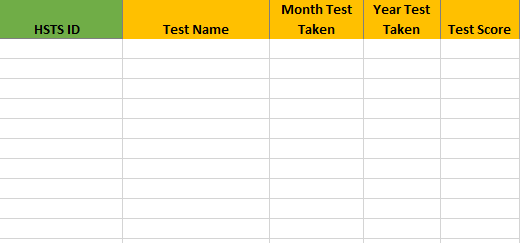
Appendix D-31: 2024 NAEP High School Transcript Study (HSTS) NAEP State Coordinator to HSTS Coordinator Letter (Approved v.30)
Fall NAEP 2024 Assessment Details Letter
NAEP STATE COORDINATOR TO HSTS COORDINATOR
Red text should be customized before mail merge, highlighted text represents mail merge fields.
If State/TUDA is completing all HSTS activities, this letter is not needed.
Dear HSTS Coordinator:
Your school has been selected for the 2024 High School Transcript Study (HSTS), which is conducted in conjunction with the 2024 National Assessment of Educational Progress (NAEP). HSTS provides information about the courses high school graduates took during their high school years, how many credits they earned, the grades they received, and examines the relationship of these coursetaking patterns to the achievement of those graduates who participated in the twelfth-grade 2024 NAEP. I look forward to working with you to coordinate HSTS in your school.
This paragraph should only be included for states/TUDAs that are designated to submit transcripts on behalf of schools. I will provide the student transcripts electronically and in a secure manner to NAEP representatives during the summer of 2024. Students’ names and all other identifying information will be removed or masked before transcript information is used in analysis. Although your school does not have to prepare and provide the transcripts, there are important activities that require your input.
As the HSTS coordinator, you will have a number of responsibilities critical to making this study a success. HSTS tasks will be available on the Assessment Management System (AMS). The timeline below indicates when you will need to complete specific activities.
October 2023: Log in and set up your NAEP AMS account using the link provided in the registration email from [email protected]. See the enclosed instructions.
The following red text should only be included if schools are designated to submit their own course catalogs. October 2023: Collect course catalogs for the current school year (2023–2024) and the three previous years (2022–2023, 2021–2022, and 2020–2021). Log into the AMS to upload the catalogs, provide a link to an online version, or request a prepaid envelope to send hardcopies.
This bullet point should only be included if schools are designated to submit their own Transcript Information Survey. October 2023: Complete the Transcript Information Survey, which asks about credits awarded for courses, grading policies, graduation requirements, transcript content information, and transcript submission.
The following red text should only be included if schools are designated to submit their own transcripts. May–October 2024: Collect transcripts of graduates who were sampled for the NAEP mathematics assessment. Upload the transcript data to the AMS or arrange for a study representative to pick up copies. A copy of the relevant FERPA regulations will be provided to you before the collection of any transcripts. You will place the Family Educational Rights and Privacy Act (FERPA) Disclosure Record Annotation with the files of students selected to take the NAEP 2024 mathematics assessment. Students’ names and all other identifying information will be removed, masked, or protected before releasing transcript copies from the school.
More information about the study is available in the enclosed NAEP in Your School: High School Transcript Study and at http://nces.ed.gov/nationsreportcard/hsts. Thank you in advance for your cooperation and effort in helping to coordinate this important study. If you have any questions, please feel free to contact me at telephone number or email address.
Sincerely,
NAEP State Coordinator
Enclosures: HSTS folder, including the following:
NAEP in Your School: High School Transcript Study
Registration Instructions
All of the information provided by participants may be used only for statistical purposes and may not be disclosed, or used, in identifiable form for any other purpose except as required by law (20 U.S.C. §9573 and 6 U.S.C. §151). By law, every NCES employee as well as every NCES agent, such as contractors and NAEP coordinators, has taken an oath and is subject to a jail term of up to 5 years, a fine of $250,000, or both if he or she willfully discloses ANY identifiable information about participants. Electronic submission of participant’s information will be monitored for viruses, malware, and other threats by Federal employees and contractors in accordance with the Cybersecurity Enhancement Act of 2015. The collected information will be combined across respondents to produce statistical reports.
Appendix D-32: 2024 NAEP High School Transcript Study (HSTS) HSTS FERPA Notice (Approved v.30)
Authorization - FERPA Disclosure Record Annotation
2024 High School Transcript Study
“A copy of this student’s transcript [will be/has been] provided to WESTAT, agent for the U.S. Department of Education, National Center for Education Statistics (NCES). The granting of Education Department authority for collection of the transcript data has been made pursuant to the provisions of the Family Education Rights and Privacy Act (FERPA) (20 U.S.C. 1232g) as implemented by 34 CFR 99.31 (a)(3)(ii) and 99.35. This disclosure statement fulfills the requirements of provision 34 CFR 99.32 of FERPA.
The High School Transcript Study (HSTS), authorized by NCES, is being conducted to collect information on current course offerings and coursetaking patterns in the nation’s secondary schools. This student has been selected for HSTS, and data from the transcript will be combined with other sampled students’ data into statistical summaries and tables. No personally identifiable information will be released in any form.”
Appendix D-33: <DELETED>
(Was:
2024 NAEP High School Transcript Study (HSTS) Transcript Information
Survey (Approved v.30) – now moved to Appendix I19 – see
Appendix I, p. 119)
Appendix D-34: 2024 NAEP High School Transcript Study (HSTS) Video Tutorials for HSTS Transcript Submission (Approved v.30)
Video Tutorials for HSTS Transcript Submission
Description of Document for OMB: The following document contains the script and a description of the visuals for 4 tutorial videos for HSTS transcript submission. These videos will be available on the HSTS pages of the AMS for schools and districts.
Video 1: Electronic Data Submission: What format should I submit?
Video 2: Database Submissions
Video 3: PDF/Word Submissions
Video 4: Tips for Uploading Transcripts
Video 1: Electronic Data Submission: What format should I submit?
Subject |
Script |
Video |
Intro |
This short video will help you determine which type of electronic transcript to submit for the NAEP High School Transcript Study.
|
Show title slide “Electronic Data Submission: What format should I submit?” |
Two types of transcripts |
There are two types of electronic transcripts you can submit and each type is prepared differently. So before getting started, you’ll need to verify what type of transcripts you have. |
Show slide with image of database and PDF File. |
Database |
The first type, a database file, is usually an Excel file, but can include any other file format with a similar structure. If you can easily merge or copy your transcript data into Excel, then you should submit a database file. |
Show image of an Excel file, animation of pasting data into an Excel file. |
PDF/Word |
The second type of transcript format is a PDF or Word file. We accept PDF or Word files when the transcript data is not available in database format. |
Show image of a PDF transcript example. |
Preparation Guides |
Separate instructional documents and videos for preparing and submitting both types of electronic transcripts are available on the AMS website on the Submit Transcripts page. |
Show where Guidelines documents are located on the Transcript page. |
End/Help Desk |
Thank you for your time and participation in this important study. If you have any questions, please contact the NAEP help desk. |
Show slide with NAEP contact information. “For additional help contact the NAEP help desk by phone (1-800-283-6237) or by email ([email protected]).” |
Video 2: Database Submissions
Subject |
Script |
Video |
Intro |
This is a quick tutorial on how to prepare an electronic database transcript file for the NAEP High School Transcript Study.
|
Show title slide “Preparing a Database Transcript File.” |
Download your student list |
To prepare a database file, you’ll start by downloading your student list template. This template can be used to submit all transcript data. |
Show screen share of downloading the template located on the “Submit Transcript” Page of the AMS. |
Template |
Let’s take a quick look at the
different tabs in this template. The
first tab has instructions about how to use the template. |
Show the Instructions tab of the template. |
Template – Student List |
Next, the Student List tab has the names of students selected for the NAEP mathematics assessment.
Each student’s NAEP-provided
HSTS ID is also included on this tab. This ID is used for linking
the transcripts with the student’s NAEP achievement data. In the “Exit Status” column, you should record the exit status of each student.
The Exit Status is the type of diploma the student earned, like a standard diploma or honors diploma, or the student’s current status after their twelfth-grade year, such as still enrolled in the school or transferred.
|
Show the Student List tab with exit statuses added.
|
Template – Student Transcript |
Next is the Student Transcript tab.
Be sure to include the HSTS ID from the student list tab with each student’s record. And make sure there’s data in all required fields.
If you don’t want to merge and paste your data into the provided Excel template, you can use another acceptable database file format as long as it includes all the required variables.
|
Show the Student Transcripts tab with animation of merging data.
Highlight HSTS ID column when mentioned.
Highlight columns of required variables.
|
Template – Key |
Next, the Key tab is where you provide definitions for data formatted as abbreviations. Refer to the Example Key tab for the preferred values, including suggested Exit Status values.
|
Show Key Tab and Example Key Tab.
|
Template – Test Scores |
The last tab is for test scores. In this tab, you can provide test score information for ACT, SAT, or PSAT tests. Providing test scores is optional. You should list the tests using the student’s HSTS ID from the student list tab. |
Show the Test Score Tab. |
Delete Sensitive Data
|
No personally identifiable information, such as students’ names, birth dates, or state unique student ID numbers, should be on your transcript file when you submit it. Please delete all personally identifiable information before uploading the student transcript file. Be sure your file has the HSTS ID field so students’ transcript records can be linked to their NAEP information. |
Screenshare of removing PII from Student List and Student Transcript Tab.
Highlight HSTS ID column when mentioned. |
Guidelines |
For more details on transcript file requirements, including required and optional data fields, download the “HSTS Guidelines for Electronic Transcripts” on the Submit Transcripts page of the AMS website. |
Show an image of a page or two, and then the download link on the AMS. |
Help Desk |
Thank you for your time and participation in this important study. If you have any questions, please contact the NAEP help desk. |
Show slide with NAEP contact information. “For additional help contact the NAEP help desk by phone (1-800-283-6237) or by email ([email protected]).” |
Video 3: PDF/Word Submissions
Subject |
Script |
Video |
Intro |
This is a quick tutorial on how to prepare electronic transcript data in PDF or Word files for the NAEP High School Transcript Study. |
Show title slide, “Preparing PDF and Word Transcript Files.” |
PDF/Word Files – Student List |
To get the list of selected students, download the student list template and refer to the student list tab. |
Show process of downloading student list template. |
Template |
The student list template has
multiple tabs. The first tab has instructions about how to use the template. |
Show Instructions tab of the template.
|
PDF/Word Files – Student List Tab and Exit status |
The student list tab has the names of students selected for the NAEP Mathematics assessment.
Each student’s NAEP-provided
HSTS ID is also included on this tab. This ID is used for linking
transcripts with the student’s NAEP achievement data. In the Exit Status column, you should record the exit status of each student if it’s not on the individual transcripts.
The Exit Status is the type of diploma the student earned, like a standard diploma or honors diploma, or the student’s current status after their twelfth-grade year, such as still enrolled in the school or transferred.
|
Show Student List tab with exit statuses added.
|
Template – Key |
The Key tab is where you provide
definitions for transcript data formatted as abbreviations. |
Show Key Tab and Example Key Tab.
|
PDF/Word Files – HSTS ID |
You will need to add each student’s NAEP-provided HSTS ID from the student list tab to each page of the transcripts. |
Show slide with images of the student list tab with an arrow to transcripts with HSTS IDs added. |
PDF/Word Files – PII |
Next, you’ll need to remove personally identifiable information from PDF or Word files. Personally identifiable information includes names, student school ID’s, birthdates, social security numbers, health records, pictures, and other such information. If you can’t remove the personally identifiable information electronically, you can print hardcopies and mask it with a thick, dark marker, and then scan the hardcopies of the transcripts to an electronic file for upload. Make sure the personally identifiable information is not visible through the masking after scanning. Again, you’ll need to add the HSTS ID before removing the personally identifiable information!
|
Show slide with image of PDF Transcript with animation of masking. |
Guidelines |
For more details on transcript file requirements, including required and optional data fields, download the “HSTS Guidelines for PDF Transcripts” on the Submit Transcripts page of the AMS website. |
Show an image of a page or two, and then the download link on the AMS. |
Help Desk |
Thank you for your time and participation in this important study. If you have any questions, please contact the NAEP help desk. |
Show slide with NAEP contact information. “For additional help contact the NAEP help desk by phone (1-800-283-6237) or by email ([email protected]).” |
Video 4: Tips for Uploading Transcripts
Subject |
Script |
Video |
Intro |
This short tutorial provides useful information for submitting your electronic transcripts. |
Show title slide “Tips for Uploading Your Electronic Transcript File(s).” |
Uploading Transcripts on the AMS – Transcript Submission Page |
To upload transcripts to the AMS, navigate to the Transcript submission page.
|
Show AMS Transcript submission page. |
Uploading Transcripts on the AMS – Step 3 Upload |
Select the upload button in step 3. A window will open where you can drag and drop or browse for the file or files you’d like to upload.
You
will see the names of the files appear once they are selected. |
Show the transcript submission page, the pop-up submission window, and the drag/drop/browse feature to upload files. |
Uploading Transcripts on the AMS – Questions |
If there are any students’
transcripts that are not included in the upload, please make a
note in the first comment box. The note should include the HSTS
ID and the reason the transcript wasn’t included. There is also a space below the uploaded files to include any other information we should know about the files you are uploading. |
Show the transcript submission pop-up window.
In the first text box, type in “HSTS ID #3 is still enrolled, HSTS ID #6 transferred.”
In the second text box, type in “Any special diploma types are noted after the graduation date on the top-right of the student’s transcript. If no type is listed, the student graduated with a standard diploma.”
|
Uploading Transcripts on the AMS – Submit/Confirmation |
After you select “Upload” you can check the Submission history to ensure the files have been uploaded successfully. |
Show the upload confirmation window and Submission History. |
End/Help Desk |
The files will be reviewed by a NAEP representative. We will follow up with you if we have any questions. |
Show slide with NAEP contact information. “For additional help contact the NAEP help desk by phone (1-800-283-6237) or by email ([email protected]).” |
Appendix D-35: 2024 NAEP Facts for Teachers, Public and Private Schools (Approved v.30)
NAEP 2024 Facts for Teachers
What is NAEP?
The National Assessment of Educational Progress (NAEP) is an integral measure of academic progress over time. It is the largest nationally representative and continuing assessment of what our nation’s students know and can do in various subjects such as civics, mathematics, reading, science, technology and engineering literacy, U.S. history, and writing. The program also provides valuable insights into students’ educational experiences and opportunities to learn in and outside of the classroom. Elected officials, policymakers, and educators all use NAEP results to develop ways to improve education.
NAEP is a congressionally mandated program administered by the National Center for Education Statistics (NCES), within the U.S. Department of Education and the Institute of Education Sciences.
What NAEP assessments will be administered in 2024?
The 2024 program will include:
Assessments in mathematics and reading at grades 4, 8, and 12 and science at grade 8
Pilot testing in mathematics and reading at grades 4 and 8, to help improve future NAEP assessments and ensure that they continue to be a reliable measure of student achievement
Survey questionnaires for participating students, teachers, and principals, to provide a better understanding of factors that may be related to students’ learning*
The assessments will be administered between January 29 and March 8, 2024.
Results will be released at the national, state, and select urban district levels for the mathematics and reading assessments at grades 4 and 8. National results will be released for the science assessment at grade 8 and mathematics and reading assessments at grade 12.
Additionally, some schools and students may be selected to participate in special studies.
American Indian and Alaska Native students participating in the NAEP mathematics and reading assessments at grades 4 and 8 will also be included in the National Indian Education Study (NIES). NIES describes the condition of education for American Indian and Alaska Native (AI/AN) students in the United States.
High schools selected for grade 12 assessments will also participate in the High School Transcript Study, which involves the collection of student transcripts and course catalogs in order to examine coursetaking patterns of students and relate those patterns to educational achievement and NAEP assessment data.
Footnote text:
* There will be no
teacher questionnaires at grade 12.
“As a teacher, my constant focus is to help students make progress in the classroom. NAEP helps with this mission by creating a common measure of student achievement across the country.”
— Iris Garcia, Teacher, Biscayne Elementary Community School, Miami Beach, Florida
What can teachers and students expect?
Participating students will complete:
Subject-area questions in mathematics, reading, or science
Survey questionnaires that provide valuable information about their educational experiences and opportunities to learn both in and outside of the classroom
It takes participating students approximately 2 hours to complete the assessments. This includes transition time, directions, and completion of survey questionnaires. A broad range of accommodations are provided for students with disabilities and English learners.
Some students will be assessed on NAEP-provided Surface Pros and some students will be assessed on NAEP-provided Chromebooks, in order to inform the program’s transition to using devices that are most familiar to students.
Teachers do not need to prepare their students to take the assessment, but they should encourage students to do their best.
Who will administer NAEP? What do schools need to provide on the day of the assessment?
NAEP representatives will administer the NAEP assessment and provide significant support to schools on assessment day. They will bring all necessary materials and equipment, including the Surface Pros and Chromebooks to assess the students.
Schools will only need to provide space for students to take the assessment, desks or tables, and an adequate number of electrical outlets in the assessment location.
NAEP will also ask to utilize school-based Internet—when possible—as the program continues to examine a shift toward online assessments. NAEP representatives will contact your district in the coming months to learn more about your schools’ internet capabilities.
How are schools and students selected for NAEP?
Schools are selected as part of a carefully designed sampling process that ensures NAEP-selected schools and students are representative of all schools and students across the United States.
How is NAEP different from our state assessment?
NAEP serves a different role than state assessments. While states have their own unique assessments with different content standards, the same NAEP assessment is administered in every state, providing a common measure of student achievement.
NAEP and Teachers
How are teachers essential partners in NAEP?
Schools and students selected to participate in NAEP represent schools and students across the country. Teachers make an important contribution by encouraging their students to participate and to give their best effort; this helps ensure that NAEP results provide the most accurate measure possible of student achievement across the country. To learn more about NAEP and view FAQs for teachers, visit https://nces.ed.gov/nationsreportcard/educators/.
Why are students, teachers, and principals asked to complete survey questionnaires?
In addition to subject-area questions, students participating in NAEP are asked to complete a survey questionnaire. Results from the questionnaire help put student achievement results into context, allow for meaningful comparison between student groups, and offer important insights for educators, policymakers, and researchers to better understand students’ educational experiences in the United States.
Teachers of students participating in NAEP are also asked to complete a survey questionnaire. The NAEP teacher survey questionnaire gathers information on teacher training and instructional practices. The questionnaire will be delivered via an online format, but teachers can request a paper-and-pencil version. There is no teacher questionnaire for the grade 12 assessments.
Principals or school administrators of students participating in NAEP are asked to complete a survey questionnaire that provides information about school policies and characteristics. The questionnaire will also be delivered via an online format, but a paper-and-pencil version is available upon request.
To learn more about NAEP survey questionnaires and view student, teacher, and school questionnaires from previous years, visit https://nces.ed.gov/nationsreportcard/survey_questionnaires.aspx.
How can teachers use NAEP resources and data to help students?
You can use the NAEP Questions Tool (https://nces.ed. gov/nationsreportcard/nqt) to view released NAEP items and create customized assessments for your classroom. You can compare your students’ performance with their peers in your state and across the nation. Teachers, students, and parents can access information and compare results for various demographic groups. Most released items include a scoring guide, sample student responses, and performance data.
The NAEP Data Explorer (https://www.nationsreportcard.gov/ndecore) is a powerful tool that allows you to examine the relationships between student performance and factors like instructional practices, school resources, and more.
How do the NAEP online dashboards help teachers explore NAEP results and more?
The Achievement Gaps Dashboard lets users explore achievement gaps that reveal significant differences in assessment scores between two groups of students (e.g., male and female students or White and Black students). You can also examine the latest national results in all the NAEP subjects and students’ educational experiences by school type with the new Public, Private, and Charter Schools Dashboard.
View the Achievement Gaps Dashboard at https://www.nationsreportcard.gov/dashboards/achievement_gaps.aspx.
The Public, Private, and Charter Schools Dashboard is available at https://www.nationsreportcard.gov/dashboards/schools_dashboard.aspx.
The School Pulse Panel (https://ies.ed.gov/schoolsurvey/spp/) is a study collecting information on the impact of the COVID-19 pandemic (i.e., learning mode, school staffing, or supply chain) from a national sample of elementary, middle, high, and combined public schools.
How long has NAEP been around?
NAEP was first administered in 1969 to measure student achievement nationally. In 1990, NAEP was administered at the state level for the first time. The NAEP Trial Urban District Assessment (TUDA) program, which measures student achievement in some of the nation’s large urban districts, began in 2002. The program has come to be recognized as the gold standard of large-scale assessments due to its high technical quality and rigorous design and methodology.
NAEP Results
The results of NAEP are released as The Nation’s Report Card. Depending on the assessment, NAEP results are available for the nation, states, and select urban districts that participate in TUDA. Results are also available for different student groups based on factors such as race/ethnicity, gender, school location, and more. NAEP is not designed to collect or report results for individual students, classrooms, or schools. Within a school, just some of the student population participates, and student responses are combined with those from other participating students to produce the results.
You can access data from previous assessments at https://nces.ed.gov/nationsreportcard/naepdata and explore the most recent results at https://www.nationsreportcard.gov/.
As part of main NAEP, students in grades 4 and 8 are scheduled to be assessed at the national and state levels in mathematics and reading every 2 years. Under the Elementary and Secondary Education Act, districts and states that receive Title I funds are required to participate in these biennial assessments. Other subjects are assessed periodically. NAEP long-term trend assessments allow the performance of today’s students to be compared with students since the early 1970s and are administered periodically to 9-, 13-, and 17-year-olds.
Recent NAEP Results
Results from the NAEP assessments are released as they become available, following comprehensive scoring and analysis. Results from the 2022 Main NAEP results were released in October 2022. Below are highlights from this assessment, which is available at https://nces.ed.gov/nationsreportcard/.
2022 NAEP Reading and Math Assessment at Grades 4 and 8
In 2022, the average reading score at both fourth and eighth grade decreased by 3 points compared to 2019. In 2022, the average fourth-grade mathematics score decreased by 5 points and was lower than all previous assessment years going back to 2005; the average score was 1 point higher compared to 2003. The average eighth-grade mathematics score decreased by 8 points compared to 2019 and was lower than all previous assessment years going back to 2003.
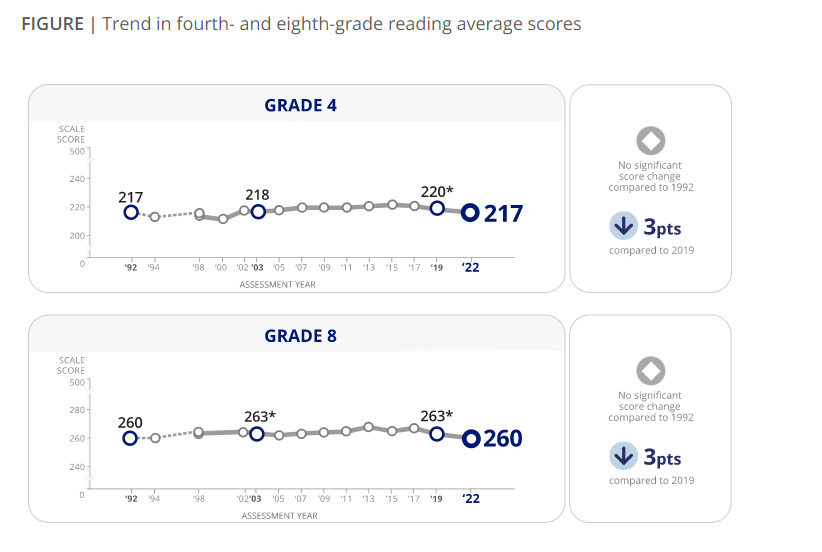
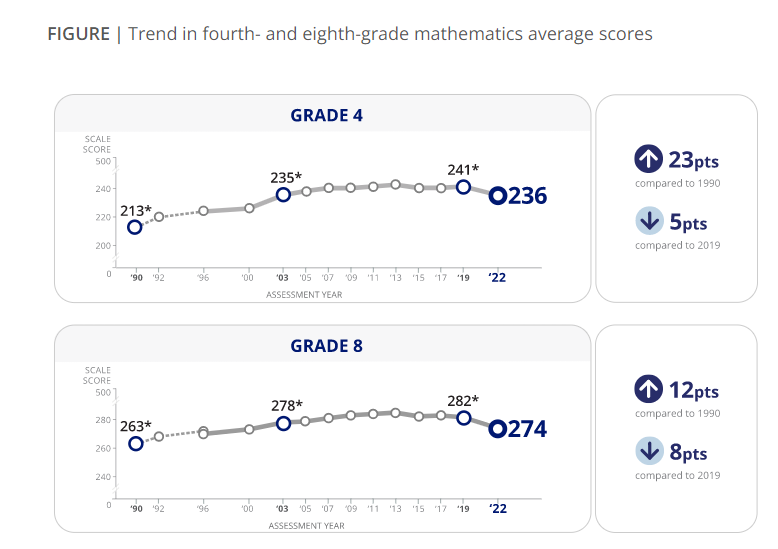
More About NAEP
To learn about upcoming NAEP assessments, download NAEP reports, and access sample questions, visit https://nces.ed.gov/nationsreportcard. Explore the latest NAEP results at https://nationsreportcard.gov.
Visit https://nces.ed.gov/nationsreportcard/about/covid19.aspx for more information about NAEP health and safety protocols.
Learn what NAEP means for schools that are selected to participate and get the latest NAEP news in Measure Up: NAEP News for the School Community, available online at https://nces.ed.gov/nationsreportcard/about/schools.aspx.
To hear teachers share their thoughts about why NAEP results are important, view the video Introducing NAEP to Teachers at https://nces.ed.gov/nationsreportcard/participating/schools.aspx.
To find your NAEP state coordinator’s contact information, visit https://nces.ed.gov/nationsreportcard/states and select your state or jurisdiction from the drop-down menu.
For additional assistance, call the NAEP help desk at 800-283-6237.
“The NAEP team that arrived at our school made the assessment process painless. Everyone on the team previously worked as an educator and interacted well with all of our students.”
—Kimberly Wilborn, Guidance Counselor, Sandburg Middle School, Fairfax County Public Schools, Alexandria, Virginia
National Center for Education Statistics (NCES) conducts the National Assessment of Educational Progress to evaluate federally supported education programs. All of the information you provide may be used only for statistical purposes and may not be disclosed, or used, in identifiable form for any other purpose except as required by law (20 U.S.C. §9573 and 6 U.S.C. §151). By law, every NCES employee as well as every NCES agent, such as contractors and NAEP coordinators, has taken an oath and is subject to a jail term of up to 5 years, a fine of $250,000, or both if he or she willfully discloses ANY identifiable information about you. Electronic submission of your information will be monitored for viruses, malware, and other threats by Federal employees and contractors in accordance with the Cybersecurity Enhancement Act of 2015.
This publication was prepared for the National Assessment of Educational Progress by Hager Sharp under contract GS-23F-0024M to the National Center for Education Statistics, U.S. Department of Education.
NAEP 2024 FACTS FOR TEACHERS IN PRIVATE SCHOOLS -TEXT ONLY REVIEW
I'm thankful for the opportunity for our school to participate in NAEP because I believe it leads to useful outcomes for individual schools, private schools specifically, and education generally in our country. I would strongly encourage all private schools to participate, if selected.
— Dr. James A. Thomas, President of Columbia Academy, Columbia, TN
The National Assessment of Educational Progress (NAEP) is the largest continuing and nationally representative assessment of what students in public and private schools know and can do in various subjects. First administered in 1969, NAEP collects and reports information on student trends and performance and compares the achievement of students in public schools with that of students in private schools. Private schools represent about 24 percent of the schools in the nation, educate approximately 9 percent of the nation’s students, and are a critical component of the NAEP program. Private school data are essential to providing a complete and accurate picture of education in the United States and to informing future policy decisions. The results of NAEP are released to the public as The Nation’s Report Card.
All About NAEP
As private school teachers, you are essential partners in NAEP. You make an important contribution by sharing your class time and encouraging your students to participate and do their best. When students take part in NAEP and give their best effort, we get the most accurate measure possible of student achievement across the country.
Teachers can use NAEP questions as a resource in the classroom. Teachers can use the NAEP Questions Tool at http://nces.ed.gov/nationsreportcard/nqt to create online self-scoring tests for students and see how the performance of students in private schools compares nationally with that of students in public school on specific items. Released items generally come with a scoring guide, sample student responses, and performance data. Students can try NAEP questions by visiting https://www.nationsreportcard.gov/sample_questions.aspx.
Teachers can watch the NAEP teacher video. The video provides an overview of the assessment as well as tips on how to support students selected to participate. Watch the video at https://www.youtube.com/watch?v=zR1_pUdSlFg.
Teachers can also view the private school video. Teachers and heads of school describe their experiences with the NAEP assessment and the value of NAEP to private schools in an online video, Private Schools and NAEP: A National Conversation. Watch the video at https://nces.ed.gov/nationsreportcard/participating/private_nonpublic.aspx.
Highlights of the NAEP 2024 Program
From January 29 to March 8, 2024, NAEP field staff will administer assessments in public and private schools across the country. The assessments will be administered at grades 4, 8, and 12 in mathematics and reading, and at grade 8 in science. Students will take only one subject.
NAEP representatives will bring all materials and equipment to the school on assessment day. The total time away from the classroom will be approximately 2 hours. This includes transition time, directions and tutorials, and completion of survey questions.
It’s important to know that…
No advance preparation is needed. No advance preparation for teachers or for students is necessary. Trained NAEP representatives, employed by a contractor to the National Center for Education Statistics, administer NAEP.
Inclusion is essential. To ensure that student achievement is accurately reported, students with disabilities (SD) and English learners (EL) are encouraged to participate in NAEP assessments. Many accommodations are allowed during the assessment, such as extended time, breaks during the test, and a separate setting. SD and EL teachers who work with the students selected for the assessment are asked to provide information to determine how these students will be assessed on NAEP.
NAEP data are used for statistical purposes only.* No one involved in administering NAEP keeps personal information on teachers or students after the assessments are completed. There are no results for individual students, classrooms, or schools.
How NAEP reports results
Since 1969, NAEP has produced many reports chronicling trends over time in student performance. Results for private schools are generally reported as overall private school results and for two groups of private schools, Catholic and other private schools.
NAEP also disseminates contextual information from data collected on student survey questionnaires. This information can be used to inform parents, the public, and education policymakers about our students’ educational experiences inside and outside the classroom. You can access data from previous assessments at https://www.nationsreportcard.gov/ndecore/xplore/nde, and explore the most recent results at http://nationsreportcard.gov. For a quick, but detailed, look at results for private schools, explore the NAEP Private School Quick Data tool at http://nces.ed.gov/nationsreportcard/about/private_school_quick_data.aspx.
Highlights of NAEP 2019 Mathematics and Reading
The NAEP 2022 mathematics and reading results include both achievement and survey questionnaire data for students in grades 4 and 8 across the country. The national results combine data from students assessed in public and private schools. Some highlights of these results are included.
In 2022, the average fourth-grade mathematics score decreased by 5 points and was lower than all previous assessment years going back to 2005; the average score was 1 point higher compared to 2003. The average eighth-grade mathematics score decreased by 8 points compared to 2019 and was lower than all previous assessment years going back to 2003. In 2022, fourth- and eighth-grade mathematics scores declined for most states/jurisdictions as well as for most participating urban districts compared to 2019. Average scores are reported on NAEP mathematics scales at grades 4 and 8 that range from 0 to 500.
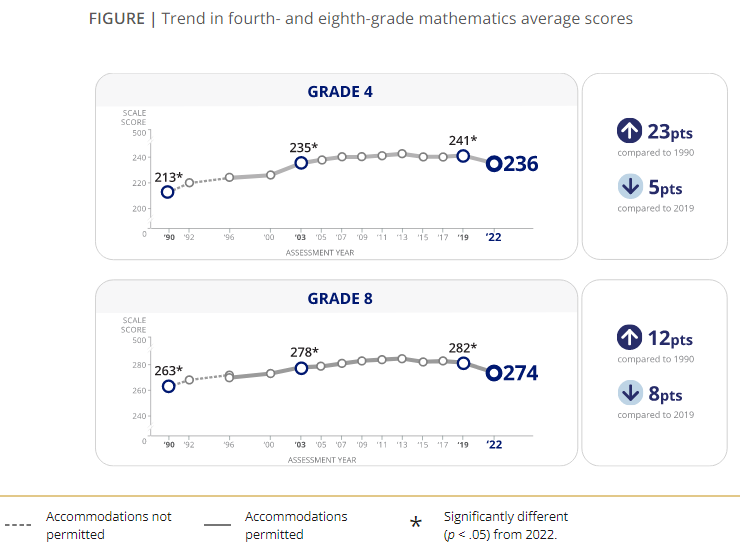
[GRAPH 1, data source: https://www.nationsreportcard.gov/highlights/mathematics/2022/ –must credit “Nation’s Report Card”]
In 2022, the average reading score at both fourth and eighth grade decreased by 3 points compared to 2019. At fourth grade, the average reading score was lower than all previous assessment years going back to 2005 and was not significantly different in comparison to 1992. At eighth grade, the average reading score was lower compared to all previous assessment years going back to 1998 and was not significantly different compared to 1992. In 2022, fourth- and eighth-grade reading scores declined for most states/jurisdictions compared to 2019. Average scores are reported on NAEP reading scales at grades 4 and 8 that range from 0 to 500.
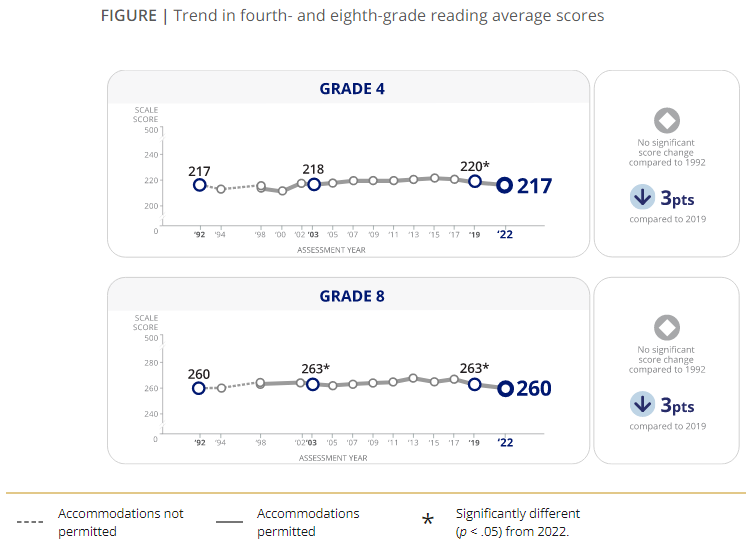
[GRAPH 1, data source: https://www.nationsreportcard.gov/highlights/reading/2022/ –must credit “Nation’s Report Card”]
All students who took the mathematics assessments in 2022 were asked if they ever attended school from home or somewhere else outside of school for any duration during the last school year (2020–21) because of the COVID-19 pandemic. Among eighth-grade students, 73 percent recalled learning remotely during the last school year, 18 percent reported they did not learn remotely, and 9 percent did not remember.
Of the eighth-grade students who reported learning remotely during the 2020–21 school year, higher performers (those at or above the 75th percentile) had more frequent access to a desktop computer, laptop, or tablet all the time; a quiet place to work available at least some of the time; and a teacher available to help them with mathematics schoolwork about once or twice a week or more compared to lower performers (those below the 25th percentile). Additionally, higher-performing eighth-grade students reported more participation in real-time video lessons with their teacher every day or almost every day compared to their lower-performing peers.
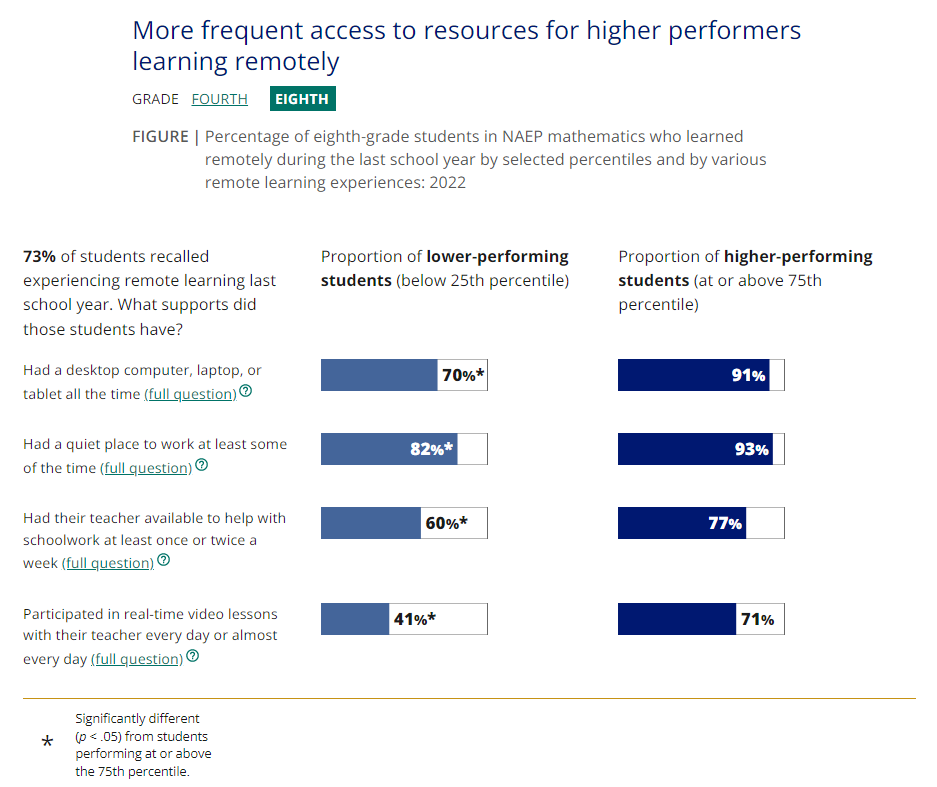
[GRAPH 3, data source: https://www.nationsreportcard.gov/highlights/mathematics/2022/#student-experiences –must credit “Nation’s Report Card”]
Results from the NAEP 2021 School Survey were reportable for Catholic, other private (non-Catholic), and public schools at grades 4 and 8. Between February and May 2021, a significantly higher percentage of Catholic and other private schools reported offering students in-person instruction compared to public schools.
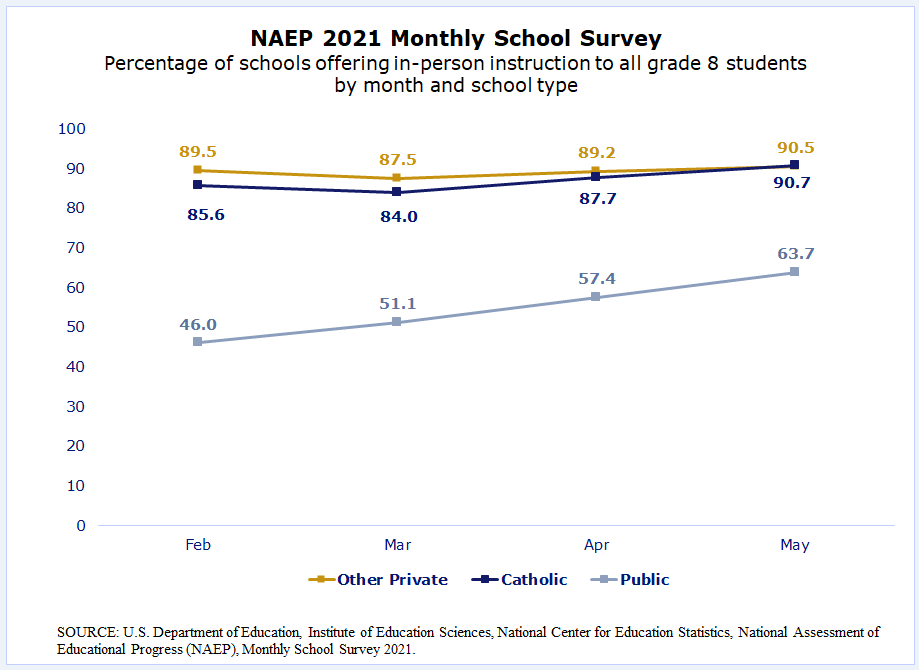
[GRAPH 4, SOURCE: U.S. Department of Education, Institute of Education Sciences, National Center for Education Statistics, National Assessment of Educational Progress (NAEP), Monthly School Survey 2021. https://nces.ed.gov/nationsreportcard/subject/participating/pdfs/measure_up_private_schools_summer_fall_2021.pdf ]
*National Center for Education Statistics (NCES) conducts the National Assessment of Educational Progress to evaluate federally supported education programs. All of the information you provide may be used only for statistical purposes and may not be disclosed, or used, in identifiable form for any other purpose except as required by law (20 U.S.C. §9573 and 6 U.S.C. §151). By law, every NCES employee as well as every NCES agent, such as contractors and NAEP coordinators, has taken an oath and is subject to a jail term of up to 5 years, a fine of $250,000, or both if he or she willfully discloses ANY identifiable information about you. Electronic submission of your information will be monitored for viruses, malware, and other threats by Federal employees and contractors in accordance with the Cybersecurity Enhancement Act of 2015.
Appendix D-36: 2024 NAEP Overview Brochure (Approved v.30)
Note: This document was moved from Appendix D1-1
Cover Page
[IES Logo] [NAEP Logo]
Title: An Overview of NAEP
Page 1
What is NAEP?
The National Assessment of Educational Progress (NAEP), often called The Nation’s Report Card, is the largest nationally representative and continuing assessment of what students in public and private schools in the United States know and are able to do in various subjects. Since 1969, NAEP has been a common measure of student achievement across the country in mathematics, reading, science, and many other subjects. Depending on the assessment, NAEP report cards provide national, state, and some district-level results, as well as results for different demographic groups.
NAEP is a congressionally mandated project of the National Center for Education Statistics (NCES), located within the U.S. Department of Education’s Institute of Education Sciences. NAEP data are also used in special studies conducted by NCES. These have included comparisons of proficiency standards across state assessments; insights from high school transcripts, including courses taken and credits earned; and in-depth looks at how different demographic groups perform across different types of schools.
The National Assessment Governing Board, an independent, bipartisan organization made up of governors, state school superintendents, teachers, researchers, and representatives of the general public, sets policy for NAEP.
How is NAEP different from state assessments?
States have their own assessments, which are designed to provide individual student data about achievement based on different content standards, unique to each state. NCES administers the same NAEP assessment in every state, providing educators, policymakers, and parents with a common measure of student achievement that allows for direct comparisons among states and participating urban districts.
[Page 1 footer]
The NAEP website provides more extensive information about the assessment: http://nces.ed.gov/nationsreportcard
NAEP results are available on The Nation’s Report Card website: http://nationsreportcard.gov
The NAEP website features many tools and applications designed to provide quick and easy access to NAEP assessment data, examples of the types of questions students answer, performance comparisons, and more: https://nces.ed.gov/nationsreportcard/data/
Page 2
What subjects does NAEP assess?
NAEP includes a range of subjects at grades 4, 8, and 12 to provide a comprehensive look at the wide array of academic areas that are a part of a student’s education. Subjects include civics, mathematics, reading, science, technology and engineering literacy, U.S. history, and writing.
NAEP also measures student performance in mathematics and reading through the long-term trend assessment, which allows the performance of today’s students to be compared with students since the early 1970s. The assessment is administered periodically to 9-, 13-, and 17-year-olds.
How are NAEP results reported?
NAEP results are reported for the nation and, in most cases, for states, as well as for selected urban districts that participate in the Trial Urban District Assessment (TUDA). Results are reported as scores and as percentages of students reaching NAEP achievement levels—NAEP Basic, NAEP Proficient, and NAEP Advanced.
NAEP monitors overall educational progress for the nation, states, TUDA districts, and for different groups of students, including students with disabilities and English learners. NAEP is not designed to provide results for individual students or schools.
How is technology being used to measure and report student skills?
An increasing number of schools are making digital technologies an integral component of the learning environment. NAEP assessments have gradually transitioned various subjects from traditional paper-and-pencil to a digital format since 2017. Additionally, to assess students in more effective and engaging ways that mirror their classroom experiences, NAEP assessments are transitioning towards an online assessment model that will be compatible with the most common devices found in schools that are more familiar to students.
By transitioning to an online assessment that can be administered on various devices, NAEP will be more accessible than ever for students and will deepen our understanding of what students know and are able to do in various subjects.
How are NAEP results used?
Policymakers, researchers, and educators use NAEP results to inform educational improvements across the nation, within states and TUDA districts, and for various student groups. Parents, media, and the general public use NAEP results to monitor educational progress in their communities and compare performance with other regions of the country. NAEP also provides states with a benchmark to target important efforts that raise the bar for student achievement and ensure that students have equal opportunities to succeed.
NAEP also provides much-needed information about the academic achievement and continued recovery of students whose elementary or secondary school experiences have been shaped by online learning and the pandemic.
Learn how NAEP data are used to inform policy and practice in different states: https://nces.ed.gov/nationsreportcard/about/policy_practice.aspx
Page 3
Why is student participation important?
NAEP assesses a sample of students across the country to be representative of all students in the United States. Students who are selected represent the nation’s geographic, racial, ethnic, and socioeconomic diversity. Each student’s participation is critical for providing an accurate and complete picture of student achievement and ensuring that policymakers, researchers, and educators have reliable data to inform educational improvements.
What is it like for students and schools to participate in NAEP?
NAEP is administered to students during regular school hours. Each student is assessed in one subject area. Students spend between 90 and 120 minutes taking the assessment, including time to complete a survey questionnaire.
NAEP representatives provide significant support to schools on assessment day.
Allowable accommodations are provided as necessary for students with disabilities and/or English learners.
Student responses on NAEP are private, and the privacy of each participating school and student is essential.
What other data are collected during a NAEP assessment?
NCES includes survey questionnaires as part of NAEP to collect information that helps put the results into context. There are three types of survey questionnaires:
Students complete questionnaires that provide information on their opportunities to learn in and outside of the classroom, educational experiences, and a variety of other topics, including socioeconomic status and technology use. Students may skip any question by leaving a response blank.
Teachers responsible for the subject of the administered assessment complete questionnaires that gather information on teacher trainings and instructional practices.
School questionnaires, usually completed by the principal or assistant principal, gather information on school policies and characteristics.
Learn more about these questionnaires here: https://nces.ed.gov/nationsreportcard/experience/survey_questionnaires.aspx
[Page 3 footer]
All of the information provided by participants may be used only for statistical purposes and may not be disclosed, or used, in identifiable form for any other purpose except as required by law (20 U.S.C. §9573 and 6 U.S.C. §151). By law, every National Center for Education Statistics (NCES) employee as well as every NCES agent, such as contractors and NAEP coordinators, has taken an oath and is subject to a jail term of up to 5 years, a fine of $250,000, or both if he or she willfully discloses ANY identifiable information about participants. Electronic submission of participant’s information will be monitored for viruses, malware, and other threats by Federal employees and contractors in accordance with the Cybersecurity Enhancement Act of 2015. The collected information will be combined across respondents to produce statistical reports.
Page 4
The following are examples of the types of NAEP questions and features students may encounter when participating in digitally based assessments.*
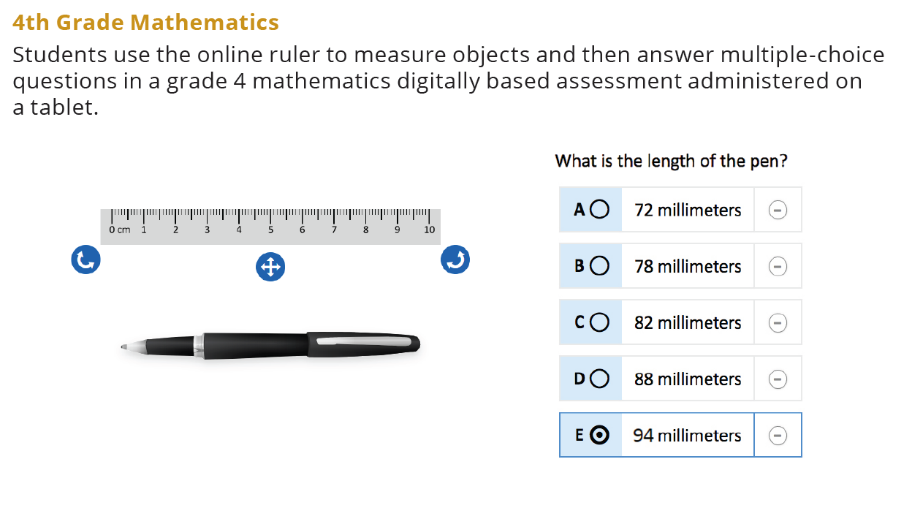
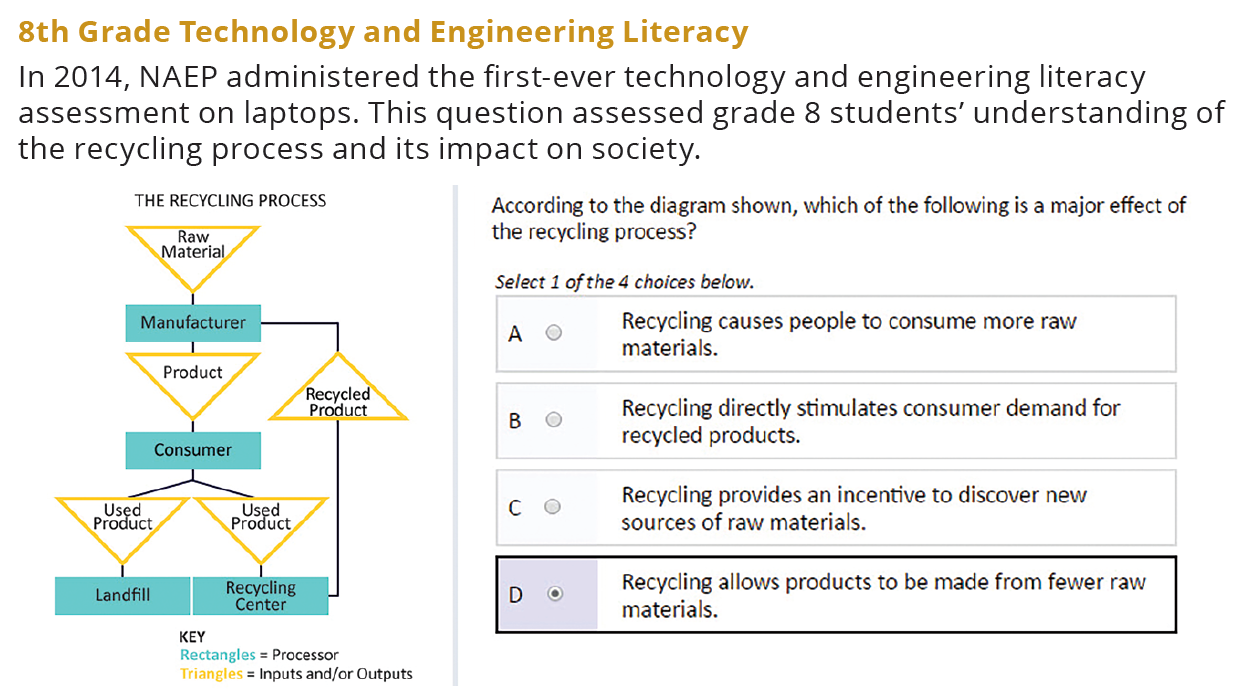
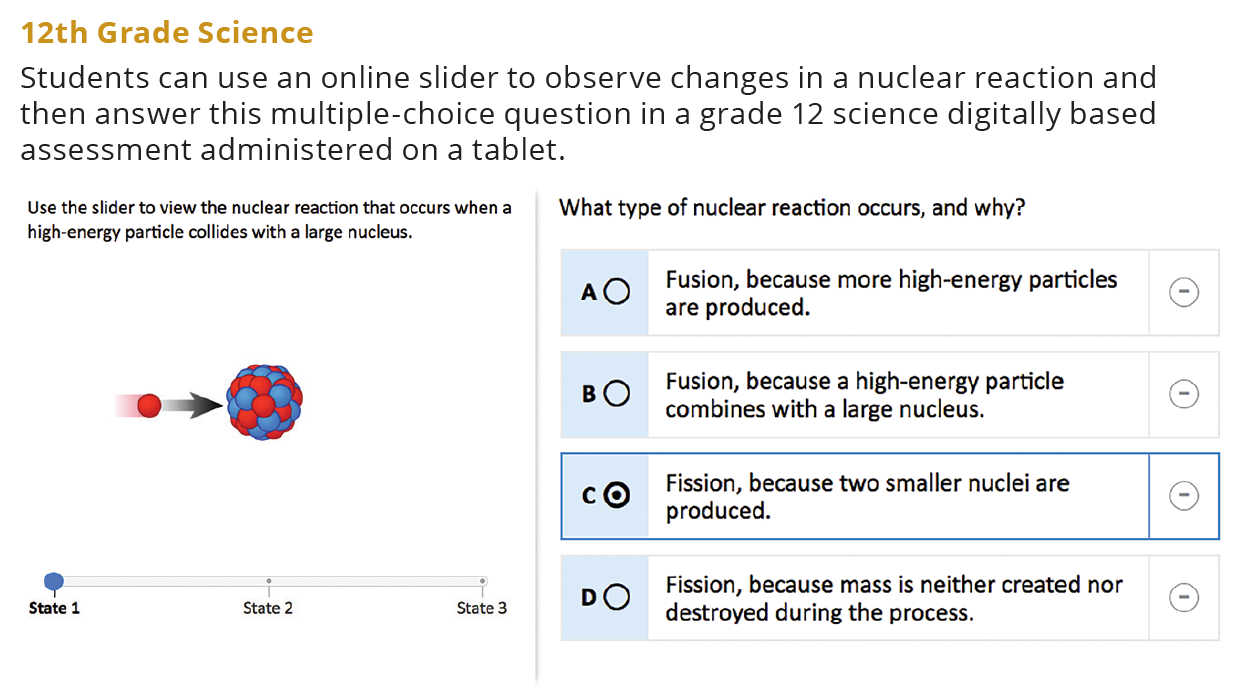
[Page 4 footer]
* The 4th grade and 12th grade questions are not released assessment questions but represent what students might be asked during a NAEP digitally based assessment. The 8th grade sample question was released from the 2014 NAEP technology and engineering literacy assessment.
Back Cover
[Department of Education Logo]
Find us on: [Facebook] [Twitter] [YouTube]
This publication was prepared for the National Center for Education Statistics by Hager Sharp under contract ED-IES-13-C-0025.
Appendix D-37: 2024 NAEP Overview Brochure for Private Schools (Approved v.20)
Note: This document was moved from Appendix D1-1a and will not be revised or updated for 2024


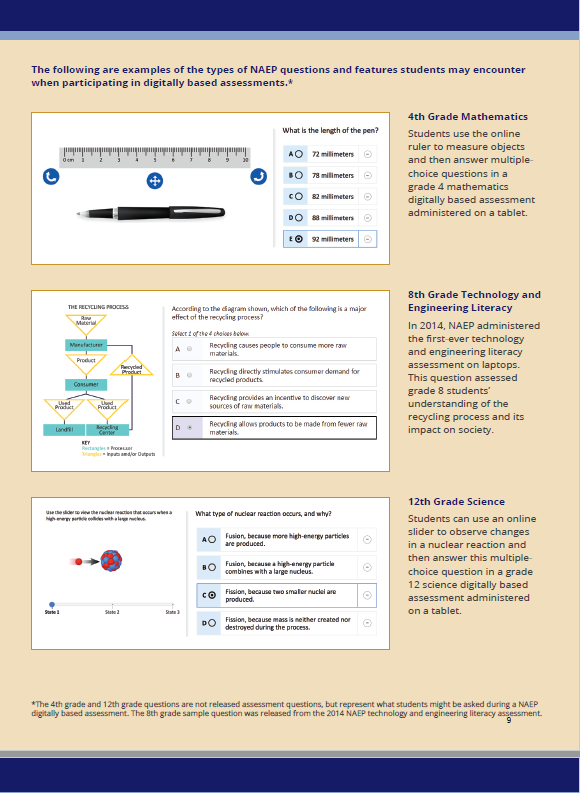
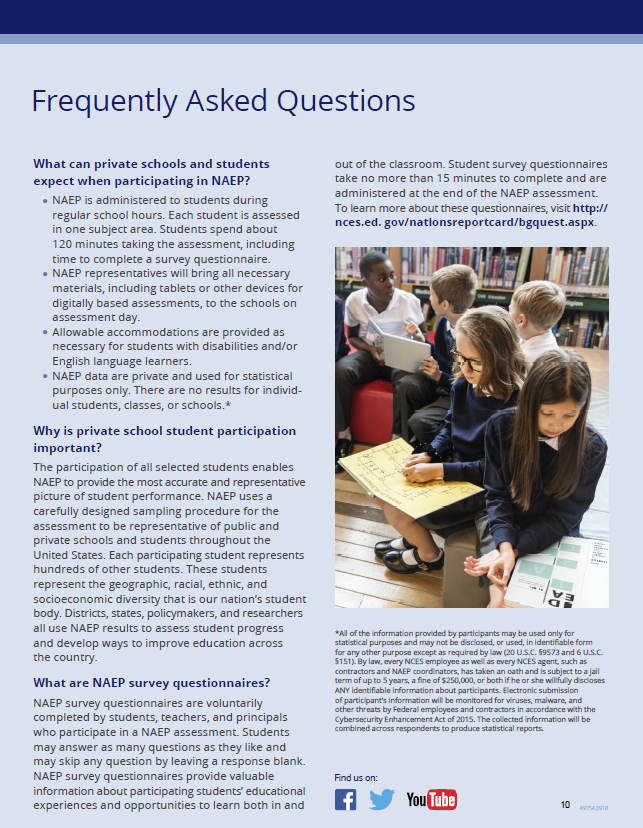
Appendix D-38: 2024 NAEP Private School Factsheet (Approved v.30)
NAEP National Assessment of Educational Progress 2024
Page 1 Banner at top of page
NAEP has received endorsement letters from CAPE, NCEA, NAIS, ACSI, and many others. Private school organizations will have the option to replace this with their own organization’s endorsement. For example, “NAEP is endorsed by the National Catholic Educational Association (NCEA).”
Page 1 Text
The National Assessment of Educational Progress (NAEP) is the largest nationally representative and continuing assessment of what our nation’s students in public and private schools know and can do. However, NAEP has been unable to provide a complete picture of private school achievement for the past few years because reporting requirements were not met due to low school participation.
Importance of Private School NAEP Participation
Private schools represent about 24 percent of schools in the nation and educate about 9 percent of students. Your school’s participation will help make it possible for private school data to be reported and contributes to the picture of education across the nation and to future policy decisions.
NAEP Administration:
NAEP is administered at no cost to schools.
NAEP representatives provide significant support to schools and will bring in all necessary materials and equipment to administer the assessment. Resources are also provided for administrators, teachers, and parents.
Assessments are administered to students in grades 4, 8, and/or 12.
The total assessment time for students is no more than 2 hours. This includes transition time, directions and tutorials, and completion of survey questions.
NAEP offers accommodations to students with disabilities and English learners.
Page 2 Text
NAEP Results
Data collected from participating schools and students are combined for reporting. NAEP is not designed to report results at the school or student level.
NAEP provides valuable information about students’ educational experiences and opportunities to learn both in and outside the classroom.
NAEP data have historically shown, across subjects and over time, that students in private schools on average score higher than students in public schools. With your support, private schools can achieve excellent participation, and private school results can be reported.
[Large Quote at bottom of page 2]
“The Council for American Private Education (CAPE) strongly encourages private schools to participate in NAEP, an essential measure of student achievement in the United States.” - Michael Schuttloffel, Executive Director, CAPE. Private school organizations will have the option to replace this with their own organization’s quote. For example, “The National Catholic Educational Association (NCEA) encourages member schools to participate in NAEP so that their results will be reported specifically and that we have some independent measure of the overall effectiveness of our schools and a benchmark against which to measure success as well as areas that need improvement.” – Sister Dale McDonald, Vice President of Public Policy
Page 2 Banner at bottom of page
NAEP — giving private schools a voice in the national education conversation.
Footer ON Page 2
It is vital that all selected students participate to accurately capture private school student progress. While the results from all participating schools and students are used in the national results, your participation can help make it possible to report NAEP results for private schools in 2024. For more information, please visit https://nces.ed.gov/nationsreportcard/participating/private_nonpublic.aspx
Appendix D-39: 2024 NAEP Sample Email from Catholic Diocese to Catholic School Administrator (Approved v.30)
NAEP 2024 Sample Email from Catholic Diocese to Catholic School Administrator
Red text should be customized
Dear Administrator,
Your school has been selected to participate in the 2024 National Assessment of Educational Progress (NAEP). I strongly urge you to participate so that we can continue to showcase the historically positive performance of our students and our schools. As recently as 2022, NAEP results consistently show that the performance of students in Catholic schools on average compares positively to students in public schools. We hope we can count on all selected Catholic schools continuing a long-standing tradition of achieving very high participation in this assessment, enabling NAEP to report results for students in Catholic schools.
To see the positive Catholic school student performance contrasted with students in public schools, visit https://www.nationsreportcard.gov/dashboards/schools_dashboard.aspx.
As in previous years, NAEP representatives provide significant support to schools and will bring in all necessary materials and equipment to administer the assessment at no cost to your school. A NAEP representative will contact you to discuss assessment details.
For information specifically for private schools, including a short 2-minute video about the value of NAEP for private schools, visit https://nces.ed.gov/nationsreportcard/participating/private_nonpublic.aspx.
For complete information about NAEP assessments, please visit the NAEP website at http://nces.ed.gov/nationsreportcard.
Thank you for your support of this important study, which allows us considerable no-cost opportunities to showcase the performance of our students and promote the value of our schools.
Sincerely,
Diocese Superintendent
National Center for Education Statistics (NCES) is authorized to conduct NAEP by the National Assessment of Educational Progress Authorization Act (20 U.S.C. §9622) and to collect students’ education records from education agencies or institutions for the purposes of evaluating federally supported education programs under the Family Educational Rights and Privacy Act (FERPA, 34 CFR §§ 99.31(a)(3)(iii) and 99.35). All of the information provided by participants may be used only for statistical purposes and may not be disclosed, or used, in identifiable form for any other purpose except as required by law (20 U.S.C. §9573 and 6 U.S.C. §151). By law, every NCES employee as well as every NCES agent, such as contractors and NAEP coordinators, has taken an oath and is subject to a jail term of up to 5 years, a fine of $250,000, or both if he or she willfully discloses ANY identifiable information about participants. Electronic submission of participant’s information will be monitored for viruses, malware, and other threats by Federal employees and contractors in accordance with the Cybersecurity Enhancement Act of 2015. The collected information will be combined across respondents to produce statistical reports.
Appendix D-40: 2024 NAEP Sample Letter from Catholic Diocese to Catholic School Administrator (Approved v.30)
NAEP 2024 Sample Letter from Catholic Diocese to Catholic School Administrator
Red text should be customized
(Date)
Dear Administrator:
I am pleased to inform you that (insert school name) has been selected to represent Catholic schools across our nation by participating in the 2024 administration of the National Assessment of Educational Progress (NAEP). Your school’s participation in NAEP 2024 is an opportunity to help make it possible for private and Catholic school data to be reported and compared with public school data.
First administered in 1969, NAEP is the largest continuing and nationally representative measure of private and public school student achievement across the country.
Catholic schools have a long-standing tradition of achieving very high participation in this assessment, enabling NAEP to report results for students in Catholic schools. NAEP results consistently show that the performance of students in Catholic schools, on average, compares positively to students in public schools. I strongly urge you to participate in the NAEP 2024 assessment so that we can continue to showcase the historically positive performance of our students and our schools. To see the positive Catholic school student performance contrasted with students in public schools, visit https://www.nationsreportcard.gov/dashboards/schools_dashboard.aspx.
Please keep the following in mind:
NAEP is administered at no cost to your school.
Parental notification is required for student participation and NAEP provides a notification template for your customization and use.
NAEP data are used for statistical purposes only. School and student names are not associated with the results. All results are reported as “The Nation’s Report Card.”
NAEP staff must pass an FBI background check and sign an oath of confidentiality. Many NAEP representatives are retired educators.
NAEP representatives will provide significant support to participating schools. They will administer the assessment and bring all materials and equipment, including NAEP-provided Surface Pros and Chromebooks, on which students will take the assessment.
You may appoint a school staff member to be your NAEP School Coordinator to work with NAEP to complete the logistical tasks for assessment planning.
Your leadership will most certainly have a strong impact on participation. By participating in NAEP, your students set a positive example for their peers by practicing good citizenship and contributing to data that serve to improve and strengthen the educational options for all our nation’s youth.
A NAEP representative will contact you to discuss assessment details. In the meantime, please visit the NAEP website at http://nces.ed.gov/nationsreportcard for complete information about the assessment, sample questions, previous results, and other NAEP publications and materials.
For information specifically for private schools, including a short video, visit https://nces.ed.gov/nationsreportcard/participating/private_nonpublic.aspx
The goal is 100 percent Catholic school participation, and I am counting on you to help us reach that goal!
Sincerely,
Diocese Superintendent
National Center for Education Statistics (NCES) is authorized to conduct NAEP by the National Assessment of Educational Progress Authorization Act (20 U.S.C. §9622) and to collect students’ education records from education agencies or institutions for the purposes of evaluating federally supported education programs under the Family Educational Rights and Privacy Act (FERPA, 34 CFR §§ 99.31(a)(3)(iii) and 99.35). All of the information provided by participants may be used only for statistical purposes and may not be disclosed, or used, in identifiable form for any other purpose except as required by law (20 U.S.C. §9573 and 6 U.S.C. §151). By law, every NCES employee as well as every NCES agent, such as contractors and NAEP coordinators, has taken an oath and is subject to a jail term of up to 5 years, a fine of $250,000, or both if he or she willfully discloses ANY identifiable information about participants. Electronic submission of participant’s information will be monitored for viruses, malware, and other threats by Federal employees and contractors in accordance with the Cybersecurity Enhancement Act of 2015. The collected information will be combined across respondents to produce statistical reports.
 NAEP
– Giving Private Schools a Voice, since 1989
NAEP
– Giving Private Schools a Voice, since 1989
Appendix D-41: 2024 NAEP State Coordinator to District Assessment Coordinator -Technology Notification (New)
2024 NAEP Technology Notification Letters (New)
District Assessment Coordinator Notification NAEP 2024 English/Puerto Rico-replace
District Technology Director Notification NAEP 2024 English/Puerto Rico
On-site Technology Coordinator Notification NAEP 2024 English/Puerto Rico
Fall NAEP 2024 Identify Technology Coordinator
NAEP STATE COORDINATOR TO DISTRICT ASSESSMENT COORDINATOR
Red text should be customized before mail merge, highlighted text represents mail merge fields.
::Do not distribute until notified that the AMS is ready for school and district user access::
Dear District Assessment Coordinator:
At the end of the school year, I notified [selected school] / the schools below / the attached list of schools of their selection to participate in the National Assessment of Educational Progress (NAEP). I am following up with you to provide additional information about the upcoming assessment.
List of Selected Schools:
School 1
School 2
Etc.
To
prepare for the assessment, please review the enclosed Technology
Coordinator Responsibilities Guide
and designate a
district or school technology coordinators.
Each
school should be assigned a technology coordinator, whether at the
school or district level, and you may designate more than one if
needed. The
coordinator’s expertise will be important for completing a
survey on technology and internet capabilities in the selected
schools. Please give
the enclosed guide to your designated technology
coordinator/coordinators.
The technology coordinator should
be comfortable answering an internet connectivity survey; and
know the internet capabilities in the schools, such as
Wi-Fi bandwidth;
how to connect devices to Wi-Fi with appropriate credentials; and
how to safelist URLs.
If you select a district technology coordinator to answer on behalf of multiple schools, a bulk editing feature is available when completing the checklist. To designate a technology coordinator, you will need to do the following:
Work with school or district technology staff as necessary to add the domain westatstudies.com to the safe senders list.
{Use this bullet if following Option 1, district assessment coordinator registers and invites Technology Coordinator} Log in and set up your NAEP AMS account using the link provided in the registration email from [email protected].
{Use this bullet if following Option 1, district assessment coordinator registers and invites Technology Coordinator} Enter each technology coordinator’s name and contact information in the AMS, select their role as Technology Coordinator, and select Send Invite.
{Use this bullet if following Option 2, NSC invites the Technology Coordinator} Send the designated technology coordinator’s name and email address to me using the email address provided below.
Once you have identified a technology coordinator and passed along the Technology Coordinator Responsibilities Guide, they will have until [DATE] to complete the survey.
Thank you for your assistance with this very important assessment of our nation’s students. Our chief state school officer, name, supports NAEP and encourages your students’ participation. If you have questions, please contact me at telephone number or email address.
Sincerely,
NAEP State Coordinator
Enclosures:
Technology Coordinator Responsibilities Guide
National Center for Education Statistics (NCES) conducts the National Assessment of Educational Progress to evaluate federally supported education programs. All of the information you provide may be used only for statistical purposes and may not be disclosed, or used, in identifiable form for any other purpose except as required by law (20 U.S.C. §9573 and 6 U.S.C. §151). By law, every NCES employee as well as every NCES agent, such as contractors and NAEP coordinators, has taken an oath and is subject to a jail term of up to 5 years, a fine of $250,000, or both if he or she willfully discloses ANY identifiable information about you. Electronic submission of your information will be monitored for viruses, malware, and other threats by Federal employees and contractors in accordance with the Cybersecurity Enhancement Act of 2015.
Appendix D-42: 2024 NAEP Technology Notification Letters (New)
Early Fall NAEP 2024 Technology Coordinator Notification
NAEP STATE COORDINATOR TO TECHNOLOGY COORDINATOR
Red text should be customized before mail merge, highlighted text represents mail merge fields.
::Do not distribute until notified that the AMS is ready for school and district user access::
Dear District/School Technology Coordinator:
Welcome
to the 2024 National Assessment of Educational Progress (NAEP). You
have been selected by your district to serve as the technology
coordinator for all NAEP assessment activities at [School
Name]./the
following schools / the attached list of schools:
School 1
School 2
Etc
Thank you in advance for helping to prepare for this important assessment!
NAEP is the largest nationally representative and continuing assessment of what students in the United States know and can do in various subjects. It is administered by the National Center for Education Statistics (NCES), within the U.S. Department of Education. The NAEP 2024 program will assess students in mathematics, reading, or science on an online platform using devices such as Chromebooks.
The goal of the NAEP team is to connect the NAEP-provided devices to the school’s Wi-Fi for the assessment. To prepare for the assessment’s technology requirements testing, each technology coordinator must
Work with school or district technology staff as necessary to add the domain westatstudies.com to the safe senders list;
Register for the NAEP Assessment Management System using the link provided in the registration email from [email protected]; and
Complete the Internet Connectivity Survey, which requires knowledge of:
school’s Wi-Fi bandwidth;
how to connect devices to Wi-Fi with appropriate credentials; and
how to safelist URLs.
After you complete the survey, the school coordinator will verify everything by conducting bandwidth and safelist tests. I have provided more information about your responsibilities in the enclosed Technology Coordinator Responsibilities Guide.
Again, thank you for your assistance with this very important assessment of our nation’s students. If you have questions, please contact me at telephone number or email address.
Sincerely,
NAEP State Coordinator
Enclosures:
Technology Coordinator Responsibilities Guide
National Center for Education Statistics (NCES) conducts the National Assessment of Educational Progress to evaluate federally supported education programs. All of the information you provide may be used only for statistical purposes and may not be disclosed, or used, in identifiable form for any other purpose except as required by law (20 U.S.C. §9573 and 6 U.S.C. §151). By law, every NCES employee as well as every NCES agent, such as contractors and NAEP coordinators, has taken an oath and is subject to a jail term of up to 5 years, a fine of $250,000, or both if he or she willfully discloses ANY identifiable information about you. Electronic submission of your information will be monitored for viruses, malware, and other threats by Federal employees and contractors in accordance with the Cybersecurity Enhancement Act of 2015.
Fall NAEP 2024 Identify District Technology Director and On-Site Technology Coordinator
NAEP STATE COORDINATOR TO DISTRICT ASSESSMENT COORDINATOR
Red text should be customized before mail merge, highlighted text represents mail merge fields.
::Do not distribute until notified that the AMS is ready for school and district user access::
Dear District Assessment Coordinator:
At the end of the school year, I notified [selected school] / the schools below / the attached list of schools of their selection to participate in the National Assessment of Educational Progress (NAEP). I am following up with you to provide additional information about the upcoming assessment.
List of Selected Schools:
School 1
School 2
Etc.
To prepare for the assessment, please review the enclosed Technology Team Responsibilities Guide and designate a district technology director and an on-site technology coordinator for each school. The district technology director and on-site technology coordinator(s) will work together to provide information on network technology and internet capabilities in the selected school(s). Each school principal has also designated a school coordinator, to serve as the main point of contact between the school and NAEP. Your chosen on-site technology coordinator(s) should collaborate with the school coordinator(s) to confirm technical logistics and ensure NAEP can connect to the school’s Wi-Fi on assessment day. If appropriate, the school and on-site technology coordinator may be the same person.
Please
give the enclosed guide to your designated district technology
director and on-site technology coordinator(s).
These individuals should:
know the internet capabilities in the schools, such as
Wi-Fi bandwidth;
how to connect external devices to Wi-Fi with appropriate credentials; and
how to safelist URLs;
know how to set up a dedicated Wi-Fi network or identify an existing Wi-Fi network;
collaborate with the designated School Coordinator to confirm technical logistics, if they are a different person; and
ensure the NAEP field staff have the Wi-Fi log-in credentials before assessment day.
Best Practice: When possible, setting up a dedicated Wi-Fi network for NAEP use on assessment day will reduce the burden on the school(s), ensure the best student experience, and provide the ideal connection method for assessment administration. The dedicated Wi-Fi network should meet NAEP’s technical requirements. Your district technology director should be familiar with this process.
To designate both the district technology director and the on-site technology coordinator, you will need to do the following:
Work with school or district technology staff as necessary to add the domain westatstudies.com to the safe senders list to ensure receipt of AMS emails.
{Use this bullet if following Option 1, district assessment coordinator registers and invites District Technology Director and On-Site Technology Coordinator} Log in and set up your NAEP AMS account using the link provided in the registration email from [email protected].
{Use this bullet if following Option 1, district assessment coordinator registers and invites District Technology Director and On-Site Technology Coordinator} Enter each technology person’s name and contact information in the AMS, select their role as District Technology Director or On-Site Technology Coordinator, and select Send Invite.
{Use this bullet if following Option 2, NSC invites the technology person} Send the designated technology director and the on-site technology coordinator’s name and email address to me using the email address provided below.
Please support your technology director and on-site technology coordinator(s) to ensure these important tasks are completed in a timely manner and that the administration of the assessment goes smoothly.
Once you have identified technology people and passed along the Technology Team Responsibilities Guide, they will have until [DATE] to complete the Internet Connectivity Survey for their designated school(s).
Thank you for your assistance with this very important assessment of our nation’s students. Our chief state school officer, name, supports NAEP and encourages your students’ participation. If you have questions or if there is anything I can do to further support you and your schools, please contact me at telephone number or email address.
Sincerely,
NAEP State Coordinator
Enclosures:
Technology Team Responsibilities Guide
National Center for Education Statistics (NCES) conducts the National Assessment of Educational Progress to evaluate federally supported education programs. All of the information you provide may be used only for statistical purposes and may not be disclosed, or used, in identifiable form for any other purpose except as required by law (20 U.S.C. §9573 and 6 U.S.C. §151). By law, every NCES employee as well as every NCES agent, such as contractors and NAEP coordinators, has taken an oath and is subject to a jail term of up to 5 years, a fine of $250,000, or both if he or she willfully discloses ANY identifiable information about you. Electronic submission of your information will be monitored for viruses, malware, and other threats by Federal employees and contractors in accordance with the Cybersecurity Enhancement Act of 2015.
Early Fall NAEP 2024 District Technology Director Notification
NAEP STATE COORDINATOR TO DISTRICT TECHNOLOGY DIRECTOR
Red text should be customized before mail merge, highlighted text represents mail merge fields.
::Do not distribute until notified that the AMS is ready for school and district user access::
Dear District Technology Director:
Welcome
to the 2024 National Assessment of Educational Progress (NAEP). You
have been selected by your district to serve as the district
technology director for all NAEP assessment activities at [School
Name]./the
following schools: / the attached list of schools.
School 1
School 2
School 3, etc.
Thank you in advance for helping to prepare for this important assessment!
NAEP is the largest nationally representative and continuing assessment of what students in the United States know and can do in various subjects. It is administered by the National Center for Education Statistics (NCES), within the U.S. Department of Education. The NAEP 2024 program will assess students in mathematics, reading, or science on an online platform using NAEP-provided devices (Chromebooks or Microsoft Surface Pros).
The goal of the NAEP team is to connect the NAEP-provided devices to the school’s Wi-Fi for the assessment. Your district has also appointed an on-site technology coordinator at each school who can support your role. In addition, each school principal has also designated a school coordinator, who serves as the main point of contact between the school and NAEP. You should collaborate with both the school coordinator and the on-site technology coordinator to confirm technical logistics and ensure NAEP can connect to the school’s Wi-Fi on assessment day.
To prepare for the assessment’s technology requirements, each district technology director must
work with school or district technology staff as necessary to add the email domain westatstudies.com to the safe senders list;
register for the NAEP Assessment Management System using the link provided in the registration email from [email protected];
complete the Internet Connectivity Survey with assistance from the on-site technology coordinator; you will need to know the following to complete the survey:
the school’s Wi-Fi bandwidth;
how to connect external NAEP-provided devices to Wi-Fi with appropriate credentials that can be given to the NAEP team; and
any required Wi-Fi network security procedures.
know how to set up a dedicated Wi-Fi network or identify an existing Wi-Fi network;
safelist NAEP URLs if your school or district uses a firewall; and
attend a 30-minute assessment planning meeting prior to assessment day, if needed.
Best Practice: When possible, setting up a dedicated Wi-Fi network for NAEP use on assessment day will reduce the burden on the school(s), ensure the best student experience, and provide the ideal connection method for the assessment administration. The dedicated Wi-Fi network should meet NAEP’s technical requirements.
After you complete the survey, the on-site technology coordinator will verify the information you provide by conducting bandwidth and safelist tests in the assessment location. I have provided more information about your responsibilities in the enclosed Technology Team Responsibilities Guide.
Again, thank you for your assistance with this very important assessment of our nation’s students. If you have technical questions about the survey, please contact the NAEP help desk at [email protected]. If you have other questions about NAEP, please contact me at telephone number or email address.
Sincerely,
NAEP State Coordinator
Enclosures:
Technology Team Responsibilities Guide
National Center for Education Statistics (NCES) conducts the National Assessment of Educational Progress to evaluate federally supported education programs. All of the information you provide may be used only for statistical purposes and may not be disclosed, or used, in identifiable form for any other purpose except as required by law (20 U.S.C. §9573 and 6 U.S.C. §151). By law, every NCES employee as well as every NCES agent, such as contractors and NAEP coordinators, has taken an oath and is subject to a jail term of up to 5 years, a fine of $250,000, or both if he or she willfully discloses ANY identifiable information about you. Electronic submission of your information will be monitored for viruses, malware, and other threats by Federal employees and contractors in accordance with the Cybersecurity Enhancement Act of 2015.
Early Fall NAEP 2024 On-Site Technology Coordinator Notification
NAEP STATE COORDINATOR TO ON-SITE TECHNOLOGY COORDINATOR
Red text should be customized before mail merge, highlighted text represents mail merge fields.
::Do not distribute until notified that the AMS is ready for school and district user access::
Dear On-site Technology Coordinator:
Welcome
to the 2024 National Assessment of Educational Progress (NAEP). You
have been selected by your district to serve as the on-site
technology coordinator for all NAEP assessment activities at [School
Name].
Thank you in advance for helping to prepare for this important assessment!
NAEP is the largest nationally representative and continuing assessment of what students in the United States know and can do in various subjects. It is administered by the National Center for Education Statistics (NCES), within the U.S. Department of Education. The NAEP 2024 program will assess students in mathematics, reading, or science on an online platform using NAEP-provided devices (Chromebooks or Microsoft Surface Pros).
The goal of the NAEP team is to connect the NAEP-provided devices to the school’s Wi-Fi for the assessment. Each school principal has also designated a school coordinator, who serves as the main point of contact between the school and NAEP. In addition, your district has appointed a district technology director to assist at the district level. You should collaborate with the school coordinator to confirm technical logistics and ensure NAEP can connect to the school’s Wi-Fi on assessment day. Your district technology director can help with safelisting and collaborating on technology questions.
To prepare for the assessment’s technology requirements, each on-site technology coordinator must
work with school or district technology staff as necessary to add the email domain westatstudies.com to the safe senders list;
register for the NAEP Assessment Management System using the link provided in the registration email from [email protected];
assist the district technology director as necessary with completing the Internet Connectivity Survey; and safelisting URLs;
[If completing ICS] complete the Internet Connectivity Survey which requires knowledge of the following:
the school’s Wi-Fi bandwidth;
how to connect external NAEP-provided devices to Wi-Fi with appropriate credentials that can be given to the NAEP team; and
any required Wi-Fi network security procedures.
run the Network Diagnostic Tool to confirm safelist and bandwidth requirements are met;
collaborate with the designated school coordinator to confirm technical logistics;
attend a 30-minute assessment planning meeting prior to assessment day; and
ensure the NAEP field staff have a single Wi-Fi log-in credential that can be used to connect all 28 NAEP-provided devices to the school/district’s Wi-Fi, in the designated testing location(s); the credentials must be available before assessment day
I have provided more information about your responsibilities in the enclosed Technology Team Responsibilities Guide.
Again, thank you for your assistance with this very important assessment of our nation’s students. If you have technical questions about the survey, please contact the NAEP help desk at [email protected]. If you have other questions about NAEP, please contact me at telephone number or email address.
Sincerely,
NAEP State Coordinator
Enclosures:
Technology Team Responsibilities Guide
National Center for Education Statistics (NCES) conducts the National Assessment of Educational Progress to evaluate federally supported education programs. All of the information you provide may be used only for statistical purposes and may not be disclosed, or used, in identifiable form for any other purpose except as required by law (20 U.S.C. §9573 and 6 U.S.C. §151). By law, every NCES employee as well as every NCES agent, such as contractors and NAEP coordinators, has taken an oath and is subject to a jail term of up to 5 years, a fine of $250,000, or both if he or she willfully discloses ANY identifiable information about you. Electronic submission of your information will be monitored for viruses, malware, and other threats by Federal employees and contractors in accordance with the Cybersecurity Enhancement Act of 2015.
Appendix D-43: 2024 NAEP Technology Team Responsibilities Guide (New)
NAEP 2024 Technology Team Responsibilities Guide
Thank you for your support of the National Assessment of Educational Progress (NAEP). We look forward to working with you to make NAEP a positive experience at your school(s). Each school has a designated district technology director and on-site technology coordinator who are responsible for managing the technology requirements for the NAEP assessment. The NAEP team’s goal is to connect NAEP-provided devices to the school's Wi-Fi for the assessment. By working together with your school coordinator(s), you can ensure that everything goes smoothly on assessment day.
As district technology director, your main responsibilities are to
Register for the Assessment Management System (AMS).
Complete the Internet Connectivity Survey.
Set up a dedicated Wi-Fi network or identify an existing Wi-Fi network for the assessment.
Safelist the NAEP URLs and work with the on-site technology coordinator to confirm they are safelisted.
Attend a 30-minute assessment planning meeting with NAEP field staff, if necessary.
As on-site technology coordinator, your main responsibilities are to
Register for the Assessment Management System (AMS).
Provide technical requirements to district technology director as needed for Internet Connectivity Survey.
Run the Network Diagnostic Tool to confirm safelist and bandwidth requirements are met.
Attend 30-minute assessment planning meeting with NAEP field staff.
Ensure NAEP field staff have the Wi-Fi login credentials before assessment day.
Meet the NAEP field staff when they arrive on assessment day to provide credentials and/or help with accessing Wi-Fi on NAEP devices.
Thank you in advance for helping to prepare for this important assessment!
Register
for the Assessment Management System (AMS)
NAEP
designed the AMS to assist you with providing the necessary
information. Log in to the AMS to access and complete the Internet
Connectivity Survey. Work with school or district technology staff
as necessary to add the domain westatstudies.com to the safe senders
list. You may register by using the link provided in the
registration email from [email protected].
Complete the Internet Connectivity Survey
After registering, the district technology director—with assistance as necessary from the on-site technology coordinator—will access the survey through the AMS. This survey collects preliminary information about using school Wi-Fi so students can successfully take the NAEP assessment using NAEP-provided devices. Final requirements will be discussed with the school coordinator during the Assessment Planning Meeting.
On the Internet Connectivity Survey, you will be asked
if the school can provide a stable, uninterrupted wireless internet connection of 5 Mbps download speed and 2 Mbps upload speed for 28 devices in the designated testing location(s);
if the school can provide the Wi-Fi network and log-in credentials the NAEP team will use to connect NAEP-provided devices on assessment day;
if the Wi-Fi connection restricts which URLs can be accessed, and if there are restrictions, who from the school or district can safelist the URLs the NAEP team uses; and
to provide any additional details about school information technology security procedures.
Multiple Schools Editing Feature
District technology directors answering the Internet Connectivity Survey for multiple schools can answer for several schools at once using the multiple schools editing feature in the AMS. If you only need to answer the survey for a single school, you will not see this feature.
Each survey question contains a list of schools you must provide answers for.
Before answering the question, you may select the box to check off any school or group of schools you would like to provide the same answer for.
If you want to answer the same way for every school, select the checkbox in the table header to select all schools.
Once you have selected the schools with the same answer, use the dropdown menu or text box to complete your answer.
If you would like to change the answer for a single school, you may focus on any individual school by selecting the three vertical dots to the left of the checkbox.
Be sure to answer the question for every school.
If you have technical questions about the survey, please contact the NAEP Help Desk at 1-800-283-6237 or [email protected].
Best Internet Connectivity Practices
When possible, setting up a dedicated Wi-Fi network for NAEP use on assessment day will reduce the burden on the school(s), ensure the best student experience, and provide the ideal connection method for the assessment administration. The dedicated Wi-Fi network should meet NAEP’s technical requirements and should not be throttled or deprioritized as it can impact the student testing experience.
Safelisting URLs
The safelisting (sometimes called “whitelist” or “allowlist”) of NAEP URLs, typically by the district technology director, is an important activity prior to assessment day to ensure the school’s Wi-Fi will accept NAEP URLs and does not impact students taking the assessments.
If someone indicated in the Internet Connectivity Survey that safelisting URLs will be required, please follow your district and/or school’s instructions on how to safelist these URLs. Safelisting NAEP URLs will be required by January, prior to the Assessment Planning Meeting with the NAEP representative. Also, based on your security policies, you may be asked to safelist multiple times.
Sites to Safelist for the NAEP Assessment |
||
Data transfer API, time sensitive:
*.naepnpd.org *.naep.ed.gov |
Ookla/Internet Speed Test Tool:
*.speedtestcustom.com *.ooklaserver.net |
Wiris:
*.wiris.net/ *.wiris.com/ |
Safelist Check and Internet Speed Test
Once the survey and safelisting are completed, the on-site technology coordinator performs the safelist checks and internet speed tests. The internet speed tests must be run using the designated Wi-Fi network planned for the assessment while in the room where the assessment will take place. This will ensure everything goes smoothly on assessment day.
Assessment Planning Meeting
The on-site technology coordinator will attend a 30-minute planning meeting with NAEP field staff to confirm the school’s network meets the technical requirements and plan for technical logistics on assessment day. The NAEP field staff will also discuss Wi-Fi credentials and network security procedures to ensure a successful assessment. If necessary, the district technology director should also attend.
Assessment Day
On the day of the assessment, the on-site technology coordinator will meet NAEP field staff when they arrive to provide credentials and/or help with accessing Wi-Fi on NAEP devices.
National Center for Education Statistics (NCES) conducts the National Assessment of Educational Progress to evaluate federally supported education programs. All of the information you provide may be used only for statistical purposes and may not be disclosed, or used, in identifiable form for any other purpose except as required by law (20 U.S.C. §9573 and 6 U.S.C. §151). By law, every NCES employee as well as every NCES agent, such as contractors and NAEP coordinators, has taken an oath and is subject to a jail term of up to 5 years, a fine of $250,000, or both if he or she willfully discloses ANY identifiable information about you. Electronic submission of your information will be monitored for viruses, malware, and other threats by Federal employees and contractors in accordance with the Cybersecurity Enhancement Act of 2015.
Appendix D-44: 2024 NAEP Translation Notice (Approved v.21)
Note: This document was moved from Appendix D1-7-ML
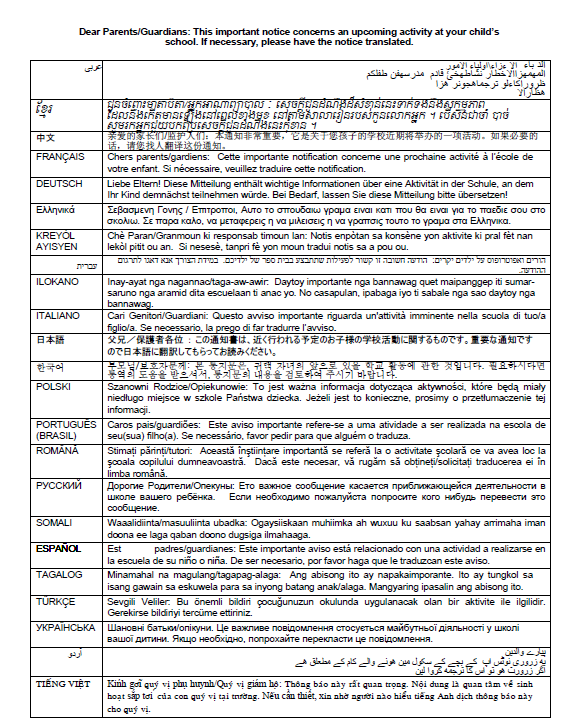
Appendix
D-45:
2024 School Based Equipment (SBE) Staff Survey
((Approved
v.30) now moved to Appendix I )
School-Based Equipment-Staff Questions
Respondent: The district assessment coordinator designates a technology coordinator for each sampled school who will respond to this survey. The designated technology coordinator may be school based or district based.
Distribution: This survey will be distributed via AMS after schools complete the 2024 operational assessment; all technology coordinators in each grade will receive the survey.

Device Ownership
Which of the following models is used in your school(s) to provide technology access (e.g., laptops, desktop computers, tablets) for your students (select all that apply)?
-
One to one
One to many
Media room or library
Bring your own device (BYOD)
Not applicable
Grade 4
Grade 8
Grade 12

Device Management
Are all your student devices managed?
Yes
School
District
State
No
Approximate percentage of managed devices (fillable field):
Approximate percentage of unmanaged devices (fillable field):
How does a school, district, or state manage student devices?
School-owned devices:
Chromebooks
Google Admin console
Google Workspace for Education
Other, please specify (fillable field):
Microsoft Windows devices
Microsoft Intune for Education service:
Other, please specify (fillable field):
Other platforms (please specify):
Bring your own devices (BYOD)
Does not manage centrally
Chromebooks
Google Admin console
Google Workspace for Education
Other, please specify (fillable field):
Microsoft Windows devices
Microsoft Intune for Education service
Other, please specify (fillable field):
Other platforms (please specify):
How are applications distributed to devices?
Chromebooks
All applications are managed via Google Admin console
Faculty or students can install apps as a part of a classroom curriculum
Applications are installed individually from the Chrome web store
Applications are installed individually from credible sources (e.g., websites from organizations such as Pearson, Cambium)
Microsoft Windows devices
All applications are distributed remotely via a central management tool
.Preferred format (if known)
MSI
MSIX
Installed individually from Windows Store
Installed individually from credible sources (e.g., websites from organizations such as Pearson, Cambium)
Other, please specify (fillable field):
Other platforms (please specify):
How are major state assessment apps configured on school devices to provide a secure/lockdown testing/assessment environment?
Chromebooks
via Google Admin console kiosk mode option
Other, please specify (fillable field):
Windows
via Microsoft tool "Take a Test in kiosk mode"
Installed app controls the secure environment without additional configurations required
.Installed app controls the secure environment with additional manual configurations
.Other, please specify (fillable field):
Who is responsible for installing applications on school equipment (select all that apply)?
School technology coordinator
District technology coordinator
Other, please specify (fillable field):

Device and Security Policies
What is the replace (refresh) device policy at your school/district/state?
Every year
Every two years
Every three years
Every four years
Other, please specify (fillable field):
What is the operating system (OS) upgrade policy at your school/district/state?
Every major OS release
On a set schedule (please specify):
On a delayed schedule (please specify):
Do your security policies allow an outside application to be downloaded on student devices?
Yes
No
Do school/district/state policies enforce the creation of guest accounts for any state assessment/test applications?
Yes
No
Do school/district/state policies allow any of the following activities?
|
Yes |
Yes, with restrictions |
No |
Not applicable |
a. Allowing installed applications to access the local user’s file system |
|
|
|
|
b. Downloading applications from websites other than Microsoft and Chrome application stores |
|
|
|
|
c. Downloading and installing executable files from credible sources if they are safelisted/whitelisted |
|
|
|
|
d. Downloading and installing any executable files from credible sources regardless of safelist status |
|
|
|
|

Device Specification
What type of student devices and operating systems (OS) does your school support (check all that apply)?
|
Chromebook ChromeOs |
Microsoft Windows (Laptops, tablets, desktops) |
MacOs (Laptops, desktops) |
iPad iOS |
Android Tablet Android Os |
Other (fillable) |
Grade 4 |
|
|
|
|
|
|
Grade 8 |
|
|
|
|
|
|
Grade 12 |
|
|
|
|
|
|
What is the screen resolution on the type of devices students use in your school (select all that apply)?
1366x768
1920x1080
1920x1200
1224x768
Other (fillable field):
What is the screen size on the type of devices students use in your school (select all that apply)?
14.0”
12.2”
13.5”
15.6”
Other (fillable field):
If touch computers are used by students, is a stylus provided (select all that apply)?
Touch computers are provided by the school with a stylus
Touch computers are provided by the school without stylus
Students purchase their own styluses
Touch computers are not used by students
Appendix D-46: Assessment Details Notification Principal to School Coordinator Letter
(Renamed to “Assessment Details Notification NSC to Principal” and was submitted in Appendix D-6, Approved v.30)
Appendix D-47: Public School Coordinator responsibilities
(Renamed to “Preassessment responsibilities Guide” (see Appendix D-14b))
Appendix D-48: Private School Coordinator Responsibilities
(This document will not be produced for 2024 administration)
Appendix D-49: 2024 Private School Video Script (Approved v.30)
Video Title: NAEP is Supported by Many Private School Organizations
Screen # |
Narrated Text |
Description of Screen |
1 |
The National Assessment of Educational Progress, also known as NAEP, or The Nation’s Report Card, is supported by many private school organizations. |
NAEP logo appears on screen. |
2 |
Several organizations have provided letters of support for the NAEP 2024 assessment, including the Council for American Private Education (CAPE), the National Catholic Educational Association (NCEA), the National Association of Independent Schools (NAIS), and the Association of Christian Schools International (ACSI) among many others. |
Screen shots of endorsement letters from CAPE, NCEA, NAIS, and ACSI appear on screen.
|
3 |
Here is the full list of private school organizations that have provided letters of support for NAEP 2024. |
[Placeholder for full list of organizations that provide letters in 2024] |
4 |
By participating in NAEP 2024, your school will contribute to the picture of education across the nation and to future policy decisions. For more information about the importance of participation in NAEP, contact your private school organization leaders or your NAEP representative. |
A map of the United States with education icons popping out of various locations in the map |
5 |
NAEP, giving private schools a voice in the national education conversation. |
NAEP, giving private schools a voice in the national education conversation. |
Video Title: NAEP Benefits for Students, Teachers, and Schools
Video Title: Participation in NAEP is Easy
Screen # |
Narrated Text |
Description of Screen |
1 |
Your school has been selected to represent private schools across our nation by participating in the 2024 administration of the National Assessment of Educational Progress, also known as NAEP or The Nation’s Report Card. |
NAEP logo appears on screen. |
2 |
In order to have a complete picture of the academic achievement and progress of the nation's private school students, selected private schools must participate in NAEP. Your school’s participation in NAEP 2024 is an opportunity to help make it possible for private school data to be reported and compared with public school data. |
Icons representing public and private schools
Your school’s participation is important! |
3 |
Participating in NAEP is easy and there is no cost to your school to participate. Your school has been assigned a NAEP representative who will support your school’s designated NAEP school coordinator to ensure smooth assessment day activities. NAEP representatives will work with the school coordinator to confirm that the assessment date works with the school calendar, to secure a space for the assessment to take place, and to confirm other assessment day logistics. |
Participating in NAEP is easy!
Image of the NAEP representatives on the phone with a school coordinator |
4 |
NAEP representatives will bring in all the necessary equipment and materials and will administer the assessment to students. When the assessment is complete, NAEP representatives will pack up all the equipment and materials and return the testing location to its original condition. |
Images of NAEP representatives bringing the equipment to the school and administering the assessment |
5 |
We look forward to working with you to make NAEP a success in your private school. Please reach out to your NAEP representative to discuss any participation questions. NAEP, giving private schools a voice in the national education conversation. |
Image of NAEP representatives.
NAEP, giving private schools a voice in the national education conversation. |
Video Title: NAEP High School Transcript Study in Private Schools
Screen # |
Narrated Text |
Description of Screen |
1 |
The High School Transcript Study is an integrated part of the NAEP experience for public and private schools. The study seamlessly links courses and student transcripts to NAEP 2024 results in Grade 12 mathematics. |
Visual representation of NAEP 2024 Grade 12 Mathematics and a representation of courses and transcripts and then show linkage between. |
2 |
Through the HSTS, we learn important details about student coursetaking. For instance, in 2019 we found that private high school graduates completed a calculus course more often than their public school counterparts, at 24 percent compared to 15 percent. Private high school graduates were also more likely to complete both a biology and chemistry course, at 94 percent, compared to only 73 percent of public high school graduates. |
4-bar chart comparing public and private school student coursetaking calculus and biology/chemistry.
Percentages appear as script is read.
|
3 |
It’s easy to participate: NAEP representatives will assist schools in collecting course catalogs and student transcripts, and no added student or teacher time is needed. Privacy is NAEP’s top priority, with student information removed or masked before transcripts are processed. There’s no extra cost; in fact, NAEP pays each school a fee for the transcripts collected. |
Bullets slide in, and say:
|
4 |
We’re excited to have you as a part of this useful study. Thank you for giving private schools a voice by participating in NAEP and HSTS. |
Visual representation of individual schools linking to the nation. |
Appendix D-50: NAEP 2024 Operational and Pilot Technical Fact Sheets (New)
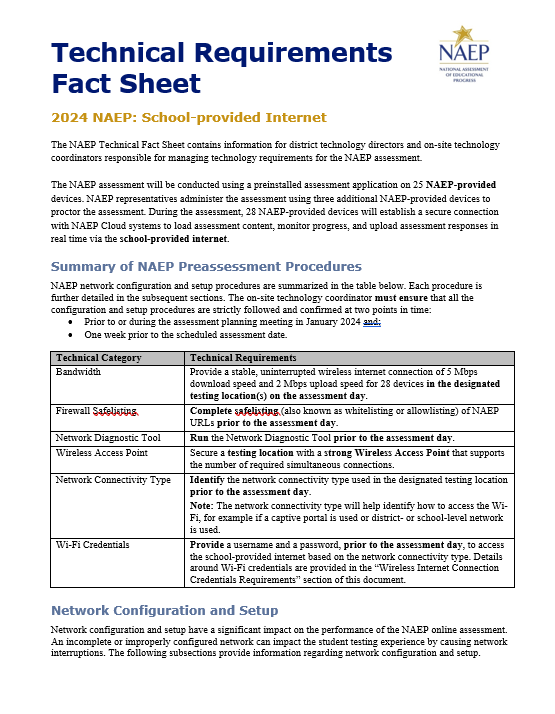
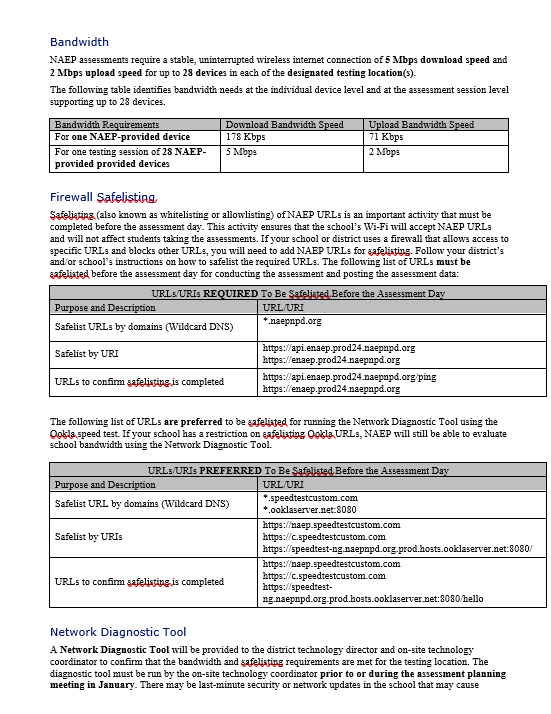
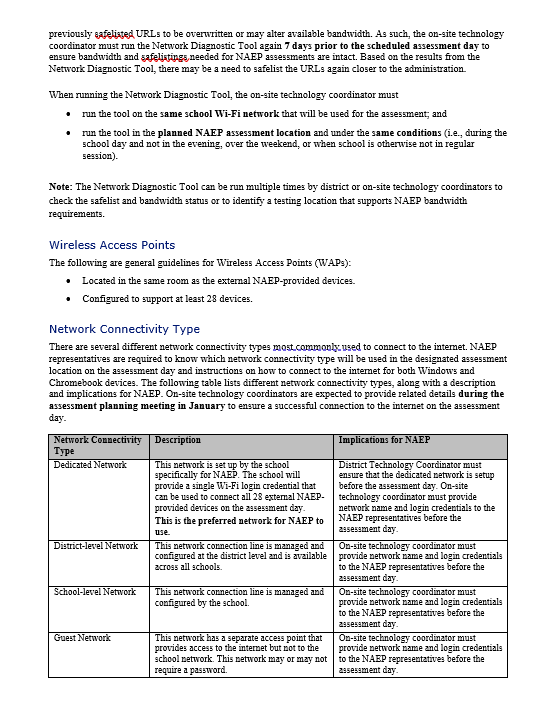
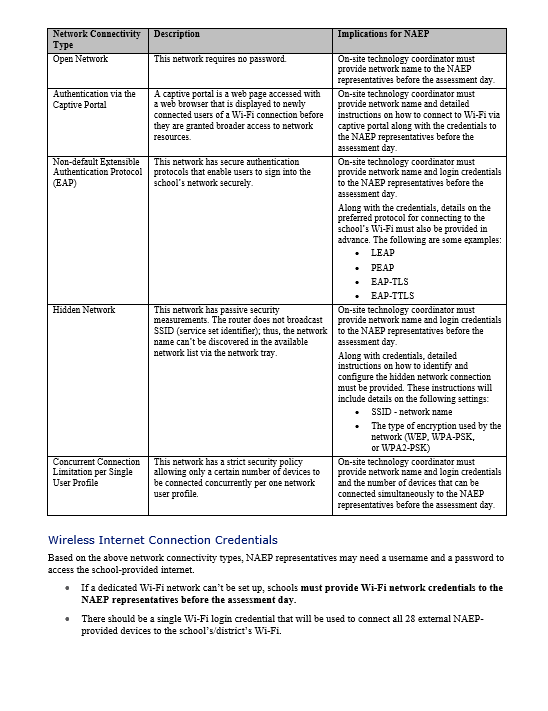

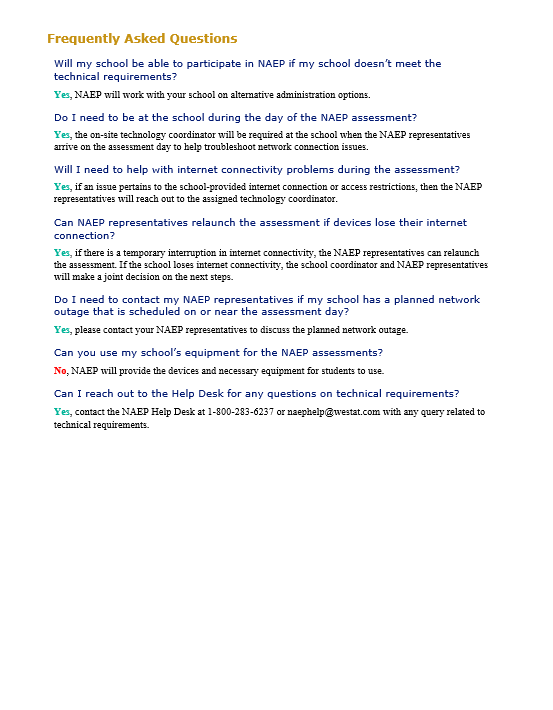
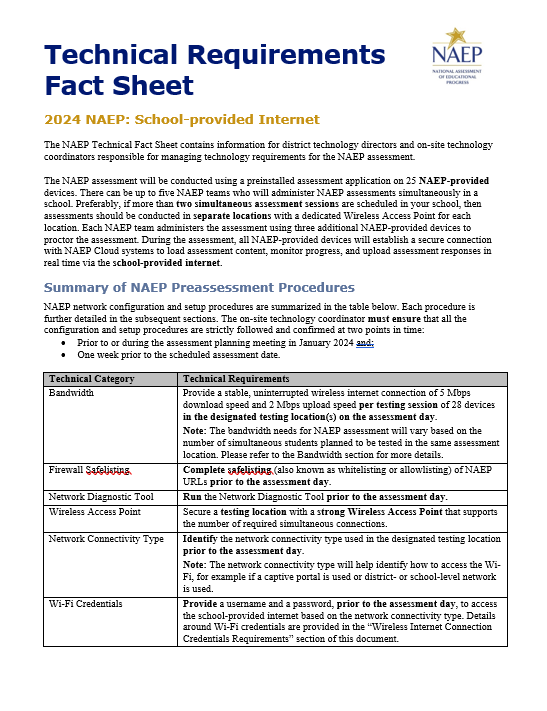
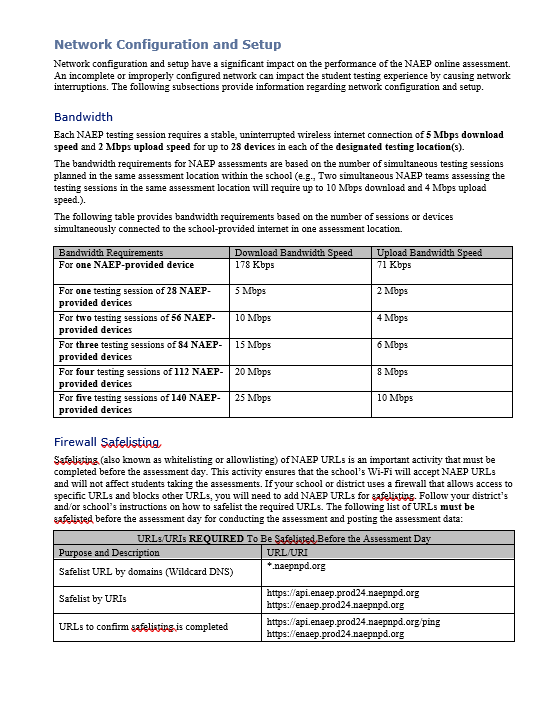
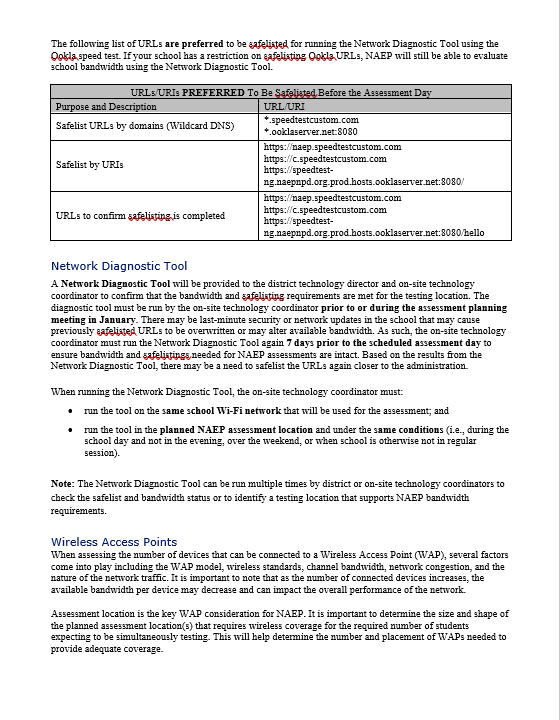
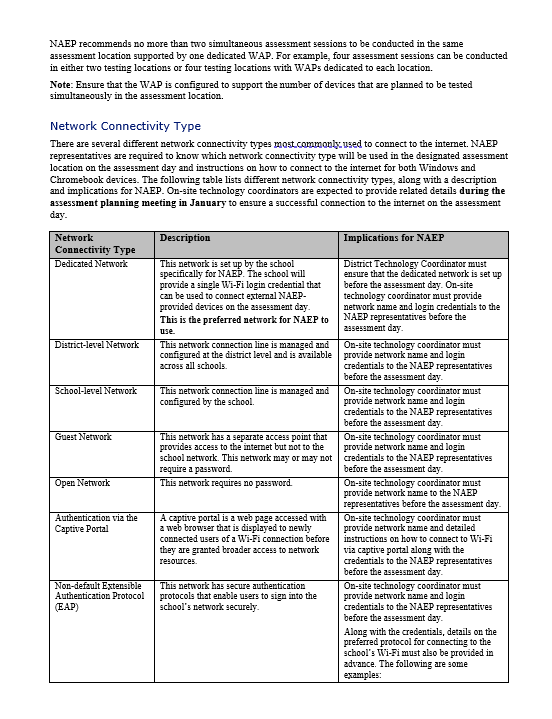
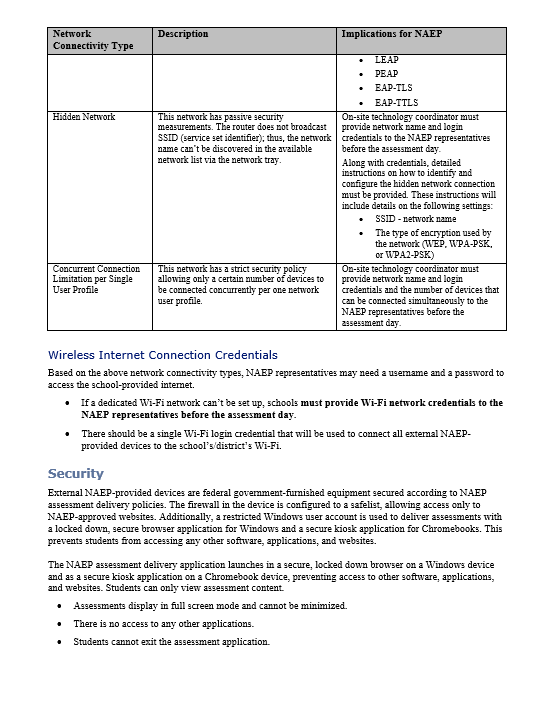
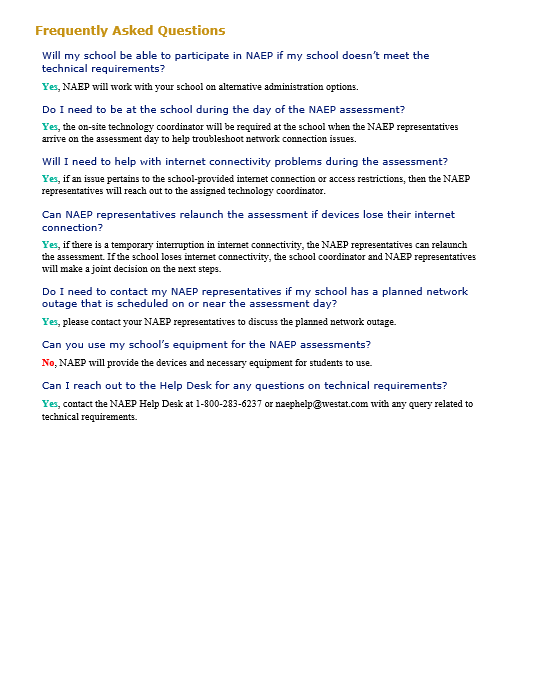
Appendix D-51: NAEP 2024 Best Practices Materials (New)
Appendix D-51a: Best Practices Initial Mailing (New)
Dear School Principal,
Enclosed please find the Best Practices Guide for Supporting Twelfth-Grade NAEP Participation. The guide includes proven practices and strategies, from administrators like you, to make the National Assessment of Educational Progress (NAEP) a very positive and successful experience for our nation’s high schools.
NAEP results provide valuable feedback to educators, elected officials, and policymakers who work to maintain and improve the quality of our education system. Since NAEP is designed to assess a representative sample of our nation’s students, the accuracy of NAEP relies on the full participation of you, your teachers, and your students. One of the major purposes of NAEP is to show how education in the nation and our state is progressing. For that, we need a true picture of our students’ collective progress.
Twelfth-grade participation
Historically, twelfth-grade student participation in NAEP has been a challenge. Both low participation and low motivation can undermine the validity and credibility of NAEP results for high school students. As the graph below demonstrates, NAEP participation increased with the implementation of the Best Practices Guide in 2007. Participation is more important than ever since this is the first NAEP Grade 12 assessment since the COVID-19 pandemic began.
NAEP School and Student Participation Rates for Public Schools: Grade 12

Recommendations from the Secondary School Principals’ Working Group
The Best Practices Guide was created after NCES convened a Secondary School Principals’ Working Group in 2005 to address twelfth-grade participation rates. After discussing participation rates, student motivation, and student results, the working group concluded that the results did not reflect the true level of achievement of their students. The working group also concluded that high school principals and other school leaders could help improve participation rates by obtaining teacher buy-in and motivating students to take the assessment and do their best, and that best practices for achieving high participation should be shared with principals.
Twelfth-grade participation in NAEP improved after the implementation of these recommendations, but only because principals like you have used some or all the strategies included in the Best Practices Guide. With increased participation headwinds in assessments, NAEP relies on principals like you more than ever.
Preparing for NAEP 2024
The guide included in this package will provide the tools you need to communicate the importance of participating in NAEP to your students and teachers. Some of the resources available in the Best Practices Guide for Supporting Twelfth-Grade NAEP Participation are listed below:
Videos to introduce NAEP to students and teachers;
PowerPoint presentations customized for the students, parents, and staff at your school;
MS Word templates for student notification letters, morning announcements, and more;
Talking points used by principals for communicating with teachers, students, and parents; and
Social media posts announcing NAEP to various audiences.
In addition, you will receive three emails in the months leading up to the assessment. Each email will highlight effective strategies for encouraging participation and will link to the resources mentioned above.
Meeting with your NAEP State Coordinator
I will be meeting with grade 12 schools to introduce the resources from the Best Practices Guide and effective strategies for encouraging participation on the NAEP assessment. <State Coordinators will include specific details on their meeting here.>
If you have any questions about the Best Practices Guide or the upcoming NAEP assessment, please contact me at NSC email or NSC phone number.
Sincerely,
NSC Name
Enclosures: NAEP 2024 Best Practices Guide for Supporting Twelfth-Grade NAEP Participation
National Center for Education Statistics (NCES) conducts the National Assessment of Educational Progress to evaluate federally supported education programs. All of the information you provide may be used only for statistical purposes and may not be disclosed, or used, in identifiable form for any other purpose except as required by law (20 U.S.C. §9573 and 6 U.S.C. §151). By law, every NCES employee as well as every NCES agent, such as contractors and NAEP coordinators, has taken an oath and is subject to a jail term of up to 5 years, a fine of $250,000, or both if he or she willfully discloses ANY identifiable information about you. Electronic submission of your information will be monitored for viruses, malware, and other threats by Federal employees and contractors in accordance with the Cybersecurity Enhancement Act of 2015.
Appendix D-51b: Best Practices Emails (New)
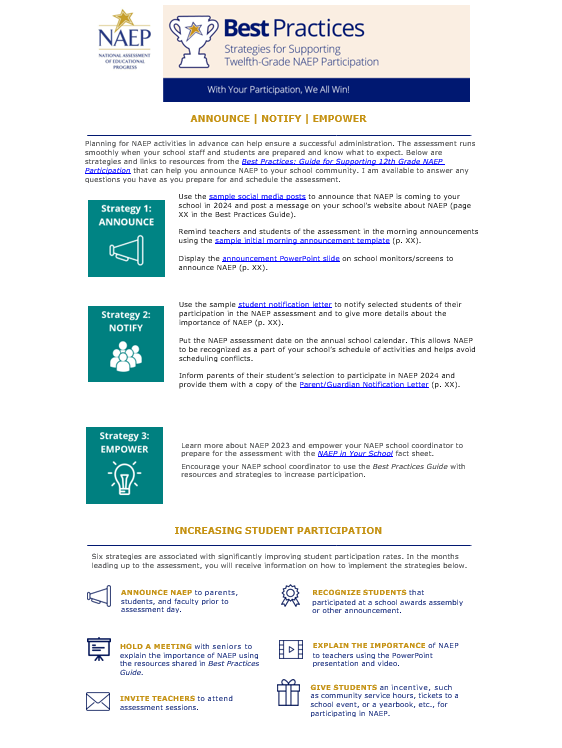
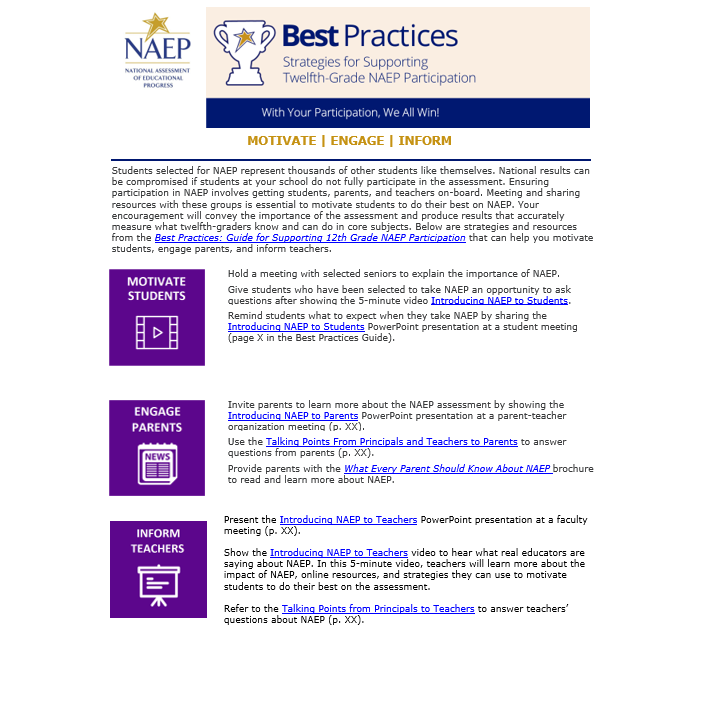
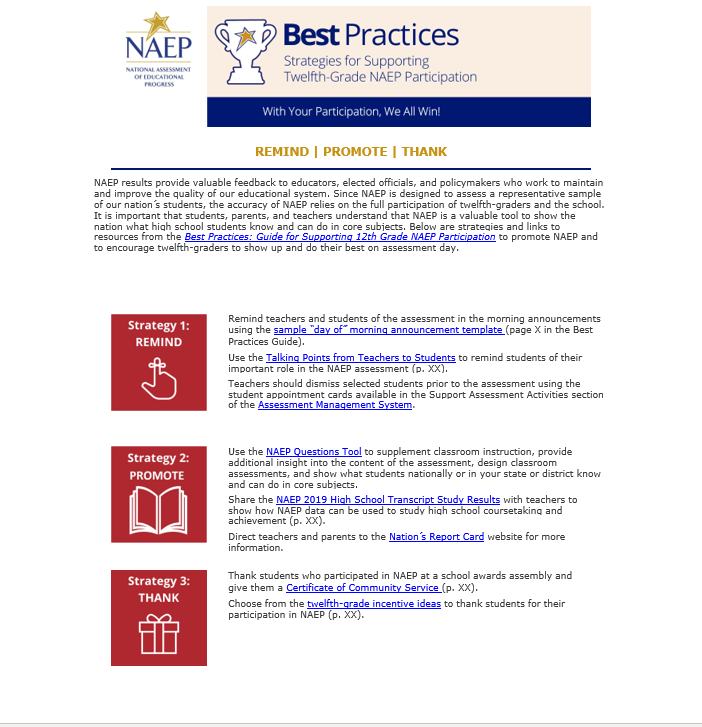
Appendix D-51c: Best Practices Notification Letter for Students (New)
 Notification
Letter
Notification
Letter
For Students
Dear Student:
Congratulations! You have been selected to participate in this year’s National Assessment of Educational Progress, also known as NAEP. Very few students are selected, but you have been chosen to represent thousands of your peers in this important assessment.
NAEP is the most important measure of what students from across the country know and can do in a variety of subject areas. It is different from our state assessments because it represents high school students across the country, not just those here in [state]. Your participation will provide a snapshot of what students from across the country have learned in school, which will inform major decisions about how to improve education in the United States. In short, it’s important that you take part and give it your best effort!
You will take NAEP at [time, date, location] with other selected students.
You will take a mathematics or reading assessment.
NAEP takes about 2 hours, and you don’t need to study for it.
Your answers will be anonymous and will NOT affect your grades or academic record in any way.
Upon completion of the assessment, you will receive a Certificate of Community Service.
If you have any questions or would like to review sample questions, [insert name of school contact person] will be happy to help. You can also visit http://nces.ed.gov/nationsreportcard/students for more information.
We are fortunate that our school has been selected to participate in NAEP, and we are excited to have you take the assessment. We know you will do your best and help us show what our students are capable of.
Sincerely,
(School Principal)
What students are saying about NAEP participation…
[Insert QR code linking to Hager Sharp’s Introducing NAEP to Students video]
Appendix D-51d: Best Practices Social Media and Online Communications (New)
 Social
Media and Online Communication
Social
Media and Online Communication
Sample Announcements
If your school uses Twitter and/or Facebook to communicate with parents, students, and teachers, you can also use these platforms to communicate the importance of the assessment to teachers and to encourage student participation. The following messages below are formatted for Facebook and Twitter and are available for you to customize before posting to your school’s social media channels. These messages can also be posted on your school website, incorporated in school emails, newsletters, and/or your school’s preferred social media platform.
In addition, you can follow NAEP’s social media accounts as we regularly share resources, results, and tools for working with NAEP that states also share on their pages to prepare for participation in the assessments. Find our social media accounts below.
h![]() ttps://www.facebook.com/NationalAssessmentofEducationalProgress/
ttps://www.facebook.com/NationalAssessmentofEducationalProgress/
h![]()
![]() ttps://twitter.com/naep_nces?lang=en
ttps://twitter.com/naep_nces?lang=en
https://www.youtube.com/user/TheNationsReportCard
Scheduling Information
F |
T |
Our school will have the chance to make a difference in education on [DATE]! Learn why our participation in NAEP is important at https://www.nationsreportcard.gov/. |
We’re excited to announce our school will participate in #NAEP on [DATE]! Learn about this national assessment at https://www.nationsreportcard.gov/. |
A group of our 12th-graders will represent thousands of others across the country on [DATE]! Known as The Nation’s Report Card, NAEP is the largest nationally representative and continuing assessment of what students in the United States know and can do in a variety of subjects. Learn more at https://www.nationsreportcard.gov/
|
#NAEP will be administered to select 12th-graders at our school on [DATE]. To learn more about the program, visit https://nces.ed.gov/nationsreportcard/students/ |
Something big is happening on [DATE]. A group of our 12th-graders will participate in #NAEP that day! Learn more at https://nces.ed.gov/nationsreportcard/students/ |
Information for Teachers
F |
T |
Teachers, how much do you know about NAEP? What does NAEP mean for you and your students? Hear what other teachers are saying at https://nces.ed.gov/nationsreportcard/participating/schools.aspx |
Some of our 12th-graders have been selected to participate in #NAEP! Discover what other #teachers are saying at https://nces.ed.gov/nationsreportcard/participating/schools.aspx |
NAEP results help us better understand how our students are performing academically across the United States. Learn more about why participation is important at https://www.nationsreportcard.gov/focus_on_naep/participation/#/grade12 |
#Teachers, do you know why our #student participation in #NAEP is important? Find out: https://www.nationsreportcard.gov/focus_on_naep/participation/#/grade12 |
#Teachers, find out the types of questions your #students will see on #NAEP with the NAEP Questions Tool: https://nces.ed.gov/nationsreportcard/nqt/ |
Information for Students
F |
T |
12th-graders, don’t forget! If you have been selected to take NAEP, your participation is essential for understanding what students across the country have learned in school. Curious about the types of questions you can expect to see on #NAEP? Check out the NAEP Test Yourself tool at https://www.nationsreportcard.gov/testyourself.aspx |
Curious about the types of questions you can expect to see on #NAEP? Check out the NAEP Test Yourself tool at https://www.nationsreportcard.gov/testyourself.aspx |
What is NAEP? Learn the answer to this question and more at https://nces.ed.gov/nationsreportcard/students/ |
You don’t have to study for #NAEP, but your participation is still important. Find out why: https://nces.ed.gov/nationsreportcard/students/
|
Information for Parents
F |
T |
Parents, if your 12th-grader has been selected to take NAEP, they will represent thousands of other students across the United States. Discover other reasons why participation is so important at https://nces.ed.gov/nationsreportcard/parents/ |
Mark your calendars, parents! Our school will participate in #NAEP on [DATE]. Learn more about the assessment at https://nces.ed.gov/nationsreportcard/parents/ |
Do you have any questions about NAEP and your child’s involvement? Learn the answers to your questions and more by visiting https://nces.ed.gov/nationsreportcard/parents/ |
If your child has been selected to participate in #NAEP, find more information about the assessment at https://nces.ed.gov/nationsreportcard/parents/ |
Why is your child’s participation in #NAEP important? Find out by visiting https://nces.ed.gov/nationsreportcard/parents/ |
Appendix D-51e: Storyboard for Introduction to Best Practices Video Script (New)
Storyboard for Introduction to Best Practices Video
Section |
Narration |
Description of Video |
1 - Introduction |
Thank you for your school’s participation in NAEP, the National Assessment of Educational Progress, for 2024, in mathematics and reading at grade 12. |
Title slide. |
2 - What is NAEP |
NAEP is the largest nationally representative assessment in mathematics and reading. Results from this assessment help inform educators, policymakers, and elected officials about the state of education in the nation. |
Image of US map and results from NRC site. |
3 - COVID-19 |
NAEP was last administered at grade 12 in 2019, prior to the start of the COVID-19 pandemic. NAEP 2024 will provide valuable insight into how the pandemic may have affected this generation of learners. |
Image of timeline of HSTS administrations with COVID affected years highlighted. |
4 - Importance of Student Participation |
It’s important for NAEP to assess as many students selected to participate as possible. These students represent the nation's geographic, racial, ethnic, and socioeconomic diversity. Assessing representative samples of students, including students with disabilities and English learners, helps ensure that NAEP results accurately reflect the educational performance of all grade 12 students, so NAEP can continue to serve as a meaningful measure of U.S. students’ academic achievement over time. |
Images depicting nationally representative sample. |
5 – The grade 12 participation challenge |
Grade 12 student participation in NAEP is a challenge. In 2005, when only 67 percent of sampled high school seniors participated, the Best Practices Guide for Supporting 12th Grade NAEP Participation was developed based on suggestions from principals like you to help address the challenge. |
Graph of student participation rate over time. |
6 – The Best Practices Guide |
We need your help in encouraging your twelfth-graders to participate in NAEP to ensure grade 12 results can be reported for 2024. To help you support greater student participation, your NAEP State Coordinator will present you with a copy of this Best Practices Guide. |
Image of the front cover of the guide. |
7 – Resources |
This guide provides the tools, resources, and strategies to communicate to students, teachers, and parents the importance of participating in NAEP and to encourage grade 12 students to show up and do their best on the assessment. |
Show table of contents and some resources. |
8 – Thank you |
We encourage you to review this guide and implement these best practices in your schools. If you have questions, please reach out to your NAEP State Coordinator. Thanks again for your school’s participation. |
Thank you slide. |
Appendix D-51f: Introducing NAEP to Students (New)
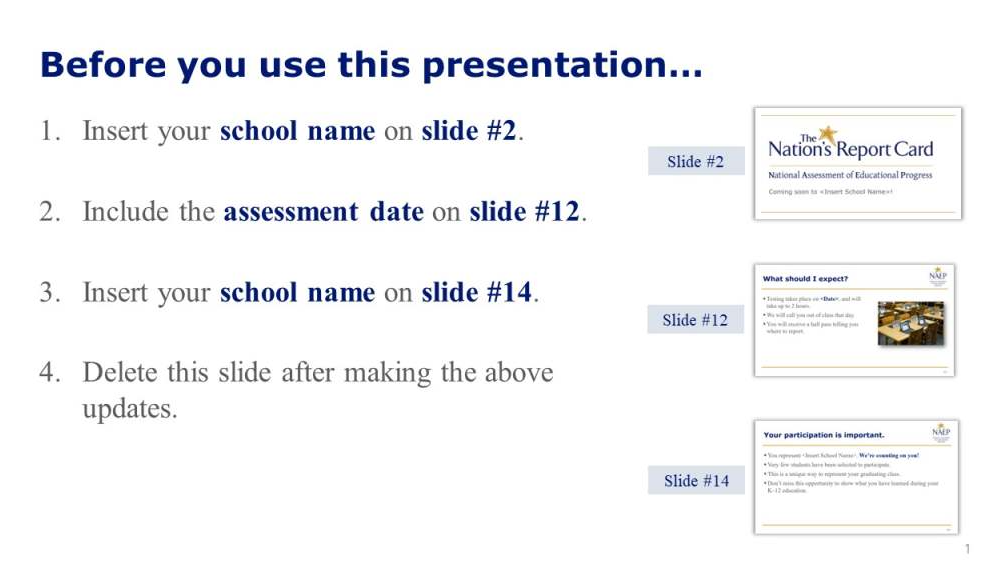
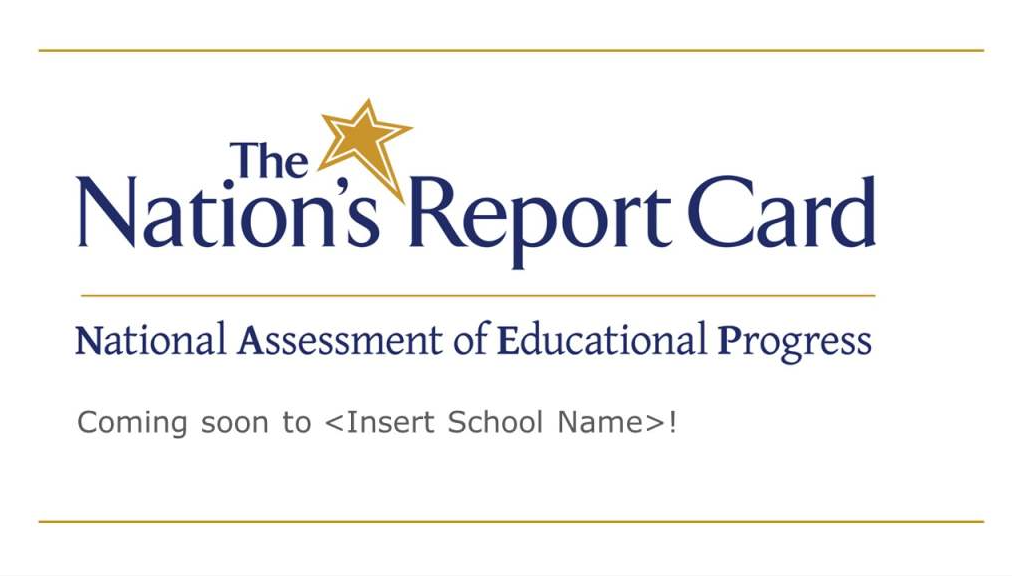
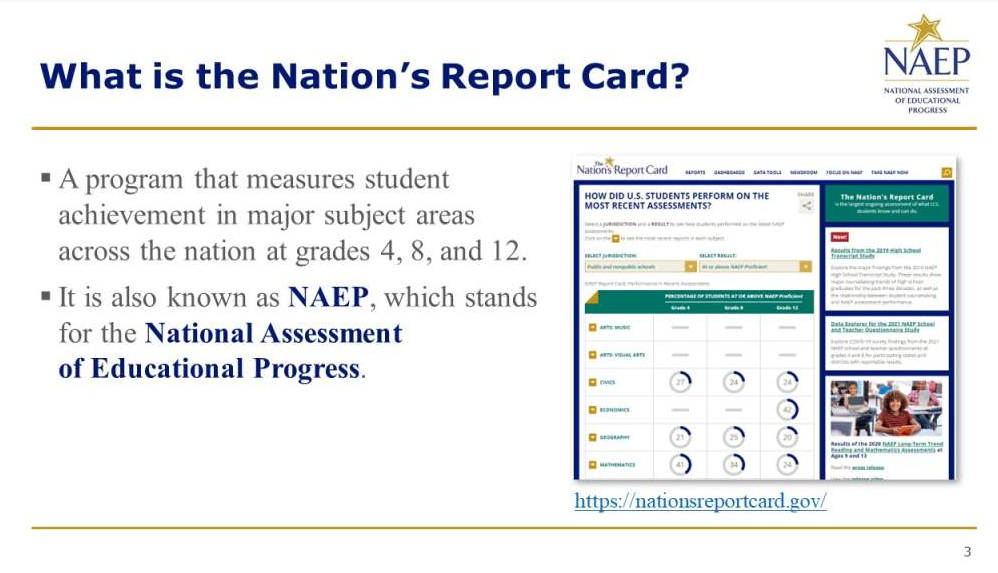
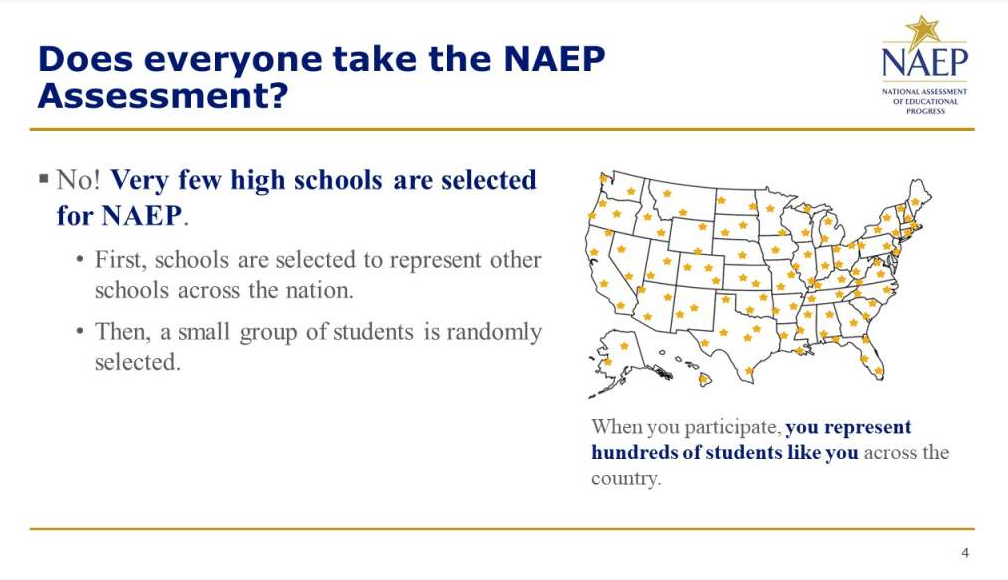
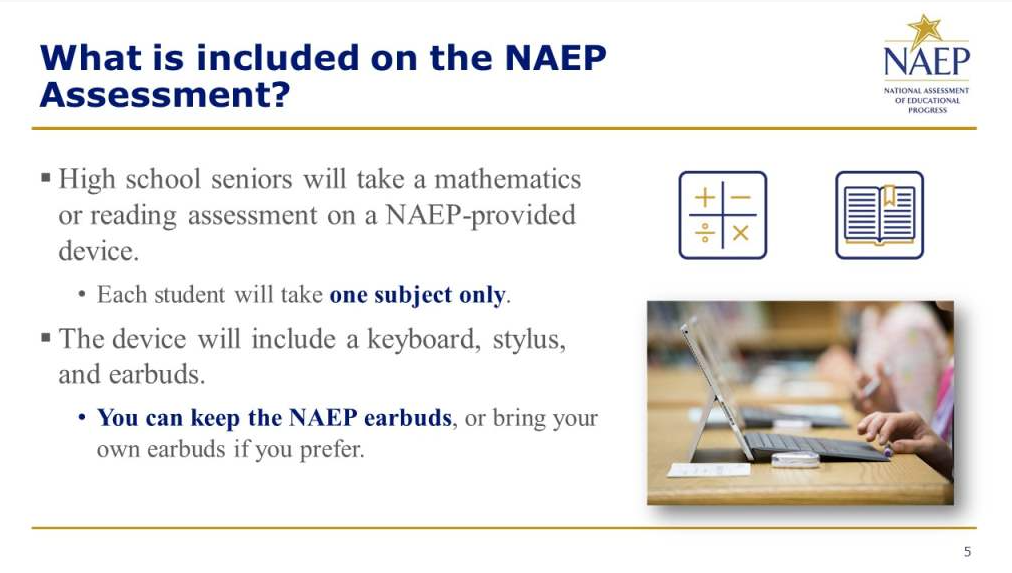
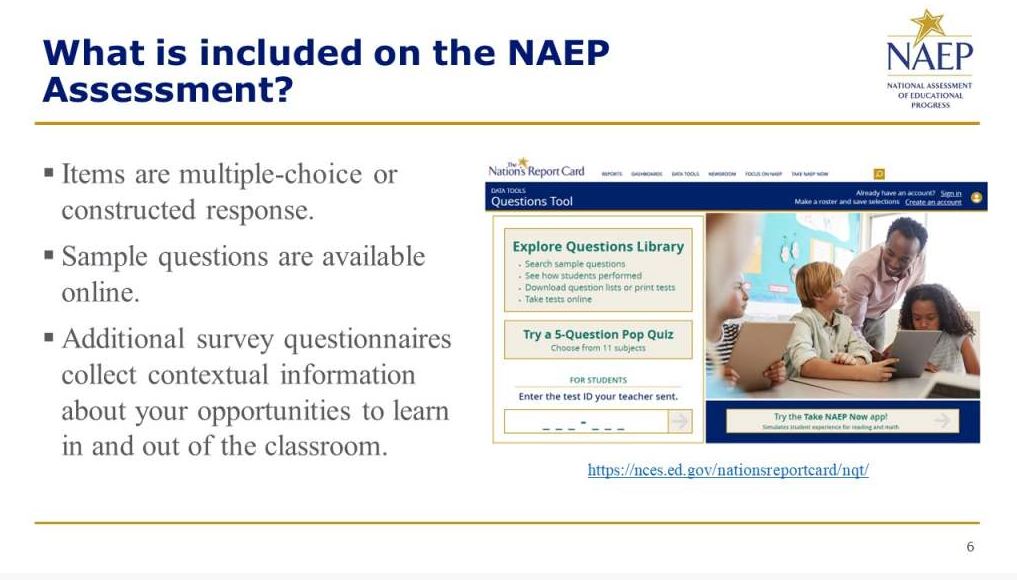
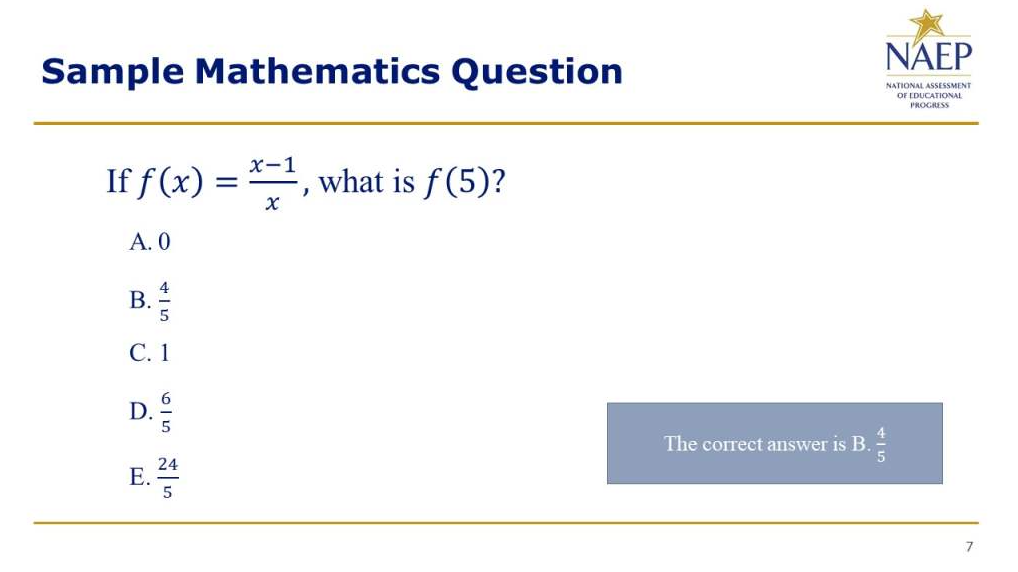
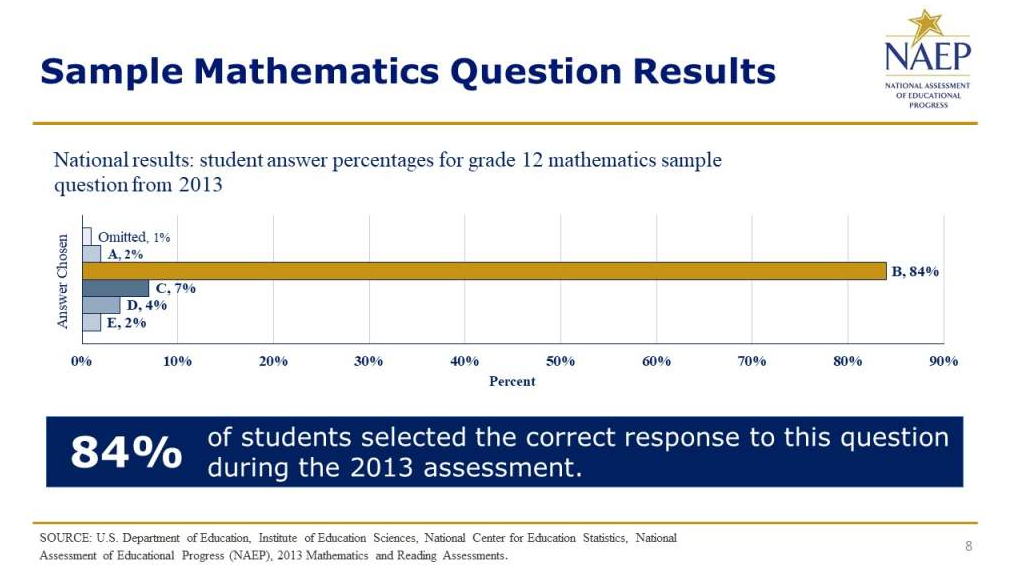
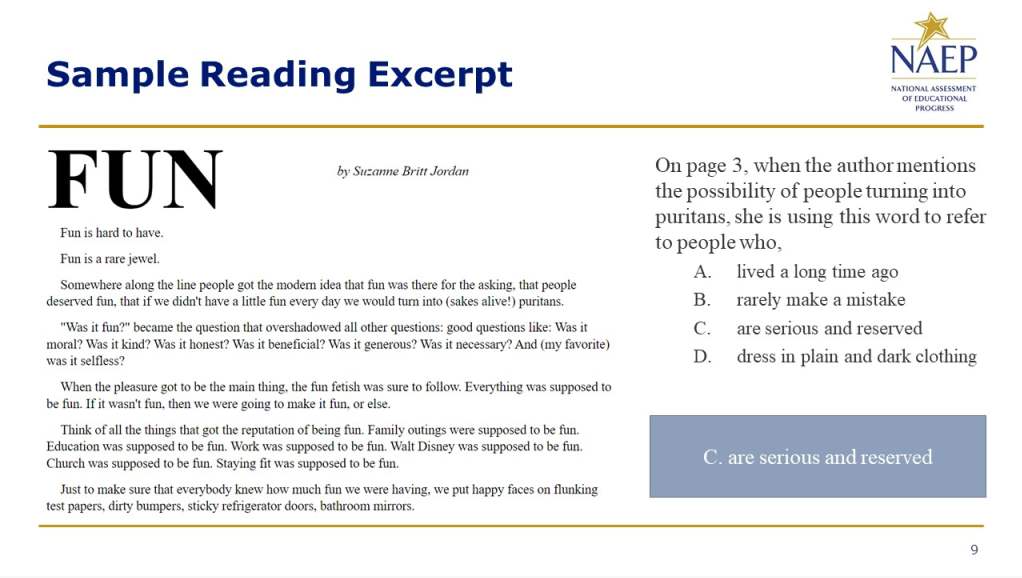
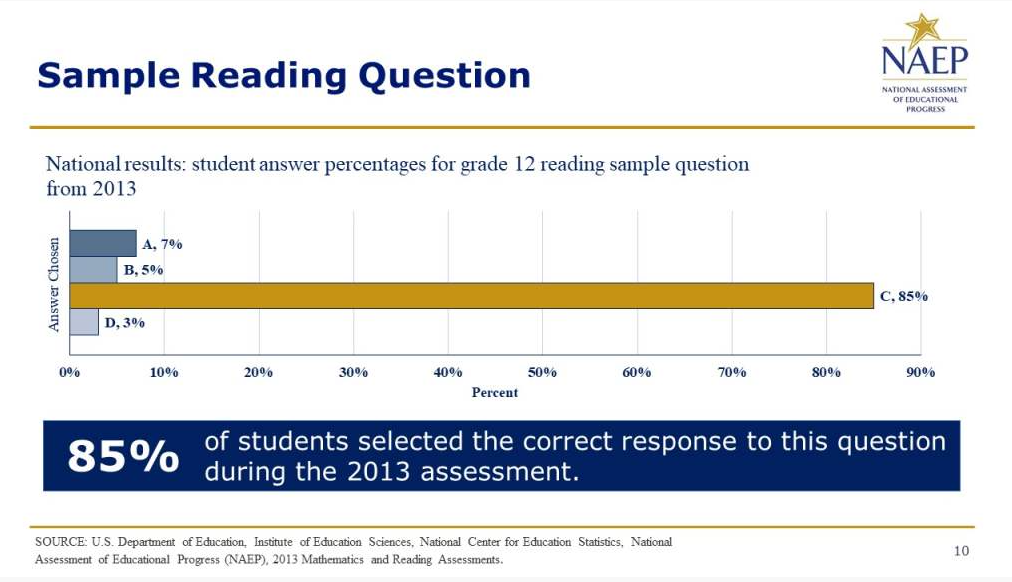
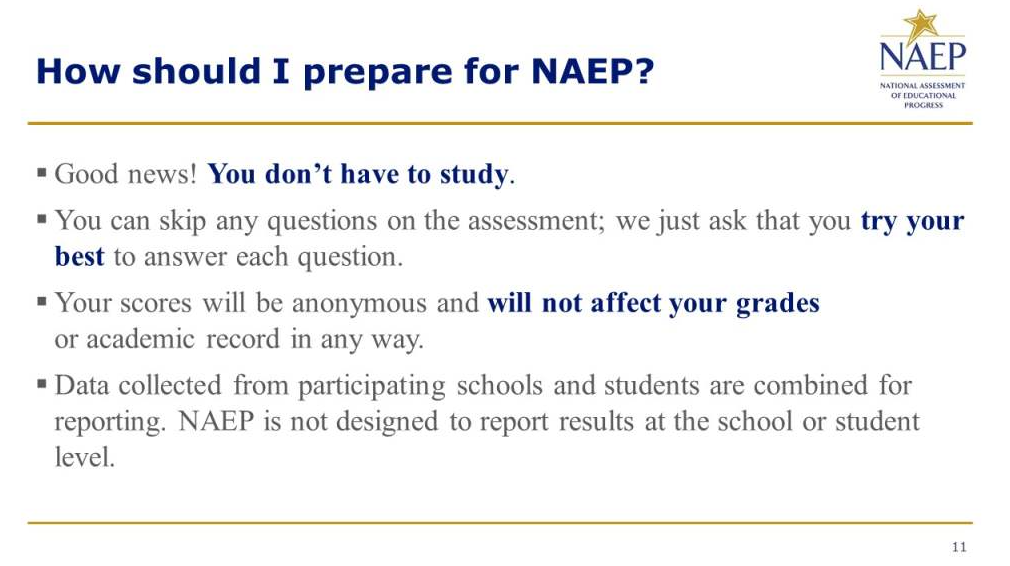
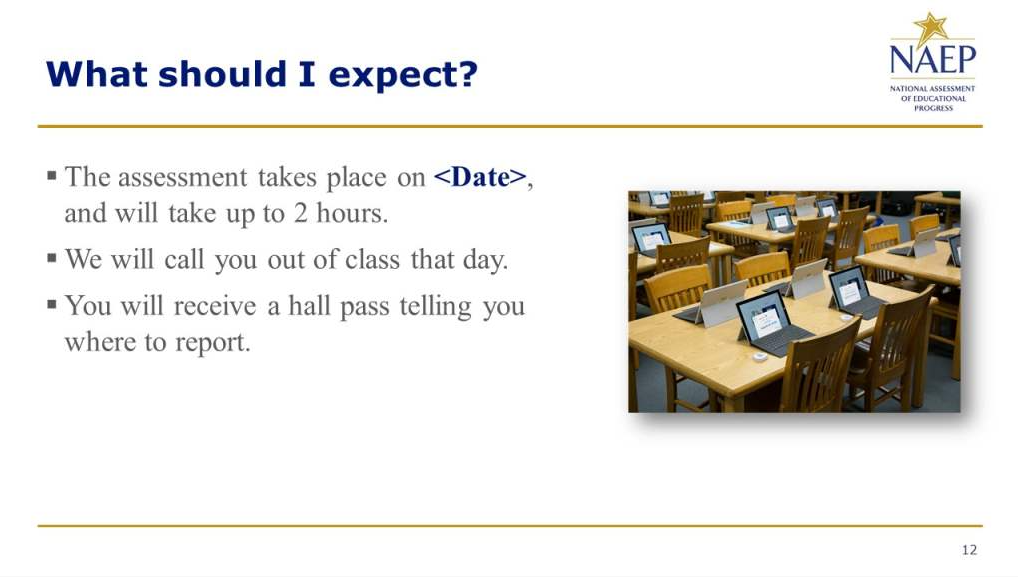

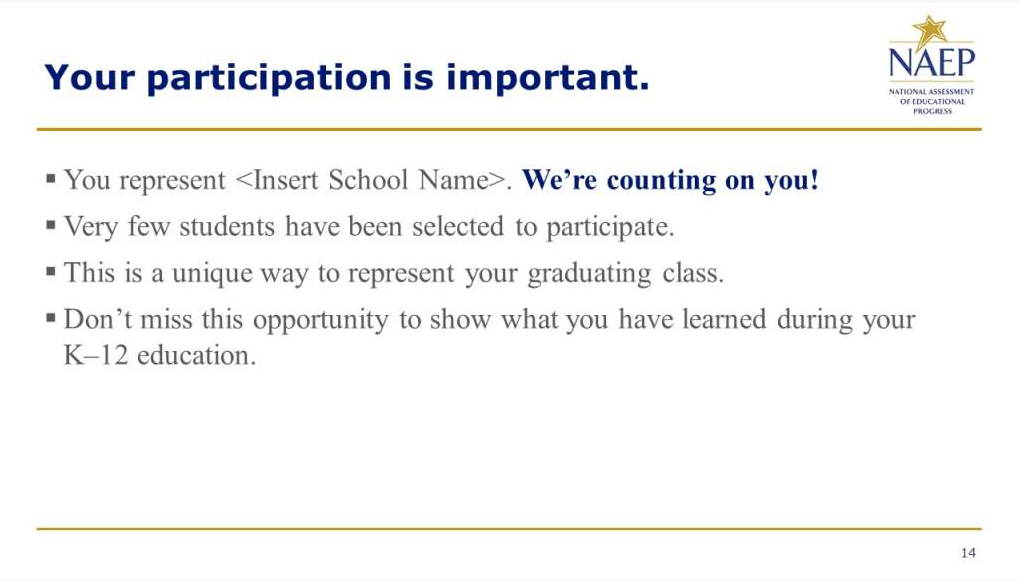
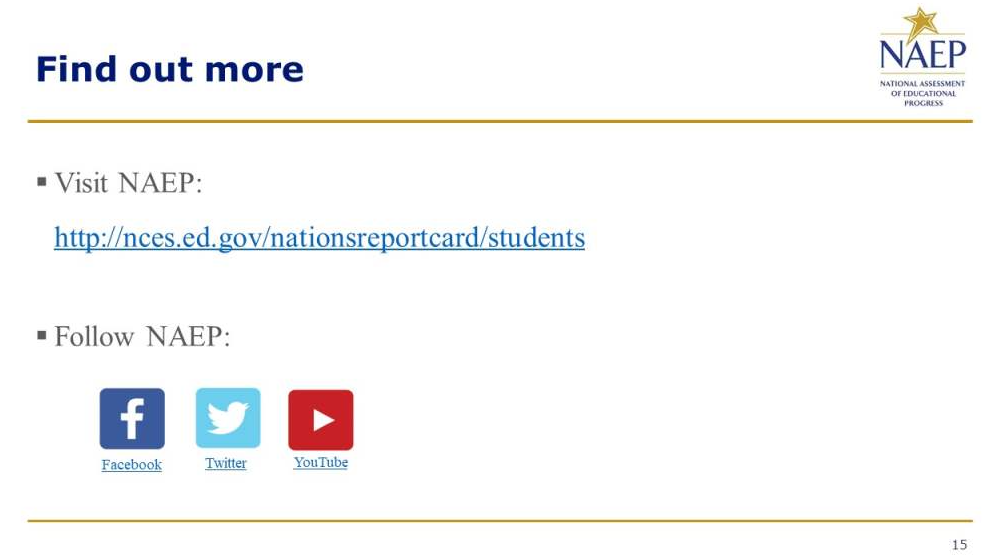
Appendix D-51g: Introducing NAEP to Teachers (New)
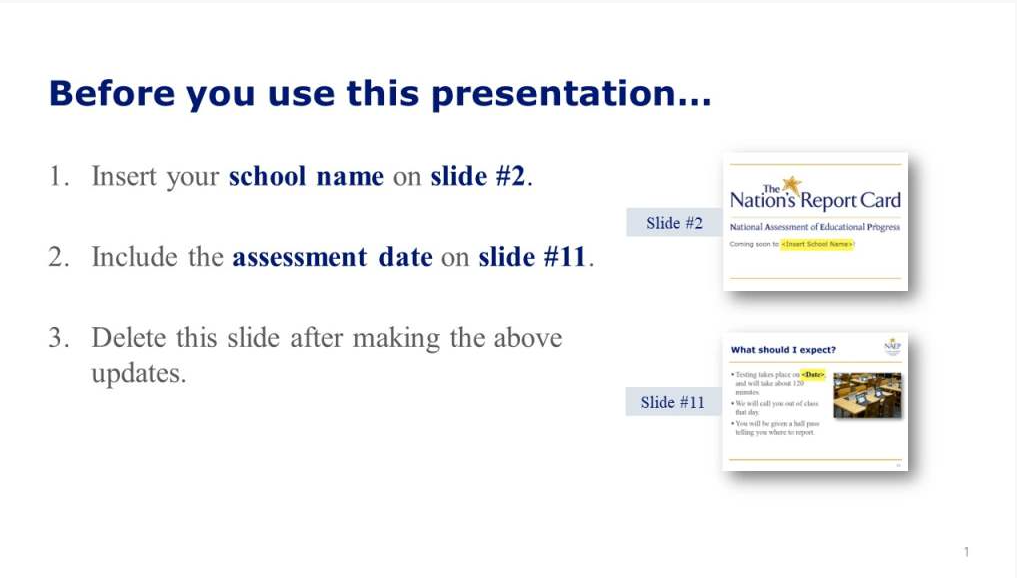
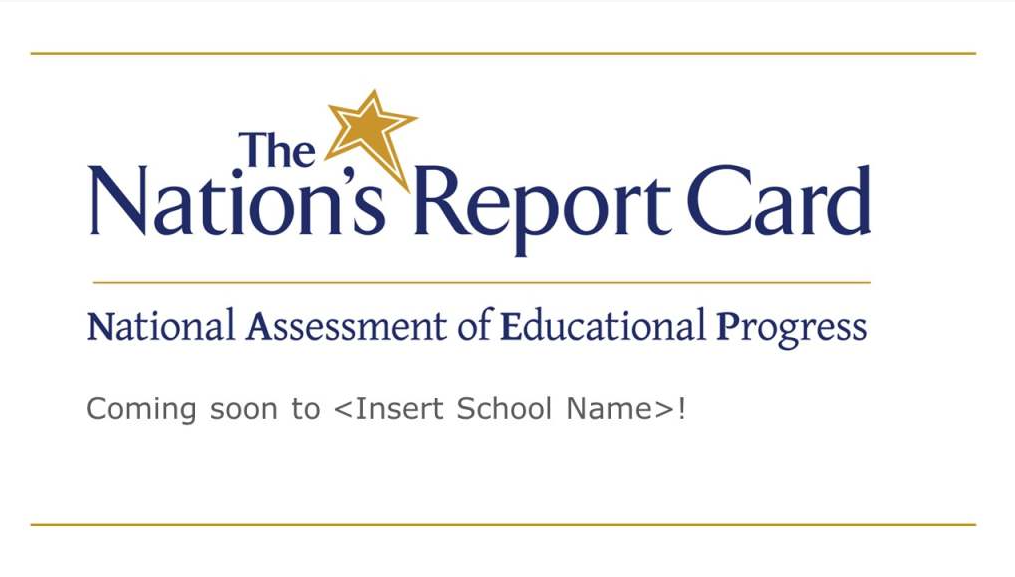
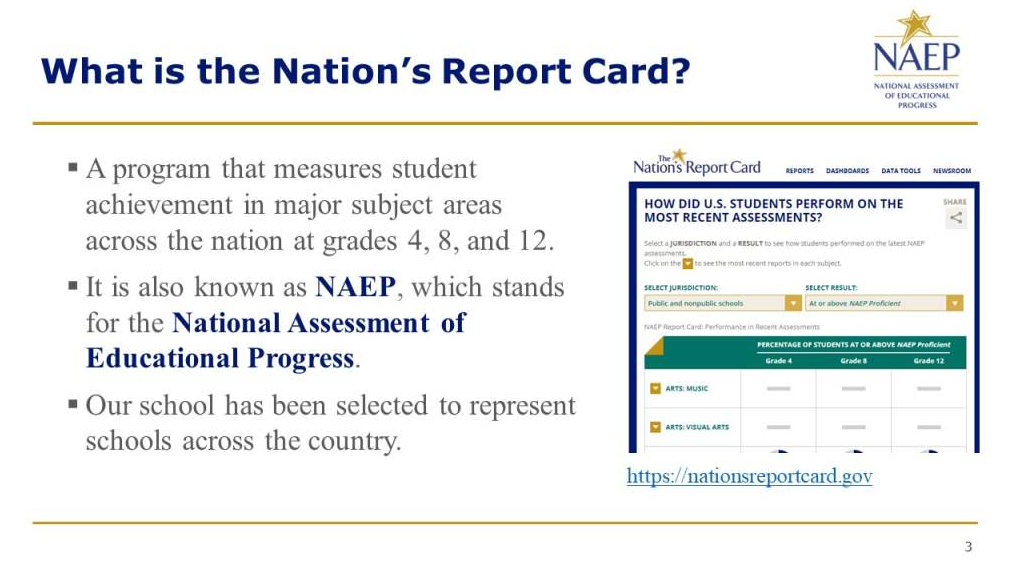
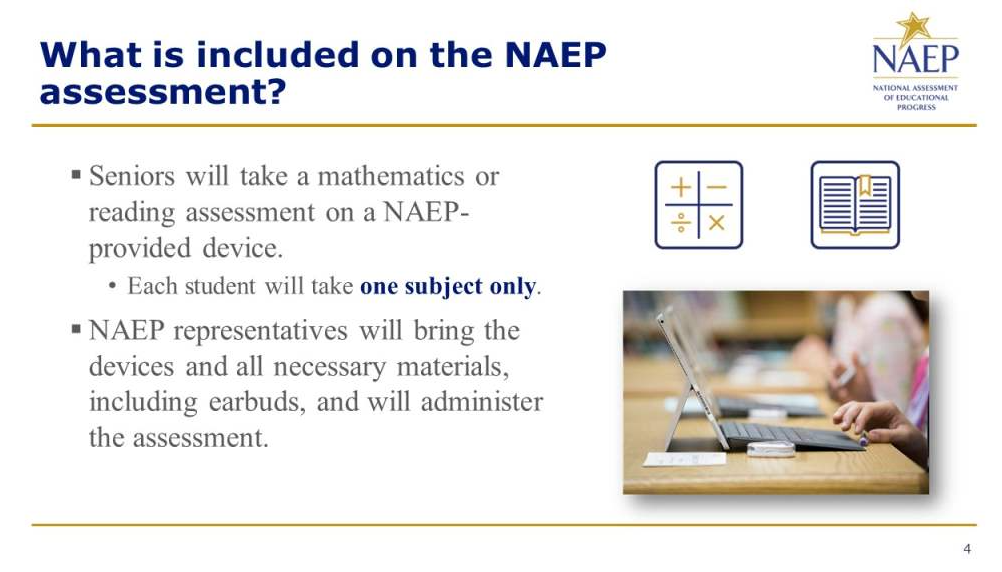
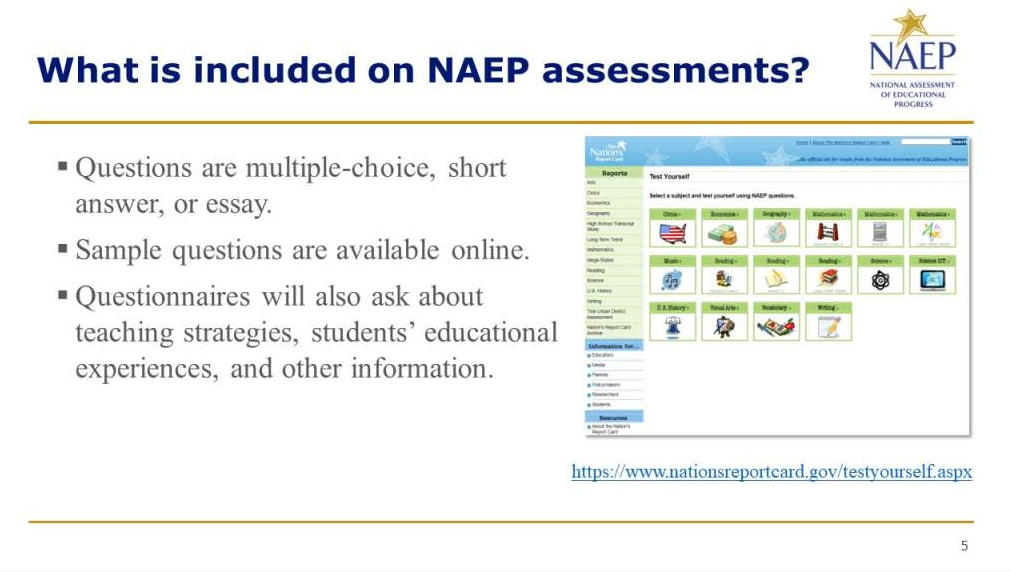
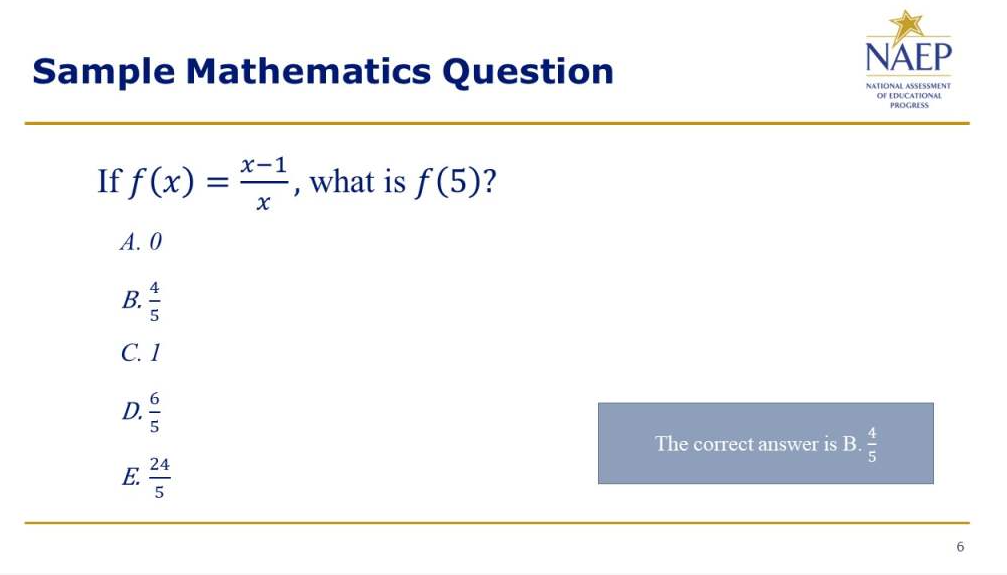
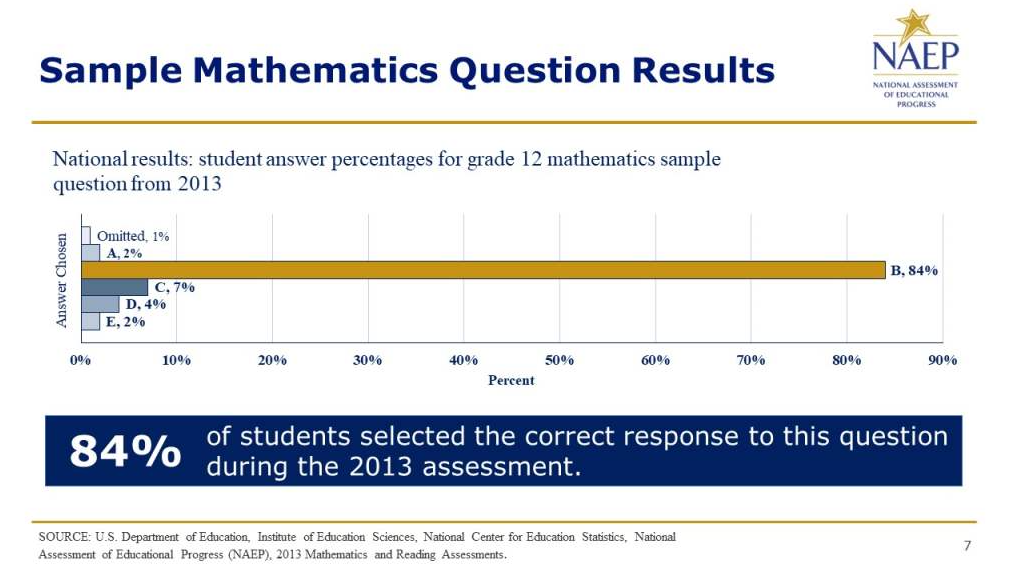
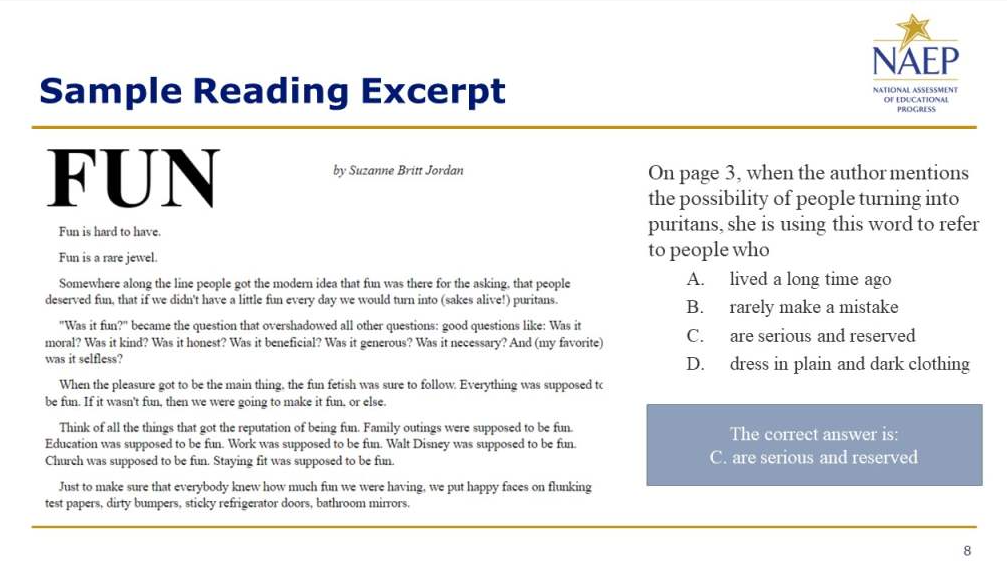
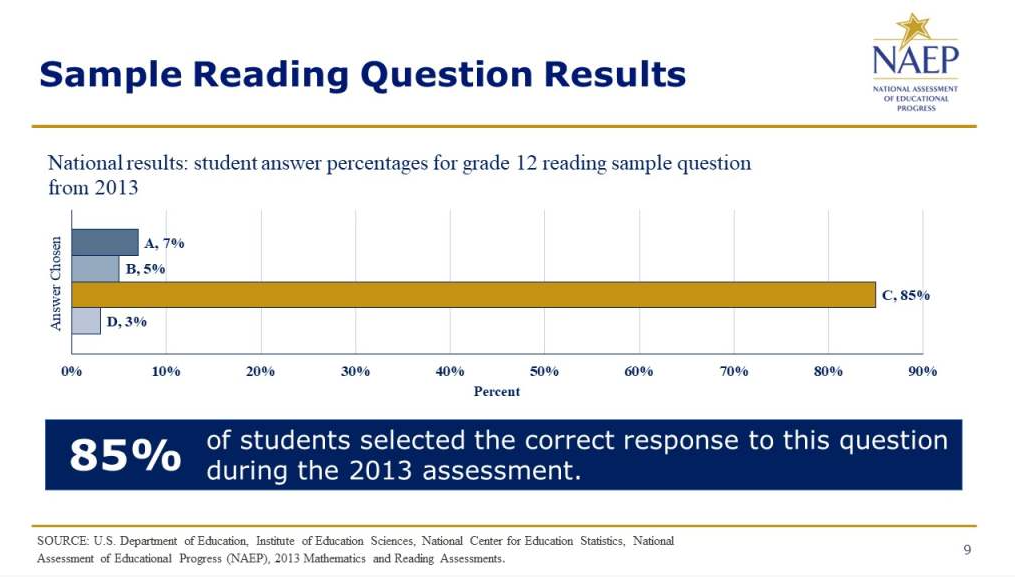
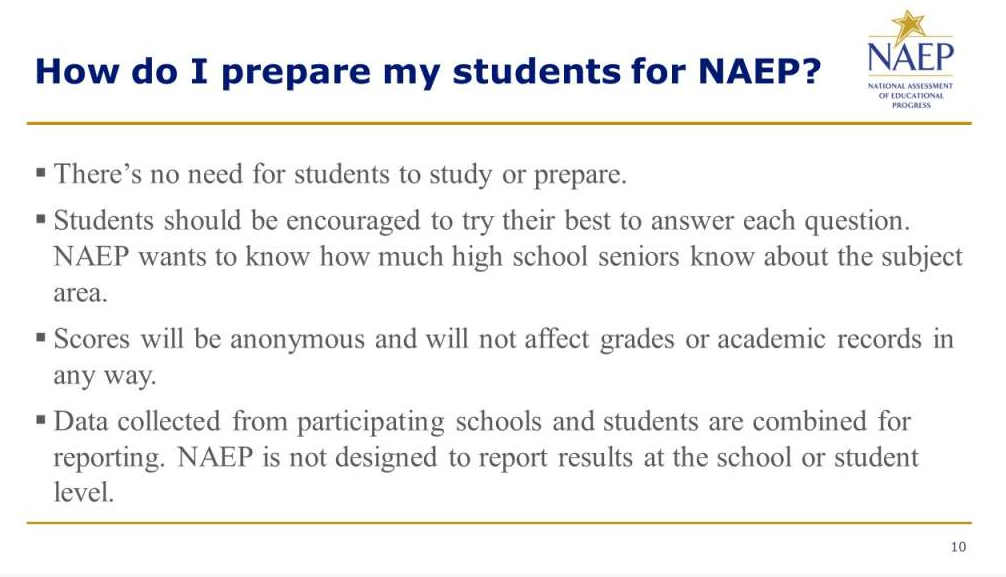
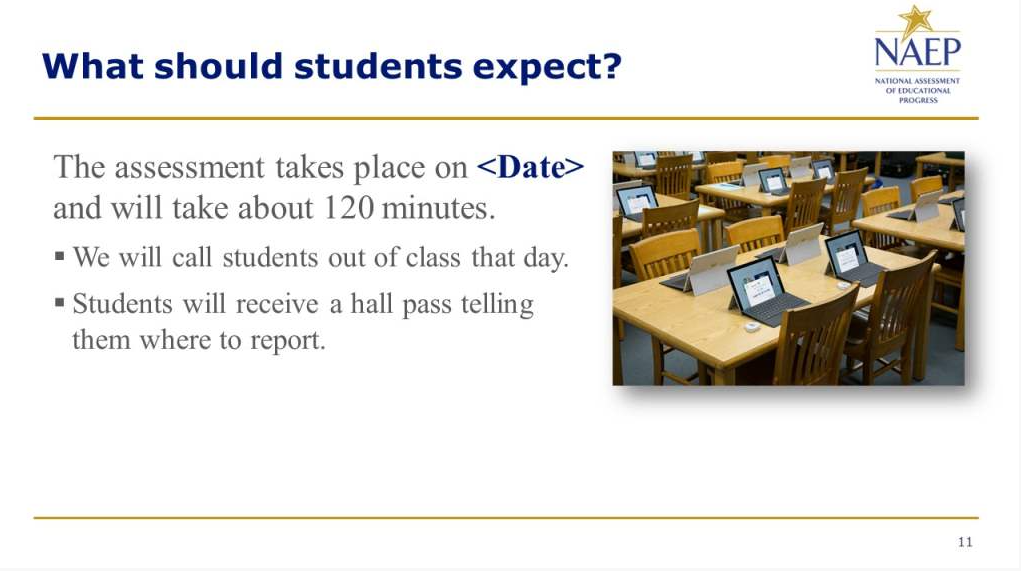

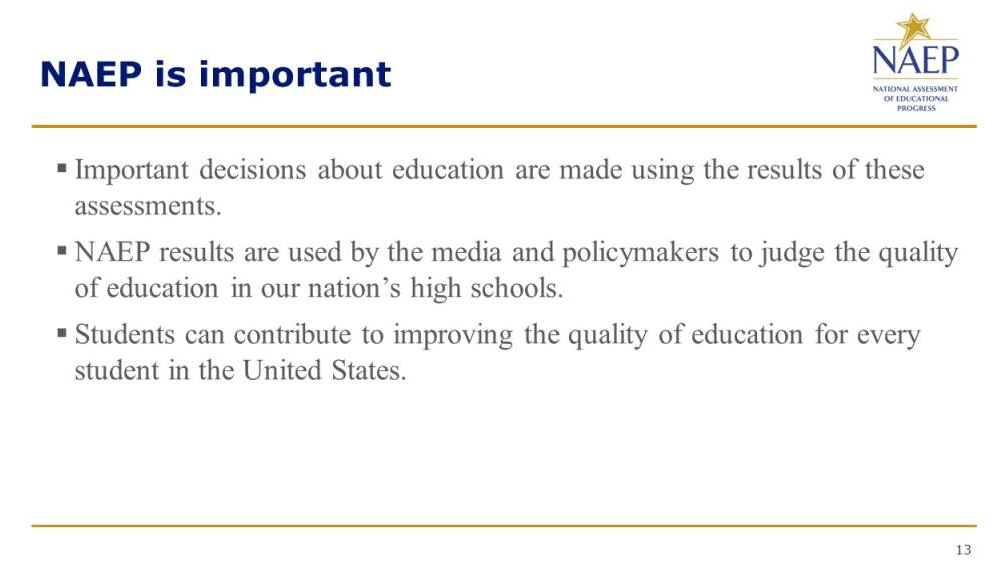
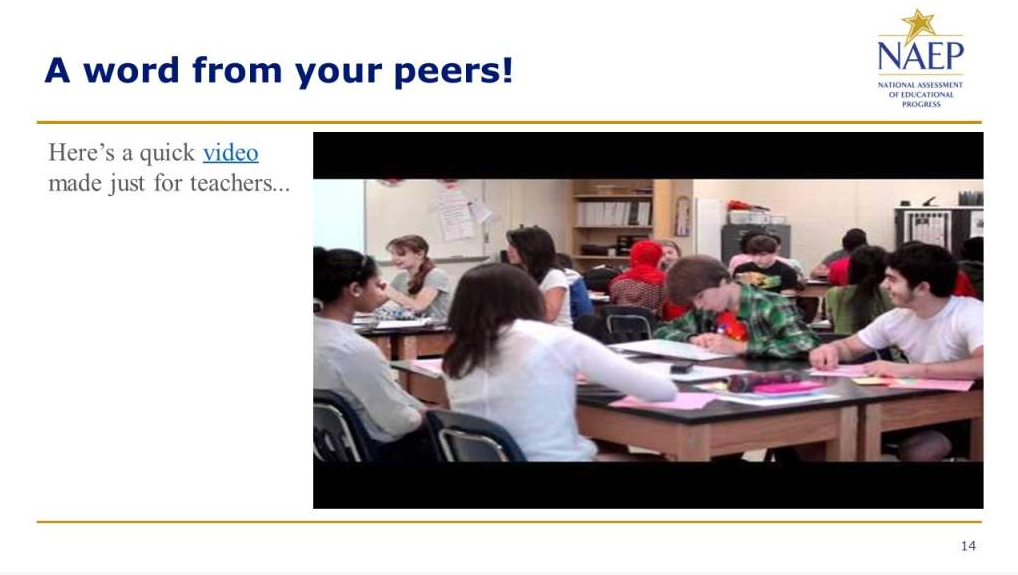
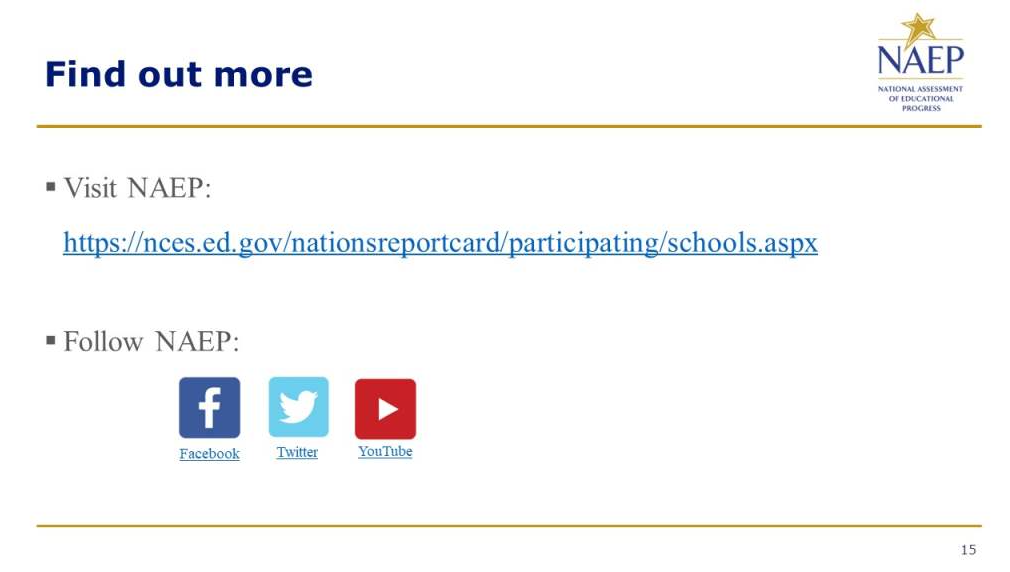
Appendix D-51h: Introducing NAEP to Parents (New)
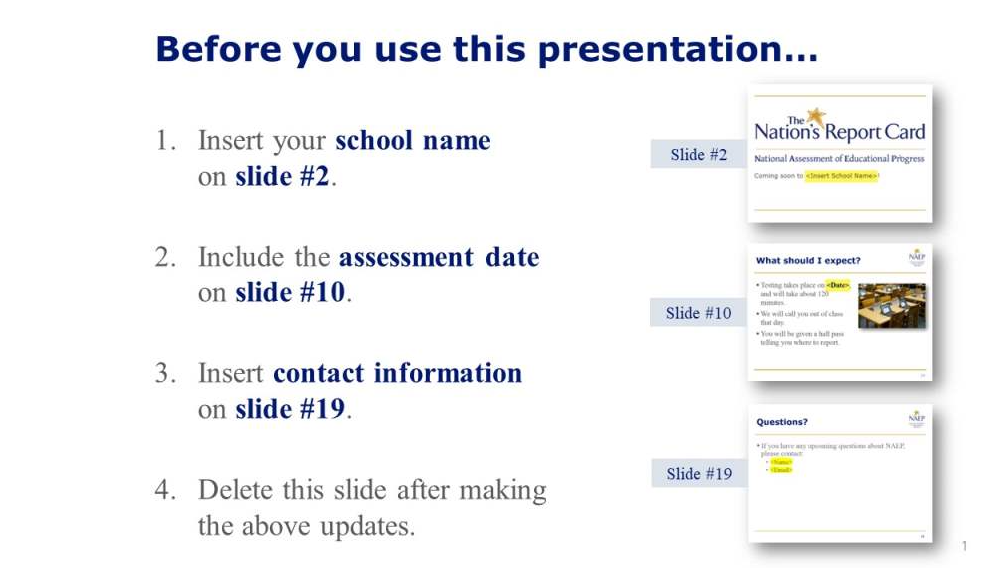
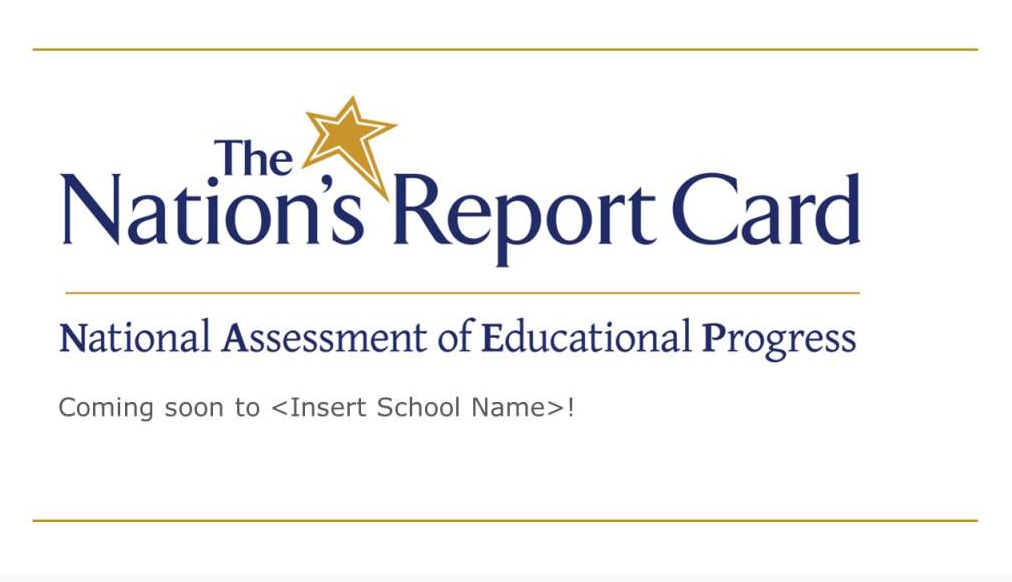
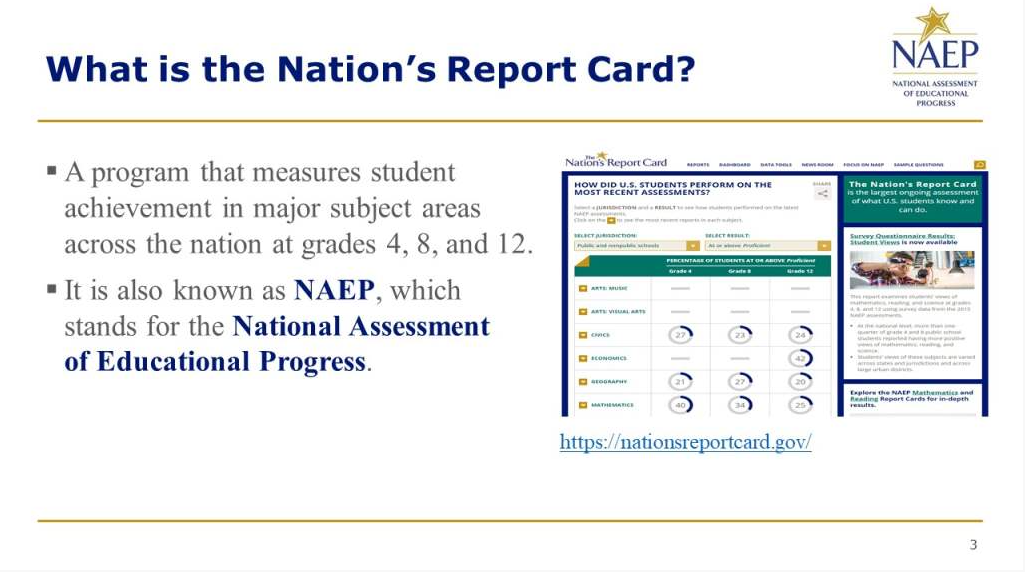
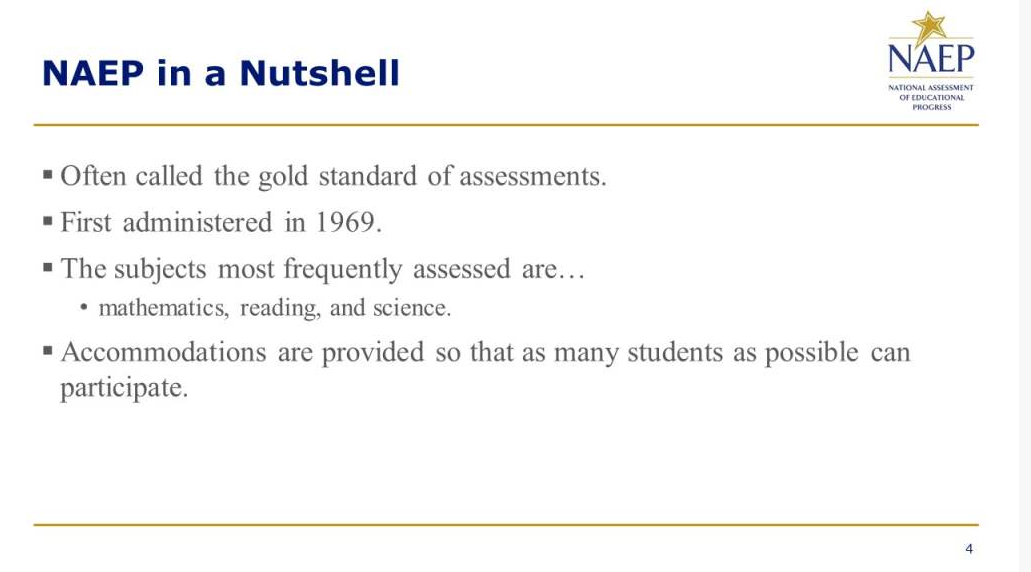
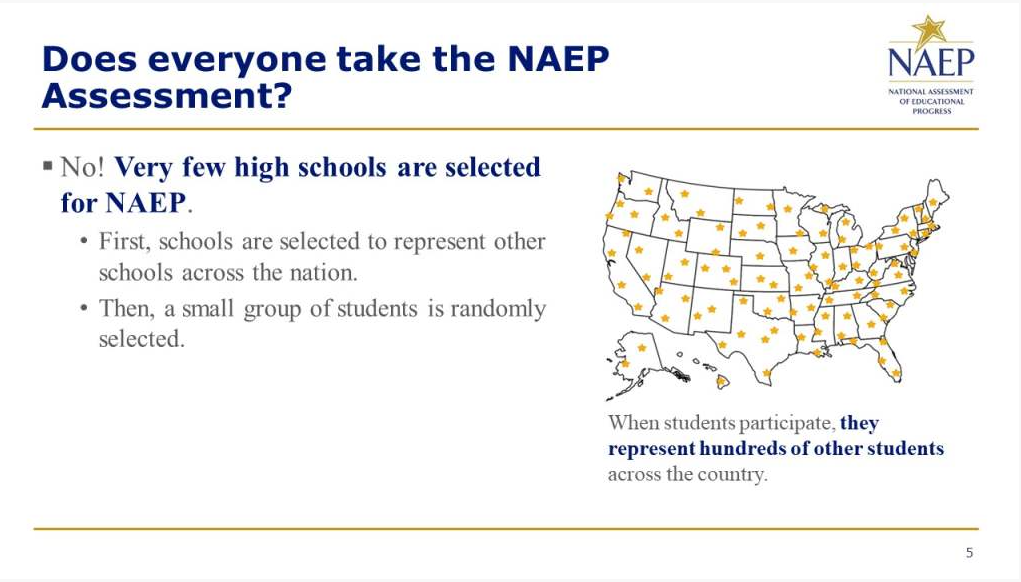
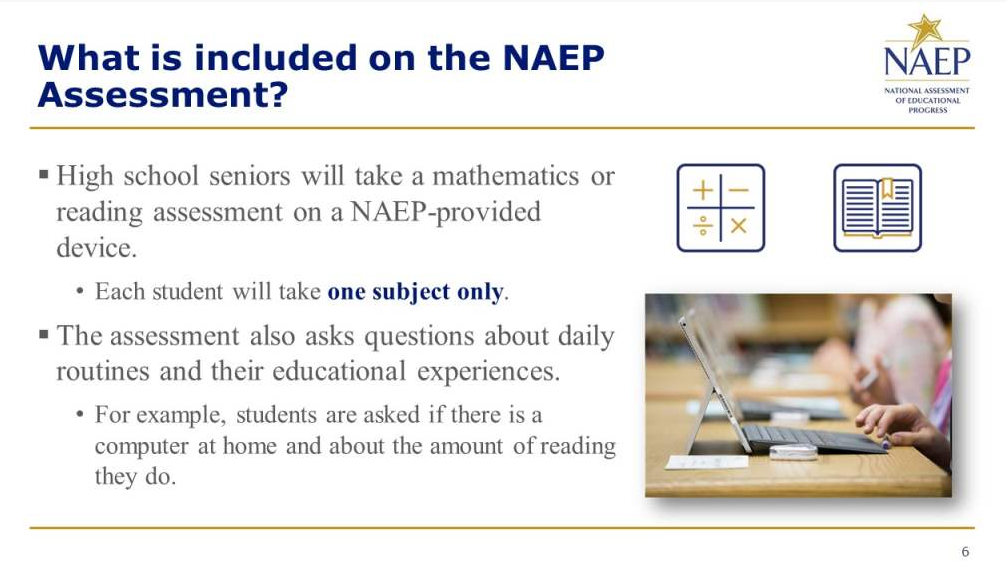
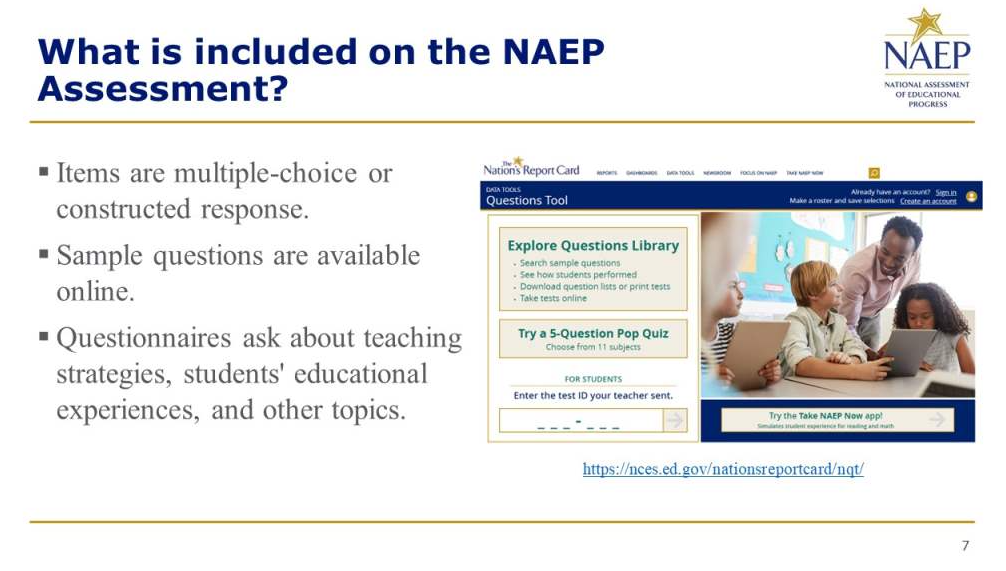
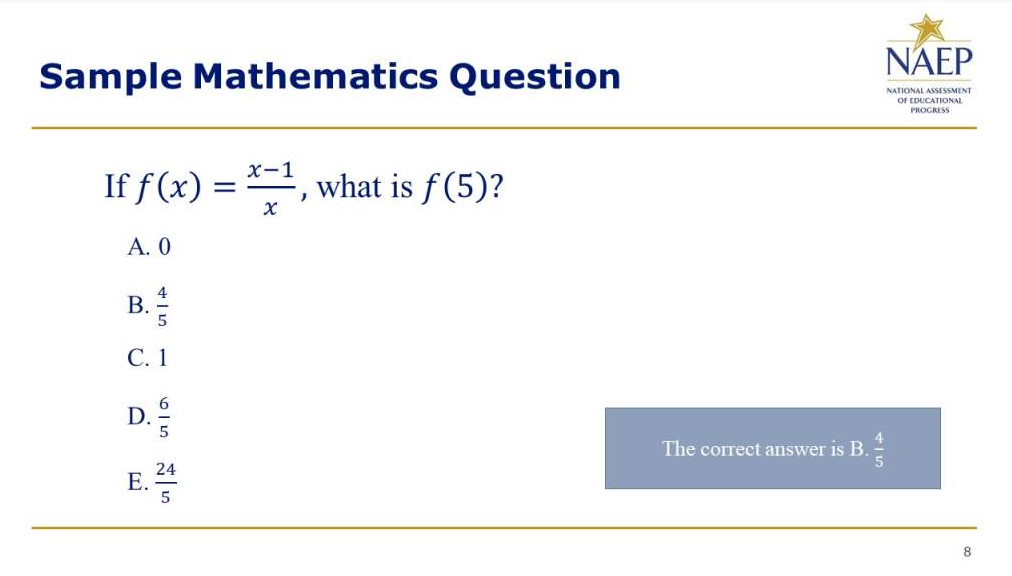
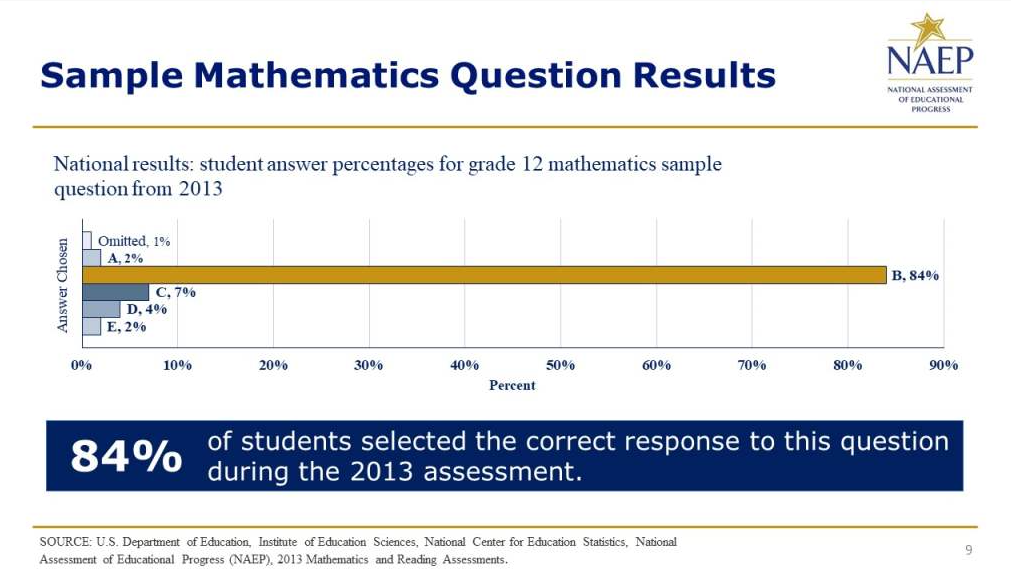
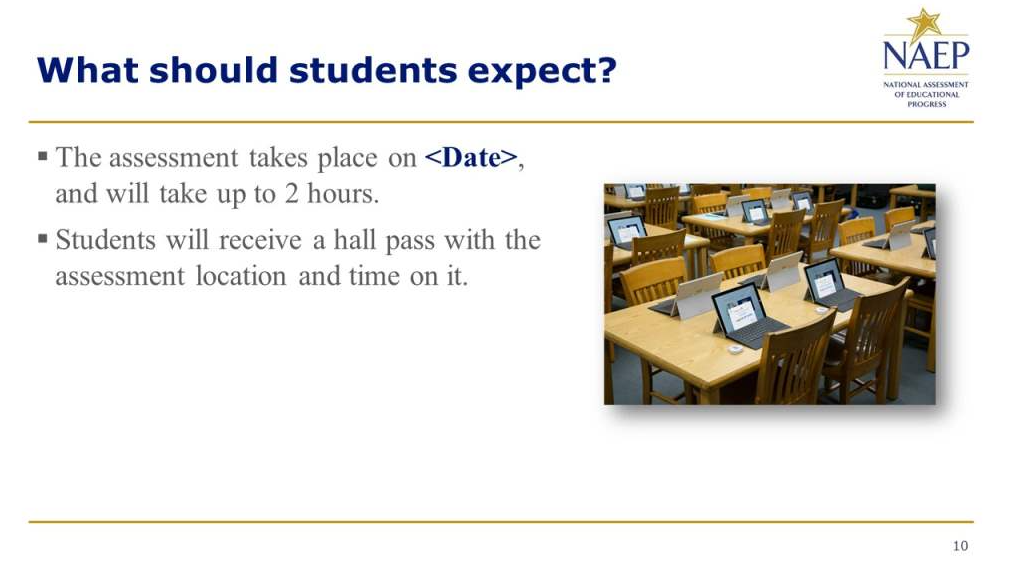

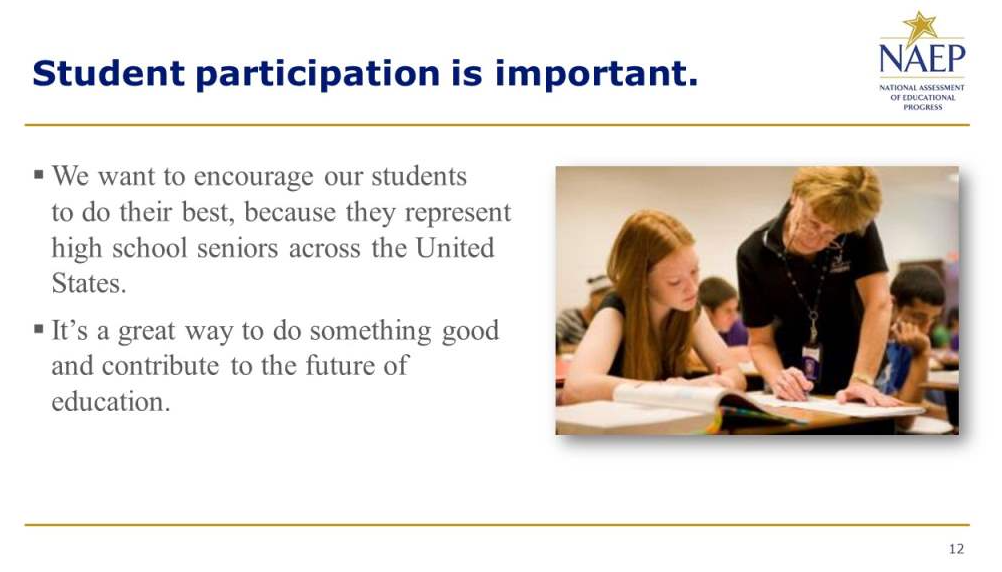
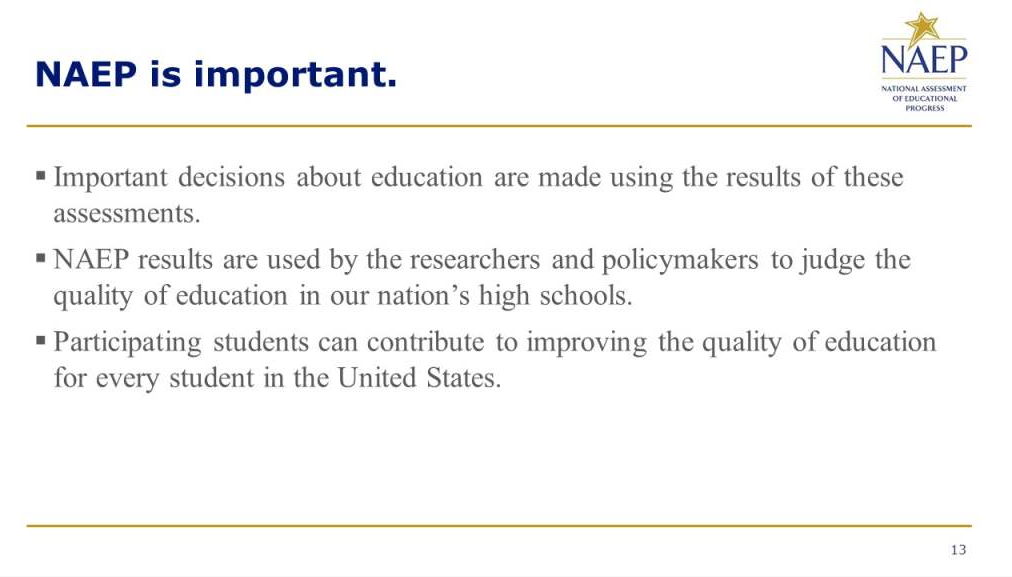
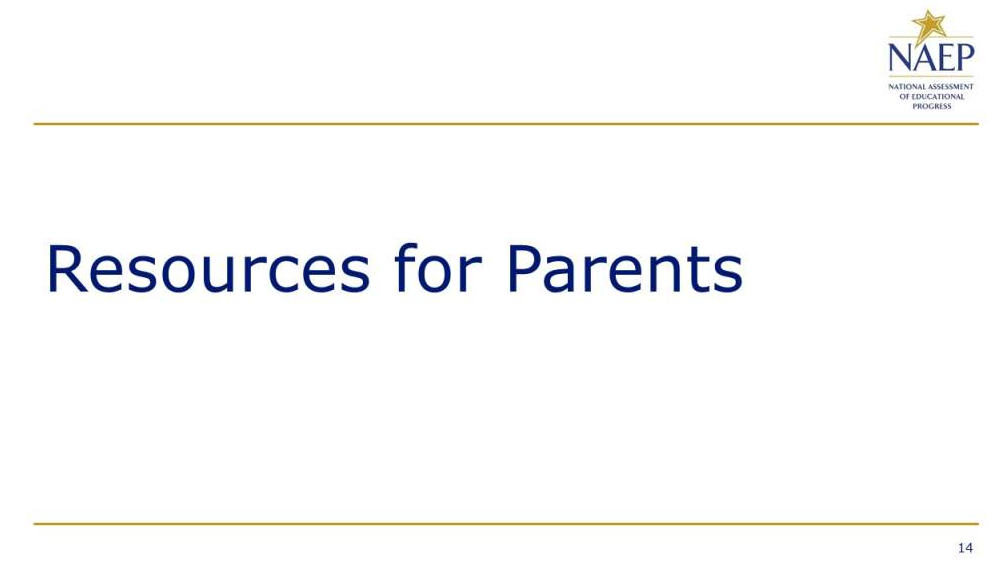
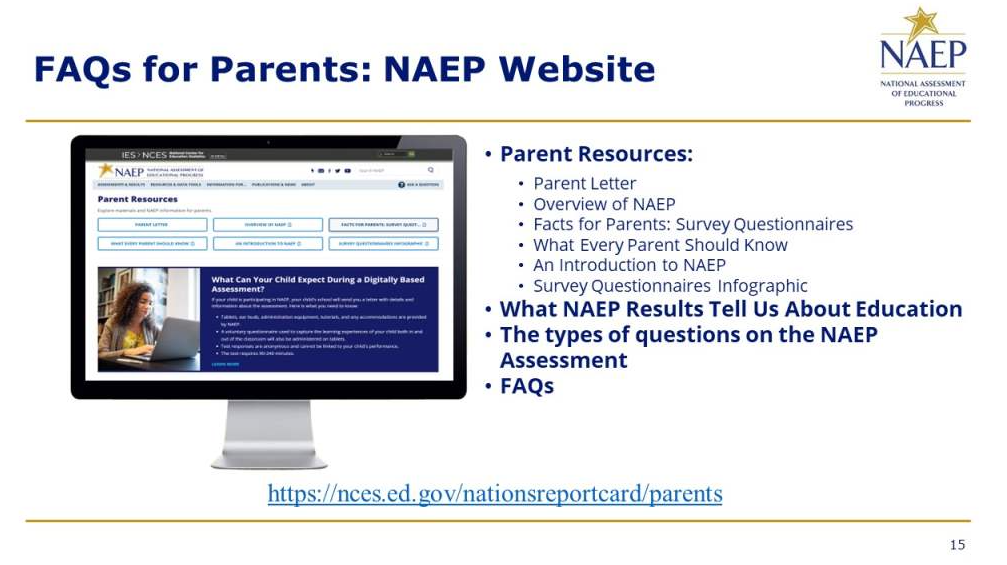
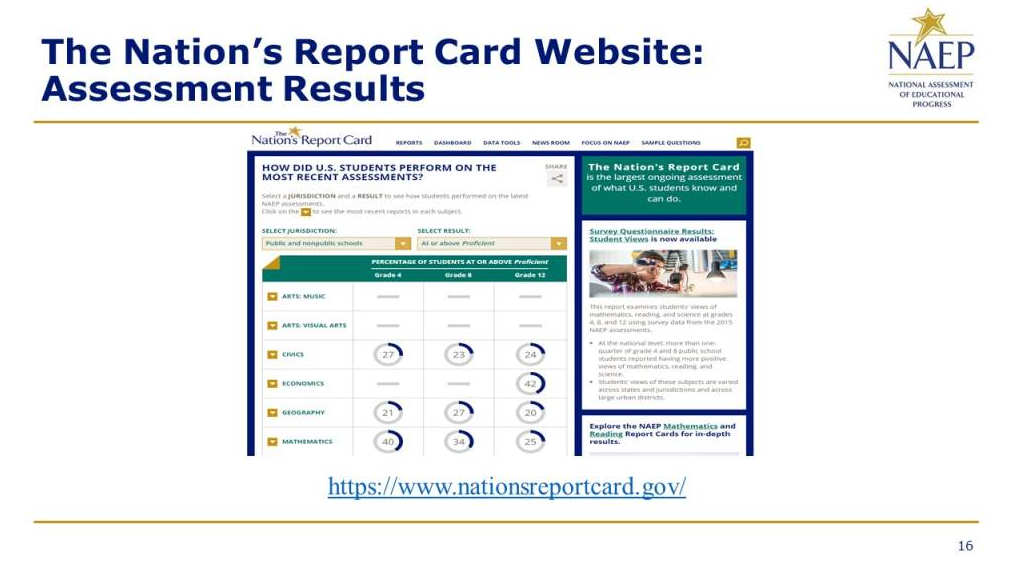
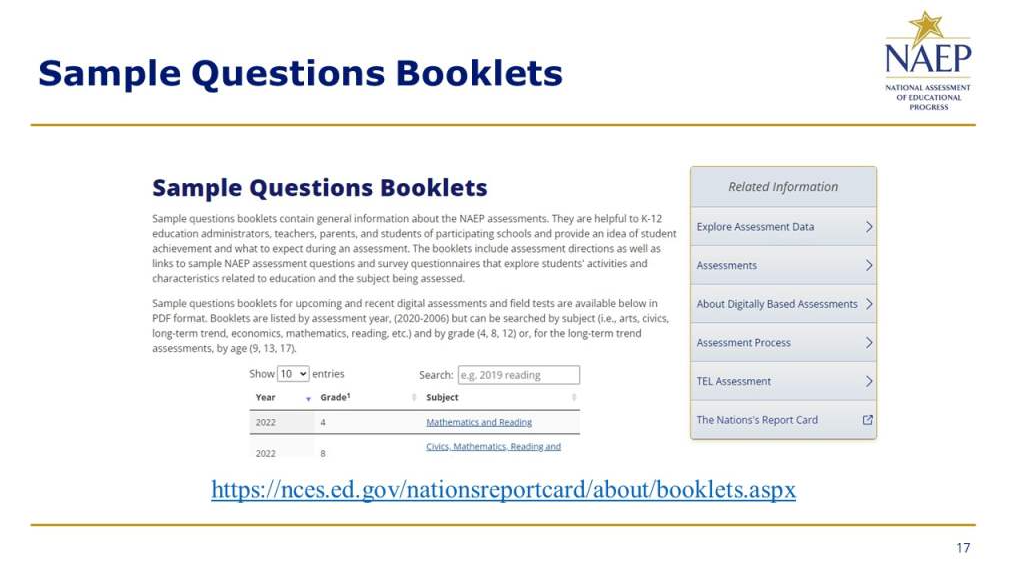
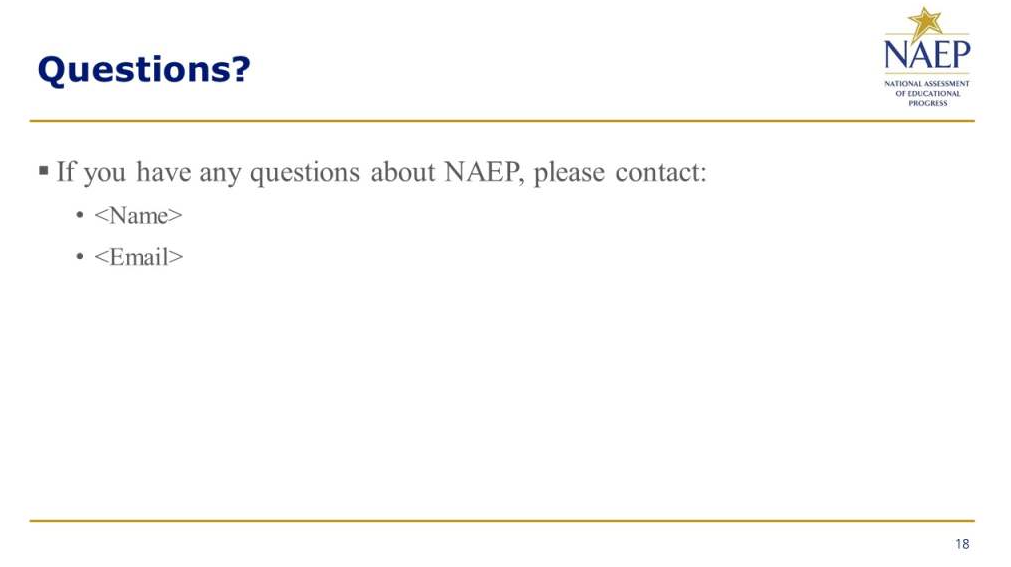
Appendix D-51i: NAEP High School Transcript Study (New)
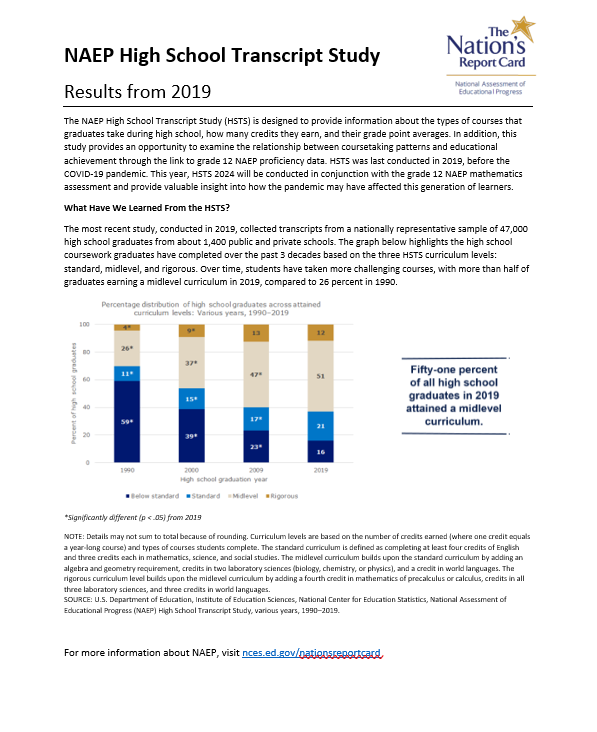
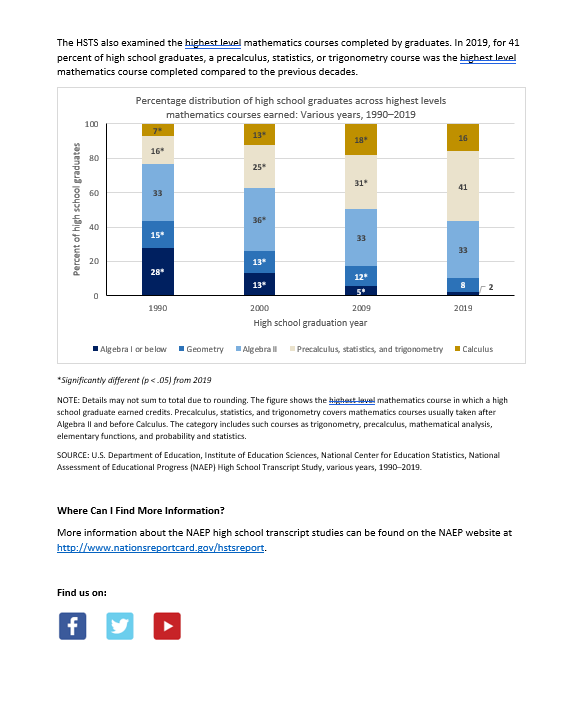
Appendix D-51j: NAEP Introducing NAEP to Students Slides (New)



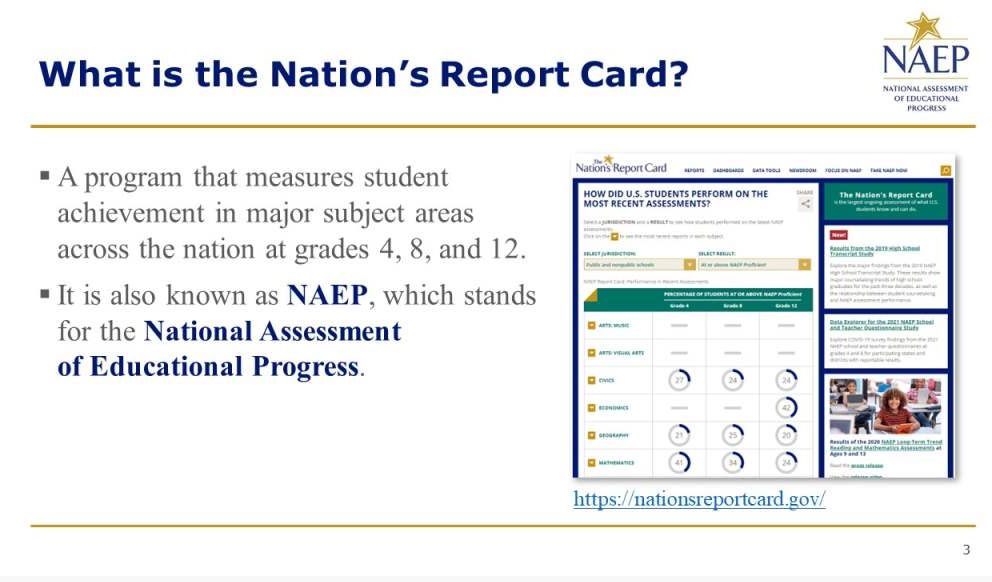












Appendix D-51k: NAEP Introducing NAEP to Parents Slides (New)


















Appendix D-51l: NAEP Introducing NAEP to Teachers Slides (New)















Appendix D-1-S-PR (Spanish version): NAEP 2024 Facts for Districts, Puerto Rico (Approved v.29)
2024 Información para los distritos
"NAEP es la única evaluación que proporciona medio siglo de datos de rendimiento para medir lo que los estudiantes saben y pueden hacer. Las tendencias estatales y nacionales orientan las discusiones de programas y políticas locales, estatales y nacionales que mejoran la enseñanza y el aprendizaje ".
- David Atherton, Doctor en educación, Clear Creek Middle School, Greshan, Oregón
¿Qué es NAEP?
La Evaluación Nacional del Progreso Educativo (NAEP, por sus siglas en inglés) es una medida integral del progreso educativo en toda la nación y a lo largo del tiempo. Es la evaluación continua y nacionalmente representativa más grande que mide lo que los estudiantes de nuestro país saben y pueden hacer en diferentes materias, tales como educación cívica, matemáticas, lectura e historia de Estados Unidos. El programa también proporciona información valiosa sobre las experiencias educativas de los estudiantes y las oportunidades de aprendizaje dentro y fuera del salón de clases.
NAEP es un proyecto autorizado por el Congreso y administrado por el Centro Nacional para Estadísticas de la Educación (NCES, por sus siglas en inglés), parte del Departamento de Educación de Estados Unidos y el Instituto de Ciencias de la Educación. NAEP requiere que Puerto Rico participe solo en la evaluación de matemáticas. El Departamento de Educación de los Estados Unidos eximió a Puerto Rico de participar en la evaluación de lectura, ya que esta mide la capacidad de un estudiante para leer inglés, sin embargo, el español es el idioma de enseñanza en Puerto Rico.
¿Cómo se informan los resultados de NAEP?
Los resultados de NAEP se publican en un informe llamado la Libreta de Calificaciones de la Nación. Los resultados de NAEP están disponibles a nivel nacional. Los resultados para los estados y determinados distritos urbanos que participan en la Evaluación Piloto de Distritos Urbanos (TUDA, por sus siglas en inglés) también pueden estar disponibles, dependiendo de la evaluación. Además, los resultados están disponibles para diferentes grupos de estudiantes con base en factores como la raza/grupo étnico, el género y la ubicación de la escuela, entre otros. NAEP no está diseñada para informar los resultados individuales de estudiantes, salones de clase o escuelas.
¿Por qué mi distrito debería participar en NAEP?
La participación de su distrito es de vital importancia por varios motivos.
Los resultados de las evaluaciones de 2024 proporcionarán información muy necesaria sobre los logros académicos y el sostenimiento de la recuperación de los estudiantes cuyas experiencias en la escuela elemental o intermedia se han visto marcadas por la pandemia de COVID-19.
Las escuelas y los estudiantes seleccionados para participar en NAEP representan a las escuelas y a los estudiantes de todo el país. Cuando los estudiantes participan y dan su mejor esfuerzo, los resultados de NAEP proporcionan la medida más precisa y representativa posible sobre el rendimiento y las experiencias de los estudiantes.
Las evaluaciones de 2024 ayudarán a NAEP a continuar examinando las transiciones a las evaluaciones en línea y el uso de dispositivos con los que los estudiantes estén más familiarizados. Estos cambios ayudarán a garantizar que el programa pueda medir de manera flexible, significativa y confiable las tendencias en los logros y experiencias de los estudiantes a lo largo del tiempo.
¿Qué evaluaciones de NAEP se administrarán en Puerto Rico en 2024?
El programa de 2024 incluirá:
una evaluación de matemáticas en 4.° y 8.° grado;
una prueba piloto de matemáticas en 4.° y 8.° grado, para ayudar a mejorar las futuras evaluaciones de NAEP y garantizar que sigan siendo una medida fiable de los logros de los estudiantes;
cuestionarios de contexto para estudiantes, maestros y directores participantes, con el fin de comprender mejor los factores que pueden estar relacionados con el aprendizaje de los estudiantes.
La evaluación se administrará entre el 29 de enero y el 8 de marzo de 2024.
Los resultados se publicarán a nivel nacional, estatal y para determinados distritos urbanos para las evaluaciones de matemáticas de 4.° y 8.° grado.
¿Qué harán los estudiantes en mi distrito?
Los estudiantes participantes completarán:
preguntas sobre matemáticas;
cuestionarios de contexto que proporcionan información valiosa sobre sus experiencias educativas y sus oportunidades de aprendizaje tanto dentro como fuera del salón de clases.
A los estudiantes les toma aproximadamente 2 horas completar la evaluación, incluyendo el tiempo de transición, las instrucciones y el tiempo que toma contestar el cuestionario de contexto. Se ofrece una amplia gama de acomodos para los estudiantes con impedimentos y para aprendices del español.
Algunos estudiantes serán evaluados en Surface Pros proporcionadas por NAEP y algunos estudiantes serán evaluados en Chromebooks proporcionados por NAEP, con el fin de orientar la transición del programa hacia el uso de dispositivos que sean más familiares para los estudiantes.
¿Es necesario que los maestros preparen a los estudiantes para la evaluación?
Los maestros no tienen que preparar a sus estudiantes para la evaluación, pero sí deben motivarlos a que hagan su mejor esfuerzo.
¿Quién administrará NAEP? ¿Qué deben proporcionar las escuelas el día de la evaluación?
El personal de NAEP administrará la evaluación y proporcionará un importante apoyo a su escuela el día de la evaluación. Ellos llevarán todos los materiales y equipos necesarios, incluidos las Surface Pros y los Chromebooks para evaluar a los estudiantes.
Las escuelas solo tendrán que proporcionar espacio para que los estudiantes tomen la evaluación, incluídos los pupitres o mesas, y un número adecuado de enchufes eléctricos en el lugar de la evaluación.
NAEP también solicitará usar el Internet de la escuela, siempre y cuando sea posible, ya que el programa continúa examinando la transición a las evaluaciones en línea. Los representantes de NAEP contactarán a su distrito en los próximos meses a fin de conocer más acerca de las capacidades de Internet en su escuela.
¿Cómo se seleccionaron las escuelas de mi distrito para NAEP?
Las escuelas fueron seleccionadas como parte de un proceso de muestreo cuidadosamente diseñado que garantiza que las escuelas y los estudiantes seleccionados para NAEP representan a su distrito, al estado y a la nación.
De conformidad con la Ley de Educación Primaria y Secundaria, los distritos y estados que reciben fondos del Título I están obligados a participar en estas evaluaciones bienales, con la excepción de Puerto Rico, que está exento de participar en la evaluación de lectura.
¿Cómo pueden los administradores escolares y los maestros utilizar los datos de NAEP para ayudar a nuestros estudiantes?
El explorador de datos, NAEP Data Explorer, (https://www.nationsreportcard.gov/ndecore) es una poderosa herramienta que le permite examinar las relaciones entre el rendimiento de los estudiantes y factores tales como las prácticas de enseñanza y los recursos escolares, entre otros.
Las preguntas de evaluaciones de NAEP anteriores también pueden utilizarse como un recurso educativo útil en el salón de clases. Los maestros pueden utilizar la herramienta NAEP Questions Tool (http://nces.ed.gov/nationsreportcard/nqt) para ver cómo se compara el rendimiento de sus estudiantes con el de otros estudiantes en su estado y en todo el país. Las preguntas de NAEP publicadas incluyen una guía de puntuación, ejemplos de respuestas de los estudiantes y datos de rendimiento.
¿Desde cuándo existe NAEP?
NAEP se administró por primera vez en 1969 para medir los logros de los estudiantes a nivel nacional. En 1990, NAEP se administró por primera vez a nivel estatal.
¿Dónde puedo encontrar más información?
Conozca más sobre el programa NAEP en nces.ed.gov/nationsreportcard/puertorico, y explore los últimos resultados de NAEP en nationsreportcard.gov.
Visite nces.ed.gov/nationsreportcard/about/covid19_spanish.aspx para obtener más información sobre los protocolos para el COVID-19 de NAEP.
También puede encontrar a NAEP en: <Facebook logo> <Twitter logo> <YouTube logo>
El Centro Nacional para Estadísticas de la Educación (NCES, por sus siglas en inglés) administra la Evaluación Nacional del Progreso Educativo para evaluar programas de educación apoyados por el Gobierno federal. Toda la información que proporcione podrá usarse únicamente con fines estadísticos y no podrá darse a conocer o usarse ni para identificarlo ni para cualquier otro propósito salvo aquel requerido legalmente (20 U.S.C. §9573 y 6 U.S.C. §151). Por ley, todos los empleados de NCES al igual que todos los representantes del mismo, como contratistas y coordinadores de NAEP, han hecho un juramento y están sujetos a una pena de prisión de hasta 5 años, una multa de hasta $250,000 o ambas cosas, si dan a conocer intencionalmente CUALQUIER información que lo identifique. El envío de su información por vía electrónica será monitoreado por empleados y contratistas federales para detectar virus, programas maliciosos (malware) y otras amenazas conforme a la Ley de Mejoramiento de la Seguridad Cibernética de 2015.
Appendix D-2-S-PR (Spanish version): NAEP 2024 Facts for Principals, Puerto Rico (Approved v.30)
NAEP 2024
Información general para los directores
4.° y 8.° grado Matemáticas
Page One Sidebar
NAEP es una parte esencial de la educación en Estados Unidos y Puerto Rico.
Los funcionarios electos, los legisladores y los educadores usan los resultados de NAEP para desarrollar maneras de mejorar la educación.
NAEP es un proyecto autorizado por el Congreso y administrado por el Centro Nacional para Estadísticas de la Educación (NCES, por sus siglas en inglés), parte del Departamento de Educación de Estados Unidos y el Instituto de Ciencias de la Educación.
NAEP desempeña un papel diferente al de las evaluaciones estatales. Si bien cada estado tiene su propia y única evaluación, con diferentes estándares de contenido, la misma evaluación NAEP se administra en cada estado, proporcionando una medida común de los logros de los estudiantes.
Dependiendo del tipo de evaluación NAEP que se administre, los datos se pueden usar para comparar y entender el rendimiento de grupos demográficos en su estado, en el país y en otros estados. NAEP no está diseñada para informar los resultados individuales de ningún estudiante, clase o escuela.
A los estudiantes, maestros y directores que participan en NAEP se les pide que completen cuestionarios que proporcionan una mayor comprensión de las experiencias educativas y de los factores que podrían estar relacionados con el aprendizaje estudiantil.
Page One Body
“NAEP es la única evaluación que proporciona medio siglo de datos de rendimiento para medir lo que los estudiantes saben y pueden hacer. Las tendencias estatales y nacionales orientan las discusiones de programas y políticas locales, estatales y nacionales que mejoran la enseñanza y el aprendizaje ".
David Atherton, Doctor en educación, Clear Creek Middle School, Greshan, Oregón
Visite https://nces.ed.gov/nationsreportcard/about/covid19.aspx para más información sobre los protocolos de NAEP relacionados con la salud y la seguridad.
¿Qué es NAEP?
La Evaluación Nacional del Progreso Educativo (NAEP, por sus siglas en inglés) es la evaluación continua y nacionalmente representativa más grande que mide lo que los estudiantes de nuestro país saben y pueden hacer en diferentes materias, tales como educación cívica, matemáticas, lectura, ciencias e historia de Estados Unidos. Los resultados de NAEP se publican en un informe llamado la Libreta de Calificaciones de la Nación. NAEP requiere que Puerto Rico participe solo en la evaluación de matemáticas. El Departamento de Educación de Estados Unidos eximió a Puerto Rico de participar en la evaluación de lectura, ya que esta mide la capacidad de un estudiante para leer inglés, sin embargo, el español es el idioma de instrucción en Puerto Rico.
¿Qué pueden esperar los directores y las escuelas?
Los representantes de NAEP le proporcionarán bastante apoyo a su escuela el día de la evaluación. Como directores, ustedes hacen una contribución importante al programa al seleccionar y facultar al coordinador escolar de NAEP, al reunirse con los maestros y estudiantes participantes y al animar a sus estudiantes a participar y a que hagan su mejor esfuerzo. Ustedes son aliados fundamentales para NAEP. Cuando los estudiantes participan en la evaluación y hacen su mejor esfuerzo, los resultados de NAEP proporcionan la medición más exacta posible del rendimiento estudiantil en todo el país.
En el 2024, la evaluación de matemáticas de NAEP se administrará en dispositivos a los estudiantes de 4.° y 8.° grado. Los resultados se publicarán a nivel nacional, estatal y distrital.
Además de responder a las preguntas sobre la materia, los estudiantes completarán un cuestionario de contexto de NAEP que proporciona información valiosa sobre las experiencias educativas de los estudiantes y las oportunidades de aprendizaje dentro y fuera del salón de clase.
El día de la evaluación, los representantes de NAEP llevarán a las escuelas todos los materiales y equipos necesarios, incluyendo las Surface Pros y los Chromebooks proporcionados por NAEP, desinfectados. Las escuelas únicamente tendrán que proporcionar espacio para que los estudiantes tomen la evaluación, pupitres o mesas, y una cantidad adecuada de enchufes eléctricos en el lugar de la evaluación.
En el 2024, NAEP continuará examinando las transiciones a las evaluaciones en línea y el uso de dispositivos con los que los estudiantes estén más familiarizados. Estos cambios ayudarán a garantizar que el programa pueda medir de manera flexible, significativa y confiable las tendencias en los logros y experiencias de los estudiantes a lo largo del tiempo.
Como parte de estos cambios, los representantes de NAEP utilizarán el Internet en la escuela, siempre y cuando sea posible, para realizar la evaluación. El programa trabajará con usted o su distrito para determinar si esto es posible en su escuela.
Para más información acerca de NAEP, visite www.nces.ed.gov/nationsreportcard/puertorico/.
Page Two Body
NAEP se administró por primera vez en 1969 para medir el rendimiento estudiantil a nivel nacional. En 1990, NAEP se administró a nivel estatal por primera vez. Actualmente se evalúa a los estudiantes de 4.° y 8.° grado a nivel nacional y estatal en matemáticas y lectura cada 2 años y en otras materias de manera periódica.
¿Por qué se le considera a NAEP el estándar de oro? Desde el desarrollo de los marcos teóricos y las preguntas de la evaluación hasta la publicación de los resultados, NAEP ofrece una alta calidad técnica y representa las mejores ideas de especialistas de evaluación y de contenido, del personal estatal de educación y de maestros de todo el país. NAEP es un recurso confiable que mide el progreso estudiantil y que contribuye a informar la toma de decisiones sobre políticas que mejoren la educación de Estados Unidos y Puerto Rico.
¿Cómo se informan los resultados de NAEP? NAEP informa los resultados de distintos grupos demográficos en vez de los resultados individuales de estudiantes o escuelas. En una escuela, solamente algunos de los estudiantes participan y las respuestas de los estudiantes se combinan con las de otros estudiantes participantes para producir los resultados.
¿Cómo se seleccionan las escuelas y los estudiantes para NAEP? Un proceso de muestreo cuidadosamente diseñado garantiza que las escuelas y los estudiantes seleccionados para NAEP representan a todas las escuelas y estudiantes en Estados Unidos y Puerto Rico. Para asegurar que la muestra represente a todos los estudiantes en las escuelas del país, NAEP permite una gran variedad de acomodos para estudiantes con impedimentos y estudiantes con limitaciones lingüísticas en español.
¿Qué pueden esperar los maestros y estudiantes? Incluyendo el tiempo de transición, las instrucciones y tutoriales y el contestar un cuestionario de contexto, a los estudiantes les toma aproximadamente 2 horas completar la evaluación. Los maestros no tienen que preparar a sus estudiantes para que tomen la evaluación, pero sí deben motivarlos a que hagan su mejor esfuerzo. Los representantes de NAEP le brindan un gran apoyo a su escuela al trabajar con el coordinador escolar designado para organizar las actividades de la evaluación.
Visite la página web de NAEP en http://nces.ed.gov/nationsreportcard/puertorico/ para ver esta y más información.
El Centro Nacional para Estadísticas de la Educación (NCES, por sus siglas en inglés) está autorizado por la Ley de Autorización para la Evaluación Nacional del Progreso Educativo (20 U.S.C.§9622) para administrar NAEP y para recopilar los expedientes educativos de los estudiantes de agencias o instituciones educativas con el propósito de evaluar programas de educación apoyados por el Gobierno federal conforme a la Ley de Derechos Educativos y Privacidad Familiar (FERPA, por sus siglas en inglés; 34 CFR §§ 99.31(a)(3)(iii) y 99.35). Toda la información que proporcionen los participantes podrá usarse únicamente con fines estadísticos y no podrá darse a conocer o usarse ni para identificarlos ni para cualquier otro propósito salvo aquel requerido legalmente (20 U.S.C. §9573 and 6 U.S.C. §151). Por ley, todos los empleados de NCES al igual que todo representante del mismo, como contratistas y coordinadores de NAEP, han hecho un juramento y están sujetos a una pena de prisión de hasta 5 años, una multa de hasta $250,000 dólares o ambas cosas, si dan a conocer intencionadamente CUALQUIER información de identificación de los participantes. El envío de información de los participantes por vía electrónica será monitoreado por empleados y contratistas federales para detectar virus, programas maliciosos (malware) y otras amenazas conforme a la Ley de Mejoramiento de la Seguridad Cibernética de 2015. La información recolectada se combinará para elaborar informes estadísticos.
Page Two Footer
Encuéntrenos en: [insert social media icons]
Esta publicación fue preparada para la Evaluación Nacional del Progreso Educativo por Hager Sharp bajo el contrato GS-23F-0024M para el Centro Nacional de Estadísticas de la Educación, Departamento de Educación de Estados Unidos.
NAEP 2024
Información general para los directores
Prueba piloto: 4.° y 8.° grado Matemáticas
Page One Sidebar
NAEP es una parte esencial de la educación en Estados Unidos y Puerto Rico.
Los funcionarios electos, los legisladores y los educadores usan los resultados de NAEP para desarrollar maneras de mejorar la educación.
NAEP es un proyecto autorizado por el Congreso y administrado por el Centro Nacional para Estadísticas de la Educación (NCES, por sus siglas en inglés), parte del Departamento de Educación de Estados Unidos y el Instituto de Ciencias de la Educación.
NAEP desempeña un papel diferente al de las evaluaciones estatales. Si bien cada estado tiene su propia y única evaluación, con diferentes estándares de contenido, la misma evaluación NAEP se administra en cada estado, proporcionando una medida común de los logros de los estudiantes.
Dependiendo del tipo de evaluación NAEP que se administre, los datos se pueden usar para comparar y entender el rendimiento de grupos demográficos en su estado, en el país, y en otros estados. NAEP no está diseñada para informar los resultados individuales de ningún estudiante, clase o escuela.
A los estudiantes, maestros y directores que participan en NAEP se les pide que completen cuestionarios que proporcionan una mayor comprensión de las experiencias educativas y de los factores que podrían estar relacionados con el aprendizaje estudiantil.
Page One Body
“NAEP es la única evaluación que proporciona medio siglo de datos de rendimiento para medir lo que los estudiantes saben y pueden hacer. Las tendencias estatales y nacionales orientan las discusiones de programas y políticas locales, estatales y nacionales que mejoran la enseñanza y el aprendizaje ".
David Atherton, Doctor en educación, Clear Creek Middle School, Greshan, Oregón
Visite https://nces.ed.gov/nationsreportcard/about/covid19.aspx para más información sobre los protocolos de NAEP relacionados con la salud y la seguridad.
¿Qué es NAEP?
La Evaluación Nacional del Progreso Educativo (NAEP, por sus siglas en inglés) es la evaluación continua y nacionalmente representativa más grande que mide lo que los estudiantes de nuestro país saben y pueden hacer en diferentes materias, tales como educación cívica, matemáticas, lectura, ciencias e historia de Estados Unidos. Los resultados de NAEP se publican en un informe llamado la Libreta de Calificaciones de la Nación. NAEP requiere que Puerto Rico participe solo en la evaluación de matemáticas. El Departamento de Educación de Estados Unidos eximió a Puerto Rico de participar en la evaluación de lectura, ya que esta mide la capacidad de un estudiante para leer inglés, sin embargo, el español es el idioma de instrucción en Puerto Rico.
¿Qué pueden esperar los directores y las escuelas?
Los representantes de NAEP le proporcionarán bastante apoyo a su escuela el día de la evaluación. Como directores, ustedes hacen una contribución importante al programa al seleccionar y facultar al coordinador escolar de NAEP, al reunirse con los maestros y estudiantes participantes y al animar a sus estudiantes a participar y a que hagan su mejor esfuerzo. Ustedes son aliados fundamentales para NAEP. Cuando los estudiantes participan en la evaluación y hacen su mejor esfuerzo, los resultados de NAEP proporcionan la medición más exacta posible del rendimiento estudiantil en todo el país.
En el 2024, la evaluación de matemáticas de NAEP se administrará en dispositivos a los estudiantes de 4.° y 8.° grado. Los resultados de la prueba piloto no se darán a conocer públicamente, pero se utilizarán para orientar las futuras evaluaciones de NAEP.
Además de responder a las preguntas sobre la materia, los estudiantes completarán un cuestionario de contexto de NAEP que proporciona información valiosa sobre las experiencias educativas de los estudiantes y las oportunidades de aprendizaje dentro y fuera del salón de clase.
El día de la evaluación los representantes de NAEP llevarán a las escuelas todos los materiales y equipos necesarios, incluyendo las Surface Pros y los Chromebooks proporcionados por NAEP, desinfectados. Las escuelas únicamente tendrán que proporcionar espacio para que los estudiantes tomen la evaluación, pupitres o mesas, y una cantidad adecuada de enchufes eléctricos en el lugar de la evaluación.
En el 2024, NAEP continuará examinando las transiciones a las evaluaciones en línea y el uso de dispositivos con los que los estudiantes estén más familiarizados. Estos cambios ayudarán a garantizar que el programa pueda medir de manera flexible, significativa y confiable las tendencias en los logros y experiencias de los estudiantes a lo largo del tiempo.
Como parte de estos cambios, los representantes de NAEP utilizarán el Internet en la escuela, siempre y cuando sea posible, para realizar la evaluación. El programa trabajará con usted o su distrito para determinar si esto es posible en su escuela.
Para más información acerca de NAEP, visite www.nces.ed.gov/nationsreportcard/puertorico/.
Page Two Body
NAEP se administró por primera vez en 1969 para medir el rendimiento estudiantil a nivel nacional. En 1990, NAEP se administró a nivel estatal por primera vez. Actualmente se evalúa a los estudiantes de 4.° y 8.° grado a nivel nacional y estatal en matemáticas y lectura cada 2 años, y en otras materias de manera periódica.
¿Por qué se le considera a NAEP el estándar de oro? Desde el desarrollo de los marcos teóricos y las preguntas de la evaluación hasta la publicación de los resultados, NAEP ofrece una alta calidad técnica y representa las mejores ideas de especialistas de evaluación y de contenido, del personal estatal de educación y de maestros de todo el país. NAEP es un recurso confiable que mide el progreso estudiantil y que contribuye a informar la toma de decisiones sobre políticas que mejoren la educación de Estados Unidos y Puerto Rico.
¿Cómo se informan los resultados de NAEP? NAEP informa los resultados de distintos grupos demográficos en vez de los resultados individuales de estudiantes o escuelas. En una escuela, solamente algunos de los estudiantes participan y las respuestas de los estudiantes se combinan con las de otros estudiantes participantes para producir los resultados.
¿Cómo se seleccionan las escuelas y los estudiantes para NAEP? Un proceso de muestreo cuidadosamente diseñado garantiza que las escuelas y los estudiantes seleccionados para NAEP representan a todas las escuelas y estudiantes en Estados Unidos y Puerto Rico. Para asegurar que la muestra represente a todos los estudiantes en las escuelas del país, NAEP permite una gran variedad de acomodos para estudiantes con impedimentos y estudiantes con limitaciones lingüísticas en español.
¿Qué pueden esperar los maestros y estudiantes? Incluyendo el tiempo de transición, las instrucciones y tutoriales y el contestar un cuestionario de contexto, a los estudiantes les toma aproximadamente 2 horas completar la evaluación. Los maestros no tienen que preparar a sus estudiantes para que tomen la evaluación, pero sí deben motivarlos a que hagan su mejor esfuerzo. Los representantes de NAEP le brindan un gran apoyo a su escuela al trabajar con el coordinador escolar designado para organizar las actividades de la evaluación.
Visite la página web de NAEP en http://nces.ed.gov/nationsreportcard/puertorico/ para ver esta y más información.
El Centro Nacional para Estadísticas de la Educación (NCES, por sus siglas en inglés) está autorizado por la Ley de Autorización para la Evaluación Nacional del Progreso Educativo (20 U.S.C.§9622) para administrar NAEP y para recopilar los expedientes educativos de los estudiantes de agencias o instituciones educativas con el propósito de evaluar programas de educación apoyados por el Gobierno federal conforme a la Ley de Derechos Educativos y Privacidad Familiar (FERPA, por sus siglas en inglés; 34 CFR §§ 99.31(a)(3)(iii) y 99.35). Toda la información que proporcionen los participantes podrá usarse únicamente con fines estadísticos y no podrá darse a conocer o usarse ni para identificarlos ni para cualquier otro propósito salvo aquel requerido legalmente (20 U.S.C. §9573 and 6 U.S.C. §151). Por ley, todos los empleados de NCES al igual que todo representante del mismo, como contratistas y coordinadores de NAEP, han hecho un juramento y están sujetos a una pena de prisión de hasta 5 años, una multa de hasta $250,000 dólares o ambas cosas, si dan a conocer intencionadamente CUALQUIER información de identificación de los participantes. El envío de información de los participantes por vía electrónica será monitoreado por empleados y contratistas federales para detectar virus, programas maliciosos (malware) y otras amenazas conforme a la Ley de Mejoramiento de la Seguridad Cibernética de 2015. La información recolectada se combinará para elaborar informes estadísticos.
Page Two Footer
Encuéntrenos en: [insert social media icons]
Esta publicación fue preparada para la Evaluación Nacional del Progreso Educativo por Hager Sharp bajo el contrato GS-23F-0024M para el Centro Nacional de Estadísticas de la Educación, Departamento de Educación de Estados Unidos.
Appendix D-3-S-PR (Spanish version): NAEP 2024 Notification Letter from Chief State School Officer to District Superintendent, Puerto Rico (Approved v.29)
Carta de notificación de mayo sobre NAEP de 2024 en Puerto Rico del
SECRETARIO DE EDUCACIÓN AL SUPERINTENDENTE DISTRITAL
Se debe personalizar el texto en rojo antes de combinar la correspondencia: El texto resaltado representa los campos que se deben combinar
Estimado(a) nombre del superintendente distrital,
Gracias por todo lo que hace para apoyar la educación en Puerto Rico. Le escribo para informarle que cantidad escuelas en su distrito han sido seleccionadas para participar en la administración de la Evaluación Nacional del Progreso Educativo (NAEP, por sus siglas en inglés) de 2023. NAEP es la evaluación continua y nacionalmente representativa más grande acerca de lo que los estudiantes en Estados Unidos y Puerto Rico saben y pueden hacer en diferentes materias. NAEP es administrada por el Centro Nacional de Estadísticas de la Educación (NCES, por sus siglas en inglés) que forma parte del Departamento de Educación de Estados Unidos. Las escuelas seleccionadas representan a escuelas en el país y su participación proporciona una idea precisa del rendimiento de los estudiantes. Distrito escolar desempeñará un papel importante al participar y espero que podamos contar con todo su apoyo para hacer que esta sea una experiencia positiva para sus escuelas y estudiantes.
Visión general del programa de NAEP de 2024
La administración de NAEP de 2024 evaluará a los estudiantes entre el 29 de enero y el 8 de marzo de 2024. La lista adjunta de escuelas de su distrito seleccionadas para NAEP muestra el programa de evaluación para cada escuela. Los estudiantes responderán a preguntas de matemáticas.
Evaluaciones a nivel estatal
4.º y 8.º grados: matemáticas
Evaluación piloto
NAEP también administrará una evaluación piloto de matemáticas para los grados 4.º y 8.º. Los resultados de las evaluaciones piloto no se publicarán, pero se utilizarán para orientar las futuras evaluaciones de NAEP.
Transiciones del Programa de NAEP de 2024
Las evaluaciones de 2024 ayudarán a NAEP a continuar examinando las transiciones hacia las evaluaciones en línea y el uso de dispositivos con los que los estudiantes estén más familiarizados. Estos cambios ayudarán a garantizar que el programa pueda medir de manera flexible, significativa y confiable las tendencias en los logros y experiencias de los estudiantes a lo largo del tiempo.
Los representantes de NAEP le proporcionan bastante apoyo a las escuelas participantes. Ellos administrarán la evaluación y llevarán todos los materiales y equipos necesarios, incluidos los dispositivos para evaluar a los estudiantes. NAEP también solicitará usar el Internet de la escuela, siempre y cuando sea posible, para llevar a cabo la evaluación. El equipo del programa trabajará con los distritos y escuelas para determinar si esto es posible para cada escuela.
¿Qué viene después?
El coordinador estatal de NAEP se pondrá en contacto con el/la coordinador(a) de evaluaciones de su distrito y con los directores para proporcionarles detalles adicionales sobre la evaluación. Se le pedirá al/a la coordinador(a) de evaluaciones de su distrito que elija a un coordinador de tecnología para que identifique las capacidades de Internet de cada escuela.
Incluya el período de la evaluación de NAEP (del 29 de enero al 8 de marzo de 2024) en el calendario de evaluaciones de su distrito. A partir de agosto, cada escuela recibirá su fecha de evaluación. Las escuelas pueden hablar con su coordinador(a) estatal de NAEP si hay un conflicto con la fecha programada. Es posible que se seleccionen algunas escuelas adicionales en Distrito escolar en una fecha posterior; si esto sucede, su coordinador(a) estatal de NAEP se comunicará con usted.
Puede encontrar información acerca de NAEP en los adjuntos detallados a continuación y en: https://nces.ed.gov/nationsreportcard/puertorico/sp.aspx. Nombre, su Coordinador(a) Estatal de NAEP, se comunicará con su personal para brindarles información adicional.
Gracias por apoyar esta importante evaluación y por ayudarnos a alcanzar nuestra meta de participación total.
Atentamente,
Nombre del secretario(a) de educación
Adjuntos: Lista distrital de escuelas seleccionadas para participar en NAEP
Información para los distritos
CC: Director(a) estatal de evaluaciones
Director(a) distrital de evaluaciones
Coordinador(a) estatal de NAEP
El Centro Nacional para Estadísticas de la Educación (NCES, por sus siglas en inglés) administra la Evaluación Nacional del Progreso Educativo para evaluar programas de educación apoyados por el Gobierno federal. Toda la información que proporcione podrá usarse únicamente con fines estadísticos y no podrá darse a conocer o usarse ni para identificarlo ni para cualquier otro propósito salvo aquel requerido legalmente (20 U.S.C. §9573 y 6 U.S.C. §151). Por ley, todos los empleados de NCES al igual que todos los representantes del mismo, como contratistas y coordinadores de NAEP, han hecho un juramento y están sujetos a una pena de prisión de hasta 5 años, una multa de hasta $250,000 o ambas cosas, si dan a conocer intencionalmente CUALQUIER información que lo identifique. El envío de su información por vía electrónica será monitoreado por empleados y contratistas federales para detectar virus, programas maliciosos (malware) y otras amenazas conforme a la Ley de Mejoramiento de la Seguridad Cibernética de 2015.
Appendix D-4-S-PR (Spanish version): NAEP 2024 and Pilot 2024 Initial Notification Letters from NAEP State Coordinator to School Principal, Puerto Rico (Approved v.29)
Carta de notificación de mayo sobre NAEP 2024 en Puerto Rico del
COORDINADOR ESTATAL DE NAEP PARA EL DIRECTOR DE LA ESCUELA
Para matemáticas de 4.º y 8.º grado
Se debe personalizar el texto en rojo antes de combinar la correspondencia; el texto resaltado representa los campos que se deben combinar
Estimado(a) director(a),
Gracias por todo lo que hace para apoyar la educación en Puerto Rico. Le escribo para informarle que nombre de la escuela ha sido seleccionada para representar a las escuelas de Puerto Rico y el país al participar en la administración de la Evaluación Nacional del Progreso Educativo (NAEP, por sus siglas en inglés) de 2024. NAEP es la evaluación continua y nacionalmente representativa más grande acerca de lo que los estudiantes en Estados Unidos y Puerto Rico saben y pueden hacer en diferentes materias. NAEP es administrada por el Centro Nacional de Estadísticas de la Educación (NCES, por sus siglas en inglés) que forma parte del Departamento de Educación de Estados Unidos.
Visión general de la evaluación en su escuela
Materia: Matemáticas
Grado: 4.° u 8.°
Período de evaluación: 29 de enero al 8 de marzo de 2024
Sesiones de evaluación: Una sesión de aproximadamente 25 estudiantes. La sesión durará
aproximadamente 120 minutos (incluyendo el tiempo de transición,
las instrucciones y el tiempo para contestar las preguntas del cuestionario de contexto).
Administrador de la evaluación: Representantes de NAEP
¿Qué debo saber?
Los estudiantes completarán la evaluación en dispositivos proporcionados por NAEP.
Los estudiantes responderán a preguntas sobre matemáticas. Además de responder a las preguntas sobre la materia, los estudiantes completarán un cuestionario de contexto de NAEP que proporciona información valiosa sobre las experiencias educativas de los estudiantes y las oportunidades de aprendizaje dentro y fuera del salón de clase.
Los representantes de NAEP le proporcionarán bastante apoyo a su escuela. Ellos administrarán la evaluación y llevarán todos los materiales y equipos necesarios.
NAEP solicitará usar el Internet de la escuela, siempre y cuando sea posible, para llevar a cabo la evaluación. El equipo del programa trabajará con los distritos y escuelas para determinar si esto es posible para cada escuela.
Los resultados se darán a conocer como La Libreta de Calificaciones de la Nación.
¿Cuáles son los siguientes pasos?
Por ahora, solo le escribo para notificarle sobre la evaluación. En agosto, le enviaré la fecha de la evaluación. Si la fecha resulta conflictiva para su escuela, trabajaremos juntos para encontrar una fecha alternativa. Nuestro objetivo es fijar la fecha de la evaluación lo antes posible para que pueda incluir la fecha en su calendario escolar 2023-2024.
Al principio del año escolar, le enviaré información detallada sobre la evaluación y le pediré que identifique a un(a) coordinador(a) escolar para que ejerza como principal punto de contacto y para que envíe información adicional.
Puede encontrar información adicional acerca de NAEP en el adjunto Información general para los directores y en https://nces.ed.gov/nationsreportcard/puertorico/sp.aspx. Si tiene alguna pregunta, comuníquese conmigo llamando al número de teléfono o por correo electrónico escribiendo a correo electrónico.
Nuestro(a) secretario(a) de educación, nombre, y el/la superintendente de su distrito, nombre, apoyan a NAEP y esperan que su escuela participe. Sabemos que podemos contar con usted para ayudar a alcanzar nuestra meta de participación total.
Atentamente,
Coordinador(a) estatal de NAEP
Adjunto (o enlace para envío electrónico): Información general para los directores
CC: Director(a) distrital de evaluaciones
El Centro Nacional para Estadísticas de la Educación (NCES, por sus siglas en inglés) administra la Evaluación Nacional del Progreso Educativo para evaluar programas de educación apoyados por el Gobierno federal. Toda la información que proporcione podrá usarse únicamente con fines estadísticos y no podrá darse a conocer o usarse ni para identificarlo ni para cualquier otro propósito salvo aquel requerido legalmente (20 U.S.C. §9573 y 6 U.S.C. §151). Por ley, todos los empleados de NCES al igual que todos los representantes del mismo, como contratistas y coordinadores de NAEP, han hecho un juramento y están sujetos a una pena de prisión de hasta 5 años, una multa de hasta $250,000 o ambas cosas, si dan a conocer intencionalmente CUALQUIER información que lo identifique. El envío de su información por vía electrónica será monitoreado por empleados y contratistas federales para detectar virus, programas maliciosos (malware) y otras amenazas conforme a la Ley de Mejoramiento de la Seguridad Cibernética de 2015.
Carta de notificación de mayo sobre la prueba piloto de NAEP 2024 en Puerto Rico del
COORDINADOR ESTATAL DE NAEP PARA EL DIRECTOR DE LA ESCUELA
Para matemáticas de 4.º y 8.º grado
Se debe personalizar el texto en rojo antes de combinar la correspondencia; el texto resaltado representa los campos que se deben combinar
Estimado(a) director(a),
Gracias por todo lo que hace para apoyar la educación en Puerto Rico. Le escribo para informarle que nombre de la escuela ha sido seleccionada para representar a las escuelas de Puerto Rico y el país al participar en la administración de la Evaluación Nacional del Progreso Educativo (NAEP, por sus siglas en inglés) de 2024. NAEP es la evaluación continua y nacionalmente representativa más grande acerca de lo que los estudiantes en Estados Unidos y Puerto Rico saben y pueden hacer en diferentes materias. NAEP es administrada por el Centro Nacional de Estadísticas de la Educación (NCES, por sus siglas en inglés) que forma parte del Departamento de Educación de Estados Unidos.
El programa de NAEP 2024 incluirá una prueba piloto para evaluar preguntas nuevas, continuar explorando una plataforma de evaluación en línea y estudiar más a fondo la transición a diferentes dispositivos con los que los estudiantes estén más familiarizados. Al participar, su escuela ayudará a garantizar que las evaluaciones de NAEP continúen siendo una medida confiable, válida y eficiente de los logros y las experiencias educativas de los estudiantes a lo largo del tiempo.
Visión general de la evaluación en su escuela
Materia: Matemáticas
Grado: 4.° u 8.°
Período de evaluación: 29 de enero al 8 de marzo de 2024
Sesiones de evaluación: Una sesión de aproximadamente 25 estudiantes. La sesión durará
aproximadamente 120 minutos (incluyendo el tiempo de transición,
las instrucciones y el tiempo para contestar las preguntas del cuestionario de contexto).
Administrador de la evaluación: Representantes de NAEP
¿Qué debo saber?
Los estudiantes completarán la evaluación en dispositivos proporcionados por NAEP.
Los estudiantes responderán a preguntas sobre matemáticas. Además de responder a las preguntas sobre la materia, los estudiantes completarán un cuestionario de contexto de NAEP que proporciona información valiosa sobre las experiencias educativas de los estudiantes y las oportunidades de aprendizaje dentro y fuera del salón de clase.
Los representantes de NAEP le proporcionarán bastante apoyo a su escuela. Ellos administrarán la evaluación y llevarán todos los materiales y equipos necesarios.
NAEP solicitará usar el Internet de la escuela, siempre y cuando sea posible, para llevar a cabo la evaluación. El equipo del programa trabajará con los distritos y escuelas para determinar si esto es posible para cada escuela.
Los resultados de las evaluaciones piloto no se publicarán, pero se utilizarán para orientar las futuras evaluaciones de NAEP.
¿Cuáles son los siguientes pasos?
Por ahora, solo le escribo para notificarle sobre la evaluación. En agosto, le enviaré la fecha de la evaluación. Si la fecha resulta conflictiva para su escuela, trabajaremos juntos para encontrar una fecha alternativa. Nuestro objetivo es fijar la fecha de la evaluación lo antes posible para que pueda incluir la fecha en su calendario escolar 2023-2024.
Al principio del año escolar, le enviaré información detallada sobre la evaluación y le pediré que identifique a un(a) coordinador(a) escolar para que ejerza como principal punto de contacto y para que envíe información adicional.
Puede encontrar información adicional acerca de NAEP en el adjunto Información general para los directores y en https://nces.ed.gov/nationsreportcard/puertorico/sp.aspx. Si tiene alguna pregunta, comuníquese conmigo llamando al número de teléfono o por correo electrónico escribiendo a correo electrónico.
Nuestro(a) secretario(a) de educación, nombre, y el/la superintendente de su distrito, nombre, apoyan a NAEP y esperan que su escuela participe. Sabemos que podemos contar con usted para ayudar a alcanzar nuestra meta de participación total.
Atentamente,
Coordinador(a) estatal de NAEP
Adjunto (o enlace para envío electrónico): Información general para los directores
CC: Director(a) distrital de evaluaciones
El Centro Nacional para Estadísticas de la Educación (NCES, por sus siglas en inglés) administra la Evaluación Nacional del Progreso Educativo para evaluar programas de educación apoyados por el Gobierno federal. Toda la información que proporcione podrá usarse únicamente con fines estadísticos y no podrá darse a conocer o usarse ni para identificarlo ni para cualquier otro propósito salvo aquel requerido legalmente (20 U.S.C. §9573 y 6 U.S.C. §151). Por ley, todos los empleados de NCES al igual que todos los representantes del mismo, como contratistas y coordinadores de NAEP, han hecho un juramento y están sujetos a una pena de prisión de hasta 5 años, una multa de hasta $250,000 o ambas cosas, si dan a conocer intencionalmente CUALQUIER información que lo identifique. El envío de su información por vía electrónica será monitoreado por empleados y contratistas federales para detectar virus, programas maliciosos (malware) y otras amenazas conforme a la Ley de Mejoramiento de la Seguridad Cibernética de 2015.
Appendix D-5-S-PR (Spanish version): NAEP 2024 Assessment Details Letter NAEP State Coordinator to School Coordinators, Puerto Rico (Approved v.30)
Carta de notificación con detalles acerca de la evaluación NAEP de 2024
DE PARTE DEL COORDINADOR ESTATAL DE NAEP AL COORDINADOR ESCOLAR
PUERTO
RICO
Muestras operacionales y piloto
Se debe personalizar el texto en rojo antes de combinar la correspondencia, el texto resaltado
representa los campos que se deben combinar.
Estimado(a) [nombre del/de la coordinador(a) escolar]:
Bienvenido(a) a la Evaluación Nacional del Progreso Educativo (NAEP, por sus siglas en inglés) de 2024. Espero trabajar con usted para coordinar la evaluación NAEP en su escuela. Una muestra de sus estudiantes de [4.°, 8.°] grado tomarán la evaluación de matemáticas en [fecha de la evaluación].
Como coordinador(a) escolar, usted tendrá varias responsabilidades que son fundamentales para hacer que NAEP sea un éxito. El Sistema de Administración de la Evaluación (AMS, por sus siglas en inglés) de NAEP está diseñado para ayudarle con estas responsabilidades. El programa de actividades a continuación indica cuándo tendrá que completar las secciones específicas del AMS de NAEP.
Agosto–septiembre: Colaborar con el personal de tecnología de su escuela o distrito según sea necesario para añadir el dominio westatstudies.com a la lista segura de remitentes para garantizar que se reciban los mensajes de correo electrónico importantes. Ingresar y configurar su cuenta del AMS de NAEP utilizando el enlace que se proporciona en el correo electrónico de registro de [email protected]. Contestar las preguntas en la sección Información de la escuela antes de [fecha].
Diciembre–enero: Un(a) representante asignado(a) de NAEP, encargado(a) de administrar la evaluación, se comunicará con usted en diciembre para presentarse y verificar la programación de una reunión de planificación para la evaluación. Si lo solicita, el/la representante de NAEP podrá explicarle cómo completar las tareas de planificación de NAEP que se describen a continuación. Asegúrese de completar todas las actividades de preparación para la evaluación antes de la reunión de planificación para la evaluación programada.
Revisar la muestra de estudiantes e identificar a cualquier estudiante que no pueda tomar la evaluación. También revisar la información demográfica y actualizar cualquier información o si es inexacta.
Proporcionar información acerca de los estudiantes con impedimentos (EI) y estudiantes aprendices del español (AE) para que los administradores de la evaluación puedan planificar los acomodos apropiados. Puede solicitar acceso a los especialistas en EI y AE en su escuela para que ellos o ellas le colaboren con esta tarea. Tenga en cuenta que posiblemente el personal de la escuela tenga que ayudar con ciertos acomodos (p. ej. señas para que los estudiantes se mantengan enfocados, escribiente).
Notificar a los padres, madres o tutores que sus hijos han sido seleccionados para la evaluación. Se adjunta una muestra de la carta de notificación para los padres, madres o tutores y estará disponible en la página web del AMS de NAEP para que pueda imprimirla con el membrete de su escuela.
Programar las sesiones de evaluación y reservar el espacio en su escuela. Dado que el equipo de NAEP necesita transportar cajas pesadas con los dispositivos y otros materiales a la escuela. Por favor, seleccione un lugar en un primer piso o al que se pueda llegar en ascensor.
Actualizar la lista de estudiantes para agregar a estudiantes nuevos que se hayan matriculado desde el otoño. NAEP seleccionará una muestra al azar de este grupo para asegurar que todos los estudiantes tengan la oportunidad de ser seleccionados para NAEP.
Identificar y proporcionar las direcciones de correo electrónico de los maestros de matemáticas de los estudiantes incluidos en la muestra, para que puedan acceder al cuestionario para maestros y completarlo. Dirigir al personal de la escuela para que complete los cuestionarios.
Trabajar con el/la coordinador(a) de tecnología interno(a) para completar la logística técnica en el AMS. Esto incluye confirmar que las credenciales de la red se proporcionen y estén disponibles el día de la prueba; confirmar las respuestas ingresadas en la encuesta sobre la conectividad a Internet; y realizar la verificación de la lista segura y la prueba de velocidad de Internet en el lugar designado para la prueba, mientras se está conectado a la red WiFi que se utilizará para la administración de la prueba de NAEP. La verificación de la lista segura y la prueba de velocidad de Internet pueden realizarse en cualquier momento.
Participar en una reunión de planificación para la evaluación con su representante de NAEP asignado(a). Durante esta reunión virtual, se les pedirá a los coordinadores escolares que revisen y confirmen los detalles de la evaluación y la información ingresada en el AMS de NAEP. El/la representante de NAEP también organizará una reunión virtual con el/la coordinador(a) de tecnología interno(a).
Una semana antes de la evaluación: Imprimir las tarjetas de invitación de los estudiantes participantes y notificar a los maestros con anticipación para que sepan cuándo deben dejar salir a los estudiantes.
Después de la evaluación: De conformidad con el protocolo de la escuela, destruya cualquier documento impreso que contenga nombres de estudiantes. Complete una breve encuesta por correo electrónico sobre su experiencia con NAEP.
Durante la evaluación, se agradecería la presencia de un miembro de la escuela como observador en cada sesión. La presencia de un miembro del personal puede tener un impacto positivo en la motivación y el desempeño de los estudiantes.
Se proporcionan más detalles sobre cada una de las responsabilidades del coordinador escolar/de la coordinadora escolar descritas anteriormente en el AMS de NAEP. Puede encontrar información adicional acerca de NAEP en https://nces.ed.gov/nationsreportcard/puertorico/default_sp.aspx .
Le agradecemos de antemano su cooperación y esfuerzo para ayudar a coordinar esta importante evaluación. Si tiene alguna pregunta, por favor, comuníquese conmigo llamando al número de teléfono o por correo electrónico escribiendo a correo electrónico.
Atentamente,
Coordinador(a) estatal de NAEP
Adjuntos: Carpeta de NAEP que incluye lo siguiente:
Carta de notificación para los padres, madres o tutores
El Centro Nacional para Estadísticas de la Educación (NCES, por sus siglas en inglés) administra la Evaluación Nacional del Progreso Educativo para evaluar programas de educación apoyados por el Gobierno federal. Toda la información que proporcione podrá usarse únicamente con fines estadísticos y no podrá darse a conocer o usarse ni para identificarlo ni para cualquier otro propósito salvo aquel requerido legalmente (20 U.S.C. §9573 y 6 U.S.C. §151). Por ley, todos los empleados de NCES al igual que todos los representantes del mismo, como contratistas y coordinadores de NAEP, han hecho un juramento y están sujetos a una pena de prisión de hasta 5 años, una multa de hasta $250,000 o ambas cosas, si dan a conocer intencionalmente CUALQUIER información que lo identifique. El envío de su información por vía electrónica será monitoreado por empleados y contratistas federales para detectar virus, programas maliciosos (malware) y otras amenazas conforme a la Ley de Mejoramiento de la Seguridad Cibernética de 2015.
Appendix D-6-S-PR (Spanish version): NAEP 2024 and Pilot 2024 in Your School (Approved v.30)
NAEP de 2024 en su escuela
Matemáticas de 4.° y 8.° grado
Sidebar Page One
¿Qué es NAEP?
La Evaluación Nacional del Progreso Educativo (NAEP, por sus siglas en inglés) es una medida integral del progreso académico en Estados Unidos y Puerto Rico.
NAEP se administró por primera vez en 1969 y es la evaluación continua más grande y representativa a nivel nacional de lo que los estudiantes de nuestra nación saben y pueden hacer en varias materias tales como educación cívica, matemáticas, lectura, ciencias e historia de Estados Unidos.
Las escuelas y los estudiantes que participan en NAEP representan a las escuelas y a los estudiantes de todo el país.
NAEP es considerada el estándar de oro de las evaluaciones debido a su alta calidad técnica. Desde el desarrollo de marcos y preguntas hasta la publicación de los resultados, NAEP representa lo mejor del pensamiento de especialistas en evaluaciones y contenido, personal educativo estatal y maestros de todo el país.
NAEP es una medida común del progreso académico en todo el país y a lo largo del tiempo. Los resultados se dan a conocer en un informe llamado la Libreta de Calificaciones de la Nación.
Body Page One
Visite https://nces.ed.gov/nationsreportcard/about/covid19_spanish.aspx para obtener más información sobre los protocolos de salud y seguridad de NAEP.
La evaluación de matemáticas de NAEP se administrará en Surface Pros y Chromebooks a una muestra de estudiantes de cuarto y octavo grado entre el 29 de enero y el 8 de marzo de 2024. En 2024, NAEP continuará examinando las transiciones a las evaluaciones en línea y el uso de dispositivos con los que los estudiantes estén más familiarizados. Estos cambios ayudarán a garantizar que el programa pueda medir de manera flexible, significativa y confiable las tendencias en los logros y experiencias de los estudiantes a lo largo del tiempo.
De conformidad con la Ley de Educación Primaria y Secundaria, los distritos y estados que reciben fondos del Título I están obligados a participar en las evaluaciones bienales de NAEP de matemáticas y lectura en 4.° y 8.° grado. NAEP requiere que Puerto Rico participe solo en la evaluación de matemáticas. El Departamento de Educación de Estados Unidos eximió a Puerto Rico de participar en la evaluación de lectura, ya que esta mide la capacidad de un estudiante para leer inglés, sin embargo, el español es el idioma de instrucción en Puerto Rico.
Los resultados de la evaluación de 2024 se publicarán para la nación, los estados y determinados distritos urbanos. Los resultados de NAEP son utilizados por maestros, directores, padres, legisladores e investigadores para evaluar el progreso de los estudiantes en varias materias y para desarrollar formas para mejorar la educación en los Estados Unidos y Puerto Rico.
¿Qué se puede esperar?
Incluyendo el tiempo de transición, las instrucciones y tutoriales y el contestar un cuestionario de contexto, a los estudiantes les toma aproximadamente 2 horas completar la evaluación. El objetivo de los cuestionarios de contexto de NAEP es conocer mejor las experiencias educativas de los estudiantes y las oportunidades de aprendizaje dentro y fuera del salón de clase.
El/la director(a) de la escuela y los maestros de 4.° y 8.° grado de la materia que está siendo evaluada también completarán un cuestionario. Estos cuestionarios están diseñados para proporcionar información contextual sobre los resultados de la evaluación, así como información sobre los factores que pueden estar relacionados con el aprendizaje de los estudiantes.
Se recopilará información adicional sobre cómo los estudiantes con impedimentos y los estudiantes aprendices del español participarán en la evaluación y los acomodos que recibirán.
Para más información acerca de NAEP, visite www.nces.ed.gov/nationsreportcard/puertorico.
Body Page Two
Es importante saber...
¿Quién se encargará de coordinar y administrar NAEP?
Su coordinador(a) estatal de NAEP, los representantes de NAEP y el personal de la escuela trabajarán juntos para coordinar y administrar la evaluación. Usted deberá designar a un miembro del personal de su escuela para que se desempeñe como coordinador(a) escolar y sea el contacto principal para la evaluación. Esta persona deberá:
estar familiarizada con la manera en como los estudiantes participan en las evaluaciones estatales; y
estar cómoda usando una computadora para recopilar e ingresar en línea la información de los estudiantes.
El/la coordinador(a) estatal de NAEP trabaja en el departamento de educación de su estado y estará a cargo de:
trabajar con las escuelas para confirmar la fecha de la evaluación;
comunicar a los directores la importancia de NAEP y de la participación de los estudiantes;
proporcionar a las escuelas información sobre cómo notificar a los padres de los estudiantes participantes;
proporcionar pautas para incluir a los estudiantes con impedimentos y a los estudiantes aprendices del español; y
responder a las preguntas de la comunidad escolar a lo largo del periodo de la evaluación.
Los representantes de NAEP empleados por un contratista del Departamento de Educación de EE. UU. para trabajar directamente con las escuelas estarán a cargo de:
seleccionar una muestra aleatoria de estudiantes de la lista de estudiantes de cuarto y octavo grado de la escuela;
verificar la información que el/la coordinador(a) escolar ha proporcionado a través del sitio web del Sistema de Administración de la Evaluación (AMS, por sus siglas en inglés), que servirá como principal recurso y centro de acción durante todo el proceso de evaluación de NAEP;
trabajar con el/la coordinador(a) escolar para finalizar la logística de la evaluación;
llevar todos los materiales de la evaluación a la escuela el día programado; y
administrar la evaluación.
Cada director(a) estará a cargo de:
asignar a un miembro del personal de la escuela para que se desempeñe como coordinador(a) escolar;
incluir la fecha de la evaluación de NAEP en el calendario escolar;
autorizar al/a la coordinador(a) escolar designado a que trabaje con el/la representante de NAEP y el/la coordinador(a) estatal de NAEP para preparar la evaluación; e
informar al personal de la escuela y a los estudiantes sobre NAEP y sobre por qué es tan importante la participación de los estudiantes.
El/la coordinador(a) escolar estará a cargo de:
confirmar la fecha programada para la evaluación con el/la coordinador(a) estatal de NAEP;
registrarse en el sitio web del AMS y proporcionar información sobre la escuela;
utilizar el sitio web del AMS para prepararse para la evaluación;
notificar a los padres sobre la evaluación (se proporcionará más información sobre cómo completar esta tarea);
comunicarse con el/la representante de NAEP y participar en una reunión de planificación para la evaluación a través de Zoom para finalizar los preparativos de la evaluación;
reservar el espacio para la evaluación, incluyendo el/los salón(es), escritorios o mesas, y un número adecuado de tomas de corriente en el lugar de la evaluación; y
colaborar con el personal de la escuela para garantizar un alto porcentaje de participación estudiantil.
A comienzos del año escolar se enviará información detallada sobre las responsabilidades del/de la coordinador(a) escolar.
El Centro Nacional para Estadísticas de la Educación (NCES, por sus siglas en inglés) está autorizado por la Ley de Autorización para la Evaluación Nacional del Progreso Educativo (20 U.S.C.§9622) para administrar NAEP y para recopilar los expedientes educativos de los estudiantes de agencias o instituciones educativas con el propósito de evaluar programas de educación apoyados por el Gobierno federal conforme a la Ley de Derechos Educativos y Privacidad Familiar (FERPA, por sus siglas en inglés; 34 CFR §§ 99.31(a)(3)(iii) y 99.35). Toda la información que proporcionen los participantes podrá usarse únicamente con fines estadísticos y no podrá darse a conocer o usarse ni para identificarlos ni para cualquier otro propósito salvo aquel requerido legalmente (20 U.S.C. §9573 and 6 U.S.C. §151). Por ley, todos los empleados de NCES al igual que todo representante del mismo, como contratistas y coordinadores de NAEP, han hecho un juramento y están sujetos a una pena de prisión de hasta 5 años, una multa de hasta $250,000 dólares o ambas cosas, si dan a conocer intencionadamente CUALQUIER información de identificación de los participantes. El envío de información de los participantes por vía electrónica será monitoreado por empleados y contratistas federales para detectar virus, programas maliciosos (malware) y otras amenazas conforme a la Ley de Mejoramiento de la Seguridad Cibernética de 2015. La información recolectada se combinará para elaborar informes estadísticos.
Page Two Footer
Encuéntrenos en: [insert social media icons]
Esta publicación fue preparada para la Evaluación Nacional del Progreso Educativo por Hager Sharp bajo el contrato GS-23F-0024M para el Centro Nacional de Estadísticas de la Educación, Departamento de Educación de Estados Unidos.
NAEP de 2024 en su escuela
Prueba piloto de matemáticas de 4.° y 8.° grado
Sidebar Page One
¿Qué es NAEP?
La Evaluación Nacional del Progreso Educativo (NAEP, por sus siglas en inglés) es una medida integral del progreso académico en Estados Unidos y Puerto Rico.
NAEP se administró por primera vez en 1969 y es la evaluación continua más grande y representativa a nivel nacional de lo que los estudiantes de nuestra nación saben y pueden hacer en varias materias tales como educación cívica, matemáticas, lectura, ciencias e historia de Estados Unidos.
Las escuelas y los estudiantes que participan en NAEP representan a las escuelas y a los estudiantes de todo el país.
NAEP es considerada el estándar de oro de las evaluaciones debido a su alta calidad técnica. Desde el desarrollo de marcos y preguntas hasta la publicación de los resultados, NAEP representa lo mejor del pensamiento de especialistas en evaluaciones y contenido, personal educativo estatal y maestros de todo el país.
NAEP es una medida común del progreso académico en todo el país y a lo largo del tiempo. Los resultados se dan a conocer en un informe llamado la Libreta de Calificaciones de la Nación.
Body Page One
Visite https://nces.ed.gov/nationsreportcard/about/covid19_spanish.aspx para obtener más información sobre los protocolos de la salud y seguridad de NAEP.
La evaluación piloto de matemáticas de NAEP se administrará en Surface Pros y Chromebooks a una muestra de estudiantes de cuarto y octavo grado entre el 29 de enero y el 8 de marzo de 2024. En 2024, NAEP continuará examinando las transiciones a las evaluaciones en línea y el uso de dispositivos con los que los estudiantes estén más familiarizados. Estos cambios ayudarán a garantizar que el programa pueda medir de manera flexible, significativa y confiable las tendencias en los logros y experiencias de los estudiantes a lo largo del tiempo.
Los resultados de la prueba piloto no se darán a conocer públicamente, pero se utilizarán para orientar las futuras evaluaciones de NAEP.
¿Qué se puede esperar?
Incluyendo el tiempo de transición, las instrucciones y tutoriales y el contestar un cuestionario de contexto, a los estudiantes les toma aproximadamente 2 horas completar la evaluación. El objetivo de los cuestionarios de contexto de NAEP es conocer mejor las experiencias educativas de los estudiantes y las oportunidades de aprendizaje dentro y fuera del salón de clase.
El/la director(a) de la escuela y los maestros de 4.° y 8.° grado de la materia que está siendo evaluada también completarán un cuestionario. Estos cuestionarios están diseñados para proporcionar información contextual sobre los resultados de la evaluación, así como información sobre los factores que pueden estar relacionados con el aprendizaje de los estudiantes.
Se recopilará información adicional sobre cómo los estudiantes con impedimentos y los estudiantes aprendices del español participarán en la evaluación y los acomodos que recibirán.
Para más información acerca de NAEP, visite http://www.nces.ed.gov/nationsreportcard/puertorico.
Body Page Two
Es importante saber...
¿Quién se encargará de coordinar y administrar NAEP?
Su coordinador(a) estatal de NAEP, los representantes de NAEP y el personal de la escuela trabajarán juntos para coordinar y administrar la evaluación. Usted deberá designar a un miembro del personal de su escuela para que se desempeñe como coordinador(a) escolar y sea el contacto principal para la evaluación. Esta persona deberá:
estar familiarizada con la manera en como los estudiantes participan en las evaluaciones estatales; y
estar cómoda usando una computadora para recopilar e ingresar en línea la información de los estudiantes.
El/la coordinador(a) estatal de NAEP trabaja en el departamento de educación de su estado y estará a cargo de:
trabajar con las escuelas para confirmar la fecha de la evaluación;
comunicar a los directores la importancia de NAEP y de la participación de los estudiantes;
proporcionar a las escuelas información sobre cómo notificar a los padres de los estudiantes participantes;
proporcionar pautas para incluir a los estudiantes con impedimentos y a los estudiantes aprendices del español; y
responder a las preguntas de la comunidad escolar a lo largo del periodo de la evaluación.
Los representantes de NAEP empleados por un contratista del Departamento de Educación de EE. UU. para trabajar directamente con las escuelas estarán a cargo de:
seleccionar una muestra aleatoria de estudiantes de la lista de estudiantes de cuarto y octavo grado de la escuela;
verificar la información que el/la coordinador(a) escolar ha proporcionado a través del sitio web del Sistema de Administración de la Evaluación (AMS, por sus siglas en inglés), que servirá como principal recurso y centro de acción durante todo el proceso de evaluación de NAEP;
trabajar con el/la coordinador(a) escolar para finalizar la logística de la evaluación;
llevar todos los materiales de la evaluación a la escuela el día programado; y
administrar la evaluación.
Cada director(a) estará a cargo de:
asignar a un miembro del personal de la escuela para que se desempeñe como coordinador(a) escolar;
incluir la fecha de la evaluación de NAEP en el calendario escolar;
autorizar al/a la coordinador(a) escolar designado a que trabaje con el/la representante de NAEP y el/la coordinador(a) estatal de NAEP para preparar la evaluación; e
informar al personal de la escuela y a los estudiantes sobre NAEP y sobre por qué es tan importante la participación de los estudiantes.
El/la coordinador(a) escolar estará a cargo de:
confirmar la fecha programada para la evaluación con el/la coordinador(a) estatal de NAEP;
registrarse en el sitio web del AMS y proporcionar información sobre la escuela;
utilizar el sitio web del AMS para prepararse para la evaluación;
notificar a los padres sobre la evaluación (se proporcionará más información sobre cómo completar esta tarea);
comunicarse con el/la representante de NAEP y participar en una reunión de planificación para la evaluación a través de Zoom para finalizar los preparativos de la evaluación;
reservar el espacio para la evaluación, incluyendo el/los salón(es), escritorios o mesas, y un número adecuado de tomas de corriente en el lugar de la evaluación; y
colaborar con el personal de la escuela para garantizar un alto porcentaje de participación estudiantil.
A comienzos del año escolar se enviará información detallada sobre las responsabilidades del/de la coordinador(a) escolar.
El Centro Nacional para Estadísticas de la Educación (NCES, por sus siglas en inglés) está autorizado por la Ley de Autorización para la Evaluación Nacional del Progreso Educativo (20 U.S.C.§9622) para administrar NAEP y para recopilar los expedientes educativos de los estudiantes de agencias o instituciones educativas con el propósito de evaluar programas de educación apoyados por el Gobierno federal conforme a la Ley de Derechos Educativos y Privacidad Familiar (FERPA, por sus siglas en inglés; 34 CFR §§ 99.31(a)(3)(iii) y 99.35). Toda la información que proporcionen los participantes podrá usarse únicamente con fines estadísticos y no podrá darse a conocer o usarse ni para identificarlos ni para cualquier otro propósito salvo aquel requerido legalmente (20 U.S.C. §9573 and 6 U.S.C. §151). Por ley, todos los empleados de NCES al igual que todo representante del mismo, como contratistas y coordinadores de NAEP, han hecho un juramento y están sujetos a una pena de prisión de hasta 5 años, una multa de hasta $250,000 dólares o ambas cosas, si dan a conocer intencionadamente CUALQUIER información de identificación de los participantes. El envío de información de los participantes por vía electrónica será monitoreado por empleados y contratistas federales para detectar virus, programas maliciosos (malware) y otras amenazas conforme a la Ley de Mejoramiento de la Seguridad Cibernética de 2015. La información recolectada se combinará para elaborar informes estadísticos.
Page Two Footer
Encuéntrenos en: [insert social media icons]
Esta publicación fue preparada para la Evaluación Nacional del Progreso Educativo por Hager Sharp bajo el contrato GS-23F-0024M para el Centro Nacional de Estadísticas de la Educación, Departamento de Educación de Estados Unidos.
Appendix D-7-S-PR (Spanish version): NAEP 2024 and Pilot 2024 Parent /Guardian Notification Letter, Public School–Puerto Rico (Approved v.30)
CARTA DE NOTIFICACIÓN A LOS PADRES O TUTORES SOBRE NAEP DE 2024
Puerto Rico - Operacional
(Membrete de la escuela)
(Coloque la fecha aquí)
Estimado(a) padre, madre o tutor:
(Nombre de la escuela) participará en la Evaluación Nacional del Progreso Educativo (NAEP, por sus siglas en inglés) el (fecha). NAEP es la evaluación continua y nacionalmente representativa más grande acerca de lo que los estudiantes saben y pueden hacer en diferentes materias. NAEP es administrada por el Centro Nacional de Estadísticas de la Educación (NCES, por sus siglas en inglés), parte del Departamento de Educación de Estados Unidos. NAEP es diferente de nuestras evaluaciones estatales ya que ofrece una medida común de los logros en todo el país. Los resultados se publican en un informe llamado La Libreta de Calificaciones de la Nación, el cual les proporciona información a los educadores, padres, legisladores y al público acerca de los logros de los estudiantes.
Su hijo(a) (tomará/posiblemente tome) una evaluación de matemáticas. Además de las preguntas sobre matemáticas, los estudiantes contestan preguntas de contexto de NAEP de manera voluntaria. Las preguntas proporcionan información valiosa acerca de las experiencias y oportunidades de aprendizaje dentro y fuera del salón de clases de los estudiantes participantes. Puede encontrar más información acerca de las preguntas de NAEP en https://nces.ed.gov/nationsreportcard/parents/spanish.aspx en la sección “¿Qué se le preguntará a su hijo(a)?”
La evaluación toma unos 120 minutos para la mayoría de los estudiantes, incluyendo el tiempo de transición, instrucciones y el contestar las preguntas de contexto.
La información recolectada se utiliza únicamente con fines estadísticos.
Las calificaciones de su hijo(a) no se verán afectadas.
Los estudiantes pueden ser excusados por cualquier motivo, no están obligados a completar la evaluación y pueden dejar de responder cualquier pregunta.
Aunque la evaluación es voluntaria, NAEP depende de la participación de los estudiantes para ayudarles a los legisladores a mejorar la educación. No obstante, si no desea que su hijo(a) participe, por favor, notifíqueme por escrito antes de (fecha).
No es necesario estudiar en preparación para NAEP, pero anime a su hijo(a) a que haga su mejor esfuerzo. Si tiene alguna pregunta, comuníquese con (nombre) llamando al (número de teléfono) o por correo electrónico escribiendo a (correo electrónico).
Nos entusiasma que nuestra escuela participe en NAEP. Sabemos que los estudiantes de (nombre de la escuela) mostrarán lo que los estudiantes de nuestro país saben y pueden hacer.
Atentamente,
(Nombre del director(a) de la escuela)
El Centro Nacional para Estadísticas de la Educación (NCES, por sus siglas en inglés) administra la Evaluación Nacional del Progreso Educativo para evaluar programas de educación apoyados por el Gobierno federal. Toda la información que proporcione podrá usarse únicamente con fines estadísticos y no podrá darse a conocer o usarse ni para identificarlo ni para cualquier otro propósito salvo aquel requerido legalmente (20 U.S.C. §9573 y 6 U.S.C. §151). Por ley, todos los empleados de NCES al igual que todos los representantes del mismo, como contratistas y coordinadores de NAEP, han hecho un juramento y están sujetos a una pena de prisión de hasta 5 años, una multa de hasta $250,000 o ambas cosas, si dan a conocer intencionalmente CUALQUIER información que lo identifique. El envío de su información por vía electrónica será monitoreado por empleados y contratistas federales para detectar virus, programas maliciosos (malware) y otras amenazas conforme a la Ley de Mejoramiento de la Seguridad Cibernética de 2015.
CARTA DE NOTIFICACIÓN A LOS PADRES O TUTORES SOBRE NAEP DE 2024
Puerto Rico – Prueba Piloto
(Membrete de la escuela)
(Coloque la fecha aquí)
Estimado(a) padre, madre o tutor:
(Nombre de la escuela) participará en la Evaluación Nacional del Progreso Educativo (NAEP, por sus siglas en inglés) el (fecha). NAEP es la evaluación continua y nacionalmente representativa más grande acerca de lo que los estudiantes saben y pueden hacer en diferentes materias. NAEP es administrada por el Centro Nacional de Estadísticas de la Educación (NCES, por sus siglas en inglés), parte del Departamento de Educación de Estados Unidos. NAEP es diferente de nuestras evaluaciones estatales ya que ofrece una medida común de los logros en todo el país. En el 2024, nuestra escuela participará en la prueba piloto de NAEP. Los resultados de la prueba piloto no se darán a conocer públicamente, pero se utilizarán para orientar las futuras evaluaciones de NAEP.
Su hijo(a) (tomará/posiblemente tome) una evaluación de matemáticas. Además de las preguntas sobre matemáticas, los estudiantes contestan preguntas de contexto de NAEP de manera voluntaria. Las preguntas proporcionan información valiosa acerca de las experiencias y oportunidades de aprendizaje dentro y fuera del salón de clases de los estudiantes participantes. Puede encontrar más información acerca de las preguntas de NAEP en https://nces.ed.gov/nationsreportcard/parents/spanish.aspx en la sección “¿Qué se le preguntará a su hijo(a)?”
La evaluación toma unos 120 minutos para la mayoría de los estudiantes, incluyendo el tiempo de transición, instrucciones y el contestar las preguntas de contexto.
La información recolectada se utiliza únicamente con fines estadísticos.
Las calificaciones de su hijo(a) no se verán afectadas.
Los estudiantes pueden ser excusados por cualquier motivo, no están obligados a completar la evaluación y pueden dejar de responder cualquier pregunta.
Aunque la evaluación es voluntaria, NAEP depende de la participación de los estudiantes para ayudarles a los legisladores a mejorar la educación. No obstante, si no desea que su hijo(a) participe, por favor, notifíqueme por escrito antes de (fecha).
No es necesario estudiar en preparación para NAEP, pero anime a su hijo(a) a que haga su mejor esfuerzo. Si tiene alguna pregunta, comuníquese con (nombre) llamando al (número de teléfono) o por correo electrónico escribiendo a (correo electrónico).
Nos entusiasma que nuestra escuela participe en NAEP. Sabemos que los estudiantes de (nombre de la escuela) mostrarán lo que los estudiantes de nuestro país saben y pueden hacer.
Atentamente,
(Nombre del director(a) de la escuela)
El Centro Nacional para Estadísticas de la Educación (NCES, por sus siglas en inglés) administra la Evaluación Nacional del Progreso Educativo para evaluar programas de educación apoyados por el Gobierno federal. Toda la información que proporcione podrá usarse únicamente con fines estadísticos y no podrá darse a conocer o usarse ni para identificarlo ni para cualquier otro propósito salvo aquel requerido legalmente (20 U.S.C. §9573 y 6 U.S.C. §151). Por ley, todos los empleados de NCES al igual que todos los representantes del mismo, como contratistas y coordinadores de NAEP, han hecho un juramento y están sujetos a una pena de prisión de hasta 5 años, una multa de hasta $250,000 o ambas cosas, si dan a conocer intencionalmente CUALQUIER información que lo identifique. El envío de su información por vía electrónica será monitoreado por empleados y contratistas federales para detectar virus, programas maliciosos (malware) y otras amenazas conforme a la Ley de Mejoramiento de la Seguridad Cibernética de 2015.
Appendix D-8-S-PR (Spanish version): NAEP 2024 Save the Date Letter (Approved v.30)
Carta de recordatorio de la fecha de NAEP de 2024 del
COORDINADOR ESTATAL DE NAEP PARA EL DIRECTOR DE LA ESCUELA
Se debe personalizar el texto en rojo antes de combinar la correspondencia; el texto resaltado representa los campos que se deben combinar
¡Recordatorio de la fecha! NAEP se llevará a cabo el fecha de la evaluación.
Estimado(a) director(a):
En mayo le notifiqué que nombre de la escuela fue seleccionada para participar en la administración de la Evaluación Nacional del Progreso Educativo (NAEP, por sus siglas en inglés) de 2024. Esta carta incluye la fecha de la evaluación programada para su escuela.
Los estudiantes de 4.º u 8.º grado de su escuela completarán la evaluación el fecha de la evaluación. Agregue la fecha de la evaluación NAEP en su calendario escolar 2023-2024. Aproximadamente muestra aproximada de estudiantes estudiantes de su escuela serán seleccionados para participar, pero ese número puede variar en función del número real de estudiantes matriculados en otoño de 2023. La evaluación tomará aproximadamente 120 minutos para la mayoría de los estudiantes, incluyendo el tiempo de transición, instrucciones y completar el cuestionario de contexto. Los representantes de NAEP le proporcionarán bastante apoyo a su escuela, administrarán la evaluación y llevarán todos los materiales y el equipo necesarios.
Si tiene alguna pregunta, comuníquese conmigo llamando al número de teléfono o por correo electrónico escribiendo a correo electrónico antes del fecha. Le enviaré más información sobre los preparativos para la evaluación al comienzo del año escolar.
NAEP es una medida común del rendimiento de los estudiantes en todo el país y se utiliza para informar políticas y prácticas educativas. Las escuelas y los estudiantes desempeñan un papel importante para garantizar que los resultados de NAEP sean precisos. Nuestra meta es alcanzar el 100 por ciento de participación en esta importante evaluación y sabemos que podemos contar con usted para que nos ayude a alcanzarla.
Atentamente,
Coordinador(a) estatal de NAEP
CC: Coordinador(a) distrital de evaluaciones
El Centro Nacional para Estadísticas de la Educación (NCES, por sus siglas en inglés) administra la Evaluación Nacional del Progreso Educativo para evaluar programas de educación apoyados por el Gobierno federal. Toda la información que proporcione podrá usarse únicamente con fines estadísticos y no podrá darse a conocer o usarse ni para identificarlo ni para cualquier otro propósito salvo aquel requerido legalmente (20 U.S.C. §9573 y 6 U.S.C. §151). Por ley, todos los empleados de NCES al igual que todos los representantes del mismo, como contratistas y coordinadores de NAEP, han hecho un juramento y están sujetos a una pena de prisión de hasta 5 años, una multa de hasta $250,000 o ambas cosas, si dan a conocer intencionalmente CUALQUIER información que lo identifique. El envío de su información por vía electrónica será monitoreado por empleados y contratistas federales para detectar virus, programas maliciosos (malware) y otras amenazas conforme a la Ley de Mejoramiento de la Seguridad Cibernética de 2015.
Appendix D-9-S-PR (Spanish version): NAEP 2024 Assessment Details NAEP State Coordinator to Principal, Puerto Rico (Approved v.30)
Carta de notificación con detalles acerca de NAEP de 2024
DE PARTE DEL COORDINADOR ESTATAL DE NAEP PARA EL/LA DIRECTOR(A) – PUERTO RICO
Se debe personalizar el texto en rojo antes de combinar la correspondencia; el texto resaltado representa los campos que se deben combinar.
Estimado(a) [nombre del director/de la directora]:
Al final del año escolar, le notifiqué a [nombre de la escuela] que fue elegida para participar en la Evaluación Nacional del Progreso Educativo (NAEP, por sus siglas en inglés). Le escribo para proporcionarle información adicional sobre la preparación para la próxima evaluación, la cual comienza con la designación de un(a) coordinador(a) escolar. También le pediré al/a la coordinador(a) de evaluaciones de su distrito que designe a un(a) coordinador(a) de tecnología escolar interno(a). Aunque las funciones de cada coordinador tienen responsabilidades diferentes, ambas pueden ser desempeñadas por la misma persona. Designar a una persona para ambas funciones requiere cierta colaboración con el/la coordinador(a) de evaluaciones de su distrito. Las responsabilidades del/de la coordinador(a) de tecnología interno(a) se enumeran a continuación.
En preparación para la evaluación, haga lo siguiente:
Coloque la fecha de la evaluación NAEP, [fecha de la evaluación] en el calendario de su escuela.
Designe a un(a) coordinador(a) escolar de NAEP para que se encargue de todas las actividades de NAEP en su escuela.
Revise las responsabilidades de preevaluación en la carta para el/la coordinador(a) escolar adjunta, y entréguele la carpeta adjunta/los documentos adjuntos al/a la coordinador(a) escolar designado(a) para NAEP.
Para garantizar que se reciban los mensajes de correo electrónico importantes, colabore con el personal de tecnología de su escuela o distrito según sea necesario para añadir el dominio westatstudies.com a la lista segura de remitentes.
{Utilice este punto si eligió la opción 1: el/la coordinador(a) distrital de evaluación se registra e invita al/a la coordinador(a) escolar} Ingrese y configure su cuenta del AMS de NAEP utilizando el enlace proporcionado en el correo electrónico de registro de [email protected].
{Utilice este punto si eligió la opción 1: el/la coordinador(a) distrital de evaluación se registra e invita al/a la coordinador(a) escolar} Ingrese el nombre y la información de contacto del/de la coordinador(a) escolar al AMS, seleccione coordinador(a) escolar como su función y seleccione Enviar invitación.
{Utilice este punto si eligió la opción 2: el/la NSC invita al/a la coordinador(a) escolar, no se espera que el/la director(a) se registre} Envíeme el nombre y la dirección de correo electrónico del/de la coordinador(a) escolar designado(a) utilizando la dirección de correo electrónico que se proporciona al final.
El/la coordinador(a) escolar debe:
saber cómo acceder a la información de los estudiantes, tales como fecha de nacimiento, información demográfica y estado de matrícula;
saber usar una computadora, ya que todas las actividades en preparación para la evaluación se completarán por Internet;
trabajar con el/la coordinador(a) de tecnología interno(a) designado(a) para completar la logística técnica del día de la evaluación y
estar familiarizado(a) con la manera en que los estudiantes participan en evaluaciones a nivel estatal.
El/la coordinador(a) de tecnología interno(a) debe:
registrarse en el Sistema de Administración de la Evaluación de NAEP;
programar y participar en una reunión virtual de 30 minutos con el/la representante de NAEP en enero;
comprobar que la verificación de la lista segura se haya realizado con éxito;
realizar la prueba de velocidad de Internet en el lugar de la evaluación;
informar al/a la representante de NAEP las políticas de seguridad de la red y las credenciales para acceder a la red WiFi asignada; y
reunirse con el personal de NAEP cuando lleguen el día de la evaluación para proporcionar credenciales y ayuda con el acceso a la red WiFi.
Nota: si es apropiado, el/la coordinador(a) de tecnología interno(a) de NAEP también podría ejercer como coordinador(a) escolar de NAEP.
Un(a) representante de NAEP que se encarga de administrar la evaluación, se comunicará con el/la coordinador(a) escolar y el/la coordinador(a) de tecnología interno(a) en diciembre para comenzar a colaborar con la planificación de la evaluación.
Nuevamente, quisiera expresarle mi agradecimiento por su ayuda con esta evaluación tan importante de nuestros estudiantes. Nuestro(a) director(a) estatal de educación, nombre, apoya NAEP y fomenta la participación de sus estudiantes. Durante la evaluación, se agradecería la presencia de un miembro de la escuela como observador en cada sesión. La presencia de esta persona puede tener un impacto positivo en la motivación y el desempeño de los estudiantes.
Espero colaborar con usted y con el/la coordinador(a) escolar para asegurar una administración exitosa de NAEP. {Mantenga la siguiente oración si utiliza la opción 2 e invita a los directores a registrarse de manera opcional; de lo contrario, elimínela} Si desea acceder al Sistema de Administración de la Evaluación (AMS, por sus siglas en inglés) de NAEP, ingrese y configure su cuenta del AMS de NAEP utilizando el enlace provisto en el correo electrónico de registro de [email protected]. Si tiene preguntas, por favor, comuníquese conmigo llamando al número de teléfono o por correo electrónico escribiendo a correo electrónico.
Atentamente,
Coordinador(a) estatal de NAEP
Adjuntos: Carpeta de NAEP para el coordinador/la coordinadora escolar de NAEP, incluyendo lo siguiente:
Carta a su coordinador(a) escolar
Carta de notificación para los padres, madres o tutores
CC: Coordinador(a) de Evaluación Distrital
El Centro Nacional para Estadísticas de la Educación (NCES, por sus siglas en inglés) administra la Evaluación Nacional del Progreso Educativo para evaluar programas de educación apoyados por el Gobierno federal. Toda la información que proporcione podrá usarse únicamente con fines estadísticos y no podrá darse a conocer o usarse ni para identificarlo ni para cualquier otro propósito salvo aquel requerido legalmente (20 U.S.C. §9573 y 6 U.S.C. §151). Por ley, todos los empleados de NCES al igual que todos los representantes del mismo, como contratistas y coordinadores de NAEP, han hecho un juramento y están sujetos a una pena de prisión de hasta 5 años, una multa de hasta $250,000 o ambas cosas, si dan a conocer intencionalmente CUALQUIER información que lo identifique. El envío de su información por vía electrónica será monitoreado por empleados y contratistas federales para detectar virus, programas maliciosos (malware) y otras amenazas conforme a la Ley de Mejoramiento de la Seguridad Cibernética de 2015.
Appendix D-10-S-PR (Spanish version): NAEP 2024 District Coordinator Technology Notification–Puerto Rico (Approved v.30)
Carta de otoño de NAEP 2024 para identificar al/a la coordinador(a) de tecnología
DEL COORDINADOR ESTATAL DE NAEP AL/A LA COORDINADOR(A) DISTRITAL DE EVALUACIÓN
Se debe personalizar el texto en rojo antes de combinar la correspondencia; el texto resaltado representa los campos que se deben combinar.
::No distribuir hasta que se le notifique que el AMS está listo para que los usuarios de la escuela y del distrito puedan acceder al mismo::
Estimado(a) coordinador(a) distrital de evaluación:
Al final del año escolar, notifiqué a [escuela seleccionada] / las escuelas que figuran a continuación / la lista de escuelas adjunta su selección para participar en la Evaluación Nacional del Progreso Educativo (NAEP, por sus siglas en inglés). Me comunico con usted para proporcionarle información adicional sobre la próxima evaluación.
Lista de escuelas seleccionadas:
Escuela 1
Escuela 2
Etc.
Para
prepararse para la evaluación, revise la Guía
de responsabilidades del/de la coordinador(a) de tecnología
adjunta
y designe un(a)
coordinador(a)
o coordinadores de tecnología distrital o escolar.
Cada escuela debe tener designado un(a) coordinador(a) de
tecnología, ya sea a nivel distrital o escolar, y puede
designar a más de uno de ser necesario.
La experiencia del/de la coordinador(a) será importante a la
hora de completar una encuesta sobre la tecnología y las
capacidades de Internet en las escuelas seleccionadas. Entregue
la guía adjunta a su coordinador(a)
o coordinadores de tecnología designados.
El/la
coordinador(a) de tecnología debe:
ser capaz de responder a una encuesta sobre la conectividad a Internet; y
conocer las capacidades de Internet en las escuelas tales como:
ancho de banda de WiFi;
cómo conectar los dispositivos al WiFi con las credenciales adecuadas; y
cómo agregar URLs a una lista de sitios seguros.
Si selecciona a un(a) coordinador(a) distrital de tecnología para que responda en nombre de varias escuelas, existe una función de edición masiva al completar la lista de verificación. Para designar a un(a) coordinador(a) de tecnología, deberá hacer lo siguiente:
Colabore con el personal de tecnología de su escuela o distrito según sea necesario para añadir el dominio westatstudies.com a la lista segura de remitentes.
{Utilice este punto si eligió la opción 1, el/la coordinador(a) distrital de la evaluación se registra e invita al/a la coordinador(a) de tecnología} Ingrese y configure su cuenta del AMS de NAEP utilizando el enlace proporcionado en el correo electrónico de registro de [email protected].
{Utilice este punto si eligió la opción 1, el/la coordinador(a) distrital de la evaluación se registra e invita al/a la coordinador(a) de tecnología} Ingrese el nombre y la información de contacto de cada coordinador(a) de tecnología al AMS, seleccione coordinador(a) de tecnología como su función y seleccione Enviar invitación.
{Utilice este punto si eligió la opción 2, el/la NSC invita al/a la coordinador(a) de tecnología} Envíeme el nombre y la dirección de correo electrónico del/de la coordinador(a) de tecnología designado(a) utilizando la dirección de correo electrónico que se proporciona a continuación.
Una vez que haya identificado a un(a) coordinador(a) de tecnología y le haya entregado la Guía de responsabilidades del/de la coordinador(a) de tecnología, él o ella tendrá hasta el FECHA para completar la encuesta.
Gracias por su ayuda en esta importante evaluación de los estudiantes de nuestra nación. Nuestro secretario de educación, nombre, apoya NAEP y anima a la participación de sus estudiantes. Si tiene alguna pregunta, por favor, comuníquese conmigo llamando al número de teléfono o por correo electrónico escribiendo a correo electrónico.
Atentamente,
Coordinador(a) estatal de NAEP
Adjunto: Guía de responsabilidades del/de la coordinador(a) de tecnología
El Centro Nacional para Estadísticas de la Educación (NCES, por sus siglas en inglés) administra la Evaluación Nacional del Progreso Educativo para evaluar programas de educación apoyados por el Gobierno federal. Toda la información que proporcione podrá usarse únicamente con fines estadísticos y no podrá darse a conocer o usarse ni para identificarlo ni para cualquier otro propósito salvo aquel requerido legalmente (20 U.S.C. §9573 y 6 U.S.C. §151). Por ley, todos los empleados de NCES al igual que todos los representantes del mismo, como contratistas y coordinadores de NAEP, han hecho un juramento y están sujetos a una pena de prisión de hasta 5 años, una multa de hasta $250,000 o ambas cosas, si dan a conocer intencionalmente CUALQUIER información que lo identifique. El envío de su información por vía electrónica será monitoreado por empleados y contratistas federales para detectar virus, programas maliciosos (malware) y otras amenazas conforme a la Ley de Mejoramiento de la Seguridad Cibernética de 2015.
Appendix D-11-S-PR (Spanish version): NAEP 2024 Facts for Teachers–Puerto Rico (Approved v.30)
Información para maestros sobre NAEP de 2024
¿Qué es NAEP?
La Evaluación Nacional del Progreso Educativo (NAEP, por sus siglas en inglés) es una medida integral del progreso educativo a lo largo del tiempo. Es la evaluación continua y nacionalmente representativa más grande que mide lo que los estudiantes de nuestro país saben y pueden hacer en diferentes materias, tales como educación cívica, matemáticas, lectura, ciencias, tecnología e ingeniería, historia de Estados Unidos y escritura. El programa también proporciona información valiosa sobre las experiencias educativas de los estudiantes y las oportunidades de aprendizaje dentro y fuera del salón de clases. Los funcionarios electos, los legisladores y los educadores usan los resultados de NAEP para desarrollar maneras de mejorar la educación.
NAEP es un programa autorizado por el Congreso y administrado por el Centro Nacional para Estadísticas de la Educación (NCES, por sus siglas en inglés), parte del Departamento de Educación de Estados Unidos y el Instituto de Ciencias de la Educación.
¿Qué evaluaciones de NAEP se administrarán en Puerto Rico en 2024?
El programa de 2024 incluirá:
una evaluación de matemáticas para 4.° y 8.° grado;
una prueba piloto de matemáticas para 4.° y 8.° grado, para ayudar a mejorar las futuras evaluaciones de NAEP y garantizar que sigan siendo una medida fiable de los logros de los estudiantes;
cuestionarios de contexto para estudiantes, maestros y directores participantes, con el fin de comprender mejor los factores que pueden estar relacionados con el aprendizaje de los estudiantes.
Las evaluaciones se administrarán entre el 29 de enero y el 8 de marzo de 2024.
Los resultados se publicarán a nivel nacional, estatal y para determinados distritos urbanos para las evaluaciones de matemáticas de 4.° y 8.° grado.
"Como docente, mi enfoque continuo es ayudar a los estudiantes a mejorar en el salón de clase. NAEP ayuda con esta misión al crear un indicador común de los logros de los estudiantes en todo el país”.
— Iris Garcia, Maestra, Biscayne Elementary Community School, Miami Beach, Florida
¿Qué pueden esperar los maestros y los estudiantes?
Los estudiantes participantes completarán:
preguntas sobre matemáticas;
cuestionarios de contexto que proporcionan información valiosa sobre sus experiencias educativas y sus oportunidades de aprendizaje tanto dentro como fuera del salón de clases.
A los estudiantes participantes les toma aproximadamente 2 horas completar la evaluación, incluyendo el tiempo de transición, las instrucciones y el tiempo que toma contestar el cuestionario de contexto. Se ofrece una amplia gama de acomodos para los estudiantes con impedimentos y para aprendices del español.
Algunos estudiantes serán evaluados en Surface Pros proporcionadas por NAEP y algunos estudiantes serán evaluados en Chromebooks proporcionados por NAEP, con el fin de orientar la transición del programa hacia el uso de dispositivos que sean más familiares para los estudiantes.
Los maestros no tienen que preparar a sus estudiantes para la evaluación, pero sí deben motivarlos a que hagan su mejor esfuerzo.
¿Quién administrará NAEP? ¿Qué deben proporcionar las escuelas el día de la evaluación?
Los representantes de NAEP administrarán la evaluación y proporcionarán un importante apoyo a su escuela el día de la evaluación. Ellos llevarán todos los materiales y equipos necesarios, incluidos las Surface Pros y los Chromebooks para evaluar a los estudiantes.
Las escuelas solo tendrán que proporcionar espacio para que los estudiantes tomen la evaluación, incluídos los pupitres o mesas, y un número adecuado de enchufes eléctricos en el lugar de la evaluación.
NAEP también solicitará usar el Internet de la escuela, siempre y cuando sea posible, ya que el programa continúa examinando la transición a las evaluaciones en línea. Los representantes de NAEP contactarán a su distrito en los próximos meses a fin de conocer más acerca de las capacidades de Internet en su escuela.
¿Cómo se seleccionan las escuelas y los estudiantes para NAEP?
Las escuelas son seleccionadas como parte de un proceso de muestreo cuidadosamente diseñado que garantiza que las escuelas y los estudiantes seleccionados para NAEP representan a todas las escuelas y estudiantes en Puerto Rico y en Estados Unidos.
¿En qué se diferencia NAEP de nuestra evaluación estatal?
NAEP cumple una función diferente a la de las evaluaciones estatales. Si bien cada estado tiene su propia y única evaluación, con diferentes estándares de contenido, la misma evaluación NAEP se administra en todos los estados, proporcionando una medida común de los logros de los estudiantes.
NAEP y los maestros
¿De qué manera los maestros son aliados fundamentales para NAEP?
Las escuelas y los estudiantes seleccionados para participar en NAEP representan a las escuelas y a los estudiantes de todo el país. Los maestros contribuyen de manera importante al motivar a sus estudiantes a que participen y que hagan su mejor esfuerzo; esto ayuda a garantizar que los resultados de NAEP proporcionen la medida más precisa posible sobre el rendimiento de los estudiantes en todo el país. Para más información acerca de NAEP y para ver las Preguntas Frecuentes para maestros (en inglés), visite la página: https://nces.ed.gov/nationsreportcard/educators/.
¿Por qué se les pide a los estudiantes, maestros y directores que completen los cuestionarios de contexto? Además de las preguntas sobre la materia, a los estudiantes participantes en NAEP se les pide que completen un cuestionario de contexto. Los resultados del cuestionario ayudan a poner en contexto los resultados del rendimiento de los estudiantes, permiten una comparación significativa entre grupos de estudiantes y ofrecen información importante para que los educadores, legisladores e investigadores comprendan mejor las experiencias educativas de los estudiantes en Puerto Rico y Estados Unidos.
A los maestros de los estudiantes participantes en NAEP también se les pide que completen un cuestionario de contexto. El cuestionario de contexto para maestros de NAEP recopila información sobre la capacitación de los maestros y sus prácticas de enseñanza. El cuestionario se distribuirá en línea, pero los maestros pueden solicitar una versión impresa.
A los directores o administradores escolares de los estudiantes participantes en NAEP se les pide que completen un cuestionario de contexto que proporciona información sobre las políticas y características de la escuela. El cuestionario también se distribuirá en línea, pero se puede solicitar una versión impresa.
Para obtener más información sobre los cuestionarios de contexto de NAEP y para ver los cuestionarios de los estudiantes, maestros y escuelas de años anteriores (en inglés), visite https://nces.ed.gov/nationsreportcard/survey_questionnaires.aspx.
¿Cómo pueden los maestros usar los recursos y los datos de NAEP para ayudar a los estudiantes?
Puede usar la herramienta NAEP Questions Tool (https://nces.ed.gov/nationsreportcard/nqt) para ver las preguntas de NAEP publicadas y para crear evaluaciones personalizadas para su salón de clases. Puede comparar el rendimiento de sus estudiantes con el de otros estudiantes en su estado y en todo el país. Los maestros, estudiantes y padres de familia pueden acceder a la información y comparar los resultados de varios grupos demográficos. La mayoría de las preguntas publicadas incluyen una guía de puntuación, ejemplos de respuestas de los estudiantes e información sobre el rendimiento (en inglés).
El explorador de datos, NAEP Data Explorer, (https://www.nationsreportcard.gov/ndecore) es una poderosa herramienta que permite examinar las relaciones entre el rendimiento de los estudiantes y factores tales como las prácticas de enseñanza y los recursos escolares, entre otros (en inglés).
¿De qué manera los paneles de control en línea de NAEP ayudan a los maestros a explorar los resultados de la evaluación y más?
El Panel de Control de Disparidad en el Rendimiento les permite a los usuarios explorar disparidades en los logros que revelan diferencias significativas en las puntuaciones de las evaluaciones entre dos grupos de estudiantes (p. ej., entre estudiantes hombres y mujeres o entre estudiantes blancos y afroamericanos). Puede también revisar los resultados nacionales más recientes en todas las materias de NAEP y las experiencias educativas de los estudiantes según el tipo de escuela a través del nuevo Panel de Control de Escuelas Públicas, Privadas y Semiautónomas (Charter).
Vea el Panel de Control de Disparidad en el Rendimiento (en inglés) en la página https://www.nationsreportcard.gov/dashboards/achievement_gaps.aspx.
El Panel de Control de Escuelas Públicas, Privadas y Semiautónomas (Charter) (en inglés) está disponible en https://www.nationsreportcard.gov/ dashboards/schools_dashboard.aspx.
El Panel de Pulso en las Escuelas (en inglés) (https://ies.ed.gov/schoolsurvey/spp/) es un estudio que recopila información sobre el impacto de la pandemia del COVID-19 (p. ej., el modo de enseñanza, la composición del personal de la escuela o la cadena de suministro) de una muestra nacional de escuelas públicas de enseñanza elemental, intermedia, superior y combinada.
¿Desde cuándo existe NAEP?
NAEP se administró por primera vez en 1969 para medir el rendimiento de los estudiantes a nivel nacional. En 1990, NAEP se administró por primera vez a nivel estatal. El programa de la Evaluación Piloto de Distritos Urbanos (TUDA, por sus siglas en inglés), que mide los logros de los estudiantes en algunos de los distritos urbanos más grandes del país, comenzó en 2002. El programa es reconocido como el estándar de oro de las evaluaciones a gran escala debido a su alta calidad técnica y a su riguroso diseño y metodología.
Los resultados de NAEP
Los resultados de NAEP se publican en un informe llamado la Libreta de Calificaciones de la Nación. Dependiendo de la evaluación, los resultados de NAEP están disponibles para la nación, los estados y determinados distritos urbanos que participan en TUDA. También hay resultados disponibles para diferentes grupos de estudiantes con base en factores como la raza/grupo étnico, el género y la ubicación de la escuela, entre otros. NAEP no está diseñada para recopilar o informar los resultados individuales de estudiantes, salones de clase o escuelas. En una escuela, solamente algunos de los estudiantes participan y sus respuestas se combinan con las de otros estudiantes participantes para producir los resultados.
Puede acceder a datos de evaluaciones anteriores (en inglés) en la página https://nces.ed.gov/nationsreportcard/naepdata y explorar los resultados más recientes en https://www.nationsreportcard.gov.
En Puerto Rico, los estudiantes de 4.° y 8.° grado están programados para ser evaluados en matemáticas cada dos años. Conforme a la Ley de Educación Primaria y Secundaria, los distritos y estados que reciben financiación del Título I deben participar en estas evaluaciones cada dos años.
Resultados recientes de NAEP
Los resultados de las evaluaciones de NAEP se publican tan pronto están disponibles, tras un exhaustivo proceso de calificación y análisis. Los resultados de NAEP de 2022 se publicaron en octubre de 2022. A continuación se presentan los aspectos más destacados de esta evaluación, disponible en https://nces.ed.gov/nationsreportcard/puertorico/sp.aspx.
Evaluación de matemáticas de NAEP de 2022 para 4.° y 8.° grado
En 2022, la puntuación promedio a nivel nacional en matemáticas de cuarto grado disminuyó en 5 puntos y fue inferior a la de todos los años de evaluación anteriores que se remontan a 2005 (en inglés). La puntuación promedio a nivel nacional fue 1 punto más alta en comparación con 2003. La puntuación promedio a nivel nacional de matemáticas de octavo grado disminuyó en 8 puntos en comparación con 2019 y fue inferior a la de todos los años de evaluación anteriores que se remontan a 2003 (en inglés).

Más información sobre NAEP
Para más información sobre las próximas evaluaciones de NAEP, descargar informes y acceder a ejemplos de preguntas, visite https://nces.ed.gov/nationsreportcard/puertorico/sp.aspx. Explore los resultados de NAEP en nationsreportcard.gov.
Visite nces.ed.gov/nationsreportcard/about/covid19.aspx para más información sobre los protocolos de NAEP para la salud y la seguridad (en inglés).
Conozca lo que NAEP significa para las escuelas que son seleccionadas para participar y entérese de las últimas novedades de NAEP en Medición: Novedades de NAEP para la Comunidad Escolar, disponible en Internet (en inglés) en https://nces.ed.gov/nationsreportcard/about/schools.aspx.
Para escuchar lo que piensan los maestros sobre por qué son importantes los resultados de NAEP, vea el video Introducing NAEP to Teachers (en inglés) visitando la página: https://nces.ed.gov/nationsreportcard/participating/schools.aspx.
Para encontrar información de contacto del Coordinador Estatal de NAEP, visite https://www.nationsreportcard.gov/profiles/stateprofile/overview/PR.
Si necesita ayuda adicional, llame al Centro de Ayuda de NAEP (Help Desk) al 800-283-6237.
“El equipo de NAEP que vino a nuestra escuela hizo que el proceso de evaluación fuera fácil. Todos los miembros del equipo habían sido educadores e interactuaron bien con todos nuestros estudiantes”.
—Kimberly Wilborn, Orientadora, Sandburg Middle School, Fairfax County Public Schools, Alexandria, Virginia
El Centro Nacional para Estadísticas de la Educación (NCES, por sus siglas en inglés) administra la Evaluación Nacional del Progreso Educativo para evaluar programas de educación apoyados por el Gobierno federal. Toda la información que proporcione podrá usarse únicamente con fines estadísticos y no podrá darse a conocer o usarse ni para identificarlo ni para cualquier otro propósito salvo aquel requerido legalmente (20 U.S.C. §9573 y 6 U.S.C. §151). Por ley, todos los empleados de NCES al igual que todos los representantes del mismo, como contratistas y coordinadores de NAEP, han hecho un juramento y están sujetos a una pena de prisión de hasta 5 años, una multa de hasta $250,000 o ambas cosas, si dan a conocer intencionalmente CUALQUIER información que lo identifique. El envío de su información por vía electrónica será monitoreado por empleados y contratistas federales para detectar virus, programas maliciosos (malware) y otras amenazas conforme a la Ley de Mejoramiento de la Seguridad Cibernética de 2015.
Hager Sharp preparó esta publicación para la Evaluación Nacional del Progreso Educativo de acuerdo con el contrato GS-23F-0024M con el Centro Nacional de Estadísticas de la Educación, el cual forma parte del Departamento de Educación de Estados Unidos.
Appendix D-12-S-PR (Spanish version): NAEP 2024 and Pilot 2024 Parent /Guardian Notification Letter–Puerto Rico (Approved v.30)
CARTA DE NOTIFICACIÓN A LOS PADRES O TUTORES SOBRE NAEP DE 2024
Puerto Rico – Prueba Piloto
(Membrete de la escuela)
(Coloque la fecha aquí)
Estimado(a) padre, madre o tutor:
(Nombre de la escuela) participará en la Evaluación Nacional del Progreso Educativo (NAEP, por sus siglas en inglés) el (fecha). NAEP es la evaluación continua y nacionalmente representativa más grande acerca de lo que los estudiantes saben y pueden hacer en diferentes materias. NAEP es administrada por el Centro Nacional de Estadísticas de la Educación (NCES, por sus siglas en inglés), parte del Departamento de Educación de Estados Unidos. NAEP es diferente de nuestras evaluaciones estatales ya que ofrece una medida común de los logros en todo el país. En el 2024, nuestra escuela participará en la prueba piloto de NAEP. Los resultados de la prueba piloto no se darán a conocer públicamente, pero se utilizarán para orientar las futuras evaluaciones de NAEP.
Su hijo(a) (tomará/posiblemente tome) una evaluación de matemáticas. Además de las preguntas sobre matemáticas, los estudiantes contestan preguntas de contexto de NAEP de manera voluntaria. Las preguntas proporcionan información valiosa acerca de las experiencias y oportunidades de aprendizaje dentro y fuera del salón de clases de los estudiantes participantes. Puede encontrar más información acerca de las preguntas de NAEP en https://nces.ed.gov/nationsreportcard/parents/spanish.aspx en la sección “¿Qué se le preguntará a su hijo(a)?”
La evaluación toma unos 120 minutos para la mayoría de los estudiantes, incluyendo el tiempo de transición, instrucciones y el contestar las preguntas de contexto.
La información recolectada se utiliza únicamente con fines estadísticos.
Las calificaciones de su hijo(a) no se verán afectadas.
Los estudiantes pueden ser excusados por cualquier motivo, no están obligados a completar la evaluación y pueden dejar de responder cualquier pregunta.
Aunque la evaluación es voluntaria, NAEP depende de la participación de los estudiantes para ayudarles a los legisladores a mejorar la educación. No obstante, si no desea que su hijo(a) participe, por favor, notifíqueme por escrito antes de (fecha).
No es necesario estudiar en preparación para NAEP, pero anime a su hijo(a) a que haga su mejor esfuerzo. Si tiene alguna pregunta, comuníquese con (nombre) llamando al (número de teléfono) o por correo electrónico escribiendo a (correo electrónico).
Nos entusiasma que nuestra escuela participe en NAEP. Sabemos que los estudiantes de (nombre de la escuela) mostrarán lo que los estudiantes de nuestro país saben y pueden hacer.
Atentamente,
(Nombre del director(a) de la escuela)
El Centro Nacional para Estadísticas de la Educación (NCES, por sus siglas en inglés) administra la Evaluación Nacional del Progreso Educativo para evaluar programas de educación apoyados por el Gobierno federal. Toda la información que proporcione podrá usarse únicamente con fines estadísticos y no podrá darse a conocer o usarse ni para identificarlo ni para cualquier otro propósito salvo aquel requerido legalmente (20 U.S.C. §9573 y 6 U.S.C. §151). Por ley, todos los empleados de NCES al igual que todos los representantes del mismo, como contratistas y coordinadores de NAEP, han hecho un juramento y están sujetos a una pena de prisión de hasta 5 años, una multa de hasta $250,000 o ambas cosas, si dan a conocer intencionalmente CUALQUIER información que lo identifique. El envío de su información por vía electrónica será monitoreado por empleados y contratistas federales para detectar virus, programas maliciosos (malware) y otras amenazas conforme a la Ley de Mejoramiento de la Seguridad Cibernética de 2015.
Appendix D-13-S-PR (Spanish version): NAEP 2024 Technology Notification Letters–Puerto Rico (New)
Carta de notificación de principios de otoño para NAEP de 2024 al/a la coordinador(a) de tecnología
DEL COORDINADOR ESTATAL DE NAEP AL/A LA COORDINADOR(A) DE TECNOLOGÍA
Se debe personalizar el texto en rojo antes de combinar la correspondencia; el texto resaltado representa los campos que se deben combinar.
::No distribuir hasta que se le notifique que el AMS está listo para que los usuarios de la escuela y del distrito puedan acceder al mismo::
Estimado(a) coordinador(a) distrital/escolar de tecnología:
Bienvenido(a)
a la Evaluación Nacional del Progreso Educativo (NAEP, por
sus siglas en inglés) de 2024. Usted ha sido seleccionado(a)
por su distrito para servir como coordinador(a) de tecnología
para todas las actividades de evaluación de NAEP en [Nombre
de la escuela]./las
siguientes escuelas/la lista de escuelas adjunta:
Escuela 1
Escuela 2
Etc
Gracias de antemano por ayudar a preparar esta importante evaluación.
NAEP es la evaluación continua y nacionalmente representativa más grande acerca de lo que los estudiantes en Estados Unidos y Puerto Rico saben y pueden hacer en diferentes materias. NAEP es administrada por el Centro Nacional para Estadísticas de la Educación (NCES, por sus siglas en inglés), parte del Departamento de Educación de Estados Unidos. El programa de NAEP de 2024 evaluará a los estudiantes en matemáticas en una plataforma en línea utilizando dispositivos como los Chromebooks.
El objetivo del equipo de NAEP es conectar los dispositivos proporcionados por NAEP al WiFi de la escuela para la evaluación. Para que el/la coordinador(a) escolar pueda verificar que se cumplen los requisitos tecnológicos de la evaluación, cada coordinador(a) de tecnología deberá primero:
colaborar con el personal de tecnología de la escuela o del distrito según sea necesario para añadir el dominio westatstudies.com a la lista segura de remitentes;
registrarse en el Sistema de Administración de la Evaluación de NAEP utilizando el enlace proporcionado en el correo electrónico de registro de [email protected]; y
completar la encuesta sobre la conectividad a Internet, lo cual requiere saber:
el ancho de banda del WiFi de la escuela;
cómo conectar los dispositivos al WiFi con las credenciales adecuadas; y
cómo agregar URLs a una lista de sitios seguros.
Una vez que haya completado la encuesta, el/la coordinador(a) escolar verificará todo mediante pruebas de ancho de banda y de listas de sitios seguros. He proporcionado más información sobre sus responsabilidades en la Guía de responsabilidades del/de la coordinador(a) de tecnología adjunta.
Nuevamente, gracias por su ayuda en esta evaluación importante de los estudiantes de nuestra nación. Si tiene alguna pregunta, por favor, comuníquese conmigo llamando al número de teléfono o por correo electrónico escribiendo a correo electrónico.
Atentamente,
Coordinador(a) estatal de NAEP
Adjunto: Guía de responsabilidades del/de la coordinador(a) de tecnología
El Centro Nacional para Estadísticas de la Educación (NCES, por sus siglas en inglés) administra la Evaluación Nacional del Progreso Educativo para evaluar programas de educación apoyados por el Gobierno federal. Toda la información que proporcione podrá usarse únicamente con fines estadísticos y no podrá darse a conocer o usarse ni para identificarlo ni para cualquier otro propósito salvo aquel requerido legalmente (20 U.S.C. §9573 y 6 U.S.C. §151). Por ley, todos los empleados de NCES al igual que todos los representantes del mismo, como contratistas y coordinadores de NAEP, han hecho un juramento y están sujetos a una pena de prisión de hasta 5 años, una multa de hasta $250,000 o ambas cosas, si dan a conocer intencionalmente CUALQUIER información que lo identifique. El envío de su información por vía electrónica será monitoreado por empleados y contratistas federales para detectar virus, programas maliciosos (malware) y otras amenazas conforme a la Ley de Mejoramiento de la Seguridad Cibernética de 2015.
Carta de otoño de NAEP 2024 para identificar al/a la director(a) de tecnología distrital y al/a la coordinador(a) de tecnología interno(a)
DEL COORDINADOR ESTATAL DE NAEP AL/A LA COORDINADOR(A) DISTRITAL DE EVALUACIÓN
Se debe personalizar el texto en rojo antes de combinar la correspondencia; el texto resaltado representa los campos que se deben combinar.
::No distribuir hasta que se le notifique que el AMS está listo para que los usuarios de la escuela y del distrito puedan acceder al mismo::
Estimado(a) coordinador(a) distrital de evaluación:
Al final del año escolar, notifiqué a [escuela seleccionada] / las escuelas que figuran a continuación / la lista de escuelas adjunta su selección para participar en la Evaluación Nacional del Progreso Educativo (NAEP, por sus siglas en inglés). Me comunico con usted para proporcionarle información adicional sobre la próxima evaluación.
Lista de escuelas seleccionadas:
Escuela 1
Escuela 2
Etc.
Para prepararse para la evaluación, revise la Guía de responsabilidades del equipo de tecnología adjunta y designe un(a) director(a) de tecnología distrital y a un(a) coordinador(a) de tecnología interno(a) para cada escuela. El(la) director(a) de tecnología distrital y el(los) coordinador(es) de tecnología interno(s) colaborarán para proporcionar información sobre la tecnología de la red y las capacidades de Internet en la(s) escuela(s) seleccionada(s). Cada director(a) escolar también ha designado a un(a) coordinador(a) escolar, para que se desempeñe como principal punto de contacto entre la escuela y NAEP. El(los) coordinador(es) de tecnología interno(s) seleccionado(s) deberá(n) colaborar con el(los) coordinador(es) escolar(es) para confirmar la logística técnica y garantizar que NAEP pueda conectarse al WiFi de la escuela el día de la evaluación. Si es adecuado, el(la) coordinador(a) escolar y el(la) coordinador(a) de tecnología interno(a) pueden ser la misma persona.
Entregue
la guía adjunta a su director(a) de tecnología
distrital y al coordinador(es) de tecnología interno(s)
designado(s). Estas
personas deben:
conocer las capacidades de Internet en las escuelas tales como:
ancho de banda de WiFi;
cómo conectar dispositivos externos al WiFi con las credenciales adecuadas; y
cómo agregar los URL a una lista de sitios seguros.
saber cómo configurar una red WiFi dedicada o identificar una red WiFi existente;
colaborar con el(la) coordinador(a) escolar designado(a) para confirmar la logística técnica, si se trata de una persona diferente; y
asegurarse de que el personal de campo de NAEP tenga las credenciales antes del día de la evaluación para conectarse al WiFi.
Prácticas recomendadas: Si es posible, configurar una red WiFi dedicada para el uso de NAEP el día de la evaluación reducirá la carga de trabajo de la(s) escuela(s), garantizará una mejor experiencia para los estudiantes y proporcionará el método de conexión ideal para la administración de la evaluación. La red WiFi dedicada debe cumplir con los requisitos técnicos de NAEP. Su director(a) de tecnología distrital debe estar familiarizado(a) con este proceso.
Para designar al director(a) de tecnología distrital y al coordinador(a) de tecnología interno(a), deberá hacer lo siguiente:
Colabore con el personal de tecnología escolar o distrital según sea necesario para añadir el dominio westatstudies.com a la lista segura de remitentes para garantizar que se reciban los correos electrónicos del AMS.
{Utilice este punto si eligió la opción 1, el(la) coordinador(a) distrital de la evaluación se registra e invita al/a la director(a) de tecnología distrital y al/a la coordinador(a) de tecnología interno(a)} Ingrese y configure su cuenta del AMS de NAEP utilizando el enlace proporcionado en el correo electrónico de registro de [email protected].
{Utilice este punto si eligió la opción 1, el(la) coordinador(a) distrital de la evaluación se registra e invita al/a la director(a) de tecnología distrital y al/a la coordinador(a) de tecnología interno(a)} Ingrese el nombre y la información de contacto de cada persona al AMS, seleccione director(a) de tecnología distrital o coordinador(a) de tecnología interno(a) como su función y seleccione Enviar invitación.
{Utilice este punto si eligió la opción 2, el(la) NSC invita al/a la persona de tecnología} Envíeme el nombre y la dirección de correo electrónico del/de la director(a) de tecnología y del/de la coordinador(a) de tecnología interno(a) designados utilizando la dirección de correo electrónico que se proporciona a continuación.
Por favor, ayude a su director(a) de tecnología y a su(s) coordinador(es) de tecnología interno(s) para garantizar que estas tareas importantes se completen a tiempo y que la administración de la evaluación se desarrolle sin problemas.
Una vez que haya identificado al personal de tecnología y les haya entregado la Guía de responsabilidades del equipo de tecnología, ellos(as) tendrán hasta el FECHA para completar la Encuesta sobre la conectividad a Internet para su(s) escuela(s) designada(s).
Gracias por su ayuda en esta importante evaluación de los estudiantes de nuestra nación. Nuestro secretario de educación, nombre, apoya NAEP y anima a la participación de sus estudiantes. Si tiene alguna pregunta o si hay algo que pueda hacer para brindarle más ayuda a usted y a su escuela, por favor, comuníquese conmigo llamando al número de teléfono o por correo electrónico escribiendo a correo electrónico.
Atentamente,
Coordinador(a) estatal de NAEP
Adjunto: Guía de responsabilidades del/de la coordinador(a) de tecnología
El Centro Nacional para Estadísticas de la Educación (NCES, por sus siglas en inglés) administra la Evaluación Nacional del Progreso Educativo para evaluar programas de educación apoyados por el Gobierno federal. Toda la información que proporcione podrá usarse únicamente con fines estadísticos y no podrá darse a conocer o usarse ni para identificarlo ni para cualquier otro propósito salvo aquel requerido legalmente (20 U.S.C. §9573 y 6 U.S.C. §151). Por ley, todos los empleados de NCES al igual que todos los representantes del mismo, como contratistas y coordinadores de NAEP, han hecho un juramento y están sujetos a una pena de prisión de hasta 5 años, una multa de hasta $250,000 o ambas cosas, si dan a conocer intencionalmente CUALQUIER información que lo identifique. El envío de su información por vía electrónica será monitoreado por empleados y contratistas federales para detectar virus, programas maliciosos (malware) y otras amenazas conforme a la Ley de Mejoramiento de la Seguridad Cibernética de 2015.
Carta de notificación de principios de otoño para NAEP de 2024 al/a la director(a) de tecnología distrital
DEL COORDINADOR ESTATAL DE NAEP AL/A LA DIRECTOR(A) DE TECNOLOGÍA DISTRITAL
Se debe personalizar el texto en rojo antes de combinar la correspondencia; el texto resaltado representa los campos que se deben combinar.
::No distribuir hasta que se le notifique que el AMS está listo para que los usuarios de la escuela y del distrito puedan acceder al mismo::
Estimado(a) director(a) de tecnología distrital:
Bienvenido(a)
a la Evaluación Nacional del Progreso Educativo (NAEP, por
sus siglas en inglés) de 2024. Usted ha sido seleccionado(a)
por su distrito para servir como director(a) de tecnología
distrital para todas las actividades de evaluación de NAEP en
[Nombre
de la escuela]./las
siguientes escuelas/la lista de escuelas adjunta:
Escuela 1
Escuela 2
Escuela 3, etc
Gracias de antemano por ayudar a preparar esta importante evaluación.
NAEP es la evaluación continua y nacionalmente representativa más grande acerca de lo que los estudiantes en Estados Unidos y Puerto Rico saben y pueden hacer en diferentes materias. NAEP es administrada por el Centro Nacional para Estadísticas de la Educación (NCES, por sus siglas en inglés), parte del Departamento de Educación de Estados Unidos. El programa de NAEP de 2024 evaluará a los estudiantes en matemáticas en una plataforma en línea utilizando dispositivos proporcionados por NAEP (Chromebooks o Microsoft Surface Pros).
El objetivo del equipo de NAEP es conectar los dispositivos proporcionados por NAEP al WiFi de la escuela para la evaluación. Su distrito también ha designado a un(a) coordinador(a) de tecnología interno(a) en cada escuela que puede ayudarle en su función. Además, el(la) director(a) de cada escuela también ha designado a un(a) coordinador(a) escolar, que se desempeña como principal punto de contacto entre la escuela y NAEP. Usted deberá colaborar tanto con el(la) coordinador(a) escolar como con el(la) coordinador(a) de tecnología interno(a) para confirmar la logística técnica y garantizar que NAEP pueda conectarse al WiFi de la escuela el día de la evaluación.
Para prepararse para los requisitos tecnológicos de la evaluación, cada director(a) de tecnología distrital deberá:
colaborar con el personal de tecnología de la escuela o del distrito según sea necesario para añadir el dominio de correo electrónico westatstudies.com a la lista segura de remitentes;
registrarse en el Sistema de Administración de la Evaluación de NAEP utilizando el enlace proporcionado en el correo electrónico de registro de [email protected];
completar la encuesta sobre la conectividad a Internet con la ayuda del/de la coordinador(a) de tecnología interno(a). Para completar la encuesta deberá saber lo siguiente:
el ancho de banda del WiFi de la escuela;
cómo conectar los dispositivos externos proporcionados por NAEP al WiFi con las credenciales adecuadas que puedan proporcionarse al equipo de NAEP; y
cualquier procedimiento de seguridad de la red WiFi que sea requerido.
saber cómo configurar una red WiFi dedicada o identificar una red WiFi existente;
saber cómo agregar los URL a una lista de sitios seguros si su escuela o distrito utiliza un cortafuegos (firewall), y
asistir a una reunión de planificación para la evaluación de 30 minutos antes del día de la evaluación, de ser necesario.
Prácticas recomendadas: Si es posible, configurar una red WiFi dedicada para el uso de NAEP el día de la evaluación reducirá la carga de trabajo de la(s) escuela(s), garantizará una mejor experiencia para los estudiantes y proporcionará el método de conexión ideal para la administración de la evaluación. La red WiFi dedicada debe cumplir con los requisitos técnicos de NAEP.
Una vez que haya completado la encuesta, el(la) coordinador(a) de tecnología escolar interno(a) verificará la información que proporcione mediante pruebas de ancho de banda y de listas de sitios seguros en el lugar de la evaluación. He proporcionado más información sobre sus responsabilidades en la Guía de responsabilidades del equipo de tecnología adjunta.
Nuevamente, gracias por su ayuda en esta evaluación importante de los estudiantes de nuestra nación. Si tiene preguntas técnicas sobre la encuesta, comuníquese con el servicio de ayuda de NAEP escribiendo a [email protected]. Si tiene otras preguntas sobre NAEP, por favor, comuníquese conmigo llamando al número de teléfono o por correo electrónico escribiendo a correo electrónico.
Atentamente,
Coordinador(a) estatal de NAEP
Adjunto: Guía de responsabilidades del equipo de tecnología
El Centro Nacional para Estadísticas de la Educación (NCES, por sus siglas en inglés) administra la Evaluación Nacional del Progreso Educativo para evaluar programas de educación apoyados por el Gobierno federal. Toda la información que proporcione podrá usarse únicamente con fines estadísticos y no podrá darse a conocer o usarse ni para identificarlo ni para cualquier otro propósito salvo aquel requerido legalmente (20 U.S.C. §9573 y 6 U.S.C. §151). Por ley, todos los empleados de NCES al igual que todos los representantes del mismo, como contratistas y coordinadores de NAEP, han hecho un juramento y están sujetos a una pena de prisión de hasta 5 años, una multa de hasta $250,000 o ambas cosas, si dan a conocer intencionalmente CUALQUIER información que lo identifique. El envío de su información por vía electrónica será monitoreado por empleados y contratistas federales para detectar virus, programas maliciosos (malware) y otras amenazas conforme a la Ley de Mejoramiento de la Seguridad Cibernética de 2015.
Carta de notificación de principios de otoño para NAEP de 2024 al/a la coordinador(a) de tecnología interno(a)
DEL COORDINADOR ESTATAL DE NAEP AL/A LA COORDINADOR(A) DE TECNOLOGÍA INTERNO(A)
Se debe personalizar el texto en rojo antes de combinar la correspondencia; el texto resaltado representa los campos que se deben combinar.
::No distribuir hasta que se le notifique que el AMS está listo para que los usuarios de la escuela y del distrito puedan acceder al mismo::
Estimado(a) coordinador(a) de tecnología interno(a):
Bienvenido(a)
a la Evaluación Nacional del Progreso Educativo (NAEP, por
sus siglas en inglés) de 2024. Usted ha sido seleccionado(a)
por su distrito para servir como coordinador(a) de tecnología
interno(a) para todas las actividades de evaluación de NAEP
en [Nombre
de la escuela].
Gracias de antemano por ayudar a preparar esta importante evaluación.
NAEP es la evaluación continua y nacionalmente representativa más grande acerca de lo que los estudiantes en Estados Unidos y Puerto Rico saben y pueden hacer en diferentes materias. NAEP es administrada por el Centro Nacional para Estadísticas de la Educación (NCES, por sus siglas en inglés), parte del Departamento de Educación de Estados Unidos. El programa de NAEP de 2024 evaluará a los estudiantes en matemáticas en una plataforma en línea utilizando dispositivos proporcionados por NAEP (Chromebooks o Microsoft Surface Pros).
El objetivo del equipo de NAEP es conectar los dispositivos proporcionados por NAEP al WiFi de la escuela para la evaluación. El(la) director(a) de cada escuela también ha designado a un(a) coordinador(a) escolar, que se desempeña como principal punto de contacto entre la escuela y NAEP. Además, su distrito ha nombrado a un(a) director(a) de tecnología distrital para que ayude a nivel de distrito. Usted deberá colaborar con el(la) coordinador(a) escolar para confirmar la logística técnica y garantizar que NAEP pueda conectarse al WiFi de la escuela el día de la evaluación. El(la) director(a) de tecnología distrital puede ayudar con la lista segura y colaborar con las preguntas sobre tecnología.
Para prepararse para los requisitos tecnológicos de la evaluación, cada coordinador(a) de tecnología interno(a) deberá:
colaborar con el personal de tecnología de la escuela o del distrito según sea necesario para añadir el dominio de correo electrónico westatstudies.com a la lista segura de remitentes;
registrarse en el Sistema de Administración de la Evaluación de NAEP utilizando el enlace proporcionado en el correo electrónico de registro de [email protected];
ayudar al/a la director(a) de tecnología distrital, según sea necesario, para completar la Encuesta sobre la conectividad a Internet; y crear la lista segura de los URL;
[Si está completando el ICS] completar la Encuesta sobre la conectividad a Internet para la cual deberá saber lo siguiente:
el ancho de banda del WiFi de la escuela;
cómo conectar los dispositivos externos proporcionados por NAEP al WiFi con las credenciales adecuadas que puedan proporcionarse al equipo de NAEP; y
cualquier procedimiento de seguridad de la red WiFi que sea requerido.
ejecutar la Herramienta de diagnóstico de la red para confirmar que se cumplen los requisitos de la lista segura y del ancho de banda;
colaborar con el(la) coordinador(a) escolar designado(a) para confirmar la logística técnica;
asistir a una reunión de planificación para la evaluación de 30 minutos antes del día de la evaluación, de ser necesario.
asegurarse de que el personal de campo de NAEP cuente con una credencial única de WiFi que pueda utilizarse para conectar los 28 dispositivos proporcionados por NAEP en el lugar(es) designado(s) para la evaluación a la red WiFi de la escuela o del distrito; las credenciales deben estar disponibles antes del día de la evaluación.
He proporcionado más información sobre sus responsabilidades en la Guía de responsabilidades del equipo de tecnología adjunta.
Nuevamente, gracias por su ayuda en esta evaluación importante de los estudiantes de nuestra nación. Si tiene preguntas técnicas sobre la encuesta, comuníquese con el servicio de ayuda de NAEP escribiendo a [email protected]. Si tiene otras preguntas sobre NAEP, por favor, comuníquese conmigo llamando al número de teléfono o por correo electrónico escribiendo a correo electrónico.
Atentamente,
Coordinador(a) estatal de NAEP
Adjunto: Guía de responsabilidades del equipo de tecnología
El Centro Nacional para Estadísticas de la Educación (NCES, por sus siglas en inglés) administra la Evaluación Nacional del Progreso Educativo para evaluar programas de educación apoyados por el Gobierno federal. Toda la información que proporcione podrá usarse únicamente con fines estadísticos y no podrá darse a conocer o usarse ni para identificarlo ni para cualquier otro propósito salvo aquel requerido legalmente (20 U.S.C. §9573 y 6 U.S.C. §151). Por ley, todos los empleados de NCES al igual que todos los representantes del mismo, como contratistas y coordinadores de NAEP, han hecho un juramento y están sujetos a una pena de prisión de hasta 5 años, una multa de hasta $250,000 o ambas cosas, si dan a conocer intencionalmente CUALQUIER información que lo identifique. El envío de su información por vía electrónica será monitoreado por empleados y contratistas federales para detectar virus, programas maliciosos (malware) y otras amenazas conforme a la Ley de Mejoramiento de la Seguridad Cibernética de 2015.
Appendix D-14-S-PR (Spanish version): NAEP 2024 Technology Team Responsibilities–Puerto Rico (New)
Guía de responsabilidades del equipo de tecnología de NAEP de 2024 – Puerto Rico
Gracias por su apoyo a la Evaluación Nacional del Progreso Educativo (NAEP, por sus siglas en inglés). Esperamos trabajar con usted para hacer de NAEP una experiencia positiva en su(s) escuela(s). Cada escuela tiene un(a) director(a) de tecnología distrital y un(a) coordinador(a) de tecnología interno(a) designados, quienes son responsables de gestionar los requisitos tecnológicos para la evaluación de NAEP. El objetivo del equipo de NAEP es conectar los dispositivos proporcionados por NAEP al WiFi de la escuela para la evaluación. Al trabajar en equipo con su(s) coordinador(es) escolar(es), usted puede asegurarse de que todo transcurra sin inconvenientes el día de la evaluación.
Como director(a) de tecnología distrital, sus responsabilidades principales son:
Registrarse en el Sistema de Administración de la Evaluación (AMS).
Completar la Encuesta sobre la conectividad a Internet.
Configurar una red WiFi dedicada o identificar una red WiFi existente para la evaluación.
Incluir los URLs de NAEP a la lista segura y trabajar con el(la) coordinador(a) de tecnología interno(a) para confirmar que están en la lista segura.
Asistir a una reunión de planificación para la evaluación de 30 minutos con el personal de campo de NAEP, de ser necesario.
Como coordinador(a) de tecnología interno(a), sus responsabilidades principales son:
Registrarse en el Sistema de Administración de la Evaluación (AMS).
Proporcionar los requisitos técnicos al/a la director(a) de tecnología distrital según sea necesario para la Encuesta sobre la conectividad a Internet.
Ejecutar la Herramienta de diagnóstico de la red para confirmar que se cumplen los requisitos de lista segura y ancho de banda;
Asistir a la reunión de planificación para la evaluación de 30 minutos con el personal de campo de NAEP.
Asegurarse de que el personal de campo de NAEP tenga las credenciales de acceso al WiFi antes del día de la evaluación.
Reunirse con el personal de campo de NAEP a su llegada el día de la evaluación para proporcionarles las credenciales o ayudarlos a acceder a la conexión WiFi en los dispositivos de NAEP.
¡Gracias de antemano por ayudarnos a preparar esta importante evaluación!
Regístrese
en el Sistema de Administración de la Evaluación
(AMS)
NAEP
ha diseñado el Sistema de Administración de la
Evaluación (AMS) para ayudarle a proporcionar la información
necesaria. Ingrese al AMS para acceder y completar la Encuesta sobre
la conectividad a Internet. Colabore con el personal de tecnología
de su escuela o distrito, según sea necesario, para añadir
el dominio westatstudies.com a la lista segura de remitentes. Puede
registrarse utilizando el enlace proporcionado en el correo
electrónico de registro de [email protected].
Complete la Encuesta sobre la conectividad a Internet
Después de registrarse, el(la) director(a) de tecnología distrital (con la ayuda necesaria del/de la coordinador(a) de tecnología interno(a)) accederá a la encuesta a través del AMS. Esta encuesta recopila información preliminar sobre el uso de WiFi en la escuela para que los estudiantes puedan tomar con éxito la evaluación de NAEP utilizando los dispositivos proporcionados por NAEP. Los requisitos finales se discutirán con el(la) coordinador(a) escolar durante la reunión de planificación para la evaluación.
En la Encuesta sobre la conectividad a Internet, se le preguntará:
si la escuela puede proporcionar una conexión inalámbrica a internet estable e ininterrumpida de 5 Mbps de velocidad de descarga y 2 Mbps de velocidad de carga para 28 dispositivos en el lugar(es) designado(s) para la evaluación;
si la escuela puede proporcionar la red de WiFi y las credenciales de acceso que el equipo de NAEP utilizará para conectar los dispositivos proporcionados por NAEP el día de la evaluación;
si la conexión WiFi restringe los URL a los que se puede acceder, y de ser así, quién de la escuela o del distrito puede agregar los URL que utiliza el equipo de NAEP a la lista de sitios seguros;
y proporcionar cualquier detalle adicional sobre los procedimientos de seguridad informática de la escuela.
Función de edición masiva de escuelas
Los directores de tecnología distritales que respondan a la Encuesta sobre la conectividad a Internet para varias escuelas tienen una herramienta para responder para varias escuelas a la vez. Si solo tiene que responder a la encuesta para una sola escuela, no verá esta función.
Cada pregunta de la encuesta contiene una lista de escuelas para las cuales debe proporcionar respuestas.
Antes de responder a la pregunta, puede seleccionar la casilla para marcar cualquier escuela o grupo de escuelas para las que desee proporcionar la misma respuesta.
Si desea responder de la misma manera para todas las escuelas, seleccione la casilla a la cabecera de la tabla para seleccionar todas las escuelas.
Una vez que haya seleccionado las escuelas con la misma respuesta, utilice el menú desplegable o el recuadro de texto para completar su respuesta.
Si desea cambiar la respuesta para una sola escuela, puede centrarse en cualquier escuela individual seleccionando los tres puntos verticales a la izquierda de la casilla de verificación.
Asegúrese de responder para cada escuela.
Si tiene preguntas técnicas sobre la encuesta, comuníquese con el Centro de Ayuda de NAEP (Help Desk) llamando al 1-800-283-6237 o escribiendo a [email protected].
Prácticas recomendadas para la conectividad a Internet
Cuando sea posible, la configuración de una red WiFi dedicada para el uso de NAEP el día de la evaluación reducirá la carga para la(s) escuela(s), garantizará una mejor experiencia para los estudiantes y proporcionará el método de conexión ideal para la administración de la evaluación. La red WiFi dedicada debe cumplir con los requisitos técnicos de NAEP y no se debe reducir su velocidad ni su prioridad, ya que puede afectar la experiencia de los estudiantes en la evaluación.
Lista segura de los URL
La creación de una lista segura (a veces llamada "lista blanca" o "lista de permisos") de los URL de NAEP, generalmente por parte del/de la director(a) de tecnología distrital, es una actividad importante antes del día de la evaluación para garantizar que el WiFi de la escuela acepte los URL de NAEP y que no afecte a los estudiantes que toman las evaluaciones.
Si alguien indicó en la Encuesta sobre la conectividad a Internet que será necesario crear una lista segura de los URL, por favor siga las instrucciones de su distrito o de su escuela sobre cómo crear una lista segura de los URL. Se requiere incluir los URL de NAEP a la lista segura antes de la reunión de planificación para la evaluación en enero con un representante de NAEP. Además, dependiendo de sus políticas de seguridad, es posible que se le solicite incluir estos URL en la lista segura varias veces.
Sitios que deben incluirse en la lista segura para la evaluación NAEP |
||
API de transferencia de datos, sensible al tiempo:
*.naepnpd.org *.naep.ed.gov |
Herramienta de prueba de velocidad de Ookla/Internet:
*.speedtestcustom.com *.ooklaserver.net |
Wiris:
*.wiris.net/ *.wiris.com/ |
Verificación de la lista segura y prueba de velocidad de Internet
Una vez completadas la encuesta y la lista segura, el(la) coordinador(a) de tecnología interno(a) realizará las verificaciones de la lista segura y las pruebas de velocidad de Internet. Las pruebas de velocidad de Internet deben realizarse utilizando la red WiFi designada para la evaluación mientras se está en el lugar donde se llevará a cabo la evaluación. Esto garantizará que todo transcurra sin problemas el día de la evaluación.
Reunión de planificación para la evaluación
El(la) coordinador(a) de tecnología interno(a) asistirá a una reunión de planificación de 30 minutos con el personal de campo de NAEP para confirmar que la red de la escuela cumple con los requisitos técnicos y para planificar la logística técnica el día de la evaluación. El personal de campo de NAEP también hablará sobre las credenciales de WiFi y los procedimientos de seguridad de la red para garantizar el éxito de la evaluación. De ser necesario, también deberá asistir a la reunión el(la) director(a) de tecnología distrital.
Día de la evaluación
El día de la evaluación, el(la) coordinador(a) de tecnología interno(a) se reunirá con el personal de campo de NAEP a su llegada para proporcionar las credenciales o ayudar con la conexión al WiFi en los dispositivos de NAEP.
El Centro Nacional para Estadísticas de la Educación (NCES, por sus siglas en inglés) administra la Evaluación Nacional del Progreso Educativo para evaluar programas de educación apoyados por el Gobierno federal. Toda la información que proporcione podrá usarse únicamente con fines estadísticos y no podrá darse a conocer o usarse ni para identificarlo ni para cualquier otro propósito salvo aquel requerido legalmente (20 U.S.C. §9573 y 6 U.S.C. §151). Por ley, todos los empleados de NCES al igual que todos los representantes del mismo, como contratistas y coordinadores de NAEP, han hecho un juramento y están sujetos a una pena de prisión de hasta 5 años, una multa de hasta $250,000 o ambas cosas, si dan a conocer intencionalmente CUALQUIER información que lo identifique. El envío de su información por vía electrónica será monitoreado por empleados y contratistas federales para detectar virus, programas maliciosos (malware) y otras amenazas conforme a la Ley de Mejoramiento de la Seguridad Cibernética de 2015.
Appendix D-15-S-PR (Spanish version): NAEP 2024 Operational and Pilot Technical Fact Sheet Puerto Rico (New)
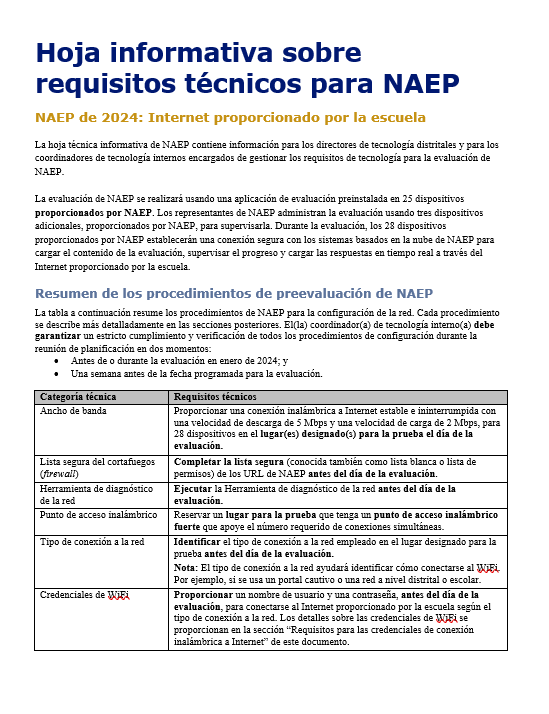
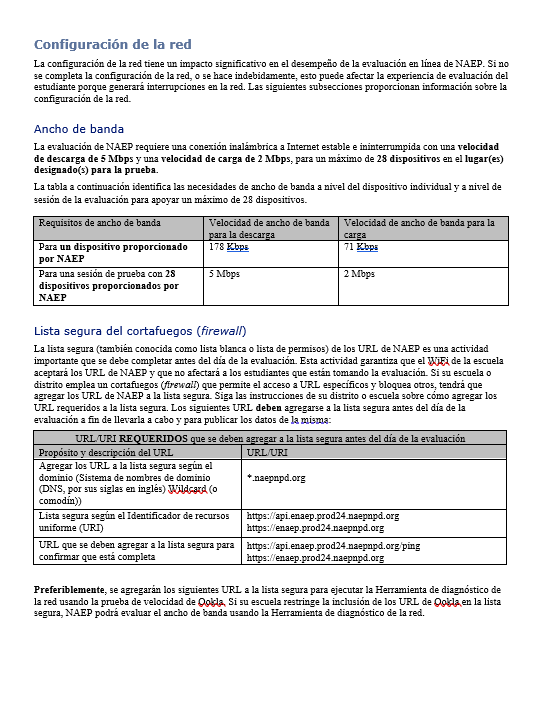
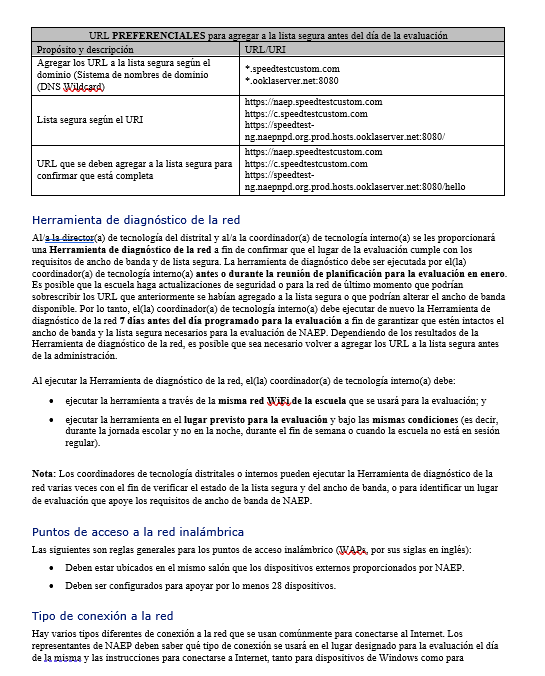
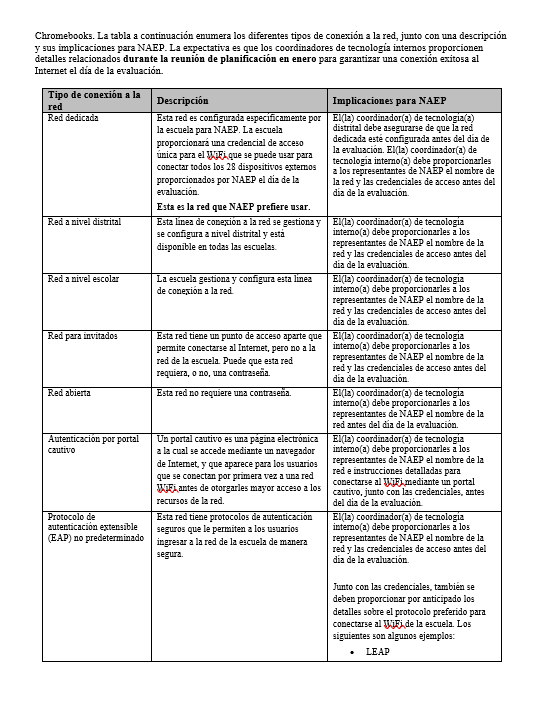

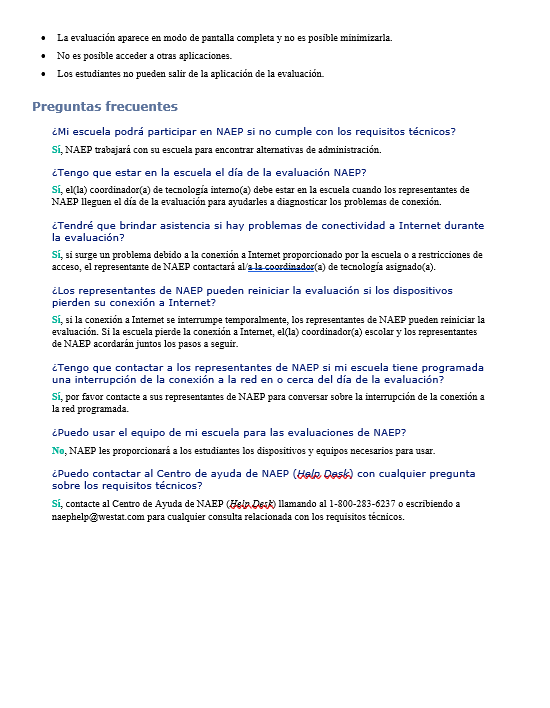
1 Required fields for HSTS transcript files are: HSTS ID (provided by NAEP on the student list), Course ID, Course Title, Grade Level, School Year, Course Term, Credits Earned, Grade Earned, Transfer Course (Y/N indicator), and Graduation Status.
2 For PDF files: If unable to edit files electronically, the PII can be masked using a black marker on a printed hardcopy. The redacted documents can then be scanned for upload.
| File Type | application/vnd.openxmlformats-officedocument.wordprocessingml.document |
| Author | Molin, Ed C |
| File Modified | 0000-00-00 |
| File Created | 2023-11-09 |
© 2025 OMB.report | Privacy Policy

